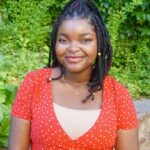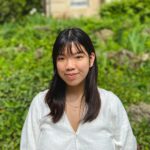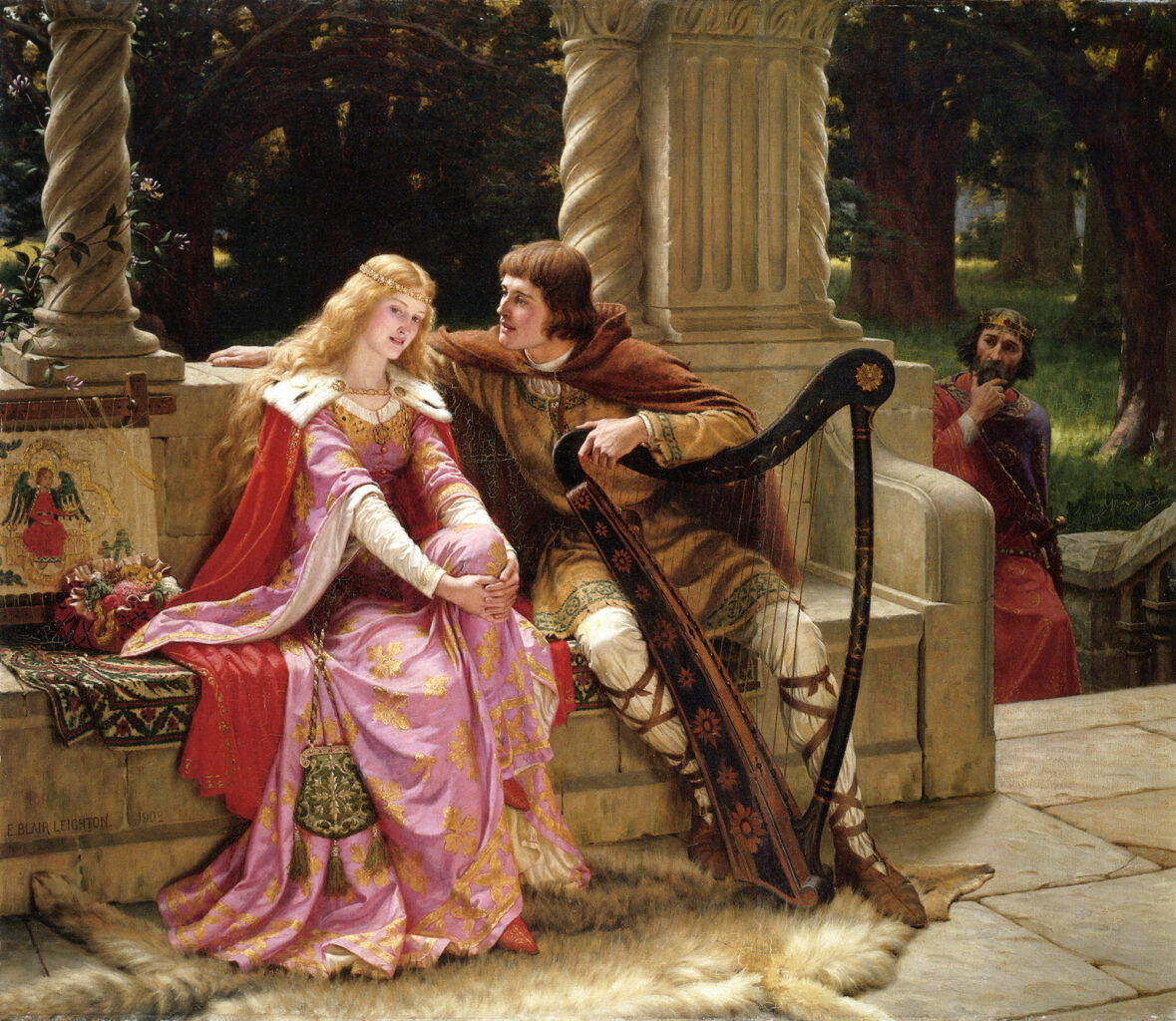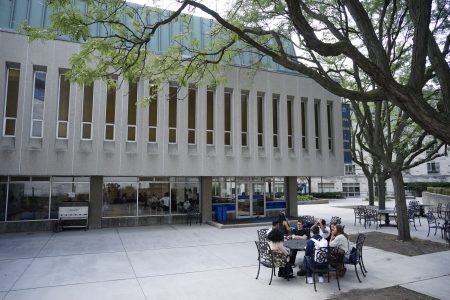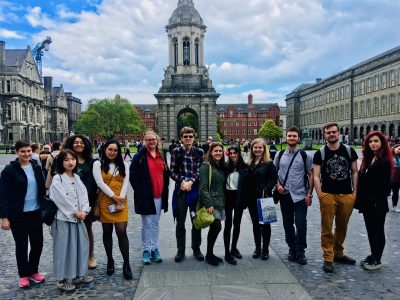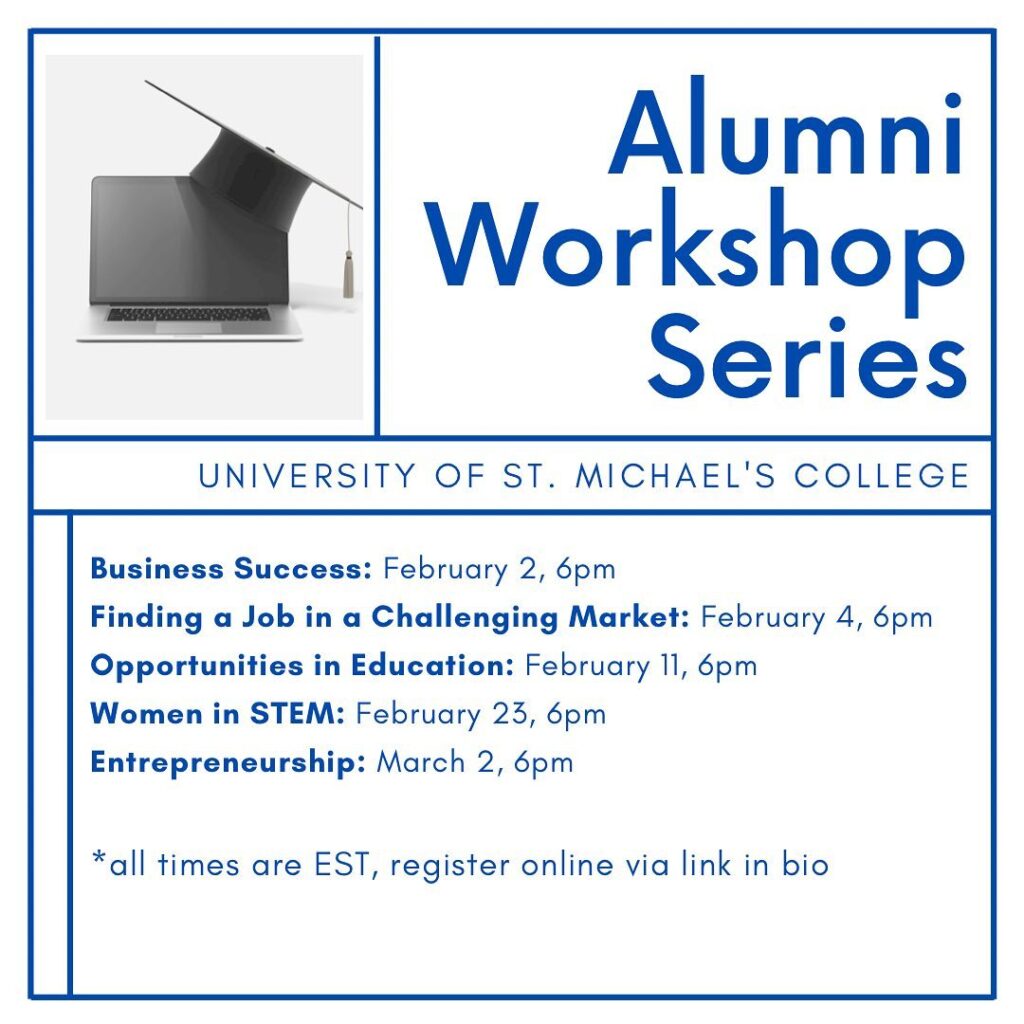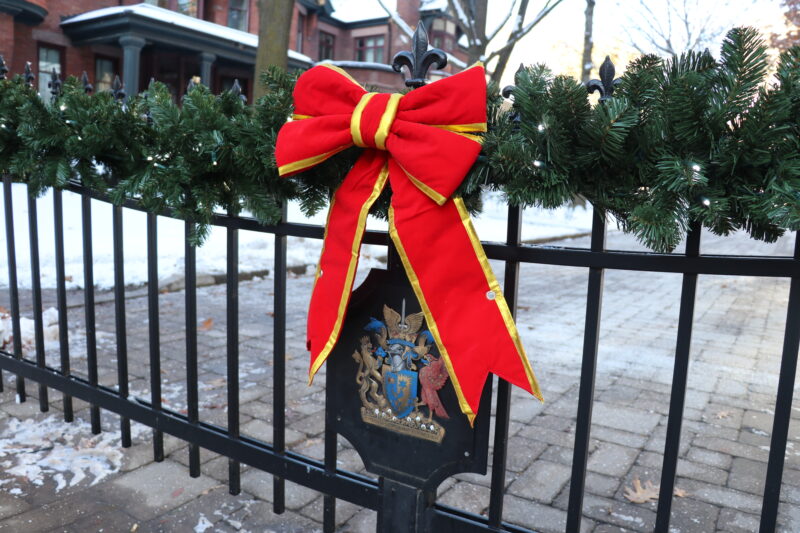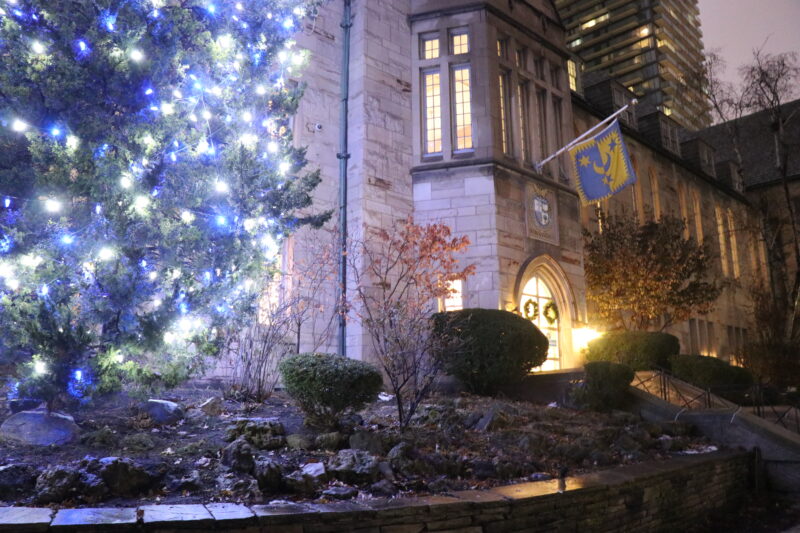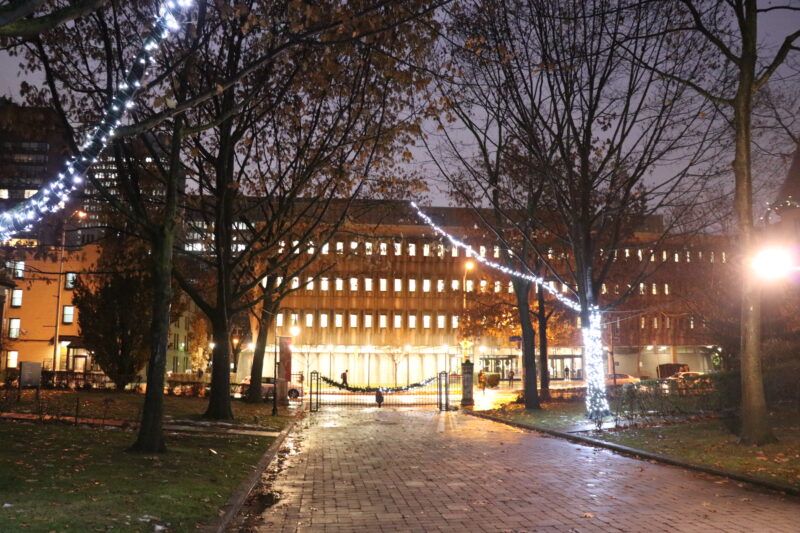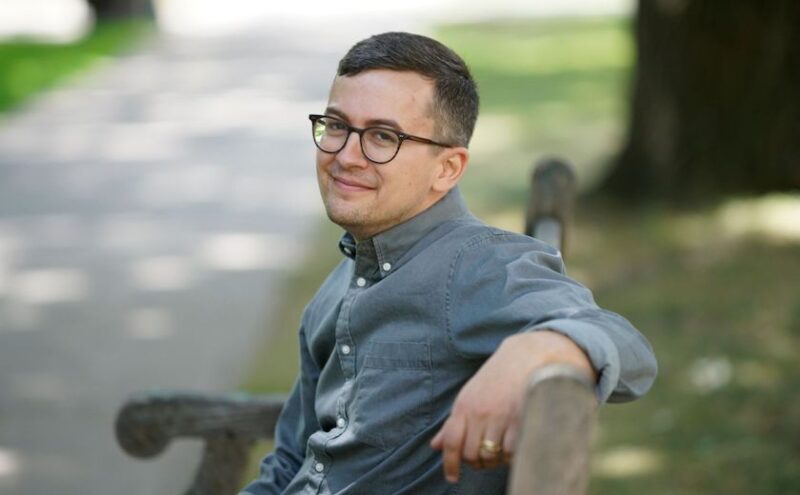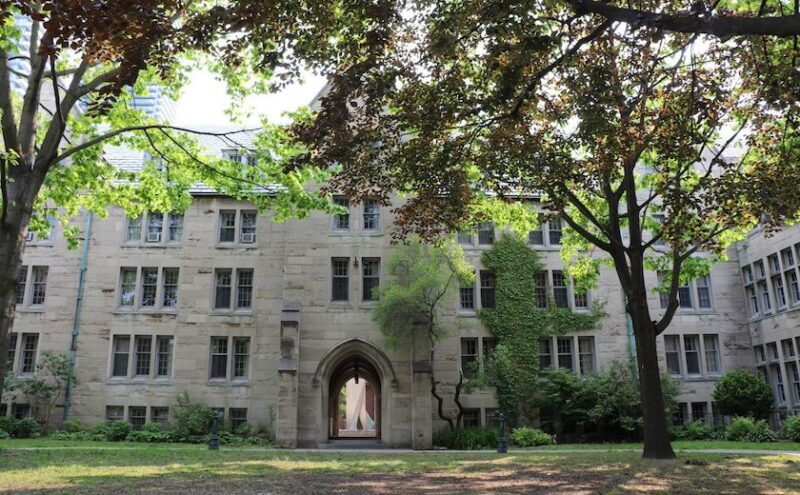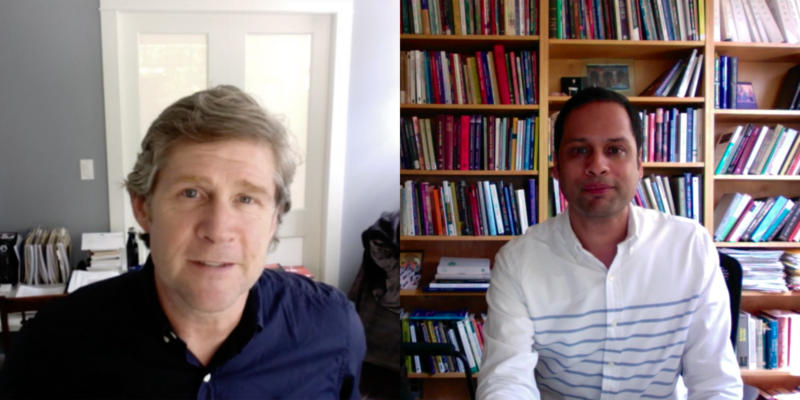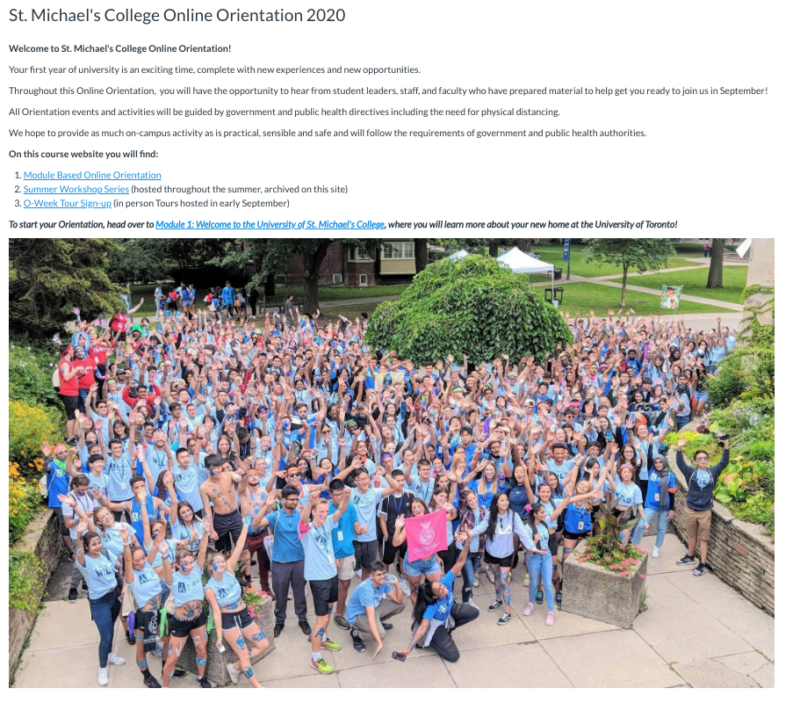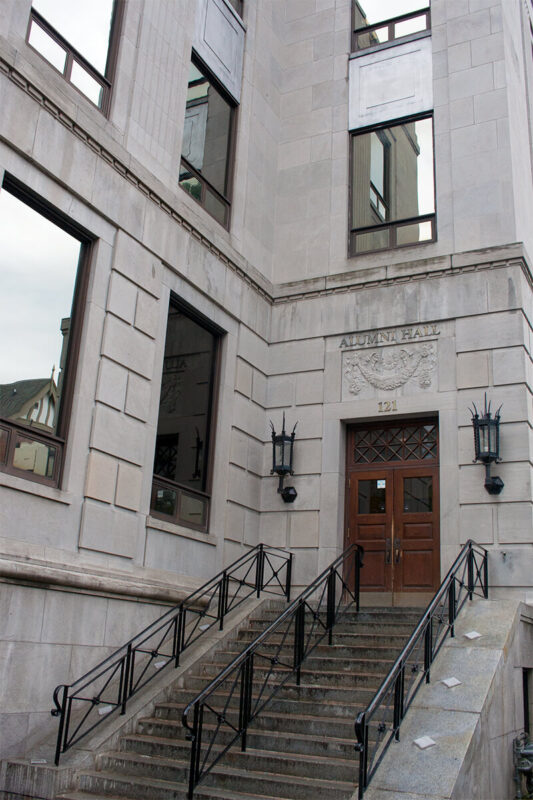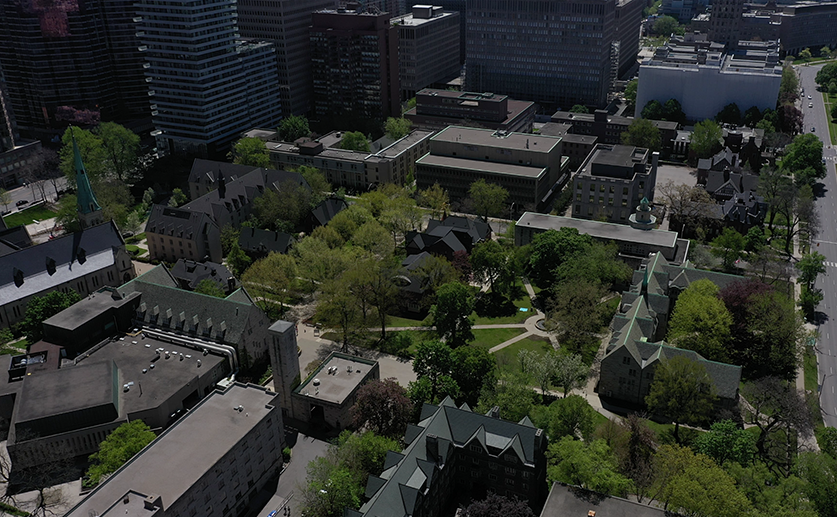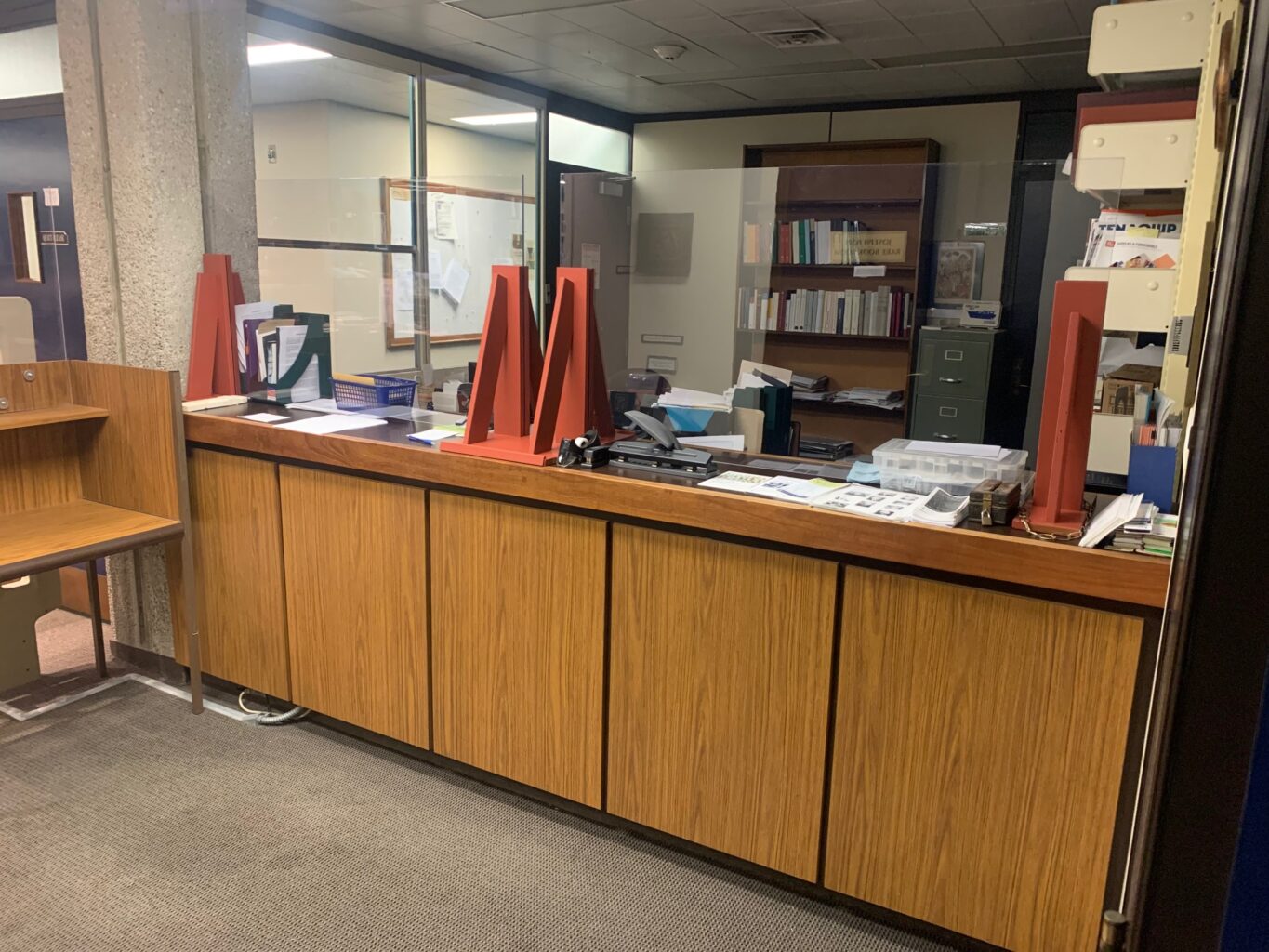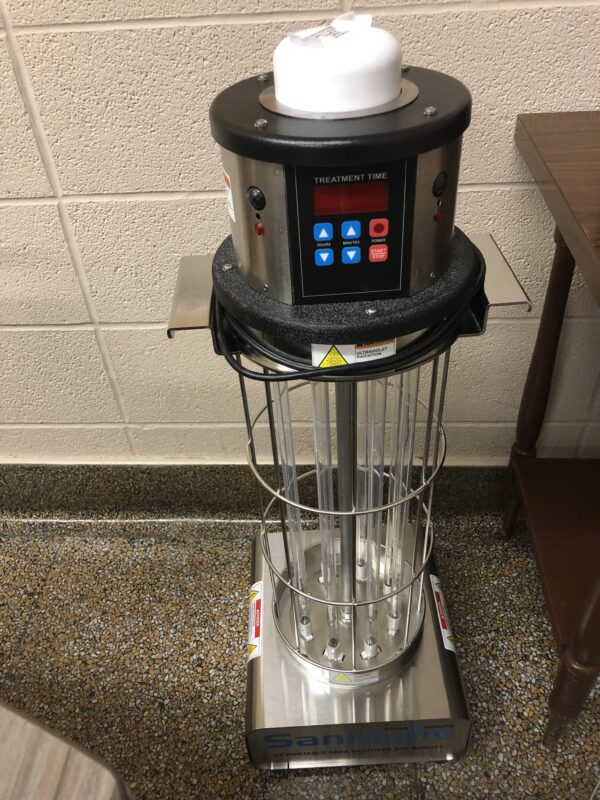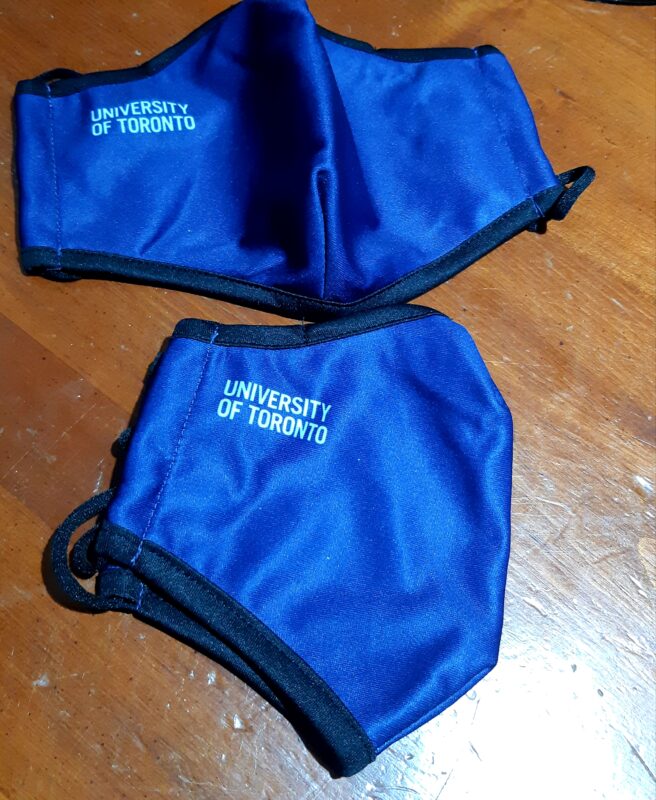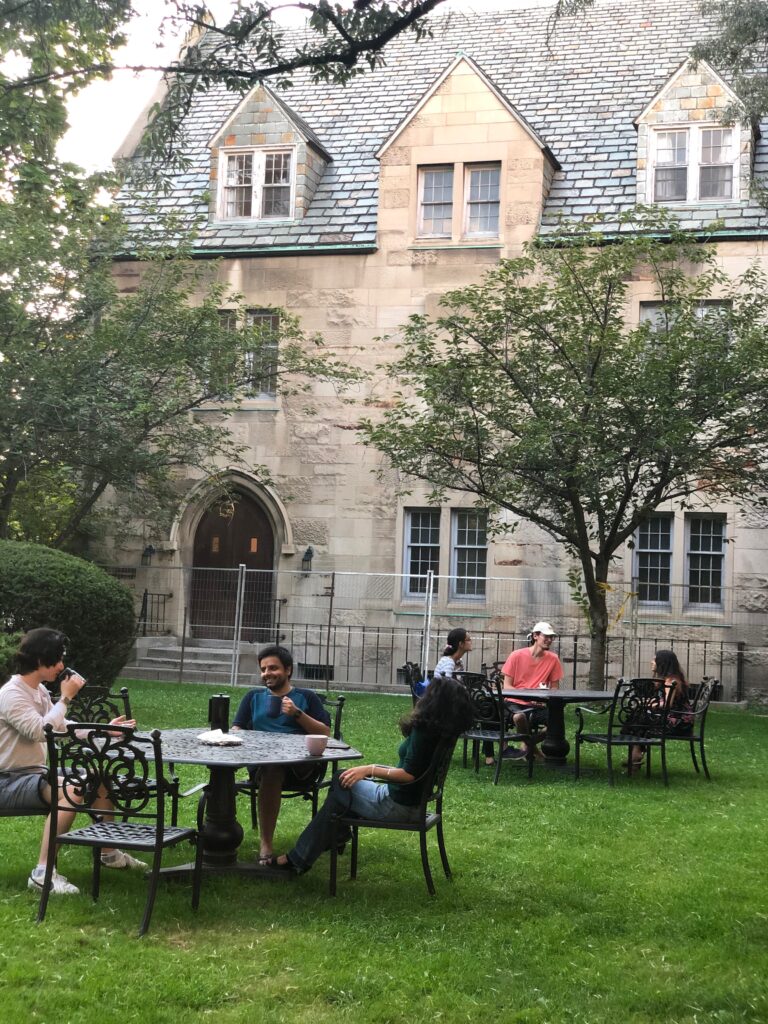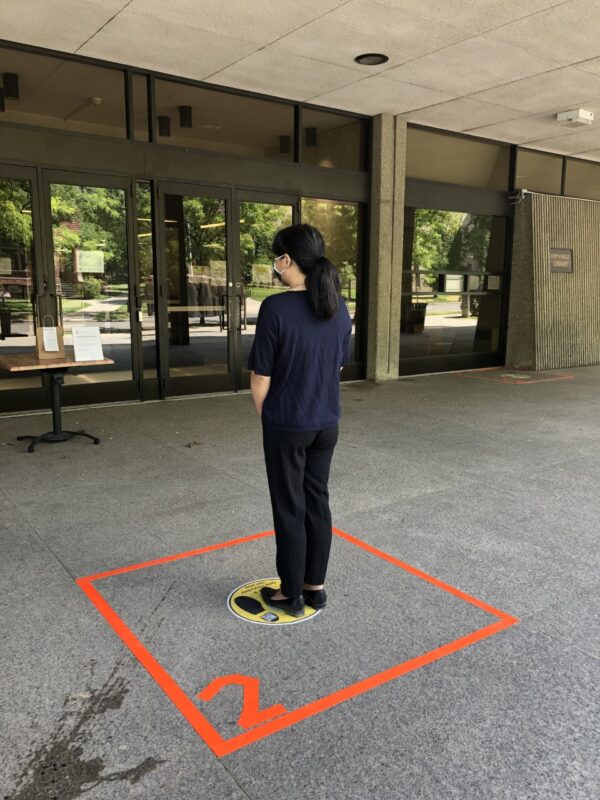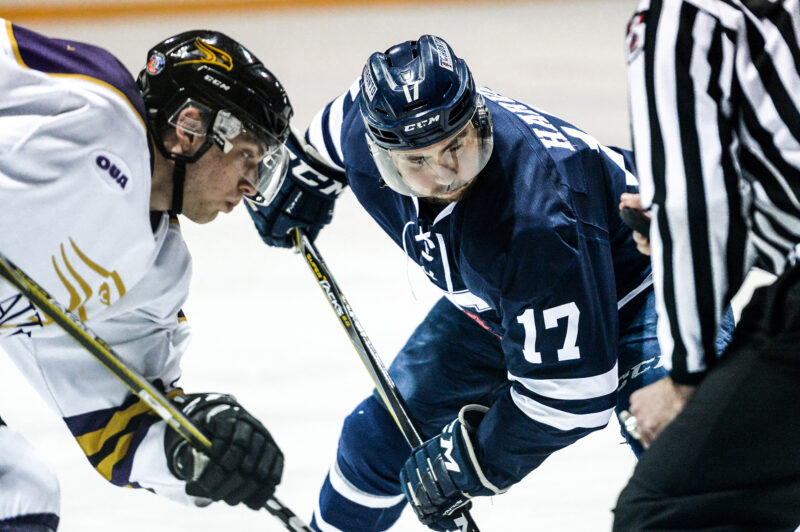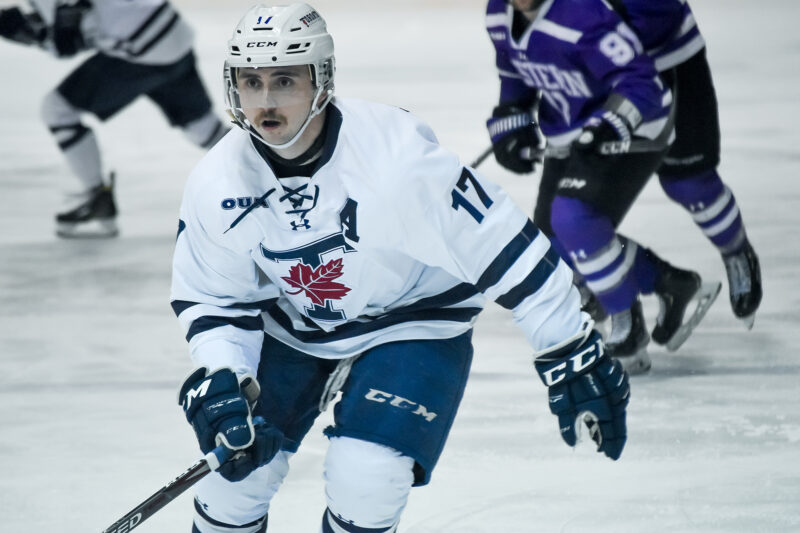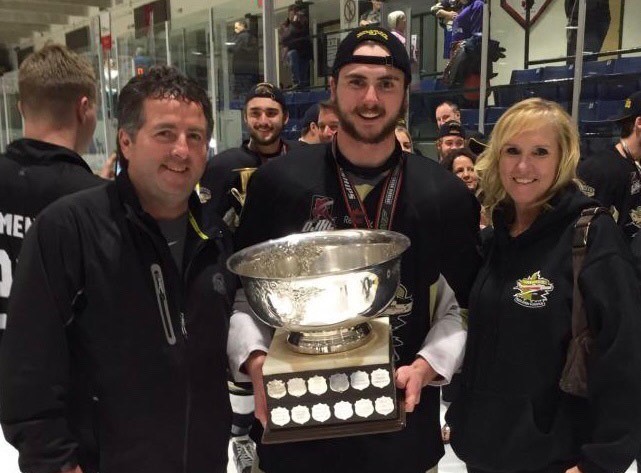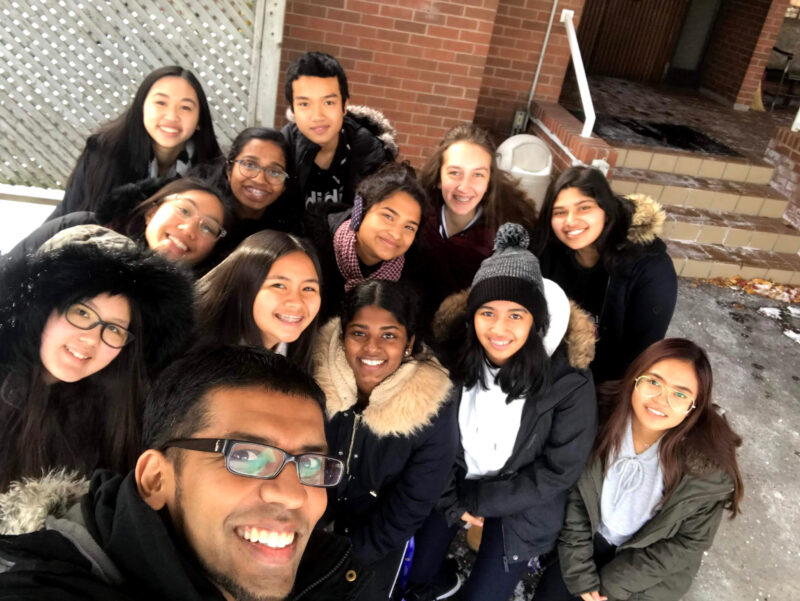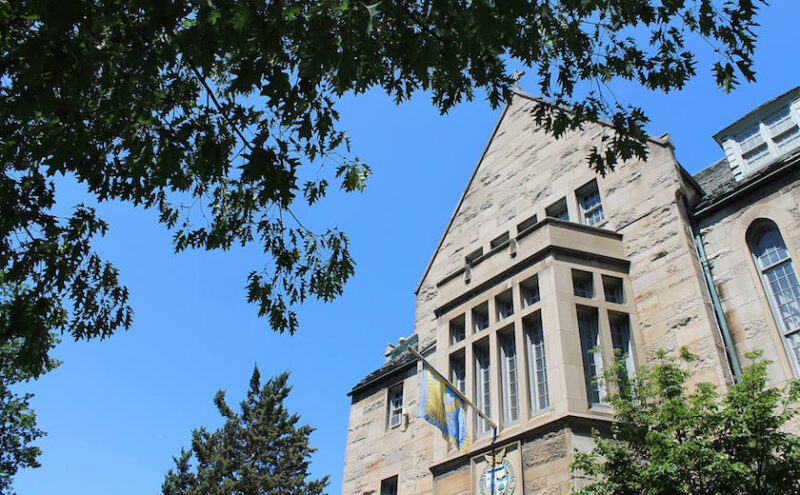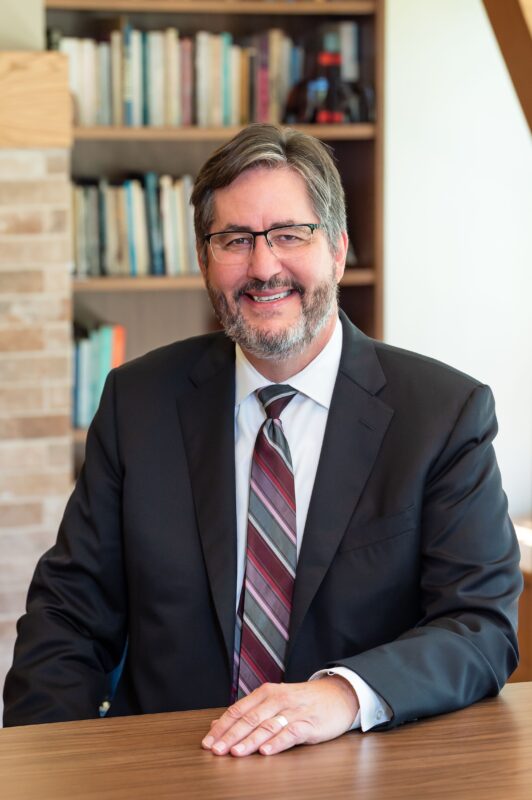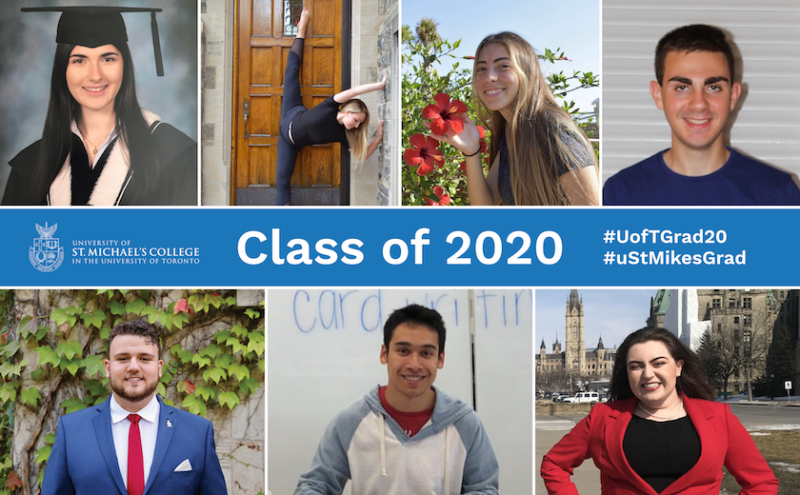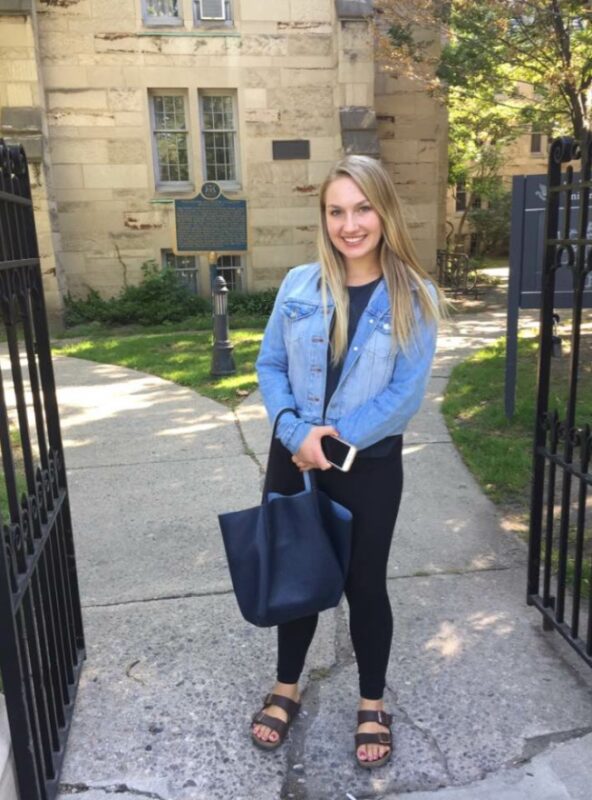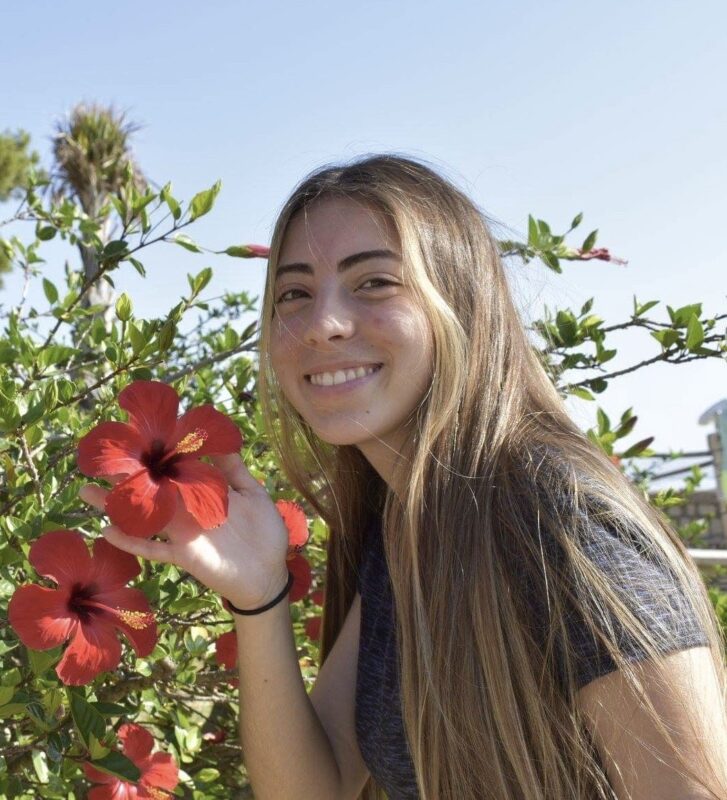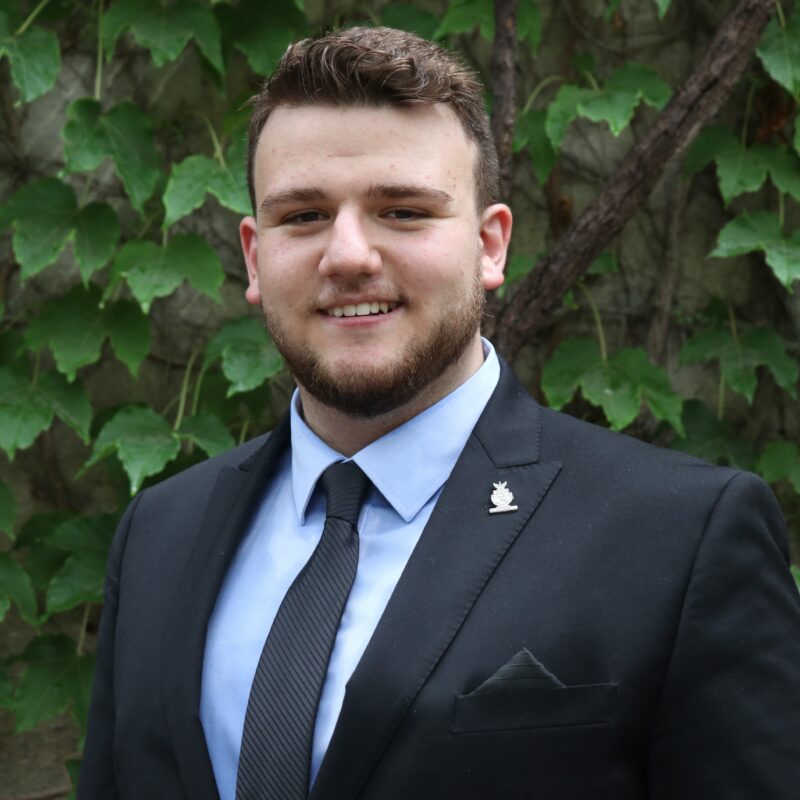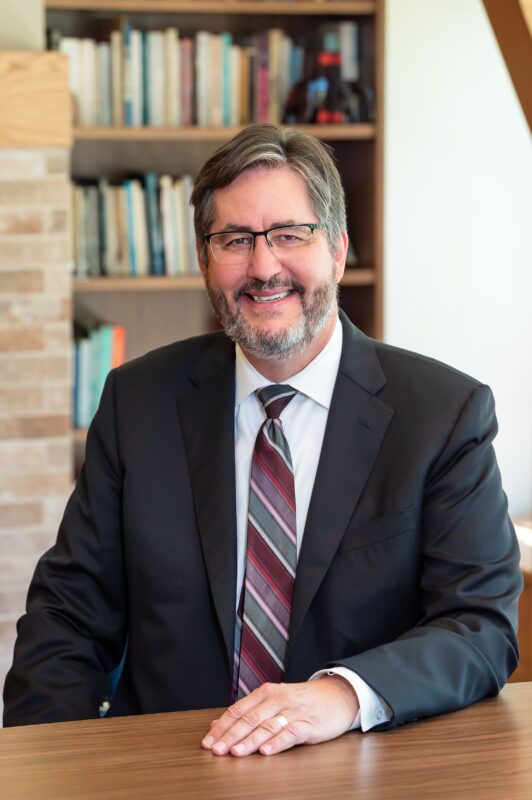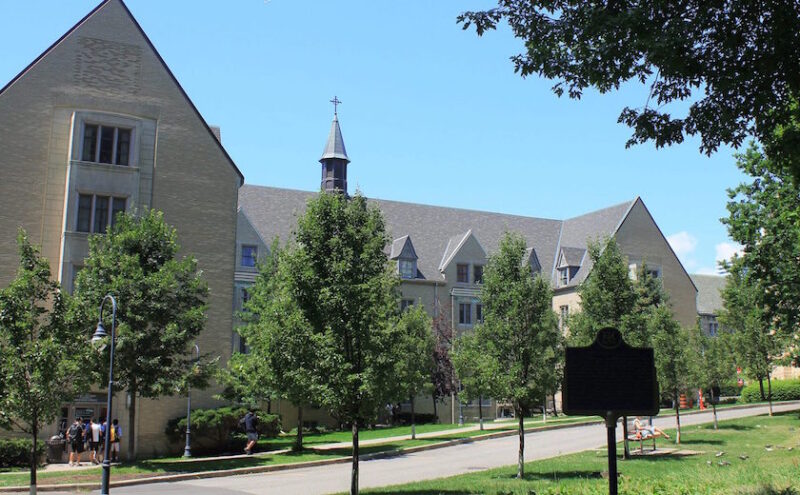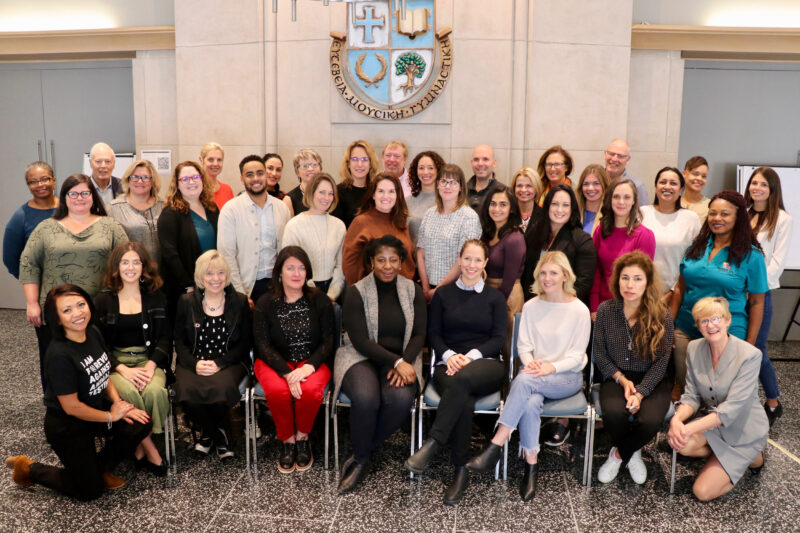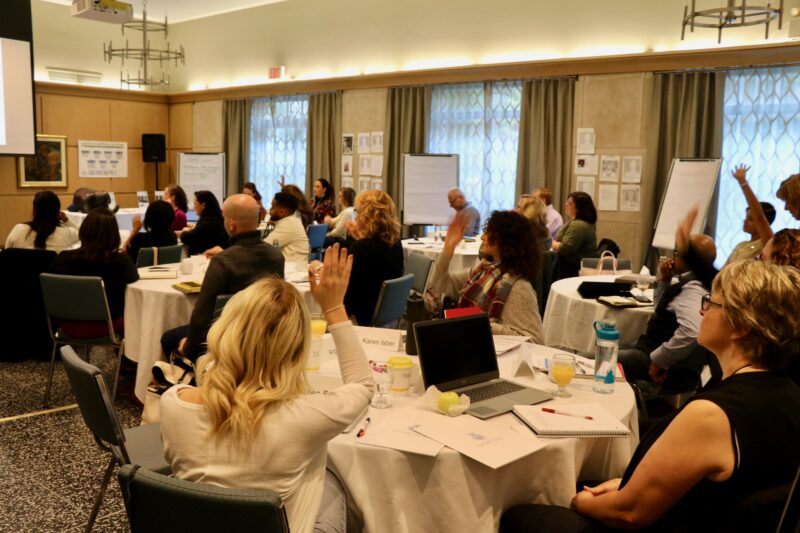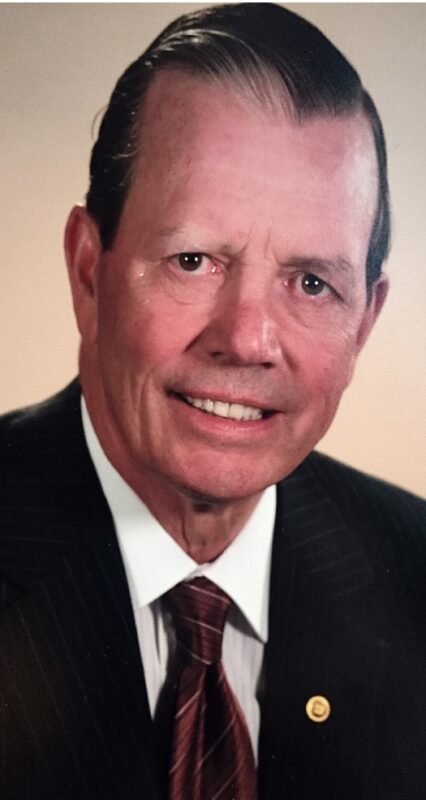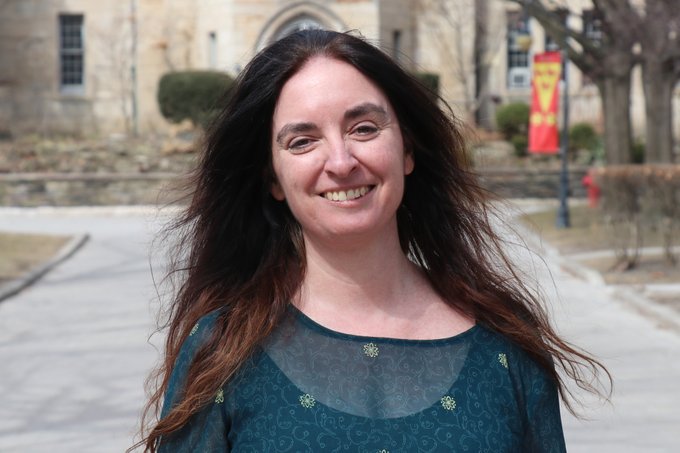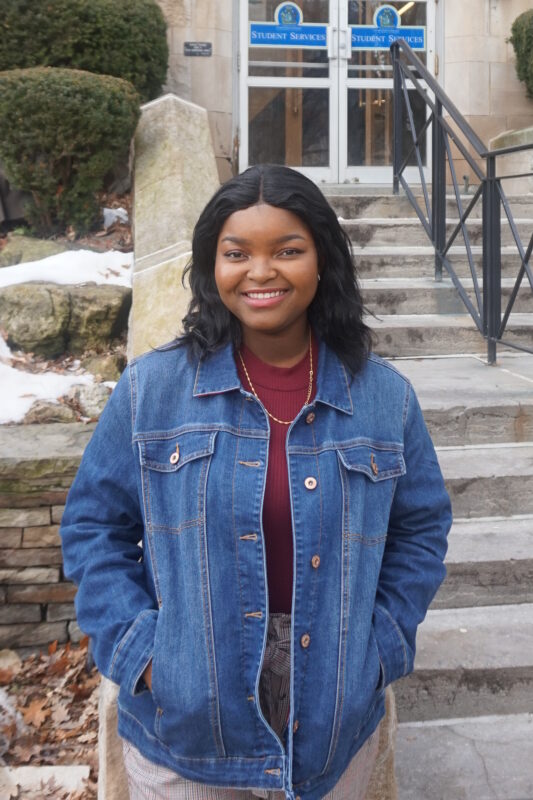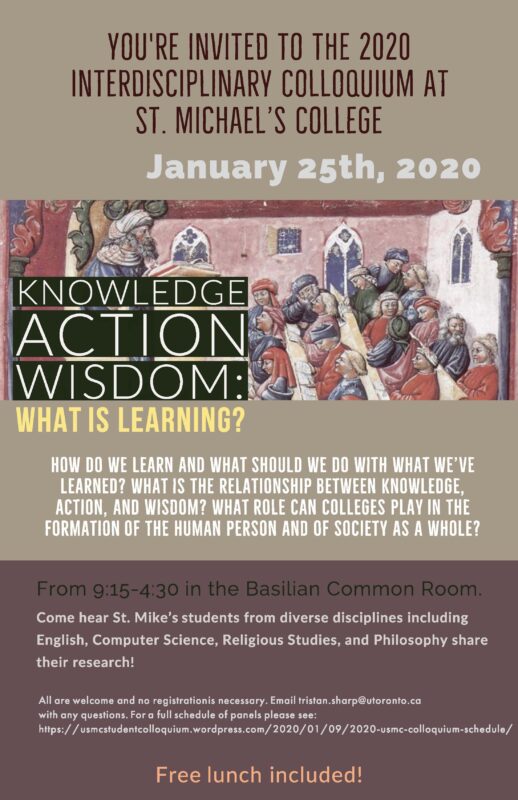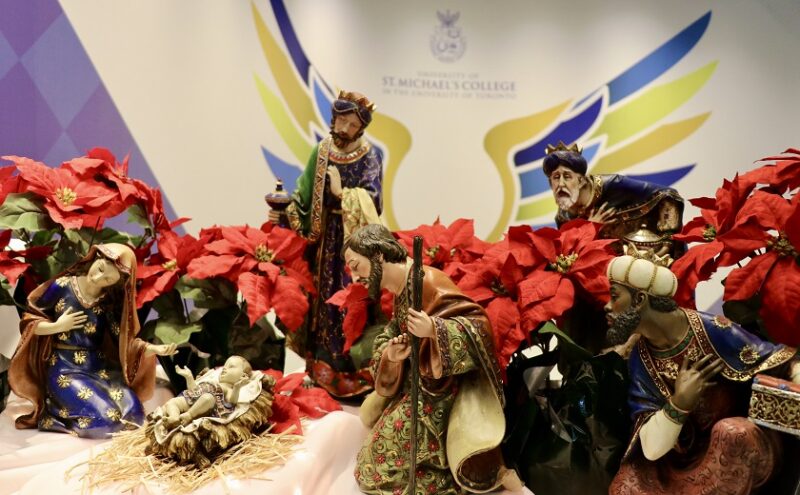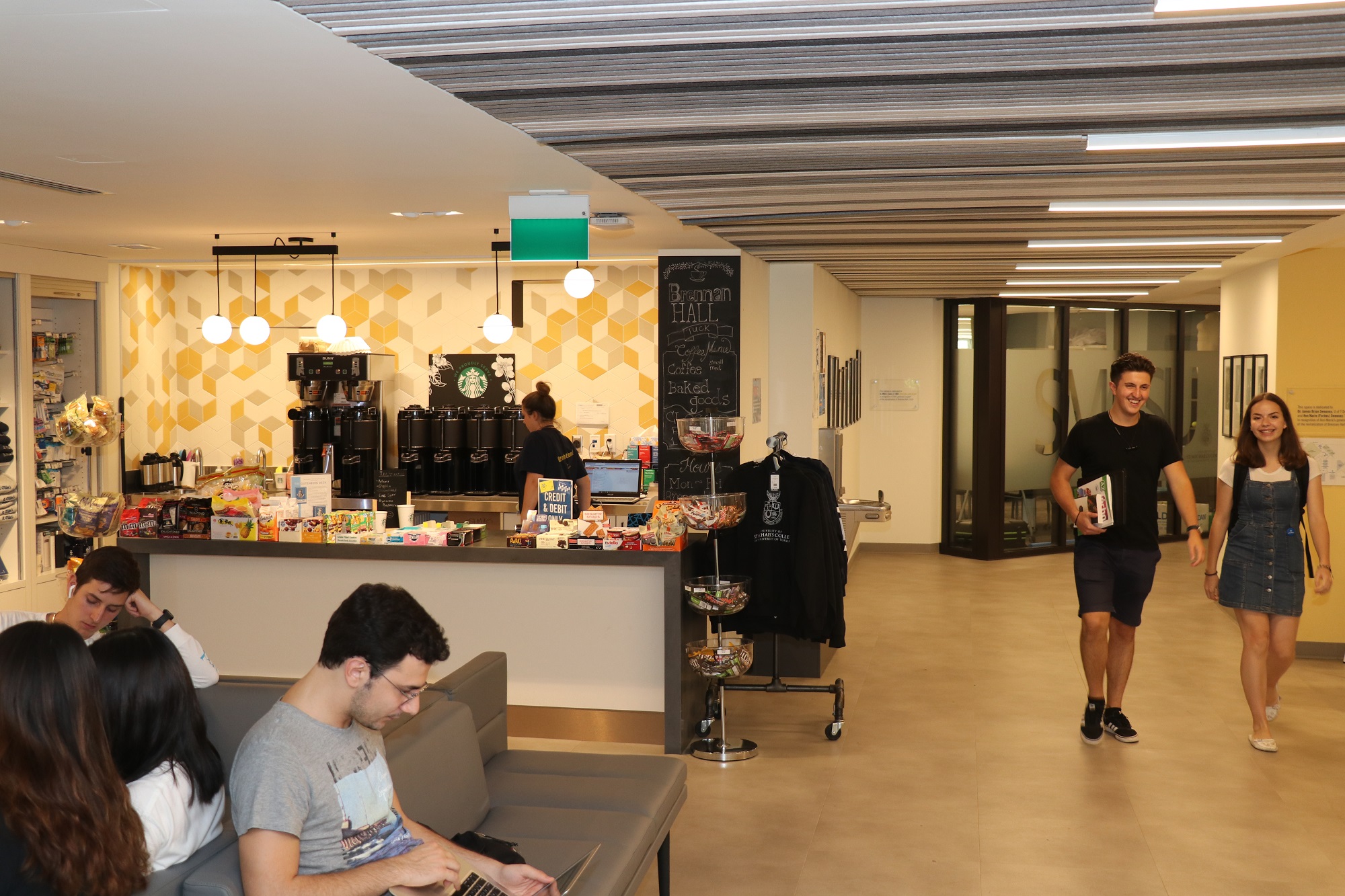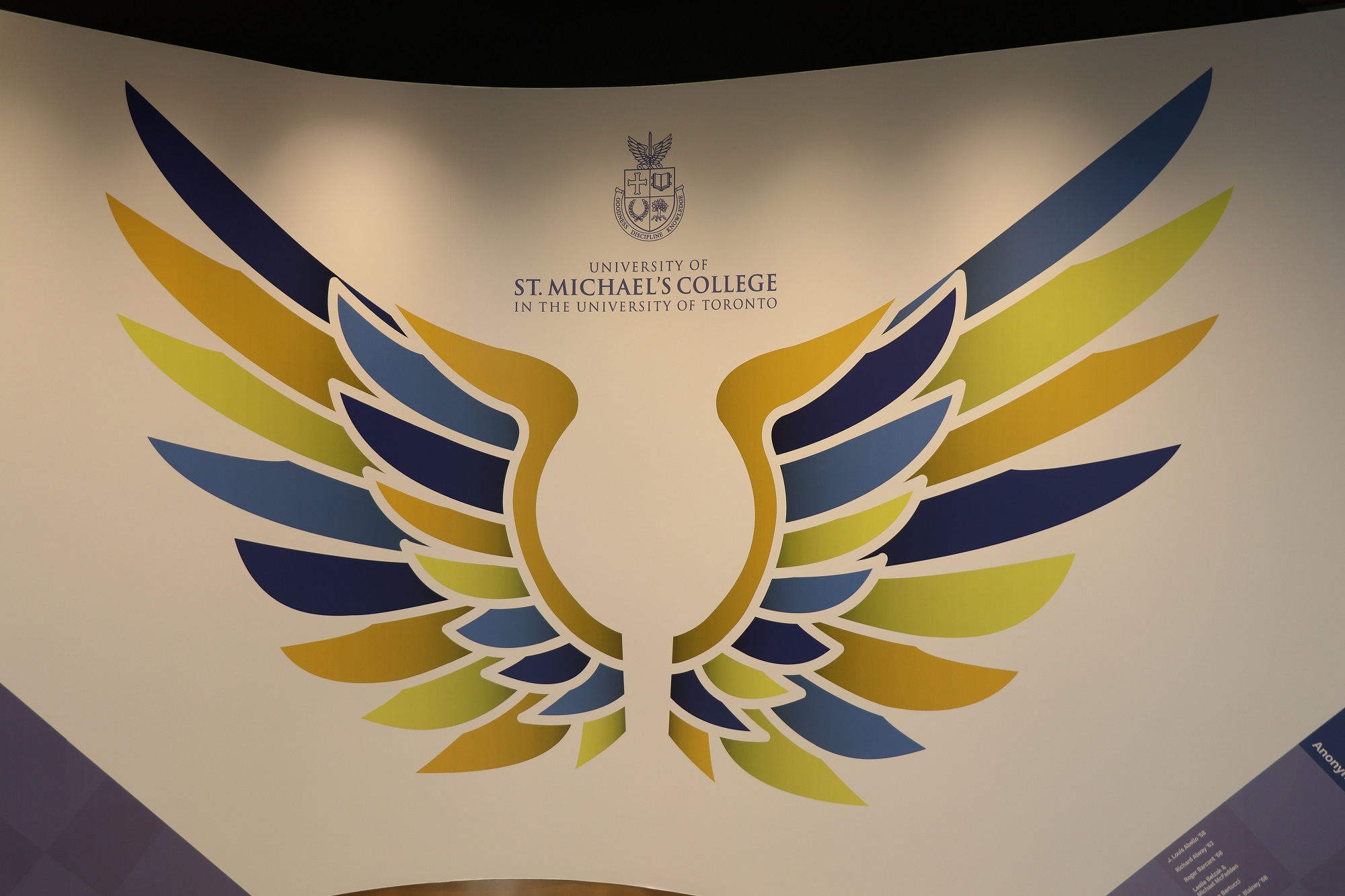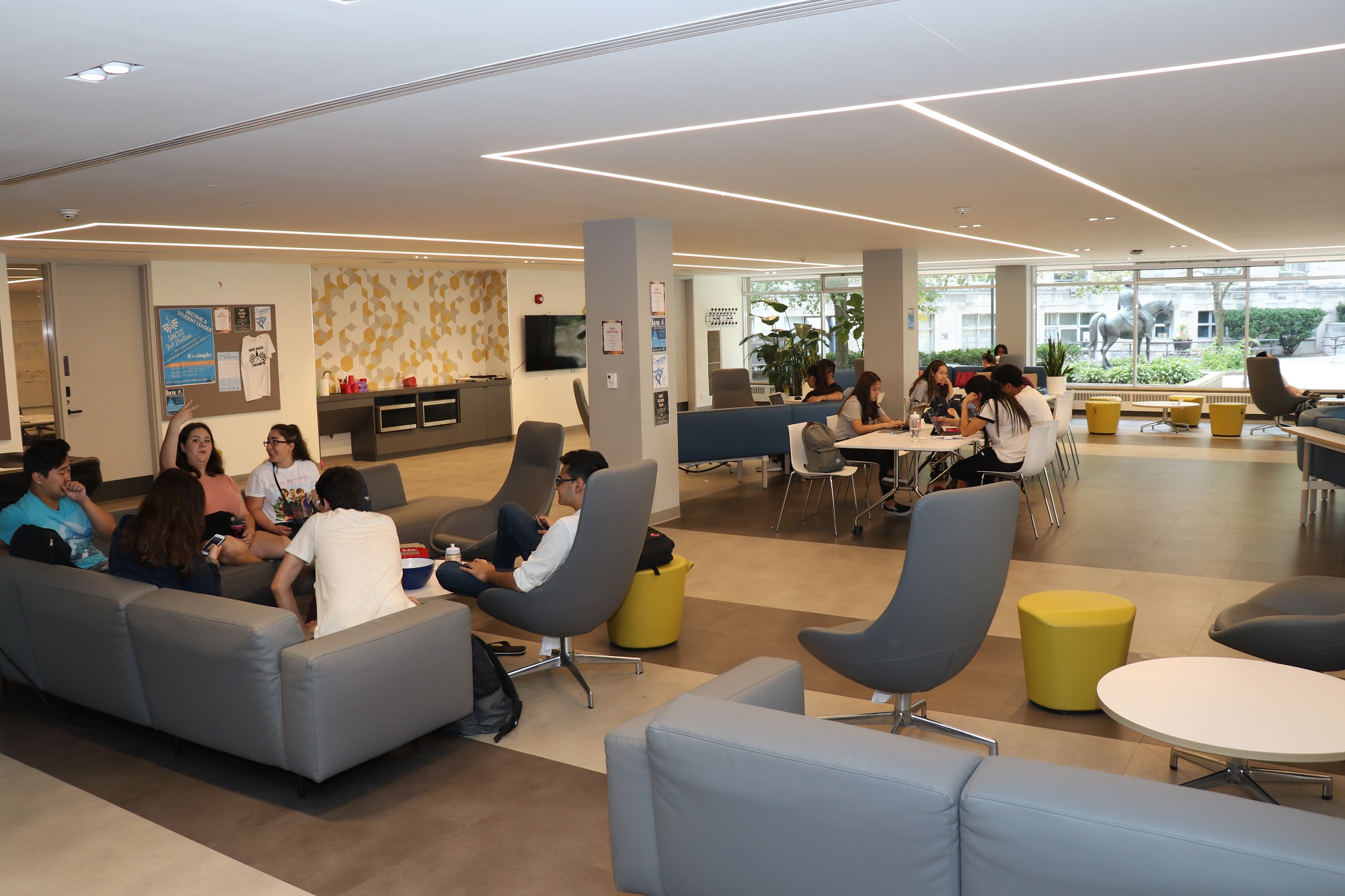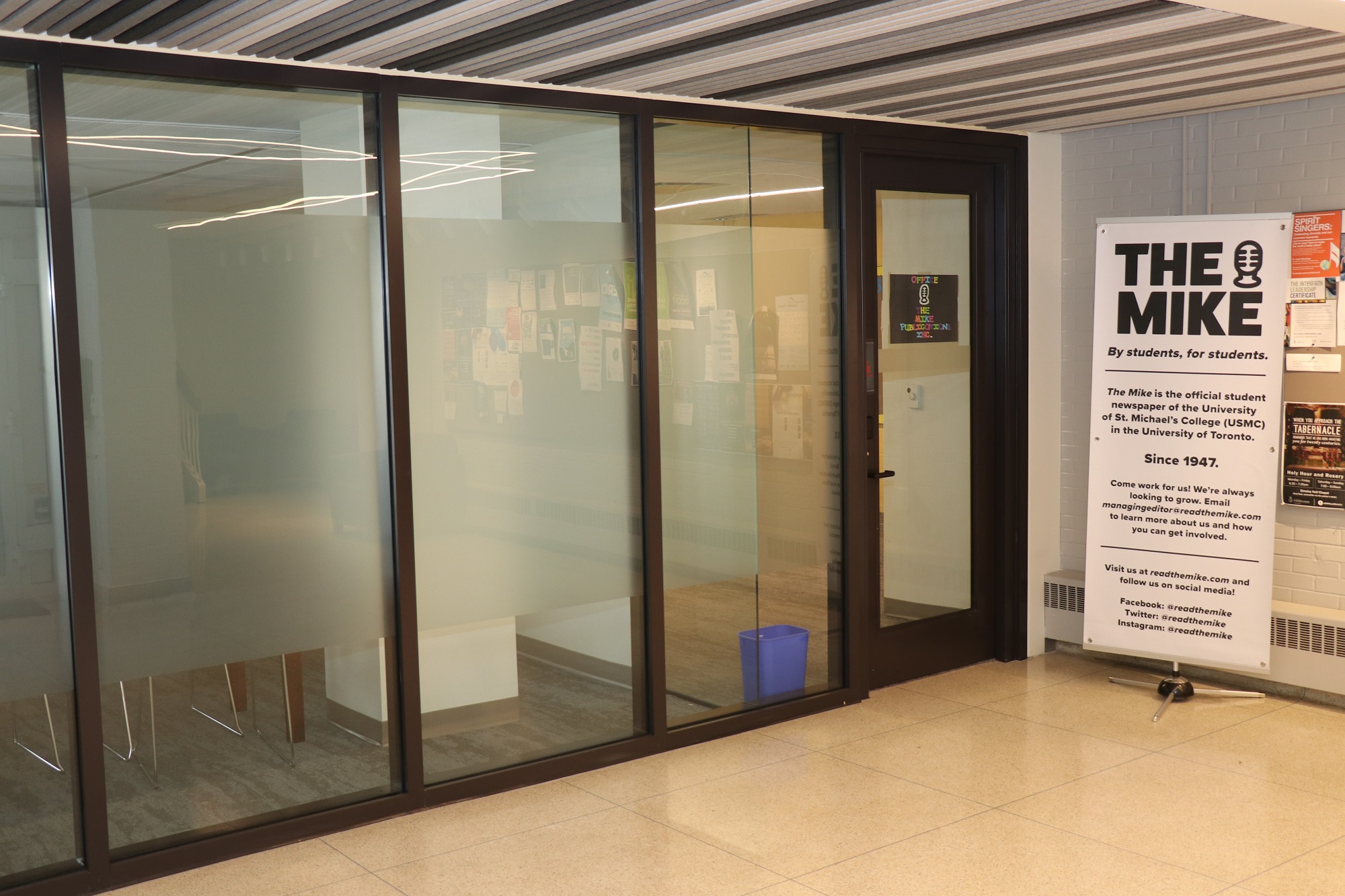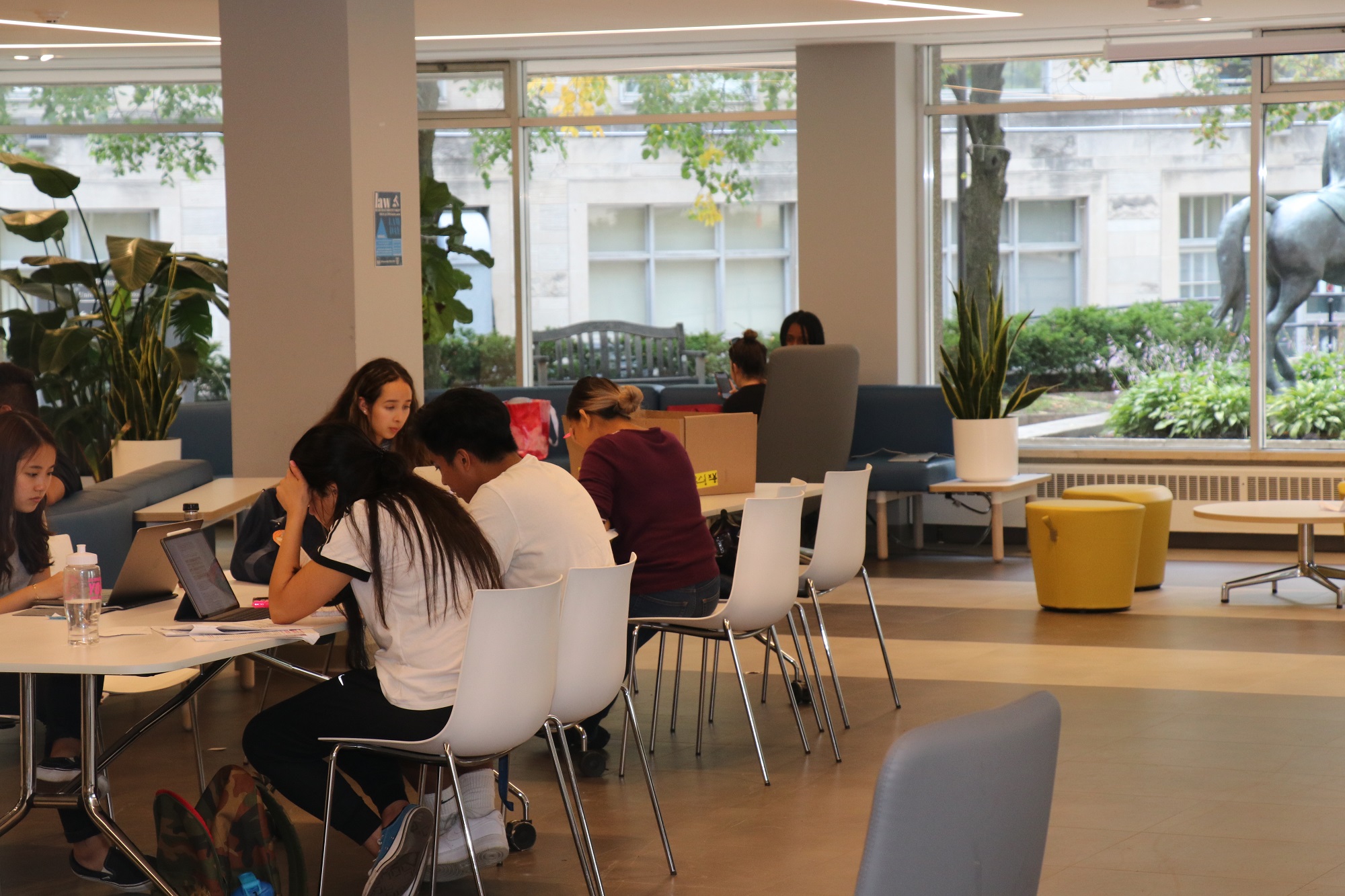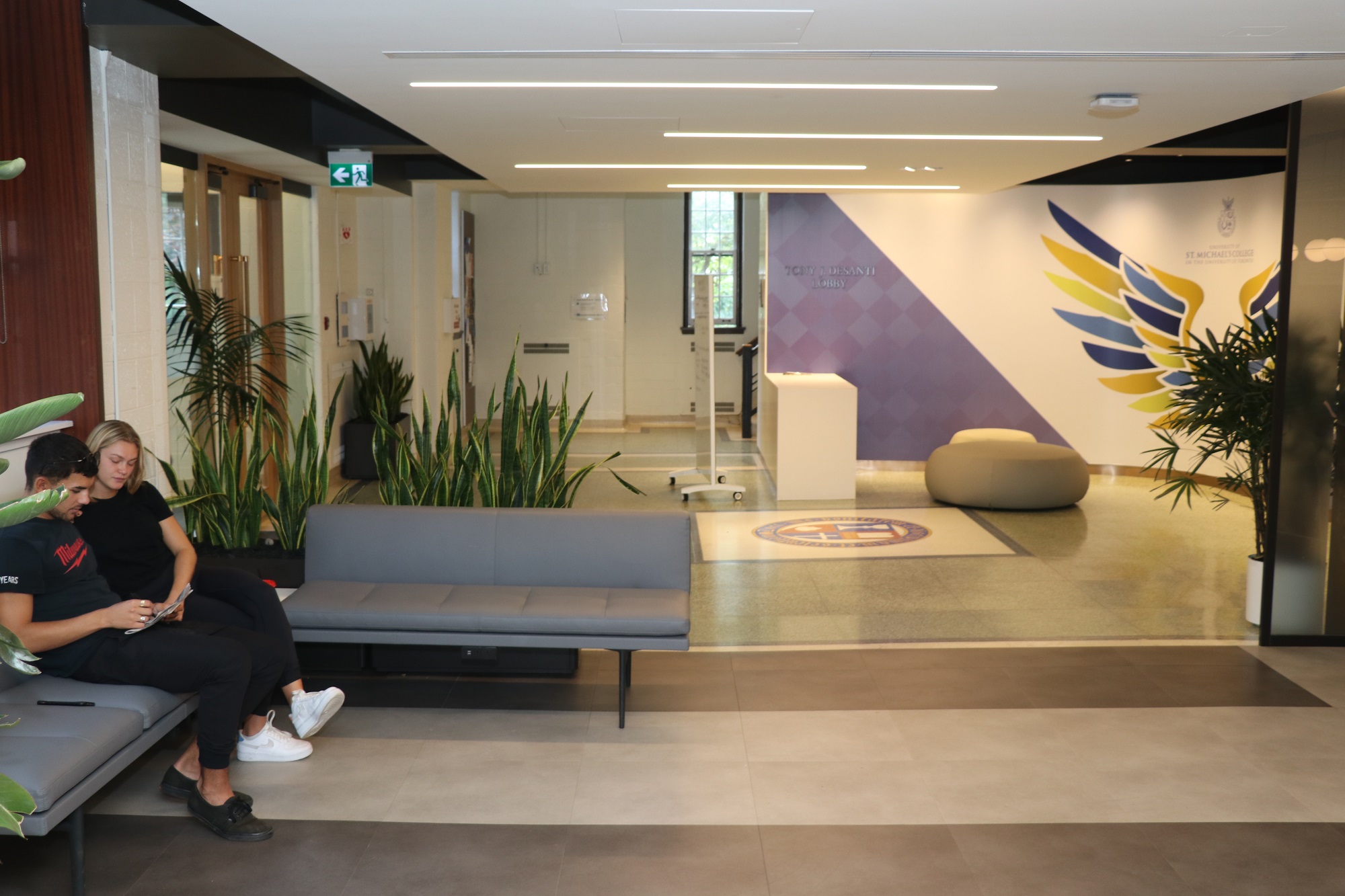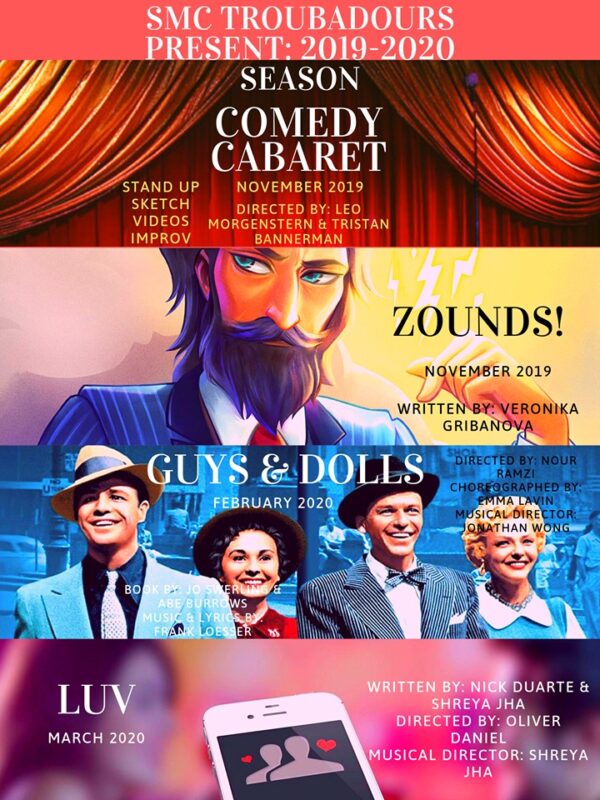
Please join us in celebrating our patron saint, St. Michael the Archangel, on September 29, the Feast of Michael and All Angels, or Michaelmas. This year, the celebrations are a joint effort among the President’s Office, the Office of Campus Ministry and St. Michael’s College Student Union.
“I look forward to celebrating Michaelmas with the St. Mike’s community as we honour our patron saint as well as our common values of leadership, justice, inclusivity, and care of others and our common home,” says Interim Director of Mission and Ministry Fr. John Meehan, SJ.
The day’s events commence with Mass at St. Basil’s Church at 12 p.m. The Mass will also mark the opening of the Pontifical Institute of Mediaeval Studies’ (PIMS) academic year. St. Michael’s and PIMS faculty members will don their academic regalia for the academic procession that will lead off this special Mass.
Afterwards, the festivities will move outdoors to Elmsley Lane, where President David Sylvester and SMCSU President Sariha Dewan will offer their remarks about the day’s celebrations before a cake cutting. The line-up of activities includes food trucks parked along Elmsley Lane and sports and large games taking place in the Quad.
St. Michael’s Schola Cantorum will present its Michaelmas concert on Friday, October 3, 7:30 p.m. in St. Basil’s Church. The Schola, directed by Dr. Christina Labriola, will perform the dramatic, colourful, and virtuosic Missa Omnium Sanctorum by the Catholic Czech Baroque composer Jan Dismas Zelenka, together with guest soloists and instrumentalists led by Chris Verrette. Admission is free, with donations accepted to benefit Campus Ministry outreach to those in need in our community.
Community and mentorship gave Lauren Daunt the courage to navigate her first year and be open to trying new experiences by getting involved. This coming fall she’ll return the favour in her roles of St. Mike’s Orientation leader and mentor.
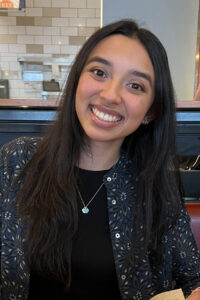
In a year of firsts, her favourite memory was at the end of Orientation Week as the first-year St. Mike’s students had painted themselves blue in preparation to march along St. George Street. “We were cheering our St. Mike’s cheer, the Hoikety Choik, as loud as possible, and cars would honk for us and cheer us on, too. I felt this was my initiation into St. Mike’s because everyone who was walking with us in that space had so much energy and I could feel how happy everyone was to be at St. Mike’s,” she said.
She wants to recreate this memory for the incoming class. As an Orientation leader she’ll be facilitating activities for a group of first-year students during Orientation Week. As a mentor she will be matched up with a first-year student who she will meet with once a month over the course of the year.
“St. Mike’s was always such a welcoming environment and I want to give the incoming students the same St. Michael’s experience. I think that when you’re in a new space you need that positive energy and encouragement to kickstart your experience. It sets the bar for how you’re going to feel during your four years of undergrad,” she said.
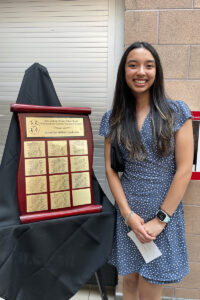
Lauren’s involvement with mentorship began as a high school student at St. Augustine Catholic High School in Markham, when she joined a mentorship program run by the University of Toronto’s Human Biology Student Union. The program matches high school students with a mentor in university who helps with the university application process. Lauren gained valuable insight into the many programs under U of T’s human biology umbrella, which helped her choose her major. She just completed her first year with a major in human biology and a double minor in physiology and immunology. “It has surprised me that upper-year students are so kind and eager to offer guidance. They have a great understanding of where you are because they were there just a couple of years ago,” said Lauren.
When it came time to choose her college there were many factors she considered. As a Catholic, Lauren was looking for ways to incorporate her faith into her new university life and knew that St. Mike’s is affiliated with St. Basil’s Parish, which would give her a place to worship near campus.
During orientation week she attended Mass at St. Basil’s Parish and right away she was welcomed into the community. “As the priest specifically welcomed the new students I remember sitting there and thinking to myself that I was so lucky that I was able to have a place to practise my faith downtown,” she said. Afterwards, the priest invited the students to introduce themselves to him and right away she knew she belonged.
At U of T, she was keen to continue her connection with the Human Biology Student Union. In her first year she was a HeadStart Mentor, and she has been elected Outreach Director for the coming year. She’s looking forward to getting involved with the many events hosted by the student union including academic symposiums that will bring UofT’s human biology community together.
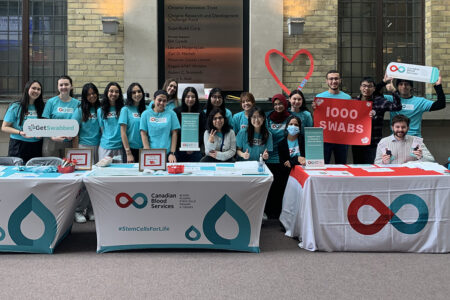
She was also the first-year representative for LOVE146, which raises awareness and funds to prevent human trafficking in Toronto. As a volunteer for the Stem Cell Club, she helped at stem cell donation drives. Her involvement allowed her to meet many of her peers in the life sciences programs who share similar interests, which she had found difficult to do due to the large class sizes. “Being able to join a community that was dedicated to a specific goal was something that I was very grateful for,” she said.
This summer she worked as a research assistant under Dr. Stephen Lewis in the orthopedic surgery department at Toronto Western Hospital, a placement she secured by following the advice she received from upper-year students. Through her involvement in the Human Biology Student Union and other STEM related-extracurriculars, she has met senior students who are more than willing to share their knowledge.
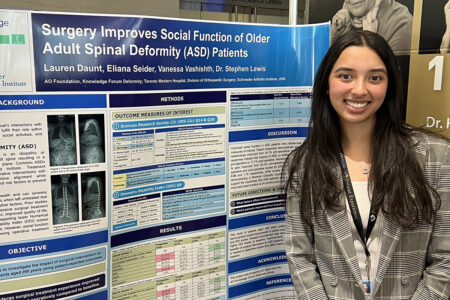
She was told that although many research opportunities are reserved for more senior students who had more research experience, she could try cold-emailing doctors with specialties that interested her, so she reached out to doctors affiliated with the U of T. Among them was Dr. Lewis, whose research into adult spinal deformities was of interest to Lauren because she had two grandparents who were treated for spinal stenosis.
As she heads into Orientation Week, she reflects on what words of wisdom she would share with incoming students. “University can be an overwhelming experience, as it marks the start of a new chapter in our lives. If you’re able to stay true to yourself, you will be able to thrive in any environment that you find yourself in.”
These words will continue to serve her well as she continues to take advantage of all that St. Mike’s has to offer.
Recently, St. Mike’s student Camila Justino heard a lecturer advise students not to “leave part of yourself at the door,” urging them to engage in as many opportunities and experiences as possible. As a mother and a mature student balancing family life and school with forging a new life in Canada, the message resonated with her.

When Justino saw an ad for the Dean for a Day just days later, she sat down and wrote an application essay, outlining some of the issues she would tackle if she were Dean. Her words were convincing, as she won the opportunity to trade places for a day with Prof. Melanie Woodin, Dean of the Faculty of Arts & Science, and get an inside look at the world of administration at the University of Toronto.
“I think one of the things that set apart my 500-word essay for the contest is my constant curiosity and questions about the ways we live,” Justino explains. “The main suggestion I had also came from a place of anguish in an expensive city, with increasing rates of homelessness and unemployment. It can be difficult to transition from being an undergraduate to becoming a professional able to pay all the basic expenses. My essay questioned the pressure we students might face and asked U of T to have a career centre that considers the unique circumstances of underrepresented groups of students.”
The Dean for a Day experience began at Woodin’s office in Sidney Smith Hall on St. George St., where Justino also met some of the Dean’s staff who briefed her on her agenda. Then she was whisked off to the Experiential Learning Commons (ELC), a place she deemed “fascinating” for its work on everything from hosting career workshops on topics such as interviewing through to connecting students with potential employers.
From there it was over to Simcoe Hall to meet with Prof. Sandy Welsh, Vice-Provost, Students, and then a short walk to meet with Hart House Warden David Kim.
Finally, it was back to Sid Smith for some office time, followed by a meeting with the Arts & Science Student Union (ASSU) executive in the Dean’s conference room.
When asked to describe a high point of the day, Justino laughed and said, “All of it!” She followed up, though, but stressing how meaningful it was for her to encounter women in senior administration.
However, the most inspiring part of the day, she says, was participating in the final meeting with the ASSU, which organized the contest with the Dean’s office to raise funds for food banks on campus.
“Watching the union of students ask to lower the fees of deferred exams and their willingness to defend rights for students and make important changes definitely made me proud of being a student,” Justino says.
Camila, a Book & Media Studies major with minors in Celtic Studies and Mediaeval Studies, is poised to graduate this spring. As she ponders whether to move on to graduate school or seek a career based on her gift for writing (she earned an earlier degree in literature before emigrating from her native Brazil) she says it was “inspiring to see women taking the lead.” She was particularly impressed, she notes, by Woodin’s status as a scientist.
As Justino familiarized herself with the western side of the U of T campus, Dean Woodin’s time at St. Mike’s included a visit to the Pontifical Institute for Medieval Studies, the John M. Kelly Library, and a brief stop in Odette Hall to say hello to St. Mike’s Principal, Irene Morra.
“The Dean for a Day fundraiser has become one of the highlights of my year,” says Woodin. “I really enjoyed switching places with Camila and connecting with the students, faculty, and staff of St. Michael’s College, while she filled in for me and provided our team with invaluable insights and perspectives about the student experience. This day truly brought back fond memories of my time as an undergraduate student at U of T.”
As the academic year draws to a close, Justino is looking forward to her next moves while expressing her affection for her soon-to-be alma mater.
“University opened the door for me (in Canada), including helping me to learn English,” she says. “I got great support from the Kelly Library and have special affection for Kelly. St. Mike’s is my home.”
From using a sack of potatoes as a visual aid to making cultural references to works as disparate as Plato’s Republic and television’s Desperate Housewives, the recent St. Michael’s College Research Colloquium was as entertaining as it was informative.
The annual event, held this year on March 23, showcases the research and presentation skills of students studying at St. Michael’s. The event mirrors the experience of an academic conference, where students write and submit an abstract as part of the application process and then present their research to an audience, field questions from attendees, and receive feedback from faculty respondents.

“The purpose of the event is to encourage fruitful collaboration between the student population and St. Mike’s faculty and fellows,” says Dr. Bernadette Guthrie, Interim Director of the Junior Fellows Program and organizer of the day.
“The Colloquium affords undergraduate students the opportunity to present their work publicly to members of the larger academic community. This experience also offers an invaluable experience for those students planning to pursue graduate studies.”
The day-long colloquium, which saw participation from five faculty members, featured two student panels that addressed the theme of “Labour, Leisure, and the Good Life”. In the morning panel on “GenderLeisure/Gendered Labour,” Elinor Egan (a double major in Christianity & Culture and Slavic Languages and Culture), presented on “‘Women’s Work’ through the Lens of the Christian Imagination”, while Cinema Studies major Brian Tin shared his paper, “Let’s Talk Cooking: Gendered Marketing for the Nintendo DS and User-fying Women Gamers.”
The afternoon session saw three papers presented on the theme of “The Work of Art, the Work of God, and the Work of Contemplation.” English Literature major Bridget Bowles spoke on “Withstanding the Loss of Beauty and Dignity: Bede, Caedmon, and the Labour of Poetry in Early Modern England; Mediaeval Studies major Para Babuharan offered a paper titled “Opus Dei: Worship and Work in the Rule of St. Benedict”; and Hoda Sadek, currently studying Political Science, Philosophy and History, delivered a paper titled “Enlightenment: The Importance of Outward Contemplation for a Good Life.”
St. Michael’s Junior Fellows also played a role in the day, developing this year’s theme and helping draft the language of the Call for Papers. They adjudicated the submissions, grouped the papers into panels, and helped locate respondents. Two junior fellows, Dang Pham and Joseph Dattilo, served as moderators for the student panels.
For Tin, whose research focussed on gendered video game marketing, “the colloquium could not have been timelier.” He had learned about the event from his independent project supervisor, Prof. Felan Parker. Noting that his goal had always been to publish or present his work somewhere, he took the 40-page independent study project and focused on two sections, creating a new, shorter paper for the event.
“The version I presented at the colloquium was a mixture of two parts (out of the total seven) of the original paper. …Writing a version for the colloquium did make me think about and articulate my arguments more carefully.”
The day began with a keynote address – “Irish Lumpers: Appetite and Political Economy Before the Great Famine”—delivered by Prof. Padraic Scanlon, an associate professor in the University of Toronto’s Centre for Industrial Relations and Human Resources and the Centre for Diaspora & Transnational Studies. Scanlon, who is a Senior Fellow at St. Michael’s, gave a lively talk in which he used a sack of potatoes to challenge figures and stereotypes about the pre-famine Irish.
The day concluded with a faculty roundtable on Labour and Leisure in the Intellectual Life.
“I hope students come away from the event with a sense of confidence in their own role as budding scholars and in their ability to develop and refine their ideas through the process of conversation and critique,” says Guthrie. “I also hope that the Colloquium served as a site of intellectual friendship, one that afforded students the opportunity to forge connections with faculty and fellows beyond the classroom.”
Students entrepreneurs and siblings Sydnie and Malik Pottinger, each with St. Mike’s roots, are about to make history at the University of Toronto by becoming the first students to partner with the University of Toronto’s Trademark Licensing program to create a capsule collection with their clothing brand MOTUS. Sydnie, a third-year St. Mike’s student, and Malik, a fifth-year kinesiology student, will see their MOTUS line of fashion wear, complete with the university U of T and Leaf logos, go on sale at The Bookstore’s St. George location in March. Items for sale will include a varsity jacket, sweatsuits, beanies, soccer jerseys and t-shirts.

Bringing this dream to fruition has really been a family affair, with encouragement from their parents, and input and assistance from their younger sister, Calille, who, together with her siblings, is also a partner in MOTUS.
The siblings, whose university years have included a stint with Malik playing basketball and Sydnie, volleyball, began to put their heads together during the pandemic to consider creating a line of comfortable fashion pieces with lots of style. They launched MOTUS in January 2023, taking on everything from designing various pieces of clothing through to arranging manufacturing and shipping items themselves. The three even created their own logo.
“MOTUS is Latin for motion and it fits us as we always have one foot ahead, and it signifies always progressing and elevating,” explains Malik, who spent his first year at U of T in residence at St. Mike’s, which he says offered him a sense of home on a big downtown campus.
After their launch, business soon began to boom for the e-commerce-based brand, and Malik and Sydnie began making regular trips from their small warehouse to the post office to mail out orders.
Soon, notes Sydnie, they met their first benchmark of success: seeing someone on the street wearing their clothes.
“Success is your brand being recognized,” she says.
With that in mind, they began to think of how to create a bricks-and-mortar presence and pondered whether they could reach an arrangement to sell their items in the U of T Bookstore, a logical spot for two U of T students.
“We brought up the idea to our parents. They encouraged us and said, ‘The worst that can happen is that the bookstore says no,” Sydnie recalls.

Soon, they were in contact with the University’s Trademark Licensing office, where they were introduced to the manager of the program, Ivan Canete. Prior to Trademark and Licensing, Canete had worked with the Varsity Blues Intercollegiate Athletics department in marketing and commerce, where he managed the Under Armour portfolio for the Sport & Rec programs. Together, they discussed how U of T branding and logos could be integrated into a collaborative MOTUS x UofT collection, with the Bookstore not only stocking their items but investing in initial inventory and connecting with resources such as the Black Entrepreneurs Network.
“We haven’t done a lot of this before,” Canete says of the collaboration, noting that only recently have other big brands begun to create collaborative clothing collections with U of T.
Describing the arrangement as part of the Bookstore’s “evolution”, Canete says that since Bookstore royalties are poured back into student experience, partnering with students is “such a great answer.”
“U of T is pioneering this kind of thinking and is developing a model for other schools to follow,” he says.
“It’s a great feeling to know that something that my sisters and I created in our parents’ living room is going to help other people,” says Malik, who is set to graduate from the Faculty of Kinesiology and Physical Education this year.
“We are the first students to collaborate with the University’s Trademark Licensing Program and it’s really nice to see (our products) among big names likes Roots (and OVO and Peace Collective).”
He plans to spend at least his first year post-graduation focussed on building the business. Sydnie, who still has two years of school and a busy sideline coaching volleyball, will continue as well to make a full-time commitment.
One of the next goals for MOTUS is to produce leather goods, says Malik, who has been doing research into suppliers in Portugal.
“We are already developing an assortment of items of this category for our brand. We’d like to go nation-wide. We are so grateful for U of T’s backing,” he says.
His words of advice for student coming up behind him is to not let their studies box them into one thing.
“Just take everything you learned from U of T and apply it in whatever direction you want to take in your life,” says Malik. “My first two years at KPE provided me with a great foundation and perspective to figure out what I like. That structure, combined with playing on the Varsity basketball team in the first two years of my studies, provided me with discipline and routine that comes in handy today.”
For alumna Sabrina Hyde, serving as a mentor through St. Michael’s new AMPlify program is a great way to give back and reconnect with her alma mater. “I decided to become a mentor because I felt disconnected,” Hyde said while attending the AMPlify launch party in early October. “I know I would have appreciated something like this when I was a student. It would have been nice to have someone to talk to about work-related concerns.”
Hyde graduated with a BSc (Hons) in immunology and cell and molecular biology in 2017, then completed an MSc in molec-ular genetics and, finally, earned a master’s degree in public policy from the Munk School of Global Affairs & Public Policy at the University of Toronto.

Today, she works as a policy officer for the Canadian Nuclear Safety Commission. Her path took her in a different direction than she had imagined in first year, a reality that she thinks would be useful for students and recent graduates to hear. She also imagines a place for herself in advising women working in male-dominated fields.
One of the students Hyde chatted with at the launch party was Rayan Awad Alim, a 3rd-year computer science student who came to the launch because she’s considering her options post-graduation and is thinking about doing consulting work.
I’m here to see what the program is like and what it has to offer,” she said. “It seems like a really useful idea.”
The response from curious students and mentors “exceeded our expectations,” says Karina
Stellato, who is Campus Life Coordinator and a member of the team who is behind the project’s launch. Since October, there have been 142 mentee registrations, with 61 recent grads, as the program is open to graduates as far back as 2020 and 81 students.
The initial AMPlify meet-and-greet was abuzz with student participants and many of the 56 alumni members who signed up to serve as mentors. Attendees wore colour-coded name tags to make it easier to find others from the same field and interests, allowing students to put faces to interests and taking a bit of the awkwardness out of the initial introduction. An appealing spread of snacks and beverages also helped create a relaxed mood.
What mentors and their pupils are entering into is not the standard experience, says Stellato.
Students have secure access to a protected directory of mentors where they can see career details and watch brief introductory videos. Mentors and students are not matched up in advance but students are encouraged to connect via email or LinkedIn to any number of people on the roster, Stellato says. This broadens students’ choice and allows them to reach out for a variety of reasons.
While some will want to speak with someone directly employed in the student’s chosen field, mentees may also want to connect with a mentor who built a career far from home, or even to someone who graduated without knowing exactly what their career path would be.
Mentors, who have between five and 15 years’ experience, work in a broad variety of fields, including those that fall under STEM education (Science, Technology, Engineering and Math education), teaching, law, consulting and various roles in the civil service.
From the mentor perspective, meetings are intended to be casual — a quick coffee, perhaps, or an exchange over LinkedIn — rather than a formal schedule of meetings, and email advice is happily welcomed. Should mentors find themselves receiving more requests than their schedule allows, they have the option of having their names hidden on the secure list, being added back as time allows.
There are plans to expand the program as it settles into place, Stellato says, and there will be other social events planned throughout the year to allow students and mentors to get together as a group.
St. Michael’s Magazine plans to check in with participants throughout the year to offer a sense of this exciting new program and how it is panning out. Should you wish to become involved, please check stmikes.utoronto.ca in June, when we’ll be accepting a new cohort of volunteers.
This article was originally published in the 2023 Fall/Winter issue of St. Michael’s Alumni magazine.
(Originally published in St. Michael’s Fall 2022 Alumni magazine)
St. Mike’s has always placed concern for students’ physical, emotional, and spiritual wellbeing at the heart of each and every decision. But the months and years of COVID have presented our students with unprecedented challenges as they have coped with the upheaval, uncertainty, and isolation caused by the pandemic, a sudden reality that has only added to the stress many students feel today.
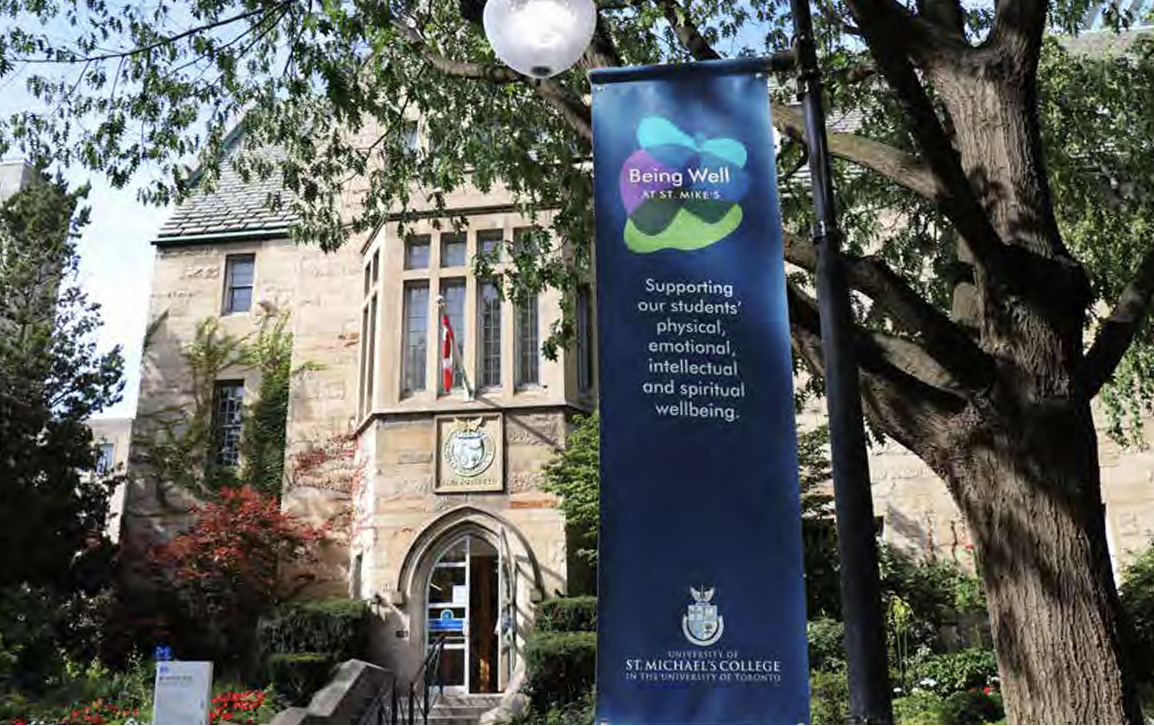
Over the past several years, the number of university and college students in Canada with identified mental health issues has more than doubled. The number of students reporting anxiety, depression and suicide attempts have risen dramatically. A focus on the health and wellbeing of young people is central to realizing their potential. That’s why St. Mike’s views student wellbeing through a broad lens. Students at St. Mike’s have access to the full mental health supports at the University of Toronto, which includes U of T’s commitment to same-day counselling services supports students’ acute needs during crisis and is delivered virtually—the location of these supports has become irrelevant.
St. Mike’s recognizes the tremendous value of the crisis support provided by U of T, and we also remain committed to continuing our approach of providing person-alized support and a robust suite of activities that support students through critical moments while developing coping skills that will last a lifetime. Among our supports we offer:
A Wellness Counsellor provides clinical support and/or counselling services to students who are experiencing personal, social and/or educational distress;
The First-Year Check-in Program pairs incoming students with a professor to demystify the relationship and enhance connections within the St. Mike’s community;
The St. Mike’s Mentorship Program pairs trained, upper-year students who model positive qualities with first-year students to foster personalized relationships;
Commuter Dons and Residence Dons connect students to the larger St. Mike’s community;
Safetalk training is provided to all student leaders and Dons, and on request to other members of the St. Mike’s community, to empower everyone to play a role in suicide prevention by recognizing the signs that someone is in distress;
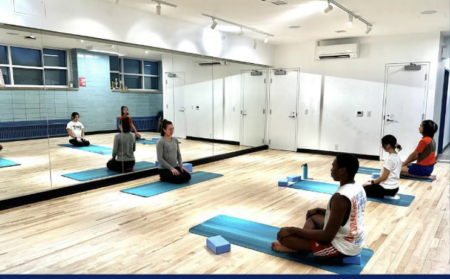
St. Mike’s Wellness Council, a student initiative, is dedicated to providing students access to wellness-based events;
The Student Wellness Studio supports wellness programming such as mindfulness, yoga, and physical activities;
Spiritual support is delivered through St. Mike’s Campus Ministry, St. Basil’s, and connections to multi-faith and Indigenous groups at U of T Academic Support and Advising comes via relation-ships built with professors, mentors and peers, as well as a range of services such as the Writing Centre; and Emergency bursaries offer financial support.
Being Well at St. Mike’s: Should you wish to learn more about how you can help, please contact the Advancement Team at 416-926-1300, email smc.annualfund@utoronto.ca or visit the U of T Giving Day page.
The University of Toronto Student Leadership Awards (UTSLA) recognize students in their final year who have at least one year of significant volunteer leadership and high-impact service.
St. Michael’s is pleased to announce the 2023 award winners and to congratulate students who have shown their leadership and volunteerism and made a positive impact on and beyond campus:
Evangeline Cowie
Shameel Rajnath Mohammed
Sophia Anna Poulimenakos
Andrew Roberts
Ella Tetrault
Awarded for the first time in 2020, the UTSLA awards continue U of T’s long-standing tradition of recognizing outstanding student leadership, volunteer service, and commitment to the university. Recipients of the UTSLA join the distinguished community of past Cressy Award recipients.
Congratulations to the 2023 recipients!
Alessia Baptista is a fourth-year student majoring in English. She is currently the Editor-in-Chief of The Mike Publications, the official bi-weekly student newspaper at St. Michael’s College since 1947. Post-graduation, she plans to further her education by pursuing a Master’s Degree in Journalism, Media, or a related field.
It all started on my Welcome Day, June 8, 2019, when I was walking through Brennan Hall and noticed The Mike’s banner outside of what is now the Campus Ministry Office. I remember getting so excited that there was a campus newspaper that I took a photo of the banner (which I still have). Naturally, I went home and checked The Mike’s website to learn more about how I could get involved and was devastated to see applications for the Masthead were closed. It was at that moment I promised myself I wouldn’t miss next year’s applications.
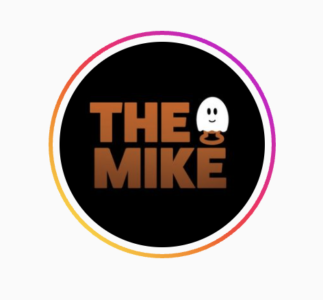
In the meantime, though, I tried to be part of The Mike in my first year as a contributor. I remember picking up an article for the Opinion section about whether U of T’s college book sales were beneficial to students. This was when The Mike broke my heart: the article was rejected, and rightfully so. I had no idea what I was doing. I didn’t know the first thing about writing an article or being in a newspaper, let alone how to write for an Opinion section.
The article that did make it to publication was my first-ever Feature for The Varsity about how caffeine affects students. If you know anything about campus publications, Features articles are the longest since they’re comparable to an essay and, more often than not, students are the least inclined to write for this section due to the length required. With the help of Stephanie, the Features Editor at the time, I finally had an article make it past the writing process and I learned more about how to write for a newspaper.
It was only upward from here: in 2020, I kept my promise to myself and applied to be the Lifestyle Editor at The Mike. I was acclaimed to the position, and that’s where my editorial journey began. While The Mike moved to online publication due to COVID, I had an amazing experience working with Chiara, the Editor-in-Chief of The Mike in 2020-2021. I’d met with her a few times to further educate myself about newspaper production in hopes that one day, ’d be lucky enough to hold a higher position at The Mike. Last year, I had the pleasure of being the Managing Editor for 2021-2022 during another year of remote production.
Fast forward to today and I am currently the Editor-in-Chief for the 75th volume of The Mike. I am especially honoured to hold this position as we celebrate 75 years of publishing student voices, written by SMC students, for the St. Mike’s community and beyond. It warms my heart knowing that I am lucky enough to be a part of something so impactful. Seeing students pick up a copy of each issue, hearing their excitement as they anticipate the next crossword, and working with an amazing team of editors makes all the late-night emails and endless edits worthwhile. You’ll never catch me without a newspaper in my hands or in my backpack, be it The Mike, the latest issue of The Varsity, or even The Strand from Victoria College. I believe it’s especially important for students to have their voices and opinions heard, and I’m grateful every day that I can provide an outlet for expression through contributions in The Mike.
If you can’t already tell, I love what I do at The Mike. As stressful as it may be running a bi-weekly newspaper on top of my studies, I wouldn’t trade it for anything in the world. Being a part of student journalism has significantly improved my writing skills, taught me time management, and enhanced my attention to detail. Above all, it’s helped me realize that I’d like to consider pursuing a career in journalism or media.
Before coming to university, I was fixated on coming to U of T to study Kinesiology, the exact opposite of my current degree. The switch happened when I decided to pursue a major in a subject I’m stronger in, since Math is one of my weaknesses. Growing up, I always loved to read and write–I was the kid who always had a book on her desk in school, got in trouble for staying up and reading at night, and wrote stories in her spare time. My love for writing was always there but being a part of student publications has exposed me to a whole new world of writing beyond creative writing (and, admittedly, I am an awful fiction writer).
The first step to becoming a good writer is to just start. So many students tell me they’re afraid to write articles because they aren’t good at it. I always tell them my story in the hopes that they can hear about how I wasn’t that great at writing, but that I didn’t let that stop me. Even still, I’m constantly improving the way I write, because if there’s one thing about writing, you can edit as much as you want, but you’ll almost never achieve the perfect final piece. There will always be room for improvement, and I think that’s one of the things I love most about what I do. Writing will never go away; there’s always going to be a story to tell. Whatever your story is, or whatever topic interests you, I hope you find the confidence to just start and take a chance on yourself.
Read other InsightOut posts.
A new partnership with Indspire has created the “University of St. Michael’s College in the University of Toronto” award for Indigenous students.
First Nations, Inuit, and Métis students enrolled at St. Michael’s in undergraduate programs, the Regis-St. Michael’s Faculty of Theology, and the diploma in Social Responsibility & Sustainability are all eligible to apply.
Eight awards of $4,400 each will be granted annually. The funds go directly to the students, to be used for tuition, residence fees, or other expenses.
Applications are made via Indspire, which will oversee the selection and award process.
“We are grateful for the opportunity to partner with Indspire to provide support for our Indigenous students,” says University President David Sylvester. “This is a significant moment for St. Michael’s.”
Indspire is a national Indigenous registered charity that invests in the education of First Nations, Inuit and Métis people for the long term benefit of these individuals, their families and communities, and Canada.
Please see the Indspire website for more information on how to apply for the “University of St. Michael’s College in the University of Toronto” award.
“The most important part of SMC Orientation is showing students that they belong here.”
-Alessia Baptista and Sophia Poulimenakos, Orientation Coordinators 2022
Alessia Baptista and Sophia Poulimenakos are this year’s Orientation Coordinators. Alessia is a fourth-year student studying English with minors in French and Anthropology, while Sophia is a fifth year studying Political Science with minors in Sociology and Music History. Orientation holds a special place in their hearts as they both have been a part of orientation since their first day at SMC.
When we were told we’d been given the green light to have a fully in-person Orientation this year you could not contain our excitement. Both of us were orientees in the pre-pandemic Orientations (in 2018 for Sophia and 2019 for Alessia) but neither of us knew that this amazing event that changed our lives would be held in an entirely different way when we chose to get involved. When we signed up as leaders in 2020, the world turned upside down, and the need to find community became even greater. Orientation is special: we would argue it’s the most special and important event any university has to offer. It presents an opportunity like no other to show our new students that SMC is their corner of the campus: a corner that belongs to them and will always be there for them. In times like these, when community building is more valuable than ever, we did not take the responsibility of planning the first in-person Orientation in two years lightly.
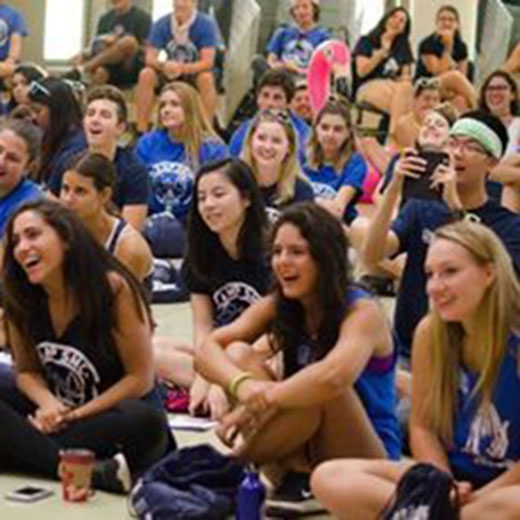
If you asked each of us what the most important part of Orientation is, we wouldn’t say the countless nights planning our events schedule, calling numerous vendors, or even the days we spend contemplating the smallest things (we’re overthinkers; what can we say?). The most important part of Orientation is ensuring each student knows that they belong here. No matter where they come from or who they are, SMC has a place for them.
But it’s only so much to make such a bold statement; we had already found our places within this community, so this year we made it a top priority to implement everything we could to ensure everyone can see themselves reflected in this community.
We started small, right down to our team. Our main concern became who would be the first people welcoming our students to SMC, and we wanted everyone to see themselves reflected in student leadership. We took a lot into consideration, from our younger staff taking on larger roles to ensuring not only those willing to scream at the top of their lungs in front of a crowd would apply for roles, and even encouraging first-time student leaders into our team. Our first step in creating a community where students feel they belong is representing them at the onset. When a team looks and acts like the people they are leading, others feel like leadership not only welcomes them, but needs them to function to their fullest capacity.
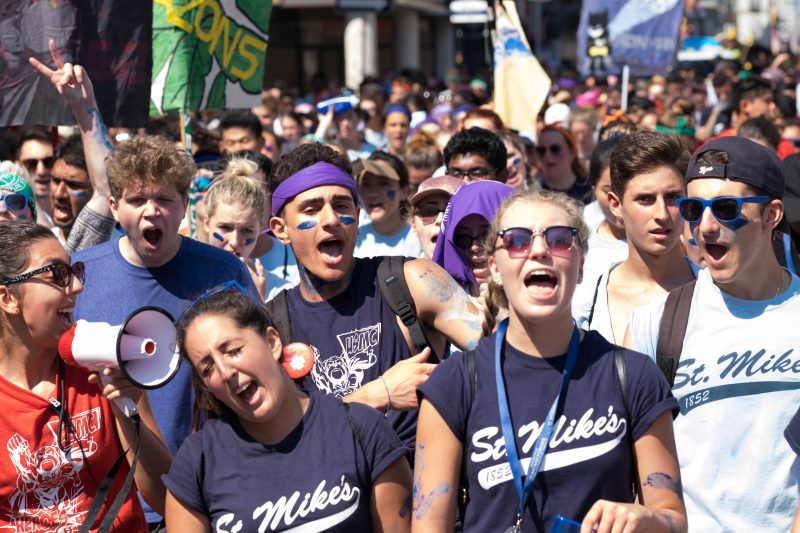
Our next step became looking wider than our own community, even wider than our own country. With both of us being domestic and commuter students, Toronto life came more naturally to us, but that wasn’t the case for many of our international friends. We started holding debriefing sessions with our staff, mainly targeting our international staff members, asking them what we could do better and, honestly, what we weren’t considering, having always lived in Ontario. Resources were huge, from small things such as where to buy groceries or “what even is Presto card?” to much larger things like buying an apartment in the city, applying for a SIN number, or finding mental health and community resources in the city when students felt alone.
We came to the collective conclusion that SMC Orientation was not doing enough to highlight how hard it is to move your whole life to a new country many incoming students had never seen before. The solution was to implement tours of Toronto, international student workshops built right into our Orientation programming, and a Cultural Club Showcase exceeding what SMC can provide. Designed by international students for international students, we granted our team the ability to take the lead on creating the programming they knew would have helped them. With this, our hope was that it would give our international population the chance to even have just a little more ease in their transition.
Of course, Orientation is not without tradition, and the green light to have everything in person meant we got to bring not only new ideas to the forefront but also old ones that our older staff had come to miss. With our theme this year being SMC: Treasure Island, the opportunity to bring back events became even easier. With campus tours disguised as campus-wide scavenger hunts, Zumba parties in the Quad encouraging exercise for their treasure hunt adventure ahead of them, and a Formal at the Hockey Hall of Fame showcasing operation “find the crowned gem” – in this case finding the Stanley Cup and taking a picture with it. All this work to find the most important treasure of them all – friendship! Okay, not just friendship, but the chance to be crowned the winner of the O-Cup and have their team’s name immortalized at SMC forever. This year’s theme is reflective of the very thing we wanted to portray for this year’s Orientation, on a treasure hunt you may feel like you’re on your own towards the goal of finding “treasure” – but what you find along the way is people who want to help you and support you and your goals.
SMC Orientation has always been about team building and finding community, but this year we wanted to make sure that we understand that a community is only as strong as each individual within it. The art of planning the first fully in-person Orientation in two years comes down to combining the new with the old–much like our staff and students–and it becomes our job to ensure everyone finds their place within the place where we found ours.
Read other InsightOut posts.
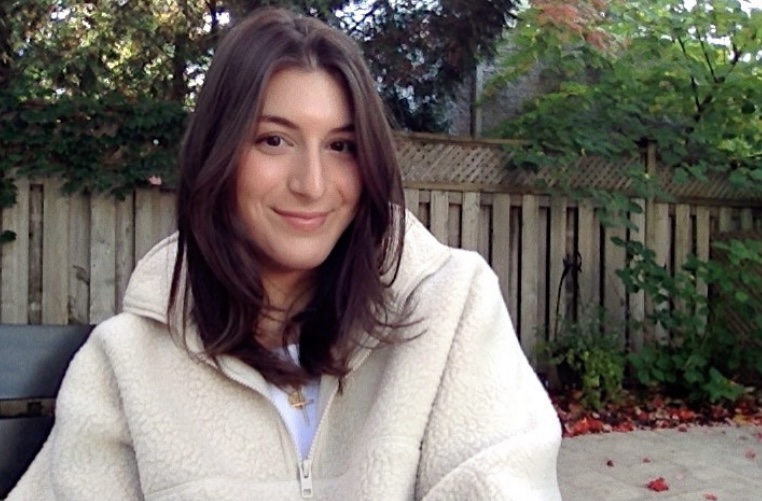
For doctoral candidate Mia Theocharis, an unexpected phone call from St. Michael’s President David Sylvester brought with it the opportunity of a lifetime: an invitation to meet virtually with Pope Francis.
Theocharis has been selected to take part in a virtual meeting with the Pope on February 24. The event, entitled Building Bridges North-South: A Synodal Encounter Between Pope Francis and University Students, is being hosted by Loyola University Chicago in collaboration with the Pontifical Institute for South America as part of the Pope’s Synod on Synodality, a process of consulting Church members around the world to gather their thoughts on the issues of the day.
With an emphasis on creating concrete educational projects to effect just environmental and economic change, the February 24 meeting will focus on issues relating to migration.
Panels of 20 or so students from each of seven regions in North, Central, and South America have been meeting online in advance of the virtual gathering to develop ideas on how to respond to migration challenges, reflecting on the various causes behind and how the Church should respond. Theocharis is one of the three Canadian students in her group, which represents eastern Canada and the eastern United States.
Each panel will have a spokesperson appointed to offer a brief summary of their group’s thoughts at the February 24. These presentations will be followed by a dialogue with Pope Francis.
“While it would be an honour to be the one to present our findings, honestly the biggest honour is to be part of this process,” Theocharis says, describing the drive for concrete ideas and the diversity of panelists she has met in her panel as extremely impressive.
“There are people with backgrounds in economics, environmental sustainability and theology; undergraduates and graduate students. It’s exciting to meet everyone involved, especially those from underrepresented groups, and to hear everyone’s viewpoint.”
The event will be livestreamed on February 24 at 1 p.m. EST.
Eight members of the Class of 2022 have received Student Leadership Awards from the University of Toronto for their outstanding volunteer contributions to the life of the College and the larger University. Over their student careers, they have played foundational roles in the life of St. Michael’s community, founded and led clubs, edited journals and books, and much more.
St. Michael’s Congratulates:
Cianna Choo – Cianna’s leadership roles include serving as Executive and Treasurer of the Arts and Science Student Union, President of the St. Michael’s College Student Union, Orientation Coordinator, Orientation Marshal, Senior Mentor, and Student Representative on both the Senate and the Collegium. Her work on behalf of the St. Michael’s student body has helped her peers experience richer community, and her advocacy has strengthened ties between students, faculty, and St. Michael’s leadership.
Simran Dhir – From tutoring and mentoring her peers to coordinating performances of the St. Michael’s College Troubadours and helping to organize Orientation over multiple years, Simran has directly enriched St. Michael’s community and culture while also helping her fellow students to find support and feel at home. As Major Operations Manager of the Communicatable Club at St. Mike’s this academic year, she has organized regular workshops and events to help students develop soft skills.
Abigail Iyekekpolor – Abigail has invested much of her time at St. Michael’s directly in the lives of her peers, cultivating community and providing support for several years as a residence don and as an orientation leader. She also created the social media campaign #SoulsOfSMC, an initiative that creates space for diverse expressions of identity among St. Michael’s students. It continues to provide a window into the lives of members of the St. Michael’s student body while enriching the larger community.
Fasika Jembere – With volunteer and service experience ranging from direct support for her St. Michael’s peers to leading initiatives across U of T, Fasika has left a deep impression during her student career. She has served as president of the Equity Studies Student Union (ESSU) since September of 2021 and in the role has overseen initiatives in direct response to the pandemic, including the distribution of Covid mutual care packages to U of T students.
Ren Manalo – Ren has supported her fellow students as a mentor with St. Michael’s Mentorship and the Filipino Students’ Association and has helped new students find a home at St. Michael’s as an orientation leader. Currently, she serves as co-president of the Medieval Studies Undergraduate Society, and plans events and generates enthusiasm for the St. Michael’s-sponsored academic program. She has helped grow the Society from a dozen members to a welcoming and diverse community of over 50 students.
Ashwini Selvakumaran – Ashwini was a recipient of the 2020 University of Toronto COVID-19 Student Engagement Award, for which she co-authored an e-book featuring global student perspectives on the pandemic. Her volunteer and service work on and off campus includes engagements in tri-campus mental health advocacy; founding the Brown Citizen Circle (BCC), a non-profit that serves to amplify BIPOC youth voices; co-directing the 2020-2021 annual Peace, Conflict and Justice Student Conference; and serving as the 2021-2022 Editor of the Rapoport Journal of Peace, Conflict and Justice.
Adriana Williams – Adriana was one of nine participants to consult with the Honourable Chrystia Freeland on issues affecting Black Canadians during the pandemic, a recognition of Adriana’s work on behalf of the Black community throughout her undergraduate career. Her four-year association with the Black Students’ Association at U of T culminated in her becoming the organization’s president, and in the role she has continued to help build safe spaces for Black students in the university community.
Ingrid Wong – In a variety of roles with St. Michael’s College Mentorship, Orientation, and Fontbonne House Council, Ingrid has helped her fellow students to feel welcome and included at St. Michael’s. She has also raised awareness of and advocated for human rights as co-president of HanVoice’s University of Toronto chapter and helped shape academic discourse in editorial roles with Synergy: the Journal of Contemporary Asian Studies.
Abigail Lawson has spent much of her adult life travelling and relocating to different parts of the world. Raising her two young children in the Middle East and working as a photographer, she has travelled from countries such as the United Arab Emirates to Greece and Italy to Croatia, capturing weddings for clients around the globe. Abigail has recently returned to Canada after a 12-year hiatus from her studies. A Mediaeval Studies major, she is presently writing her senior essay on the exploration of practical mediaevalisms and their application in the classroom, examining how they might be presented to a student audience.
Courtly Love and the “Chick Flick”
“Lancelot followed her with his eyes and heart until she reached the door; but she was not long in sight, for the room was close by. His eyes would gladly have followed her, had that been possible; but the heart, which is more lordly and masterful in its strength, went through the door after her, while the eyes remained behind weeping with the body.”
Chrétien de Troyes, Lancelot, The Knight of the Cart
The label “chick flick” has been used to characterize a particular film genre for as long as I can remember. The pithy designation is recognizable and some might perceive it as a tad reductive, but I have to admit I love a good chick flick. The films offer escapism—a departure from societal norms—depicting romance through a utopian and often implausible lens. The premise of one film in the genre is typically a carbon copy of the following: handsome boy meets beautiful girl, boy and girl fall in love, unforeseen obstacle stands in the way of said love, a battle is fought and won, and the couple live happily ever after.
Although the idea of romance has evolved since the Middle Ages, many people genuinely believe that Cupid’s arrow will strike, and fate will bring them to their soulmate. We love dreaming of a fairytale ending. When that initial spark inevitably fizzles, some believe—sadly—that it must be over. Many of us are searching for that glittery romance repeatedly depicted on screen and in books —ignoring the possibility that this may only exist in fiction. Many men struggle with a hero complex and believe that to be respectable and worthy, they must “save” the woman they love—her knight in shining armour. Women today share more equality with their romantic partners, and finding a woman who needs—or better yet—wishes to be saved by a man can present challenges.
When considering medieval romance and its relationship to modern romance, it is evident that the game has changed; however, the feelings associated with love and romance have not. Romance is depicted as attractive, scary, and even magical in the modern world—just like an excellent medieval romance: “Love without fear and trepidation is fire without flame and heat, day without sun, comb without honey, summer without flowers, winter without frost, sky without moon, a book without letters” (Chrétien de Troyes, Cligès).
Romance, interestingly, has not always been a thing. It stemmed from the mediaeval concept of Courtly Love. The romance was a genre of high literary culture which blossomed in the 12th-century courts of the romance super-fan, Queen Eleanor of Aquitaine. Courtly love, or fin’amor, highlighted nobility and chivalry, following a set of codes and behaviour for ladies and their lovers. Today, these notions exist in our minds with lines such as “Chivalry is not dead!” In romance literature, knights performed extravagant bravery and gallantry for idyllic ladies above their station. Within the narrative of mediaeval romance, we see idealized gender roles through stories rife with overt masculinity and impossibly high standards of beauty and innocence. The patterns of masculinity perhaps unlock mysteries of the past while explaining why the courtly tradition of the chivalric hero is not only very much alive but perhaps here to stay.
Courtly love was never fixed but always unpredictable because Cupid, the God of Love, often initiated it and not the lovers themselves. The epic tales were wonderfully cheesy—often heart-wrenching—depicting undying love, magic and romance. Is it possible that courtly love is to blame for our idealized perception of love? Although today we use words such as courtship, chivalry and romance, somewhere over the centuries our wires have been crossed because the mediaeval poets who first wrote tales of love and chivalry would likely find our notions of romance very different. Literary works from authors such as Chretien de Troyes, Marie de France, Geoffrey Chaucer, and Andreas Capellanus present a unique perspective on social dynamics found within Arthurian courts in the Middle Ages.
Did these stories represent escapism? Probably. The medieval world left little space for a true love story; perhaps the nobility’s only connection to romance was through fiction and fantasy, as courtly love was not associated with marriage. The constraints of a loveless marriage, favouring financial practicality over love, were conceivably a preoccupation found within courts. The confines of society dictated whom one married; therefore, the nobility was left to love from afar. As Andreas Cappellanus stated in rule number one of his Rules of Love, “Marriage is no excuse for not loving.”
Today we pursue a relationship to fall in love and share a bond with our romantic partner; in contrast, mediaeval tales of romance rarely expected their true love to reciprocate. We often associate love and romance with flowers, doves, and heart-felt gestures of devotion—or for this medievalist—stories of brave knights such as Lancelot and his catastrophic love affairs with Queen Guinevere. Our distorted associations with romance could be in part thanks to mediaeval courtly lovers and their impossibly romantic prose.
Have these tales tainted how we connect and identify with love and place undue pressure on the idea of finding “the one” and “living happily ever after”? One thing is sure: the romance genre—both mediaeval and modern—reflects our insatiable human desire to connect with the excitement and mysteries of love and passion.
Read other InsightOut posts.
Rohma Khan is a third-year student majoring in Near and Middle Eastern civilizations and double minoring in philosophy and diaspora and transnational studies, with pronouns of she/her/hers. She has been an equity officer for UTMUN and Orientation leader for SMC. She is SVEP- (Sexual Violence Education and Prevention), IAR- (Identify, Assist, and Refer) safeTALK, and LivingWorks-certified. Currently a Don!
Let’s Talk Frankly
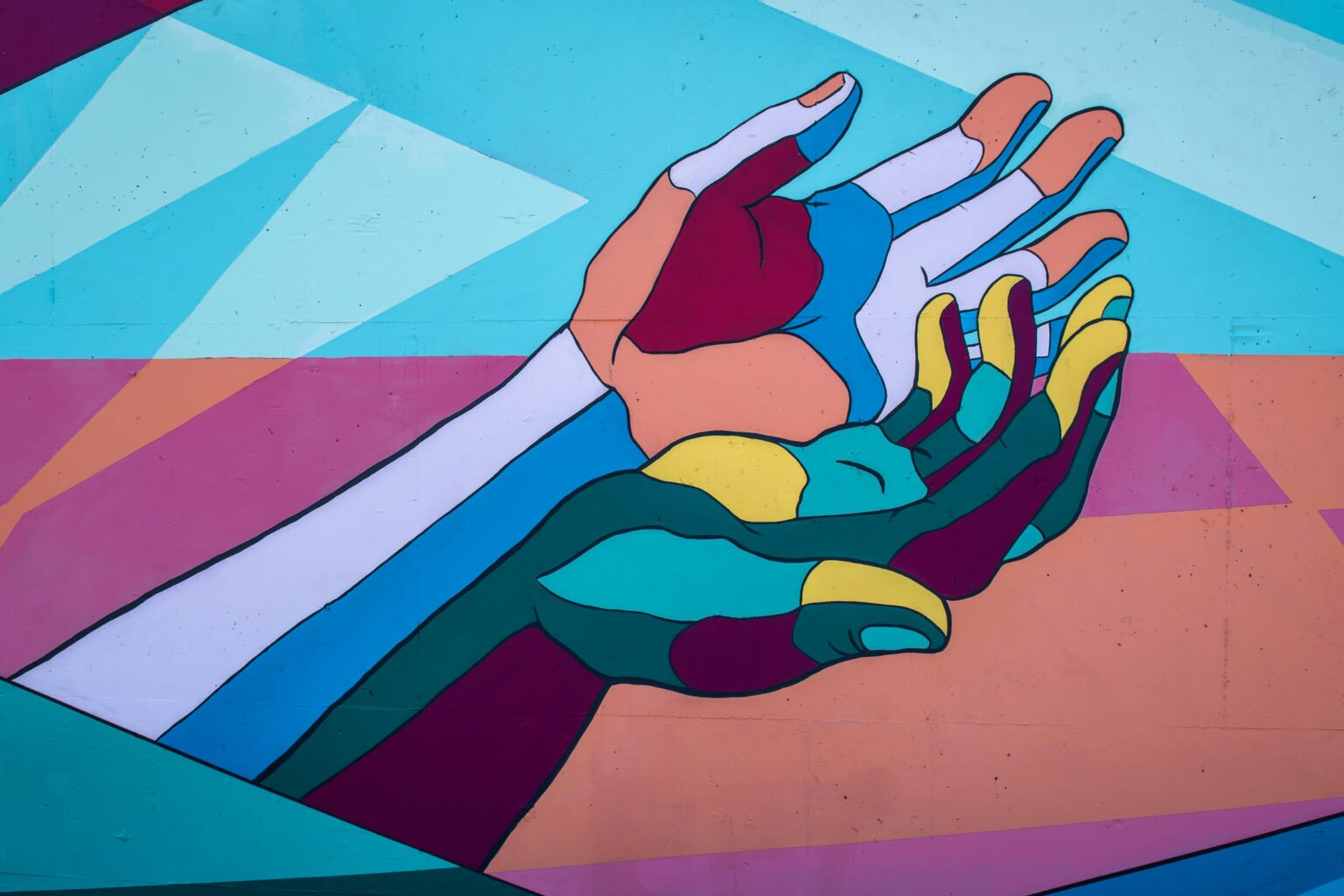
Being a Don is mostly about making sure students feel safe. It’s simple enough in theory; I attended strategizing workshops for programming, promoting inclusive attitudes, and training in suicide-prevention support. This preliminary, foundational understanding I was introduced to alongside other SMC Dons would be key in forming the safe and welcoming environment we envisioned for all SMC students. Learning the concepts and strategies in training compared to applying them in real life turned out to be quite different. I didn’t really know where to begin.
In trying to apply my training, I found myself pulling on my first-year experience to help re-orient my perspective to the potential concerns of my incoming residents. When I came to reminiscing, I realized their experience would be nothing like mine. My first semester was in person, pre-pandemic. I couldn’t relate to the added stress of living through Covid-19 whilst trying to navigate university for the first time. So I pivoted. Instead, I tried to relate to them through the general feelings of anxiety, panic, burnout, stress, and depression, all the things I felt and even continue to feel while being in school as the world confronts Covid-19.
I remember the fall semester of 2020 well: there was no confirmation of vaccine roll-outs, Toronto was going in and out of different levels of lockdowns, the politically charged American climate was starting to manifest in downtown Toronto on the streets in protests, racial and ethnic discrimination was flourishing, as it continues to today, under the umbrella of the virus, and professors re-instated online live, proctored exams, maybe in an effort to return to some state of normalcy after the previous semester ended abruptly in cancelling all exams. I had never had so many panic attacks in four months as I did that semester. Trying to keep my GPA competitive for law school applications in five courses as I worked every weekend at my part-time job while not being able to be with my support systems because of the pandemic was utterly overwhelming. What was worse was that I had internalized my state of chronic pain and thought it normal. I did not want my residents to ever feel like the situation they were in was normal; that the pandemic was normal, that their feelings of burnout and stress were normal. In fact, I want to throw away the word normal. Pain and suffering, sleep deprivation, panic and stress, malnutrition are terms that have all been so normalized in the discourses surrounding university students that the blemishes this pandemic painted on our mental health have been overlooked by both the structures and systems of academia and even ourselves as its participants. It is not enough for the conversation surrounding mental health to be augmented; it must be carefully crafted to the nuances and particularities of a given situation. It must be recognizable and relatable. It took me some time, but I did realize that feeling so horrible all the time is not right, it is not the way to live my life, it is not the way to experience meaningful education, and it is completely unfair to me.
What implementing this realization looked like for me was to have more patience with myself. Procrastination and the looming stress of deadlines for work that always seemed unfruitful would lead to last-minute stress-induced essays that would not attain the marks I expected of myself. It was a cycle. So, I began to incorporate productive procrastination in which I would allow myself to only procrastinate so long as I was doing something that truly made me happy; this looked like making a lot of chai over the semester in my room and watching a lot of Friends episodes, going for walks on campus, cleaning routinely and deeply, working out, or even dancing in my room. Suddenly, I wanted to get my work done faster because I wanted to feel free of responsibility when doing the things I enjoyed.
Another strategy that may work for some is to be kind to yourself. It is a simple idea that means more than some can stomach. For students who are trying to do four to six courses a semester and are unable to sustain their mental well-being in doing so, try re-evaluating your priorities. Is it imperative you take four courses? Does it have to be in this department that you don’t really enjoy? Does it have to be now when you are not at your best? Does it have to be here? Stress can serve as a motivator, but if you find it getting in the way of your work rather than helping it get done, there is an issue. Ultimately, this may look like lightening your workload. There is not much wiggle room here. You may need your transcript to look a certain way, and I completely sympathize with that, but you must ask yourself: at what cost? You come first. Your mental health comes first. There is no normal path to graduation or to a job. Normal does not exist because everything is susceptible to change, every obstacle you face is malleable. Plans can be re-made, can be achieved later, somewhere else, with someone else, every problem can be combatted with new strategies. There were so many opportunities for growth and experience that I couldn’t even comprehend because my mental state was forcing me to live in a rigid structure where I relived pain; my existence was stagnated. Every day I didn’t take care of myself was another day I was stuck in the cycle of harm. I wasn’t being kind to myself, expecting me to get as much done post-pandemic as I did before. Treating myself as a priority realigned my problems in a way that seemed manageable.
The greatest thing I learned in this time, which I continue to incorporate in my support to SMC students, is that community is everything. What remained steadfast for me this year was the support of the Don team. As a new Don, trying to be the kind of person I needed at my lowest for my residents seemed daunting. However, the Don team was exemplary in the care and encouragement they offered me and the students they supported. I learnt how to implement my training alongside my team as they shared with me the similar concerns they had for the community. Knowing that I was not alone in my troubles was half the battle. Checking in on one another, offering each other advice, solace, and comfort helped ease everyone’s minds in these uncertain times.
It was this key insight that made sense of all my training: I am not a trained psychologist, nor am I trained in counselling; I have no experience in being a certified mental health support of any kind, and yet it doesn’t matter. What I am is support. Just like I needed the support of my team to orient me, another may need support to guide them through their concerns. Referring students to the correct people, whether it is on-campus to the U of T wellness centre, U of T accessibility services, our SMC wellness website, the Registrar, the Assistant Dean’s office, or off-campus resources for immediate support like Good2Talk, is not necessarily always about providing an answer, it is about making sure they know they aren’t alone looking for one.
Read other InsightOut posts.
Hedieh Hashemi is a second-year undergraduate student studying Molecular Genetics and Microbiology. Hedieh was one of the orientation marshals in this past year’s orientation, and she currently serves as the St. Michael’s College Student Union (SMCSU)’s Vice President.
Applications are being accepted for the position of Orientation Coordinator until January 23.
The Summer I Found My Home Away from Home
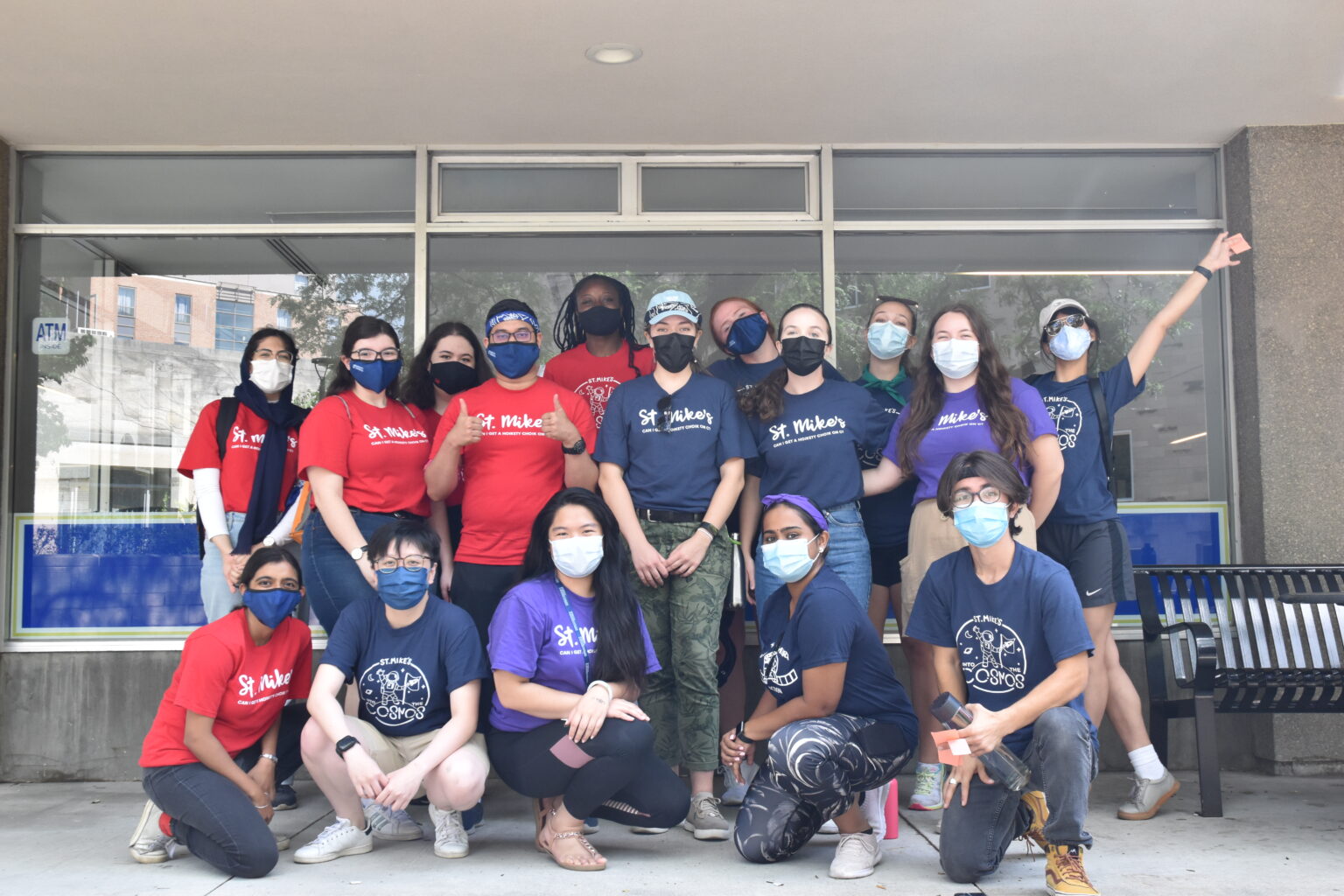
I was the most excited when I got my offer to be a marshal for Orientation 2021. Going through orientation again, this time as staff—how could it get any better? Things were exciting on paper, but as the first meeting came around, I felt nervous. Not knowing anyone on the team—and my not-too-good skills in making friends—added to the online format of everything, all making me doubt if I belonged there. It was hard to believe in myself and trust that I was making contributions to the team.
My overthinker brain, however, wasn’t able to stop me. The good vibes in the meetings, and the excitement that came with every task related to orientation, kept me going. Patience and time cure a lot of things and they surely did work in my case. With every meeting, I got to know my teammates better, I learned that my efforts are appreciated, and the team was so supportive that soon enough I too started to feel confident.
Things got much more exciting as we got closer to Orientation Week—and the best news? We were going to have in-person events too!! Having missed an in-person orientation as a first year, I was so happy to have the opportunity to experience it. Spoiler alert: the in-person experience exceeded my expectations.
I’m not sure if it was because of everything being online for too long and me forgetting what things were like in real life but the environment around SMC was so nice! Every time a familiar face was passing by, there was a wave and a smiley face (technically smiley eyes—masks, you know?). People were so approachable, whether they were orientation staff, orientees, college staff, or the dons. Just a little “Hi!” could be a conversation starter—although I have to give some credit to my red marshal t-shirt too, which made me extra-brave to walk up to someone I’d never met before and start a conversation.
The week was full of fun events, but naturally at some points, things got rough, and there were nights when I got home tired and drained, thinking “I’m done”. And nope, I wasn’t. The next morning, at our daily 8:30 am meeting, seeing the faces of my teammates all full of enthusiasm, hearing affirmations from the Orientation Coordinators (OCs) first thing in the morning, and the team cheering each other on, all made me feel like I could keep doing this forever!
Throughout the day, there were so many small scoops of care here and there: the OCs checking in any time they were passing by, Emma (our Assistant Dean of Campus Life) always making sure the food suited everyone’s dietary restrictions and that no one was excluded, us being asked to put in the group chat and let others know that we’d got home safely whenever we were leaving late at night.… How could I not appreciate my time spent at orientation?

This orientation—which was my first-ever major in-person university experience—made me appreciate in-person interaction a lot more. I was reminded how it’s all the simple things that bring us closer together; things like sitting together and eating together, carrying a box full of orientation T-shirts together, and even running together during bed races (yes, I did have the honour of running in the bed races—and no, my legs weren’t ready for this after a year of staying at home).
This orientation also taught me that I am a fake upper-year, at least when it comes to the campus. During the week I was co-leading some of the campus tours, but did I have any clue what I was talking about? Please don’t expect a yes from me. Good thing was, by the end of my third campus tour I knew all the details of the campus so well that Google Maps might have needed to consider retiring.
Thinking about the bigger picture, it’s just fascinating how all of us came together and did all this work to welcome the new class into our community, and how we did everything we could—from giving tips and running workshops, to setting up campus tours and socials—to help our new class succeed. The passion for giving back to our SMC community made the whole process and all the efforts so much more meaningful.
And yeah, this is the story of me finding my SMC family and falling in love with this college we call our “home away from home,” all thanks to Orientation 2021.
Please note: Orientation 2021 was a hybrid event with all in-person activities following appropriate safety measures.
Read other InsightOut posts.
Matilda Horton is a Victoria College student in her fourth year of her Undergraduate degree, studying Celtic Studies and Drama. She is currently working as an executive for the Celtic Studies Course Union and is in the process of applying to Celtic Studies MA courses across the UK and Ireland. Tilly would be happy to discuss all thinks Celtic Studies at any time, so long as you have a few hours to spare.
A Love for the “Curious World” of Celtic Studies

Some of the first questions asked of Celtic Studies students at the beginning of their introductory classes include: What is Celtic Studies? Who were the Celts? What makes up the Celtic identity?
As you can imagine, I was taken aback by these questions. Aren’t they supposed to tell us what Celtic Studies is? Isn’t that why we’re all here? How can I possibly know all this already?
What I didn’t realize in those first few classes was that Celtic Studies is the pursuit of answers to big questions about a relatively small part of the world. As a life-long lover of puzzles (and their clear-cut solutions), these questions both excited and terrified me. After the initial panic of being met with so many unknowns, I settled into a comfortable state of uncertainty, and this is where the real work began.
Like many of my peers, I came to the program with a genuine interest in Celtic history and identity but with little concrete knowledge. One of my best memories is being seven years old, standing on the side of the road in the north of Scotland. I remember looking around me at the vast landscape and feeling an inexplicable age and weight in the world around me. Since then, I’ve been determined to learn as much as I could about the Celtic world and its history. When I discovered that St. Michael’s offered a program in Celtic Studies, I couldn’t imagine studying anything else. Every day I am offered the opportunity to reconnect with the world that has fascinated me for so long. With every class my peers and I get to dive deeper into the history, culture and concepts that bring back that same feeling of awe in me.
With every class this curiosity is piqued and amazement grows. There is virtually no end to the things we are able to explore within the program. I have been able to delve into Celtic art, history, politics (both modern and ancient), mythology, language, literature, law, music, and so much more. My classmate are musicians, writers, historians, and artists—all of whom, like me, have found a love for the curious world of Celtic Studies. Although the program is on the smaller side, it is mighty. With a variety of student-led and department-run events (Céilí events, guest lecturers, hurling practice, film screening and even baking!) the Celtic Studies community exists vibrantly outside the classroom.
The scholarly experience in Celtic Studies is truly like no other as students have the freedom of studying under a department that is eager for us to explore. Professors challenge students to go further; to follow our inquires as far as they will go, dare to not know, and most of all keep asking questions. Because of these core values of the program, my peers and I have been able to study topics and build skills we never could have imagined (reading ancient Irish and Welsh texts), never thought ourselves capable of (learning a Celtic language!) and will have gleaned facts that will likely stick with us forever (the validity of The Wicker Man: sacrificial ritual or Nicolas Cage film? The world may never know).
I often get the question “what’s next” in my studies. People struggle to see where a degree in something so specific yet all-encompassing may lead. To that I usually have no definitive answer. Not because I have no opportunities: it’s actually quite the opposite. From my degree I have been able to explore paths I never thought possible. Maybe I will work in translations, or publishing, archives, teaching, writing, cultural studies, politics, or curation. Or maybe I will fall in love with a field of Celtic Studies I have never even considered. Ultimately, I am led by that affinity for the endless exploration that this program has instilled in me. As I apply for MA programs across the world in Celtic Studies, I do so fueled by my desire to explore and with an eagerness to see what I discover. No matter what, I will always be asking questions about the Celtic World. What next indeed.
Read other InsightOut posts.
Angelika Garvey is a fourth-year student at the University of St. Michael’s College double-majoring in Book and Media Studies and Sociology. She is currently working as a social media marketing manager and event coordinator. As an active volunteer, she helps in non-profit charity organizations, teen camps, and takes part in missionary and humanitarian type aid trips.
Falling in Love with Book and Media Studies
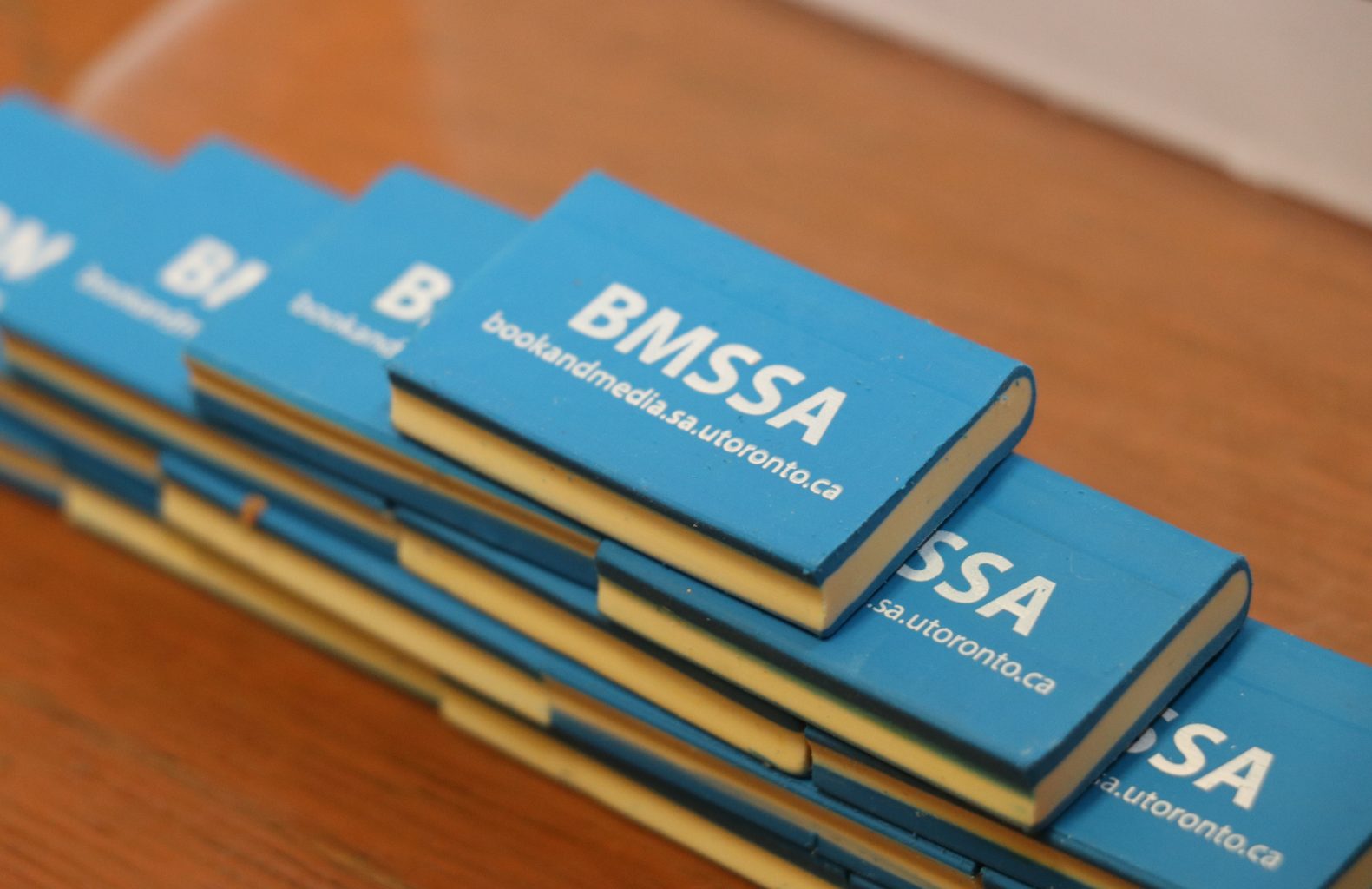
For students, no doubt the choice of the accurate academic program for the next four or so years is one of the crucial decisions in life. I’d assume that for most—well, as in the case for me—the decision of program enrollment is based on two conditions: sincere curiosity and passion for learning, plus the consideration of demand in the job field.
In the search for an ideal place for me, I spoke to advisors, graduates, and researched, researched, researched on my own. During one of the conversations, I was handed a U of T program brochure. It was then I got introduced to Book and Media Studies.
“Well, this is interesting,” I thought. “But, what is BMS even about? And how can I apply the learned knowledge in the future, particularly after graduation?”
Based on the positive feedback and insight I got from graduates of this program, I finalized my decision. But in all honesty, my main focus was in the insight behind the word “media.” Books? Not really.
While it took a few months for me to discover—or I’d say dig out—passion for literature and reading as a way of acquiring knowledge, it took just the first lecture to fall in love with the material and the way it was delivered.
I remember this day as if it were yesterday. Carr Hall of St. Mike’s. Twelve p.m. The noise of about 50 students in the class just chatting around, laughing, snacking. Some were on their phones of course, and a few were even reading.
Then, sharp on time, ten minutes before class, Professor Paolo Granata flies into the classroom with a huge smile, greeting students who were within his reach.
“Let’s explore! We are the Toronto School of Thought! Medium is the message!” It was then I thought to myself, “I have no idea what these phrases mean, but I like this.” Four years into the program and the desire of coming to the classroom and indeed, exploring, has grown. And ultimately the knowledge and experience as well, of course.
Working in the sphere of communication and marketing as a social media marketing manager and events coordinator, this program has given me a combination of both: the theoretical foundation and hands-on approach I’ve been applying in my daily work, whether it be translating publications, editing content, speaking to influencers and clients, or routinely engaging in projects.
BMS provides a variety of necessary interdisciplinary courses, including comprehension about foundations of literature, mastery of bookmaking and writing processes, deep analysis of the world’s widely recognized works put together by scholars across the globe, application of critical thinking, and technology’s role in our society.
Ongoing training and access to resources and guidance, as well as the ability to meet and connect with guests and speakers from different disciplines, are the ultimate, irreplaceable parts of this unique program.
Having professors who work in the sphere of communication and have brought an enormous impact in the field of media certainly equips and encourages students to explore the unknown and go beyond the fixed perspectives and thinking.
A course taught by a guest professor, award-winning writer and journalist Sam Tanenhaus, “Trump and the Election,” is a vivid example of how, with the use of theory and knowledge, students got to analyze media’s role in elections, the portrayal of elections to the public through different means of communication, and citizens’ reaction to it.
I mean, how cool is that? Having courses and workshops which are constantly adapted to the high speed of technological development and current phenomena in the world of journalism, and communication?
By building the empire of knowledge, students nail how to produce publications using different techniques and writing styles, with the style depending on the intention of the piece (yes, we learn about these distinctions, too).
I couldn’t agree more with the quote that Professor Granata always cites to his students: “You are the average of the five people you spend the most time with,” implying that our social learning surroundings shape us as individuals. And St. Mike’s is the right, growing environment of connection, where students get to exchange skills and knowledge and build a friendly community.
If I could give one piece of advice to students who are willing to pursue the broad and thriving journey of communication studies, I would probably emphasize that, to get to the unfamiliar, we’ve got to nail the basics. The willingness to learn, ask questions, experiment, go beyond the fixed perspectives, takes us way farther down the road than we can even imagine. And it is indeed a worthy journey that will pay off, literally, too. Critical and creative thinking, strong analysis, reading, writing, and communication skills are the crucial work ethics of the modern day.
Read other InsightOut posts.
St. Michael’s Assistant Professor Stephen Tardif offers a preview of his new course Dante and the Christian Imagination in this Mediaeval Minute:
Former St. Michael’s College Student Union president Cianna Choo reflects on the role of the student union in building community at St. Mike’s.
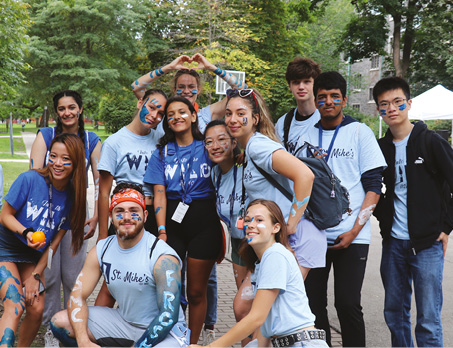
Cianna Choo attended her St. Mike’s orientation in the fall of 2018 and never looked back. “I fell in love with St. Mike’s instantly. The pride you feel walking along Bloor St. screaming cheers,” she recalls. “I knew I wanted to be involved.”
Soon she found herself immersed in activities and has done everything from sitting on a search committee to serving as one of two orientation coordinators for incoming students this past fall.
Today, the 3rd-year Neuroscience, Molecular Genetics and Microbiology student has just finished her term as president of the St. Michael’s College Student Union (SMCSU).
“Whether during COVID or during regular, on-campus times people are looking for a place to fit in while also looking for people who challenge them to think differently,” Choo says in explaining the attraction of St. Mike’s for students. SMCSU wants to engage St. Mike’s students no matter where they are studying on campus, and we have a goal of seeking collaboration. We have around 5,000 students and not all are on the same path.”
One of the places where SMCSU is seeking that collaboration is at the St. George Round Table (SGRT), a student union comprised of divisional student society heads at U of T.
“I feel I’m being heard at St. Mike’s,” Choo says, but with so many students studying across U of T, it is important that she, as a student spokesperson, raise St. Mike’s students’ ideas and concerns to U of T’s community as well.
At St. Mike’s, SMCSU continues to brainstorm and talk to President Sylvester on important issues such as increasing health and wellness supports for students.
“When you’re struggling academically or personally, it is really important that wellness services are accessible and that St. Mike’s can respond immediately,” she says.
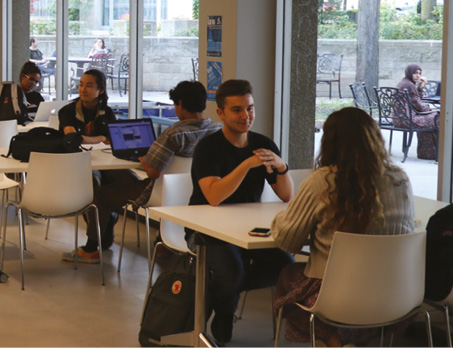
SMCSU’s eye on collaboration also means being conscious of the balance of caring for both residence and commuter students.
“We are passionate about ensuring that what we give to residence students we give to commuter students too. We are hoping to balance these plans by increasing gathering spaces for commuters, such as creating a larger commuter lounge.”
While attentive to traditional student activities such as Friday night socials to bring students together at St. Mike’s, the student leadership team is also focused on issues such as carving out more support for international students.
“International students pay high fees and are often far from home. They are our students and we need to help them feel welcome, feel at home.”
Whether speaking with commuter students or residence students, those from across the globe or from suburban Toronto, Choo says her advice to new students is the same: “Try as many things as you can. Explore and be open to opportunities you might not have considered before. Each experience is a chance to learn more about yourself.”
From University of St. Michael’s College President’s Report, Spring 2021
Joshya Singh is a third-year student pursuing a specialist in Pathobiology (LMP), a major in Physiology, and a minor in Bioethics. She is the Co-Coodinator of the St. Mike’s Mentorship Program, a part of the Research Opportunities Program, and has been a mentor and a leader in the Orientation team in the past.
Andrea Taylor is a fourth-year student specializing in Health and Disease and minoring in Physiology and Immunology. She serves as Co-Coordinator of the St. Mike’s Mentorship Program, Copy Editor of The Mike Newspaper, and as Secretary for the U of T Mental Health Association, which is a program focused on promoting awareness on mental wellbeing.
Going Strong, Together: The St. Mike’s Mentorship Program
“The delicate balance of mentoring someone is not creating them in your own image, but giving them the opportunity to create themselves.” — Steven Spielberg
Mentorship is synonymous with support and togetherness. It’s a human endeavour through which a mentor provides direction and advice, shares their foresight, and is willing to advocate for their mentee’s dreams and aspirations. It’s a relationship that shares mutual trust, understanding, and respect. It’s a space where both individuals can express what they know—and also the things they don’t. Most importantly, it’s a promise that a mentor makes to their mentee—to provide not a quick-fix to all problems but to be there while the mentee learns and grows capable of discovering solutions themselves.
This philosophy has been the very inspiration that laid the foundation of the St. Mike’s Mentorship Program. This year, our team consists of two coordinators, eight senior mentors, and 43 mentors—with every individual committed to be there for all 233 mentees in the Program.
Each mentor is responsible for communicating with five to six mentees, either through weekly correspondence, monthly meetings, or simply when their mentee has questions. Our team of mentors take pride in their mentees’ hard work and achievements which have brought them to the University of Toronto and to St. Mike’s. They are also prepared to support them in their journeys ahead. Mentors have been equipped with invaluable skill sets learnt through a 7-week period of comprehensive training. During this time, Mentors have been instructed on topics relating to precise resource provision, confidentiality, boundaries, effective communication strategies, mental health, principles of equity, netiquette, and accessibility.
They are also supported in their pursuit by our wonderful senior mentors, who not only supervise their own team of mentors but also work collaboratively on five important portfolios, including Event Management, Professional Development, Mentor-Mentee Relations, Media Promotions, and Team Development.
The St. Mike’s Mentorship team is not only committed toward providing guidance to its mentees but also aims to conduct a series of workshops and events to enable professional, academic, social, and personal growth. Our upcoming Professional Development workshops are focused on accessing university-sanctioned resources; we aim to host guest speakers from a variety of departments and specialities, such as: mental health counselling, academic success, health and wellness, and college tutoring services. These workshops are designed to provide first-years with a toolkit of academic and professional skills essential for success at university. They are intended to educate students of diverse career paths, internship and research opportunities while also connecting them to the staff and alumni network here at St. Mike’s. In addition, they will go into detail on how to navigate platforms such as the Career Learning Network and the technical aspects of applying to various Programs of Study.
Our Professional Development workshops are beautifully complemented with numerous spirited events meant for social interaction, personal well-being, and advocacy. Our team hopes to come together and celebrate the student body at our college, whether it’s through a culture festival at St. Mike’s, a mindfulness and yoga session, or an outdoor movie night. We also hope to advocate for equity and inclusivity through initiatives such as the Program Thanksgiving food drive, the promotion of innovative start-ups, and tributes to individuals who stood for their rights in society.
Ultimately, we hope to provide a space where students can learn from one another and from the experiences they have as a part of the Program. For our team, this translates to skills like teamwork, problem solving, critical thinking, and judicious decision-making. For our mentees, this is a great opportunity to reflect and become more self-aware, collaborate with peers, and gain valuable relationships along the way. For us, we hope it continues to be a source of growth in leadership, kindness, and mutual encouragement.
More than anything, the Program’s course so far has given us confidence that our team’s dedication will help mentees discover who they are, and who they want to be in the next four years of their undergraduate experience—ultimately paving way to a wonderful year of mentorship—full of support and togetherness.
Read other InsightOut posts.
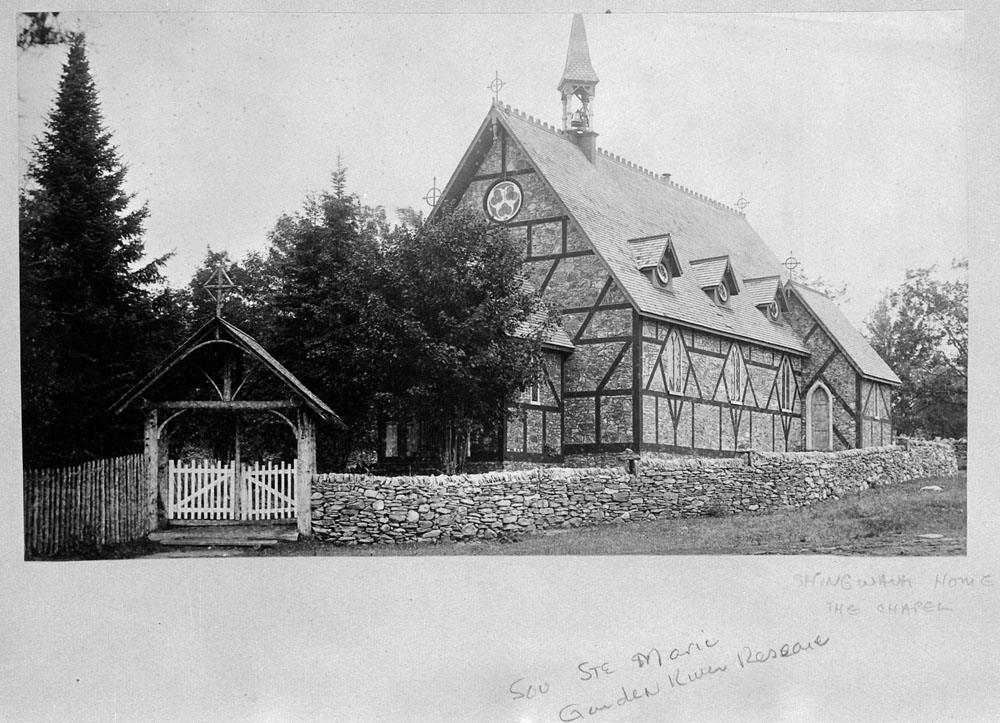
A new course at St. Michael’s will take a deep look at the history and legacy of residential schools in Canada. Christianity, Truth and Reconciliation is offered as a First-Year Foundations Seminar and is open to all first-year students in the Faculty of Arts & Science in the University of Toronto.
A significant portion of the course will be the presentation of parallel histories: invitations to collaboration and mutual listening on the part of Indigenous leaders, and the all too frequent, tragic rejection of these amicable overtures by both church and state officials.
“My hope is that students come out of the course with the clear-eyed understanding of the way that European Christianity collaborated with the Canadian state to implement this program of cultural genocide—a clear-eyed view of the complicity in this project—but also a clear sense of other possibilities of relationship,” says course creator and Associate Professor Dr. Reid Locklin. The latter half of the course will also present ways that Indigenous Christians and Indigenous partners in conversation with Christians seek a creative rethinking of the Christian tradition on Turtle Island, the name many Indigenous communities call North America.

Locklin uses the term “cultural genocide” to describe the “total program” of the Canadian government to “exterminate Indigenous persons as Indigenous persons [and] remake them in the image of white Canadians,” a program in which Canadian churches were complicit. Because St. Michael’s is a Catholic university, the course responds to Calls-to-Action from the Truth and Reconciliation Commission report directed at both churches and educational institutions.
“We think about—one—do we have a place for looking at this history, particularly as a Catholic school, but also—two—how do this history and the rich traditions of knowledge in Indigenous nations and peoples have an impact on how we teach everything?” Locklin says. This second theme of the course opens a “less well told history of creative engagement of Indigenous persons and nations with Christianity,” including Sacred Feathers (Peter Jones), a Methodist minister and leader of the Mississaugas, and Louis Riel, a Catholic Métis who played an important role in the formation of Manitoba and Canadian confederation.
Bringing one of the course’s themes directly into its pedagogy, a key piece of Locklin’s course is a partnership with the Shingwauk Residential Schools Centre. Located at Algoma University, the centre maintains an archive of records related to residential schools across Canada, including both an Anglican-run residential school that operated on its grounds and a nearby Spanish Catholic residential school. The centre will make these archives available to students for research and exploration.
“The Shingwauk school was used by the state for cultural genocide, but when Anishinaabe leaders originally initiated the school they had a different, creative vision for what that school should be,” Locklin says, and that vision combined their own knowledge traditions with elements of European learning. The state’s dismissal of this opportunity for partnership is one of the “lost opportunities” he wants students to learn about in order to be able to see “the possibility of alternative pasts and alternate futures.”
Shingwauk itself is built on a model of partnerships with the Garden River Reserve and the Anishinaabe Nation, and when the centre was formed it established an advisory committee of residential school survivors. As part of Lockin’s final unit on apologies and reparations, students will have an opportunity to hear from a survivor panel. Locklin hopes that future students will be able to visit Shingwauk as part of the course.

There are lessons about this past available in the very ground on which St. Michael’s campus stands, and the course itself is one part of the University’s larger engagement with the Calls-to-Action of the Truth and Reconciliation Commission. Locklin received a grant from Arts & Science to create treatylearning.ca, a website that offers a non-Eurocentric revisionist history of the land.
Uncovering untold stories about the land St. Michael’s operates on is one aspect of a larger effort to accept rather than ignore an invitation to partnership, allowing Indigenous histories and traditions to reframe the University’s story. Other past related initiatives at St. Michael’s have included round table and blanket exercise events at the Faculty of Theology, reading collections in the Kelly Library, and reading groups for staff and faculty on Indigenous histories and issues.
“It is very important that a Catholic University address the Church’s engagement with Indigenous peoples in a meaningful way as a means of uncovering the truth, which is a necessary step to reconciliation,” says St. Michael’s Interim Principal and Vice-President Mark McGowan. “This seminar engages the students with primary sources relating to this Christian-Indigenous encounter and addresses the tough questions that have arisen from this history in Canada. A seminar of this nature is long overdue.”
Ren Manalo is a fourth-year student at the University of St. Michael’s College majoring in Genome Biology and double-minoring in Anthropology and Mediaeval Studies. She was part of the inaugural class of the Boyle Seminar in Scripts and Stories and is serving as Co-President of the Mediaeval Studies Undergraduate Society. She is currently writing her Senior Essay on the inception of the Black Death in mediaeval Europe.
Chronic Curiosity and the Timelessness of Mediaeval Studies
I like to think of myself as “chronically curious.” It sounds better than “indecisive.” Though perhaps I have my indecisiveness to thank for getting me to where I am today.
I remember furiously typing backstage during the dress rehearsal of my high school’s spring play, still wearing the itchy wig that I had to fight to keep on while performing. I can’t recall exactly what drew me to the Boyle Seminar (I had intended to pursue a career in pharmacology, after all), though my general interest in history and the promise of a trip to Ireland were likely compelling factors.
Whatever the case, there I was, frantically filling in an application for the SMC One course. I never would’ve admitted it back then, but I was only half-certain of my intention to seek a strictly scientific profession, but then again a strictly artistic one would also be questioned. I simply had too many interests, trying everything on a whim just to fall in love with it all, and could not streamline them into one field. Of course, that was until I found mediaeval studies–otherwise, I’d probably be wearing more itchy wigs.
I can pinpoint the exact moment during the seminar when I became captivated by the subject. An offshoot of a tangent (the professors’ tangents were often as entertaining as the actual course material) had us discussing a mediaeval female skeleton with lapis lazuli found in her teeth, tying together the subjects of bioarchaeology, gender studies, paleography, and codicology. It was then that the gears began to spin and I dove deeper into mediaeval studies, finding a treasure trove of interdisciplinary interests. Later, after an impromptu visit to the Blackfriary Archaeological Field School in Ireland, I settled into the world of plagues and rats, allowing me to combine my interests of science and history into a neat (and rather macabre) package.
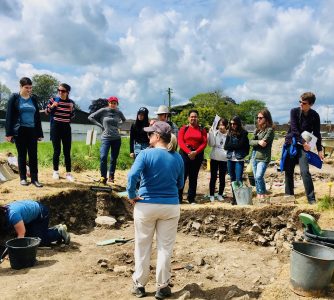
I’ve noticed that the COVID-19 pandemic sparked a growing interest in plagues and illnesses of the past, with people looking to history for advice on the present. Professor Alison More, a founding instructor of the Boyle Seminar, mentioned the revitalization of St. Corona in her own InsightOut post. She comments on how the saint, having had no previous association with plagues or illness, was now being called to intercede against a virus sharing her name. As More further elaborates with examples of St. Roche, St. Sebastian, and St. Rosalia of Palermo, the faithful repeatedly turn to saints for divine protection and guidance throughout the centuries.
Notably, for better or for worse, the prejudices, fears, and worries of the current pandemic are similar to those we have seen in the past. However, while we look to history for guidance, it’s crucial to incorporate the knowledge of the present. A course called Plagues and Peoples, which analyzed factors influencing the spread and survival of plague narratives, helped me hone the ability not only to read between the lines of a text, but out of them as well.
Essentially, the context surrounding narratives and what could have intentionally been left out reveal just as much information as what is present on the page. Ellen J. Amster has a great article detailing the persistence of prejudices and structural racism that are seemingly missing in these narratives, blinding subsequent generations to these darker aspects of history. Here, we note how the past is all but static and has the potential to be rewritten, though only as determined by those who hold the pen. Just as we have the ability to overlook these aspects, we also have the opportunity to learn from the past and change things for the better.
Perhaps the Mediaeval Studies Undergraduate Society (MSUS) has the pandemic and re-runs of Game of Thrones to thank for our numerous new members. In addition to students studying the Classics, History, and Christianity and Culture, we also have members in fields not commonly regarded as “mediaeval,” including Astrophysics, Human Biology, Ecology and Evolutionary Biology, as well as Cognitive Science. With little to no prior mediaeval studies experience, these students have taken an interest in something particular about the subject–be it language, myth, recipes, film, or music.
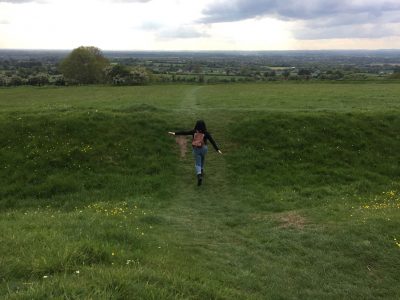
Mediaeval studies is special in that everyone can settle into their own respective niche. Gabrielle Camaoay, MSUS’ first-year representative and a fellow alumna of the Boyle Seminar, describes this rare ability, stating, “What drew me to mediaeval studies was the fact that it was so versatile, with so many subjects of study to choose from and being able to mix and match topics to your heart’s content.”
The subject of mediaeval studies is often misunderstood. I myself often have difficulty defining it. The university generalizes it as the study of the period between “roughly the fifth through the fifteenth centuries,” yet acknowledges that its “parameters are broad and boundaries are not clearly defined.” And perhaps this ambiguity is a benefit; the period is so varied and resilient that everyone can find common ground somewhere.
We become engrossed by the mediaeval world because we can see parts of ourselves in it, and we study it with the end goal of bridging the gap between the centuries by determining exactly how the past has helped shape the present.
So is it so wrong to live in the past? To be enamoured with what once was? I’d like to think not. There’s still so much left to learn, and with emerging technologies becoming more readily available, the possibilities for new discoveries are endless.
The past is alive. History is alive. It’s dynamic, eye-opening, and rapidly expanding. The Middle Ages are revived with each set of eyes laid on the folio of a manuscript, and every time a mediaeval fable is retold. Likewise, we can feel the mediaeval world within the classrooms of the University of St. Michael’s College, witnessing how it is renewed by the chronically curious students who breathe life into it.
Works Referenced
Radini, A, M Tromp, A Beach, E Tong, C Speller, M McCormick, J V Dudgeon, et al. 2019. “Medieval Women’s Early Involvement in Manuscript Production Suggested by Lapis Lazuli Identification in Dental Calculus.” Science Advances 5 (1): eaau7126–eaau7126. https://doi.org/10.1126/sciadv.aau7126
Read other InsightOut posts.
From finding community on campus or earning top marks in challenging courses—even to becoming a mother just days before Convocation—members of St. Michael’s Class of 2021 have had a rich and unique set of experiences.
This year’s St. Michael’s class is large by University of Toronto standards. 817 students will receive degrees during a virtual convocation ceremony at noon EDT on June 23, and at 10:30 a.m. that day, members of the class will also be presented with a variety of College awards recognizing academic achievement and community involvement.
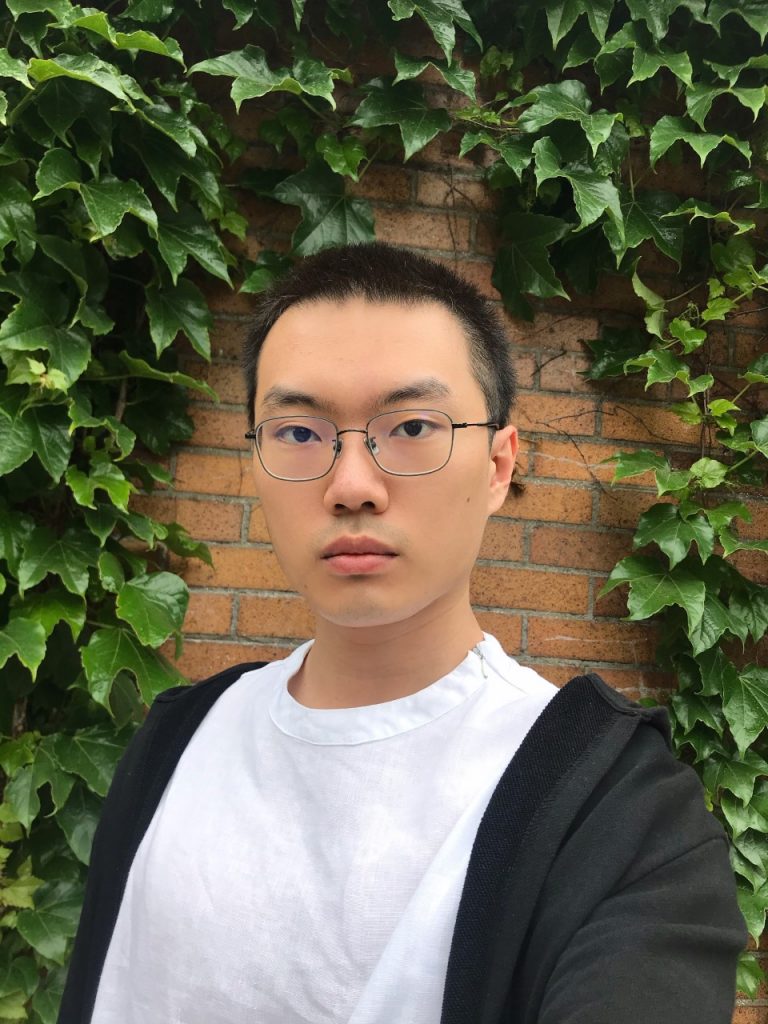
“St. Mike’s is known as the Catholic college, and features humanities and theological studies,” graduand Ruikai Wu says. His outstanding marks earned him this year’s College Gold Medal for science, which is the degree designation of the largest share of this year’s graduating class, and he is also one of two graduands to be nominated for the U of T Governor General’s Silver Medal. Wu’s goals for his university studies were to learn science and critical thinking, and he chose St. Michael’s as his college in order to gain exposure to non-scientific fields. “To understand the science better, you need to understand how people think and behave,” he says.
While his performance in Life Science courses related to microbiology and molecular biology helped him earn his award, one of Wu’s most meaningful course experiences was English 100-Effective Writing. “No matter what you do or study, you need to write clearly, to avoid abstract words and tense confusion,” he says.
Wu found a home at St. Mike’s after meeting other entrance scholarship recipients at a lunch that also included St. Michael’s staff members. “It felt nice because U of T is such a large place, and St. Mike’s is smaller but still a big place,” he says. Meeting fellow students helped give Wu a “feeling of community and a sense that there were people to talk to.” He also credits Assistant Registrar Nawang Khangkar with helping him feel welcome and cared about at St. Mike’s. “My experience at St. Mike’s would be very different” if not for her help, he says.

Fellow Life Sciences student Omar Elbardisy came to feel at home at St. Mike’s as a commuter student after attending Orientation Week events his first year. The College Silver Medal winner is the other U of T Governor General’s Silver Medal nominee for St. Mike’s, and like Wu, carried a 4.0 CGPA through his studies.
He also found great value in taking non-science courses. “I am from an Egyptian background; I was born there and lived there for a while before immigrating,” he says. “Being at U of T in a completely foreign country and seeing courses that address my home country really impacted me.” One of the most meaningful he took was Voices from Ancient Egypt, which he found “more literature and essay based” than his other classes in a way that he found “mutually enriching.
“I had to think about the material in a different way, and I studied differently… taking an interdisciplinary course makes you go beyond the readings, do your own research, and really helped me a lot,” he says.
Foundational to Elbardisy’s success in both scientific and humanities courses was the goal of truly understanding content instead of relying on rote memorization. He also sought balance through involvement in extracurricular activities at St. Michael’s such as intramural soccer, Orientation leadership, and connections with his commuter dons, all of which helped him feel at home at the College.
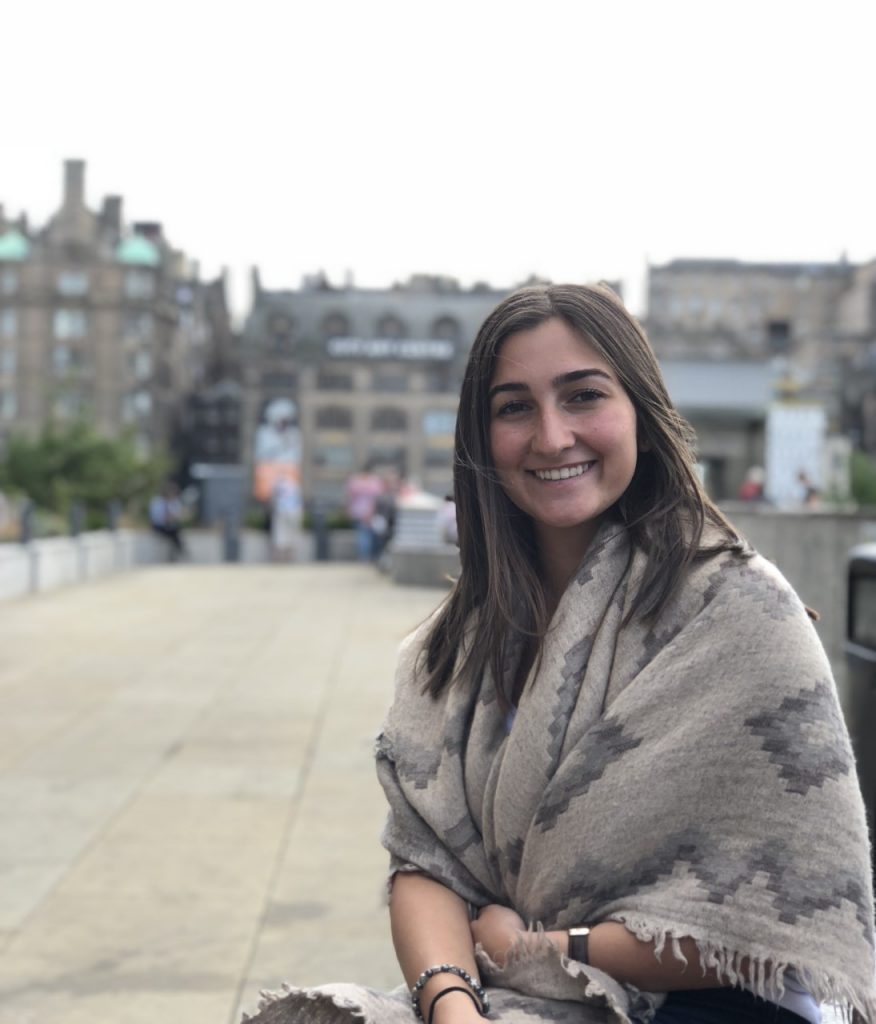
Community involvement and academic achievement in Italian Studies together qualified Chiara Muia to receive an Alberto and Caroline Morgan Di Giovanni Centro Scuola Scholarship. “During Orientation Week of my first year I was overwhelmed by how welcoming everyone at St. Mike’s was,” she says. She kept in touch with her leaders all four years, and forged friendships that have lasted through her student career.
Muia also found surprising upsides to working on her classes remotely. “Though I missed being on campus, I found that being online actually allowed me to talk to my professors much more,” she says. The ease with which she could reach out for a quick video chat “allowed me to get a lot more out of my classes than I generally would have.”
Muia took one of her most meaningful classes in her last semester. JCI350: Italian Canadian Culture and Identity “allowed me to better understand the history of my family and connect with them in a way I never have before,” Muia says.
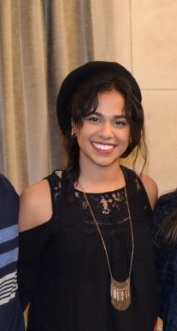
Fellow graduand Samantha Ramphal found her studies and extracurricular involvement at St. Mike’s to help integrate many parts of her life. A transformative experience in the Gilson Seminar on Faith and Ideas her first year led the Environment and Health major to pick up Christianity and Culture as a minor. She will be receiving the Mercier-Knowlton Prize for Philosophy in Christianity and Culture and the Marina Santin Award at the USMC graduation awards ceremony on Wednesday.
“I enjoyed the experience of being in such a small and intimate classroom and having the chance to deepen my faith,” Ramphal says. Her experiences in the classroom led as well to a variety of extracurricular involvement including presenting a paper at St. Michael’s student research colloquium in 2017, volunteering as a student representative on the St. Michael’s Collegium, and serving as a student leader in the Christianity and Culture club.
The awards being given recognize the achievements of these and many other talented students, but they also point to bright futures after graduation. Wu will be entering a PhD program in the University of Toronto Department of Biochemistry, while Elbardisy will be starting medical school this fall, also at U of T. Muia’s next stop is a three-year Master of Architecture program at the Azrieli School of Architecture and Urbanism at Carleton University.
But Ramphal has perhaps the most unique next step of all. She welcomed her son Raphael into the world on the afternoon of Sunday, June 6—only weeks before convocation. Is he a future St. Michael’s student? We can only hope.
The University of St. Michael’s College Graduation Awards Ceremony will take place at 10:30 a.m. EDT on Wednesday, June 23.
Nicolas Vergara Ruiz is a fourth-year undergraduate student majoring in Cell and Molecular Biology and minoring in Immunology and Creative Expression in Society. Originally from Lima, Peru, Vergara Ruiz spent parts of his childhood abroad in Bogota, Washington D.C., and Brussels. He values the close-knit community of St. Mike’s, and has served as an international community director of SMCSU, mentorship program coordinator, and commuter don this past year.
Basil’s Grand Tour
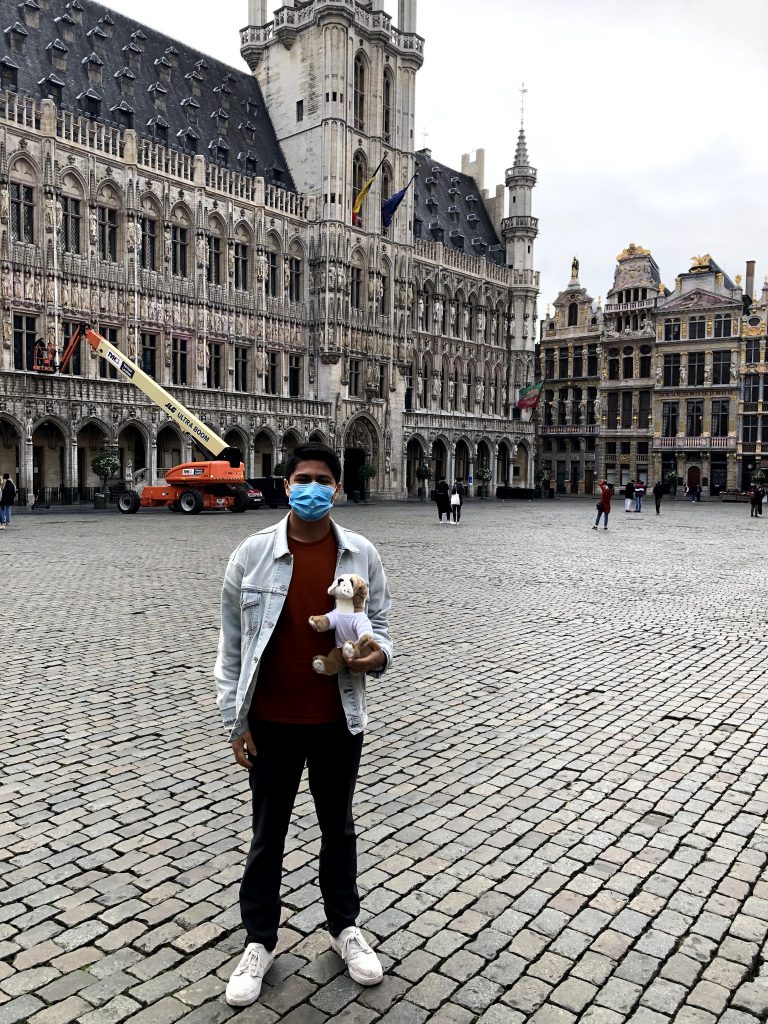
“Home is St. Mike’s.”
More than simply being the chosen message displayed on the 2017 orientation week t-shirts, this phrase envelops the countless backstories and identities of students, staff, and alumni into a shared sense of belonging in our beloved college.
To some, this expression might surface thoughts of a sea of blue, red, green, and yellow shirts, along with the familiar words of the Hoikety Choik; to others, a favourite spot within our skyscraper-surrounded safe haven in downtown Toronto. It would be a stretch, however, for most to fit this phrase into the virtual reality that we have all been subject to during the past academic year.
In this strange setting, the University of Toronto community grappled with the notion of togetherness. There was no welcome desk waiting for the tired smiles of international students arriving for the first time at Pearson Airport, graduating seniors reached their last lecture through a Zoom link, and interactions of all kinds were reduced to rectangular boxes at the mercy of lag.
Certainly, it was, and still remains for the time being, a necessary sacrifice to keep our loved ones safe and protect courageous front-line workers all around. But for a global community where over one in five students are international, it represented a challenge which tested the strength of U of T’s very saying: boundlessness.
This past year, I served the St. Mike’s community from abroad, tasked with supporting first-year and international students, arguably two of the student groups who this year would find it hardest to connect with our college. And so: how to bring St. Mike’s just a little closer in a time when distances seem especially large?
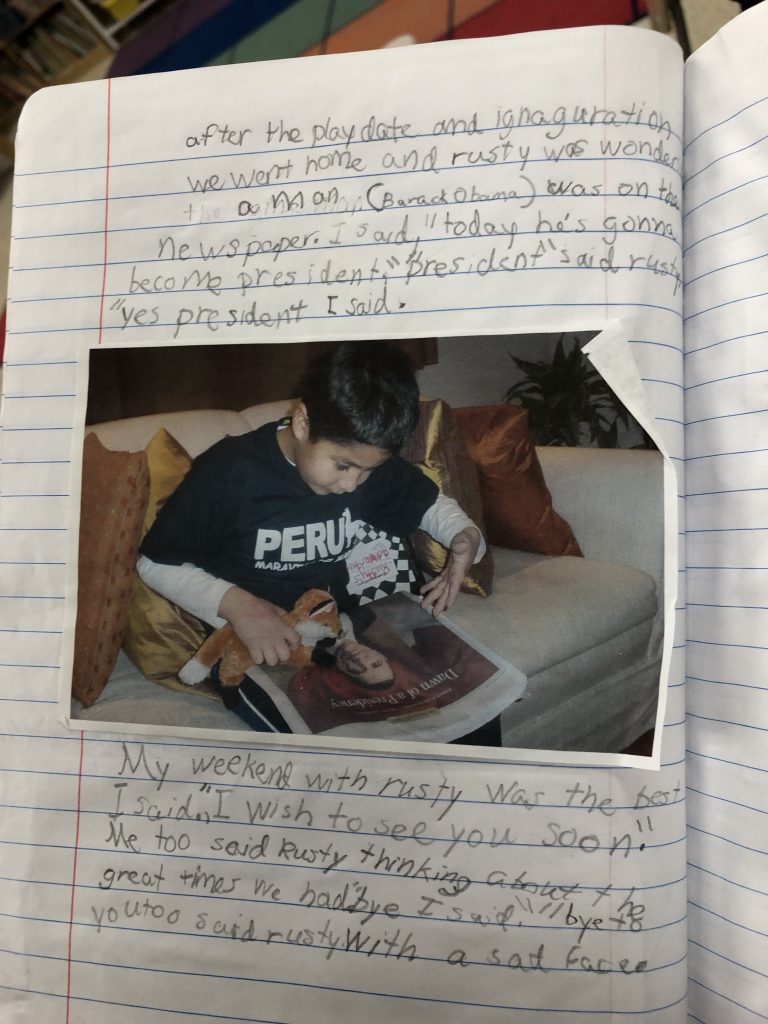
I found the answer in hazy but certainly heartwarming memories of my passing through Ms. Fox’s second grade class, in Ashburton Elementary School. “Foxtown,” as we called it, was fortunate enough to have a pet fox, Rusty, who would transcend his plush nature in the eyes of 8-year-olds and become our companion for a weekend during the school year.
We kept track of Rusty’s adventures in a notebook, which turned a mandatory writing exercise into a privilege—bragging rights for some—to be presented at the beginning of the following week.
In 2019, I returned to Foxtown on a reading week trip to Washington D.C., a decade’s worth of time now separating second grade from my first year of university. Sure enough, I found a smiling (and surprised) Ms. Fox, my old pal Rusty, and what had been my crooked handwriting from the time.
Of course, what evolved as Basil’s World Tour, a trip involving a mini version of our school mascot Basil the Bulldog, would take on an entirely different scope than its elementary school counterpart. For starters, a plush toy tends to hold different meaning for university students than it does for a second-grade class, which made the project less about the material object and more on what its travels represented for those taking part. Moreover, we would be relying on postal systems worldwide to transport our college’s mascot, not all of which could be considered reliable. And with all things considered, there was one question which preceded all in importance: would enough members of our community welcome the idea of touring a plush Basil around the world and, if so, would their geographical location be fitting to provide an itinerary worthy enough for us to maintain our project name?
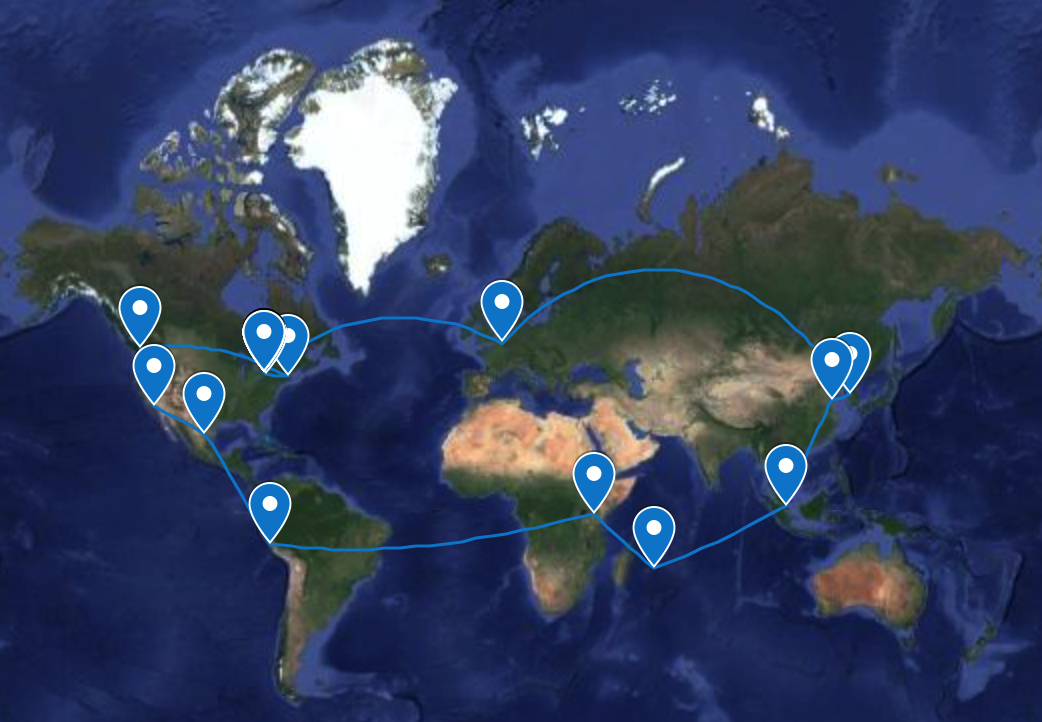
The support was overwhelming: within a matter of weeks, we had a 22-stop, 54,152-km trip across all continents save for Antarctica. Beginning his travels on October 15th, 2020, Basil first visited fellow commuter dons Athalia, Natalie, Anthony, Shayndel, and Andrew, enjoying the Royal Ontario Museum, the Toronto Zoo, and an impromptu fishing trip before crossing international boundaries for the first time, to Belgium.
There, he was welcomed into the Vergara Ruiz household with open arms in a time which was already proving to be a handful—an intercontinental move back to Peru. Aside from witnessing the gradual packing of our belongings into boxes, I was still able to take Basil to neighbouring countries Germany and the Netherlands, as well as get a picture with him in the Grand Place, considered by many to be the very heart of Europe.
After an all too brief visit, Basil reached Incheon, South Korea, where Eunha and he were able to enjoy a walk at sunrise. Then, it was learning how to play the guitar with Yihang in Qingdao, China. And enjoying a swim in Singapore with Meghna.
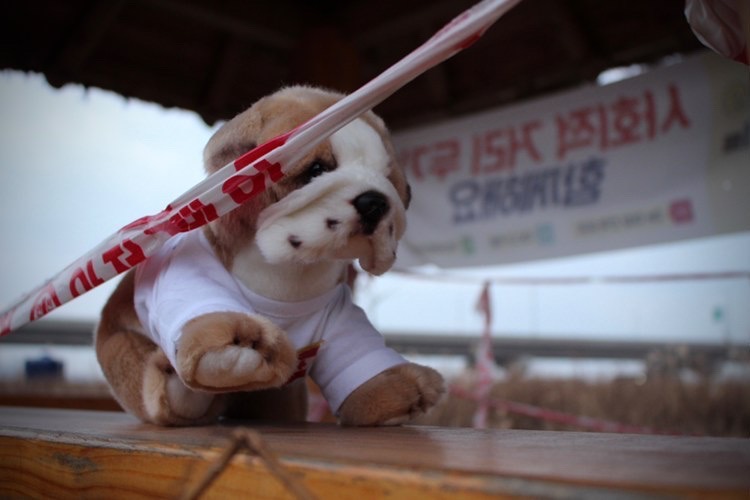
The start of the winter semester, however, brought with it some tough news for our project. While Basil had reached Port Louis, Mauritius, there had been some problems with customs. As weeks with no news passed, we came to realize that our original route through Africa, visiting Samuel and Andrea, would unfortunately have to be postponed until more news on Basil’s status would surface. To this day, none came.
While disconcerting, a thorough mitigation of risks prior to the start of the tour meant we had an ace up our sleeve: the power of production en masse. In a matter of days, a second Basil joined Antonio for a gastronomic tour of Lima, Peru, and the journey through the Americas would continue.
As the 2020–2021 academic year drew to a close, Basil had gone on a hike in Monterrey, Mexico with Rebeca, toured Los Angeles, California with Ella, visited the Sleepy Hollow cemetery with Morgan in Concord, Massachusetts, and walked alongside Kiera by Lake Erie, near Buffalo, in upstate New York.
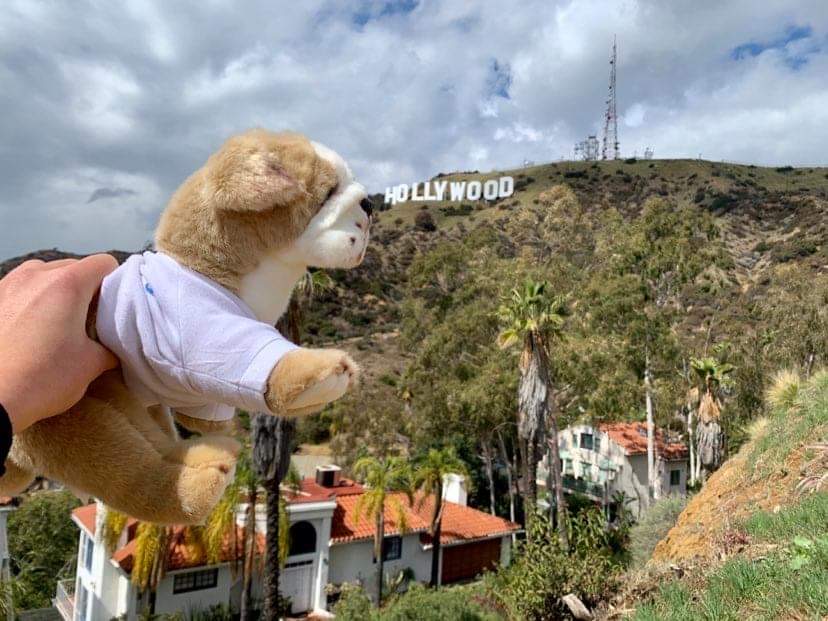
At last, Basil returned to Canada, first with a short visit to Jennifer in Vancouver, British Columbia just in time to see Cherry Blossoms in full bloom before returning to Ontario. In the Greater Toronto Area, Basil was present for Nicholas’s final moments as an undergrad, caught up on video games with Sam, and practiced yoga with Ace. Currently, Basil is wrapping up his time with Elva before making his way to campus for one last adventure with Arjun, the final stop of the trip.
It has been a little over seven months since Basil first left campus. Despite the distance from downtown Toronto, I would argue that Basil was never far from home. St. Mike’s is very much Brennan Hall, the angel statue on the Quad, and the corner of Bay and St. Joseph; but in a year where the vibrancy of our community was heard through built-in computer microphones, we’re reminded that the Spirit of St. Mike’s cannot be contained to physical coordinates on a map. This year, our college didn’t have one single address, but many. In lieu of recognizable landmarks of campus, there were smiles, textbooks, and study breaks, proving that, while taking the strange circumstances of this past year into account, we are still able to return to a familiar phrase, perhaps with a slight twist: “St. Mike’s is Home.”
Read other InsightOut posts.
In spite of having lived in the Greater Toronto Area her entire life, St. Mike’s alumna Fiona Li told a panel audience Monday afternoon that anti-Asian sentiments sometimes makes her feel “like I don’t belong here.”
Li joined St. Mike’s undergrads Maya Martin-Spisak and Warren Liu for an online discussion on anti-Asian racism, moderated by student union president Cianna Choo.
“There’s a notion that we are perpetually a foreigner,” says Li, who is a graduate of St. Michael’s Christianity and Culture program, as well as holding two degrees from the Faculty of Theology. “No matter how Canadian I am, I am seen as a foreigner. It feels like I don’t belong here.”
She cited preconceptions on everything from what Asian students study through to stereotypes of Asian women as ultimately harmful to mental health.
“You doubt yourself. You ask yourself ‘Am I worthy?’” she said.
Liu noted that, while he lived in China for 10 years, he was born in Canada and has spent much of his life here, but sometimes people’s approach to him makes him think of “imposter syndrome. You feel like you’re not really Canadian.”
Martin-Spisak added that, over time, she was learned to push back at common micro-aggressions.
Born in China and adopted by a family in California, she lived in a community where she was the only Asian person in the neighbourhood.
“I didn’t see people like me. I ate the same peanut butter and jelly sandwiches as everyone else but when I would say I was American people would say, ‘But where are you really from?’”
She continued by saying she felt guilt because of choosing humanities over STEM courses, worried how people would respond. She then stressed there are dangers in society creating what she called “monolithic assumptions about Asians,” a reality that Li also addressed.
“It’s not helpful, because there are so many different ways of being Asian—or Canadian,” Li said. “To generalize is to do people an injustice because our experiences are particular. I speak Cantonese. I don’t speak Mandarin. To ignore details like that is to disregard people.”
Liu agreed, noting that sometimes people simply do not recognize the impact a casual comment can have.
“When people say, ‘You’re good at (a subject) because you’re Asian!’ you have a weird feeling of having your hard work boiled down to a stereotype,” he said.
Martin-Spisak agreed, noting, for example, that when people talk in stereotypes about wealth, it negates the experience of Asian people living in countries where opportunities are limited.
“It erases that difference and that struggle,” she said.
Any kind of assumption is dangerous, she added.
“People have notions of Asian women as quiet and submissive; I’m not!” she said. “To think of Asian women as submissive of ‘exotic’ creates a toxic train of thought.”
Liu mentioned the impact the pandemic has had on how Asian people are treated.
“The coronavirus was discovered in Wuhan and that had a negative effect on Asian people,” he said, noting that while what he labelled “soft racism” has long existed, “this has exposed a propensity to commit violence. We are seeing a more raw form of racism.”
Martin-Spisak told the panel that when COVID-19 first took hold, she would notice people move away from her in stores, a reaction Choo said she had also experienced.
While acknowledging the struggles and the challenges, panelist also offered ideas on how the broader community can help.
“The soul of Canada is a place where people of all races can come together and make miracles happen,” Liu said optimistically, suggesting kindly that people begin by exposing themselves to news things, including food.
“How can you hate someone when you try their food and find it delicious? Have an openness,” he said.
All panelists agreed that broadening exposure is key, that Asian people are more than kung fu, K-pop and anime.
The classroom is a key space in acknowledging and addressing racism, Martin-Spisak said, noting her appreciation for professors who acknowledge the trauma world events can cause and encourage students to care for their mental health.
As a Chinese woman studying theology, Li said her classes often feature the works of white men.
“How about trying an Asian scholar?” she said.
She also encouraged students to call out racism when they hear it.
“It helps to recognize that someone is on our side.”
Choo, as moderator, agreed on both points, saying that seeing Asian role models encourages students to see themselves in new ways, and that the support of friends and classmates sends a message of care. She also emphasized how important it is to provide opportunities for students to learn about each other’s cultures.
There are ongoing challenges to be faced, Liu stressed.
“Are the jokes okay? Are they productive?”
Dean of Students Duane Rendle closed the event by noting that anti-Asian violence is an issue that has been “below the radar” and he thanked students for their participation.
“We want to ensure that all students—including our international students—are welcome.”
Maya Martin-Spisak is a third-year student majoring in History, with a focus in Law and History, and double minoring in Linguistics and Book and Media Studies. She is from San Diego, California but has also lived in other parts of the U.S., the Philippines, Belgium and Taiwan. At St. Mike’s, she has served in various roles in the Mentorship Program, Orientation, Residence Council, and House Councils. She is currently serving as the Mentorship Program Coordinator and Residence Council President.
My Experience as an Asian-American Woman

Firstly, I want to acknowledge that the following article is about my personal experience and is not meant to represent anyone else’s.
I was originally going to write about my 58 days in self-isolation quarantine. However, due to the recent events in Atlanta and the steep rise in Asian hate crimes, I thought it was more suitable to write about my experience as an Asian-American woman, though I’m not sure what to write. There’s so much to unpack and I don’t know where to start without feeling overwhelmed. How am I supposed to react when people who look like me are the targets of assault and hate crimes? How are we supposed to speak with our communities in a way that is productive for everyone, including people who refuse to acknowledge the hardships of minority communities? There isn’t one way or easy answer to any of this. I’m still mulling over these questions and processing all the events that have happened in the past year. But I’ll tell you what I’ve come up with so far:
The murder of Sarah Everard was gut-wrenching. She took every safety precaution she could on her walk home. Everard’s case highlighted the violence and harassment women face. And not even two weeks later, we wake up to hear about the terrible events in Atlanta. It gave me a wave of emotions. I was devastated to hear about more violence against women and yet another mass shooting in my home country. It broke my heart that someone had deliberately targeted the spas and killed Xiaojie Tan, Daoyou Feng, Hyun Jung Grant, Suncha Kim, Soon Chung Park, Yong Ae Yue, Delaina Ashley Yaun Gonzalez and Paul Andre Michels. I felt infuriated when Captain Jay Baker defended the killer, saying that he was having a “bad day.” And I was scared by the thought that I or someone I knew could be a victim of another attack. But through all that, I was and still am thankful for my friends and family who reached out to offer their support.
Later that day, I tried going on a walk to recenter myself but after reading about the significant rise in Asian hate crimes in Canada, I found myself on edge and looking over my shoulder the entire time. As a woman, I’m always careful of where I go. However, due to recent events, I have felt like I needed to be even more cautionary because I am an Asian woman and I felt like those two factors made me a very vulnerable target. It was similar to a feeling I had almost a year ago at the start of the pandemic: people who looked like me did not belong here. Rewind to this time last year: It was after one of former U.S. President Donald Trump’s press conferences where he had blamed China for the spread of COVID-19 and referred to it as the “China virus.” I had gone to a store to pick up some moving supplies where I seemed to be one of two East Asian people there. The other customers in the store made a point to avoid the two of us at all cost as if we were the only two people who could carry and spread COVID-19. The customers didn’t care about how close they stood to each other as long as the other East Asian person and I weren’t near them. In both cases, I was scared of the people who were scared of me because of their prejudice against Asians.
This prejudice is not new; it has been around for a long time. In Canadian history, many policies have codified Asian prejudice into law. The Chinese Immigration Act of 1885 made it so that the Chinese were the only ethnic group required to pay taxes to enter the country, and through the Chinese Immigration Act of 1923 the government banned Chinese immigration with little exceptions. An indirect result of these acts was the model minority myth, along with micro-aggressions, stereotypes, slurs, and fetishization—all of which are still present today and things I have experienced.
It’s taken a lot of effort to work through my identity. I am a Chinese adoptee raised in an American family. I don’t speak Mandarin, celebrate a majority of Chinese holidays, or have Chinese family members. When I was younger, I didn’t feel part of the Asian community. But even then, I had internalized and normalized a lot of the micro-aggressions, stereotypes, and model minority myths used against the Asian community. The “(you are not American, you are a foreigner) where are you really from?” and the “You’re good at that because you’re Asian.” I found myself discrediting my achievements and hard work by attributing them to my ethnicity instead. There was a point where I wished I had paler skin and Eurocentric features because of the media around me. I grew up in a household that pushed me to study what I wanted, but I still felt ashamed when I decided to major in the humanities over STEM because of the Asian STEM stereotype. And yes, being polite and successful are great traits to strive for but the model minority myth takes those characteristics and erases the rich diversity of Asian–North American backgrounds by creating a monolithic monster full of misconceptions. It took me years of work to break down those internal stereotypes, prejudices, and myths that had been part of my foundations from an early age. And I know I’m not done. Erasing those preconceived notions and internalized racism will be something I have to work on for the rest of my life.
In relation to recent events, I am grateful that people have taken to their media platforms to educate themselves on facts and misconceptions about Asian communities. But it’s not enough. It takes a lot of time to read, question yourself, and feel uncomfortable to undo the prejudices that are rooted deep within ourselves. And it’s important to listen to the stories and experiences people give, they can provide a perspective you might have not thought of.
Overall, my experience as an Asian-American woman has been difficult at times but I wouldn’t change it. I’ve grown a lot and become more confident in my own skin and great heritage. I hope other people find ways to do the same.
Read other InsightOut posts.
Oghogho Abigail Iyekekpolor is in her 3rd year double majoring in Neuroscience and Psychology and minoring in Practical French. In her time at St Mike’s, she has served as an Orientation Leader and the Student Life Programming Assistant. Last year, she launched the #SOULSofSMC social media campaign. She is currently serving as a residence don.
Black History IS History
When I first started writing this InsightOut, I honestly felt a bit apprehensive. While I’m grateful for the opportunity to share my thoughts, I can’t deny the nervousness that comes with it. Talking about Black History Month is like opening Pandora’s box: it calls to mind slavery, the Civil Rights Movement, #BlackLivesMatter Movement, police brutality, systemic racism, generational trauma. It’s a dense topic and almost impossible to talk about everything without getting sidetracked by feelings of anger and exasperation. It’s quite daunting, and although part of me doesn’t want to exclude anything, what I want to talk about most is what Black History Month represents to me, especially based on the things I’ve learned in the past 12 months.

Originally, Black History Month was “Negro History Week,” introduced by African American scholar Dr. Carter G. Woodson in February 1929. The aim was to raise awareness of the experiences of Black people in America and around the world while celebrating their great achievements. Woodson set the week in February to incorporate the birthdays of Abraham Lincoln and Frederick Douglass, two Americans who played an instrumental role in shaping Black history in the United States. The celebration gained strong momentum in the years to follow and by the 1970s Negro History Week became Black History Month. In Canada, the House of Commons officially recognized February as Black History Month in December 1995, following a motion by Dr. Jean Augustine, the first Black Canadian woman elected to Parliament.
Since then, Black History Month for many of us growing up in North America has been about celebrating figures of the past. We learn about the wise words of Martin Luther King Jr. in his “I Have a Dream” speech, the brave actions of Rosa Parks, the fortitude of Malcolm X, groups like the Black Panthers and so on. These are a few among many strong people who fought the great battle against racism, and “we as a people are soooo much better for it now!” As a young Black girl who’d had her skin called poop and her foreign name mocked countless times I was more than willing to accept this narrative. A whole month to celebrate people who looked like me—what could be better? I practically worshipped people like Harriet Tubman and Maya Angelou when I was in elementary school.
And then I saw a story about Trayvon Martin on the news when I was 12 years old. I always feel a pang in my chest when I think about this because it was the first time I truly felt afraid to be Black. Then came Eric Garner. Tamir Rice. Sandra Bland. Andrew Loku. Alton Sterling. Philando Castile. Elijah McClain. Ahmaud Arbery. D’Andre Campbell. Breonna Taylor. George Floyd. Regis Korchinski-Paquet.
Evidently, that great battle against racism is not over.
This isn’t an attempt to discount the invaluable contributions of the larger-than-life individuals we usually celebrate during Black History Month, those who have galvanized movements and brought about invaluable change. But it is a call-out and a reflection. Black History Month isn’t only about the greats of history or people of the past. It’s also about ordinary people who have been and continue to be brutalized without any regard for their human dignity, just because of the colour of their skin. It’s about how #BlackLivesMatter is treated as a political statement rather than a simple affirmation. And, very importantly, it’s about knowledge and empowerment.
I’m currently taking the course SMC300, a special topic under Book and Media Studies taught by Emilie Nicolas on #BlackLivesMatter in the Media. Previously, we discussed the experience of learning about Black history in Canada and how sub-par our education on the subject has been. An overarching theme for some of our discussions has been the idea of erasure. Black people in Canada are often regarded as new, even though the first Black person in this country, Mathieu de Coste, arrived in 1608, not to mention the enslavement of black people in Canada during the 17th and 18th centuries. We almost never learn about this, only hearing stories of the underground railroad that led enslaved people from America to “freedom” in Canada.
Apart from historical events like these, Black people have been cheated of the acknowledgement they deserve in many other areas of pop culture and society: fashion, music, dance, language, science—the brilliant Black individuals who contribute to these areas are often overlooked while their accomplishments are lauded when embraced by white people.
What I’m trying to say is that I believe we celebrate Black History Month today for the same reasons Dr. Woodson established Negro History Week more than 90 years ago. Members of the Black community are still not being recognized for their achievements and are still being treated inequitably. We may not be facing the exact same racism that Woodson endured in his time but we must combat our own reimagined version of it to move forward; the fight is ongoing. It’s a daunting idea, but the past year has shown all of us what it feels like to live through major historical events and has shown us our ability to partake in that history and to choose what side of it we want to be on.
The past year has also shown us that these efforts can happen outside of February. Just look at last summer: with a pandemic raging throughout the world, people were forced to sit and reckon with the obvious displays of systemic anti-blackness around them. Discussions about it were unavoidable.
Consequently, if you ask me, Black History Month serves as a reminder that even in a society where the cultural and social impacts of Black people are felt all around us, our lives and contributions are still so disregarded that we must relegate them to one month. Black History is everywhere: it’s the new dance trend that you see on TikTok, it’s the traffic lights that guide you smoothly home during your daily commute. The reality is that Black history IS history, period. Until the time when we can fully recognize that and embrace the complex and beautiful humanity of Black people every day of the year, we will continue to use the month of February to mourn our losses, celebrate our heroes, and mobilize for greater change.
Read other InsightOut posts.
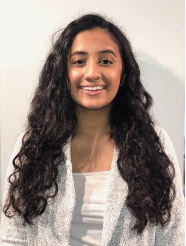
St. Michael’s College student Nicole Machado (BSc’21) has been named a finalist for the inaugural McCall MacBain Scholarships, Canada’s first comprehensive leadership-based scholarship for master’s and professional studies.
The scholarship enables students to pursue a fully funded master’s or professional degree at McGill University while connecting with mentors and participating in an intensive leadership development program.
Nicole will join 49 Canadian peers, including two other University of Toronto students, at virtual final interviews from March 11 to 13, 2021. She will participate in interviews with Canadian leaders from academia, business, government, and the social sector.
“We are thrilled to hear Nicole’s news and we cheer her on as she moves forward in the McCall MacBain Scholarship process,” says Dr. David Sylvester, President of the University of St. Michael’s College. “Nicole’s academic and volunteer experiences have all been directed toward the greater good. She is a great model of how St. Michael’s students understand that education isn’t only about books and exams but primarily about recognizing—and celebrating—the dignity and value of all.”
Over 735 people applied for the McCall MacBain Scholarships, and 132 participated in regional interviews with local leaders in November before the 50 finalists were selected. Up to 20 McCall MacBain Scholars will be chosen after final interviews.
Finalists were chosen based on their character, community engagement, leadership potential, entrepreneurial spirit, academic strength, and intellectual curiosity.
Nicole volunteered at a local hospital for five years, more recently as a weekly visitor to support elderly patients, and helped prepare meals at a women’s shelter. On campus, she mentored first-year students and organized social activities for students in drama clubs.
Nicole is set to earn her BSc in Pharmacology this year. She worked at an oncology lab and, as part of the Professional Experience Year program, conducted research on drug delivery and medical devices at the Massachusetts Institute of Technology. She is applying for master’s programs in biological and biomedical engineering and in experimental medicine.
“There is no typical McCall MacBain Scholar,” said Natasha Sawh, Dean of the McCall MacBain Scholarships. “We look for potential in students from all walks of life, with different academic and volunteer interests. What unites them is the inner drive to learn, lead, and make a positive impact in other people’s lives.”
Finalists who are not selected as McCall MacBain Scholars will be eligible for a $10,000 entrance award for their studies at McGill University. The scholarships are the result of the 2019 landmark gift of $200 million (Canadian), the single-largest gift in Canadian history at that time, by John and Marcy McCall MacBain. The McCall MacBain Scholarships will expand internationally over the next decade, with nearly 300 McCall MacBain Scholars selected by 2030.
St. Michael’s alumni workshops help students forge a path to the future
In an academic year like no other, St. Michael’s students have found themselves faced with challenges beyond what any of them expected when they first decided to pursue university studies. Fortunately, they won’t have to go it alone.
A new alumni workshop series will connect current students with members of the St. Michael’s alumni family to give them an opportunity to see new paths into a post-pandemic future. Co-presenters for the workshop series will bring extensive experience in a variety of fields to bear on topics ranging from life after graduation to career opportunities in specific fields.
“Our alumni have such deep and generous hearts, which they demonstrate through their gifts, their volunteer leadership, and their interest in serving as mentors and advisors,” Chief Advancement Officer Kathryn Elton says. “These workshops are a great example of how committed St. Michael’s alumni are to helping current students succeed in a time that has been challenging for everyone.”
The series kicked off Tuesday, Feb. 2 with “Business Success.” Later sessions include “Finding a Job in a Challenging Market” (Feb. 4), “Opportunities in Education” (Feb. 11), “Women in STEM” (Feb. 23), and “Entrepreneurship” (March 2). Each session will be facilitated by student leaders and include both an alumni panel and time for students to pose questions during a Q&A.
Darren Slind (SMC 8T8), co-founder and managing director of Clarify Group and a co-presenter for the Feb. 2 panel, says he valued the opportunity to offer guidance to the current generation of students in the same way he found mentors during a period at St. Mike’s he describes as “formative.” He also wanted to simply encourage St. Michael’s students about their prospects.
“If students can survive and thrive through this pandemic, they will have the confidence to overcome future challenges,” he says. “That’s the silver lining in what has otherwise been a hard and sometimes painful pandemic, especially for those families directly impacted by COVID-19.”
Slind encourages current students thinking about life after graduation to pursue kinds of success that put people first, a quality he feels St. Michael’s does a good job of inculcating in its students. “You quickly realize after arriving at St. Mike’s that you are surrounded by equally or even smarter peers!” he says. He considers developing one’s “emotional intelligence” to be the most important factor for success in the workplace and names fellow alumnus Victor Dodig, CEO of CIBC, as providing an example of the sort of “extraordinary people-centric leadership” St. Michael’s alumni specialize in.
“In a challenging job market, it’s encouraging to see St. Mike’s alumni stepping in to connect with and support current students,” says Maxine Webster, Advancement Officer, Alumni Engagement. “These types of conversations and connections between alumni and current students are one of the things that makes St. Mike’s special.”
All sessions will take place over Zoom. Register online.
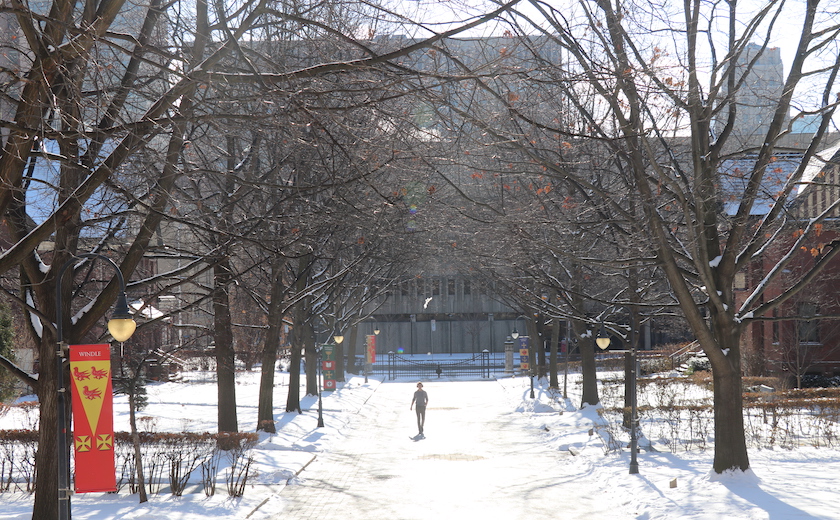
Committed to cultivating a healthy, welcoming, and supportive community, the University of St. Michael’s College works with the University of Toronto to provide a variety of resources to help students in the areas of mental health and wellness. A list of these resources can be found on the Health and Wellness Resources page.
Any student, regardless of where they are in the world, can get immediate assistance through U of T My SSP, a confidential and secure number where counsellors are available to text or speak over the phone. Good2Talk is another helpline resource available 24/7 to post-secondary students in Canada; a text-to-chat version is also available. Other phone services are available for any student who is themselves in distress or who knows someone who is.
Because of how many resources and support services are available at U of T, it can take a bit of guidance to navigate them all. The University’s mental health services site, U of T Student Life’s Health & Wellness Centre, and NAVI, a new mental health wayfinder, each helps students find services that fit their unique needs. Several topical resources provide students with targeted help in a variety of circumstances ranging from a desire to quit smoking to finding support for international students or connecting with a spiritual community.
St. Michael’s students also benefit from a variety of support services offered through the College. Wellness Counsellor Nicole LeBlanc welcomes St. Mike’s students and residents to set up a half-hour online appointment with her through email. She draws from psychodynamic, EMDR, person-centred, CBT and solution-focused therapeutic frameworks, and services are offered with complete confidentiality according to the Personal Health Information Act (PHIPA). Learn more about Nicole’s practice.
The Office of the Dean of Students makes peer-to-peer support available through the Mentorship Program, which pairs incoming students with upper-year students who can connect them to academic and wellness-focused resources, and the Commuter Don and Residence Don teams, which connect students in their constituencies to the larger St. Michael’s community. The St. Michael’s College Student Union (SMCSU) has recently voted to elect two new positions for the 2021-22 academic year: a Vice President of Mental Health and Accessibility, and a Vice President of International Community Outreach. SMCSU also provides funding for student-led groups such as St. Mike’s Wellness Council and SMC Inclusive.
The Office of the Registrar and Student Services makes available academic success learning strategists, accessibility advisors, and career educators to every St. Michael’s student. The office’s ask.smc@utoronto.ca email address provides a single point of access to these and other services through the office. For students who need help with writing papers for their classes, the John M. Kelly Library offers one-on-one appointments through the Writing Centre. More focused research assistance is also available.
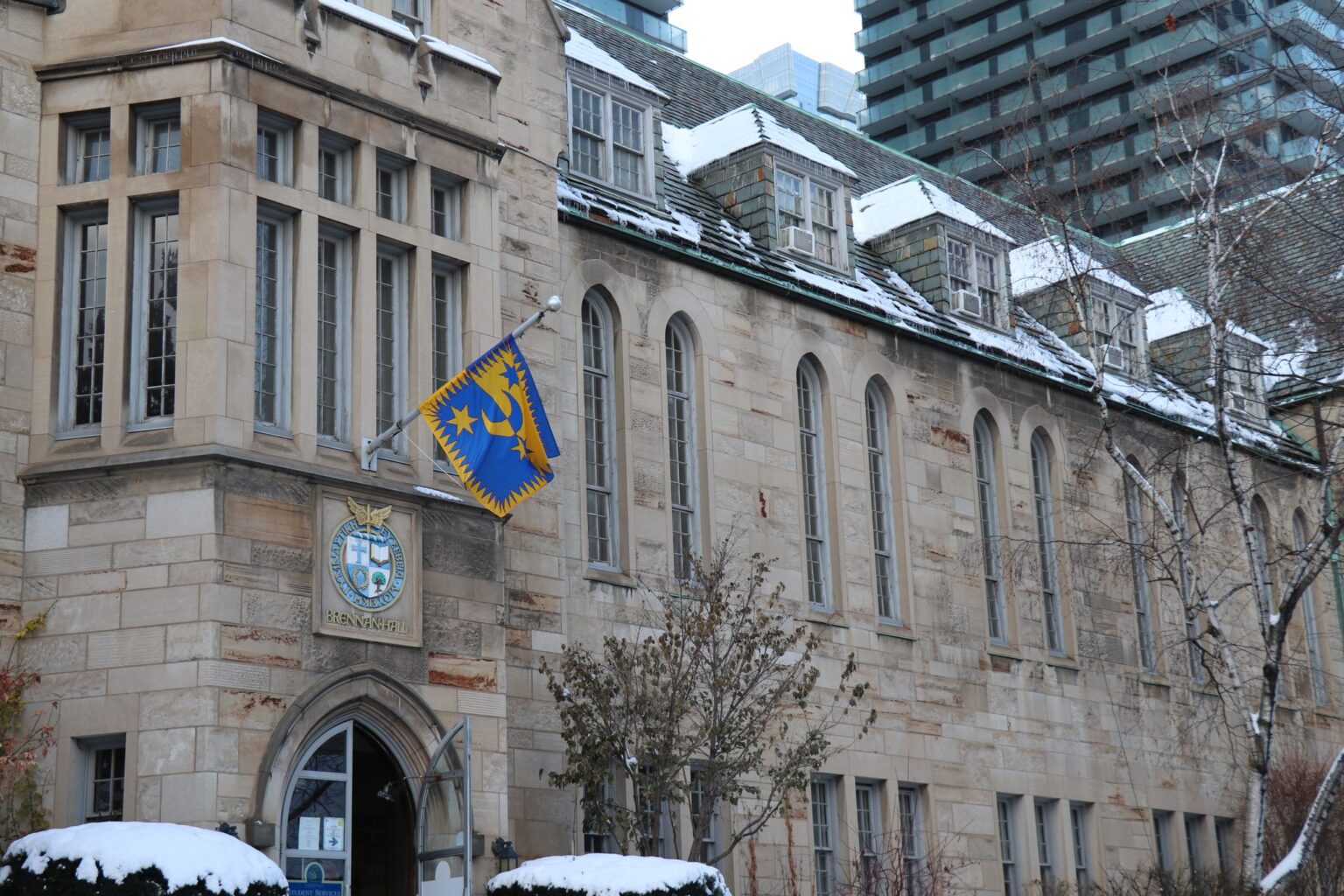
In a shifting academic year, St. Mike’s community and creativity keep students engaged
A strong reputation among students, creative, empathetic responses to the pandemic, and hosting some of the most popular undergraduate classes and programs at the University of Toronto have all helped St. Michael’s weather the challenges posed by COVID-19.
“This is a surprising story,” says Interim Principal Dr. Mark McGowan. “We planned for the worst, hoped for the best and were pleasantly surprised. We were dealt an unusual hand and staff, professors, and students responded admirably to the challenges we have been dealt.”
The result, says McGowan, is that enrolment at St. Michael’s has remained healthy, with increases in enrolment in all college courses. This, he says, is due to a number of factors. One is the ongoing popularity of St. Mike’s Book & Media Studies program, which takes an interdisciplinary approach, offering an historical investigation of the role of printing, books, reading, and electronic and digital media in cultures past and present. The program remains one of the most popular at U of T.
Another decision that has kept enrolment numbers strong was St. Mike’s rapid move to online classes, assuring students — and especially international students — that they could continue their education safely from home. At times, this has driven students to discover new interests, as demonstrated by an increase in the number of international students, for example, in Mediaeval Studies courses.
And if students can’t engage in the international travel that is a key component of programs, St. Mike’s has decided to bring the world to our classrooms. In response to the cancellation of the trips that are a key aspect of the popular first-year One seminars, St. Mike’s is creating what is being called a global classroom, allowing students in Toronto to engage virtually with research and data from around the world. Funded in part by a grant from Universities Canada, the global classroom will have dedicated space on campus, complete with cutting-edge technology, to engage with students, professors, and researchers around the world.
The Boyle Seminar in Scripts and Stories, which offers students an interdisciplinary approach to examining the Celtic influences in the mediaeval world, with particular focus on early books and historical artifacts, will be the first to use the concept, partnering with Maynooth University in Ireland. Students here and in Ireland will engage with their peers, accessing digital resources from both universities. With the plan that student travel will resume once travel bans are lifted, the virtual classroom lends itself to any number of courses and programs, as well as a hybrid model of virtual and in-person classes.
Along with the university’s outstanding faculty members, a roster of strong sessional instructors has drawn students to enrol at St. Mike’s courses. In Book & Media Studies, for example, award-winning journalist Michael Valpy has returned to St. Michael’s to teach media ethics while journalist, scholar and activist Emilie Nicolas is teaching a new #BlackLives and the Media course. In Celtic Studies, meanwhile, Shane Lynn is teaching modern Irish History, a course whose numbers have been growing steadily.
But one of the biggest strengths that allows St. Michael’s to remain vibrant is a strong reputation for a student-driven approach, McGowan says.
“Student word of mouth focusses on things like how well the students are treated at St. Mike’s, or small class sizes,” he says.
This academic year has highlighted the care faculty and staff have for students, he says, noting, for example, how impressed he was when he sat in on a regularly scheduled Zoom session, organized by librarian James Roussain, Dr. Iris Gildea and Dr. Felan Parker, for professors to talk about student issues and how best to offer support.
“It is edifying to listen to compassionate professors focussed on being merciful, especially during COVID,” he says.
Underpinning classes and communication is a strong commitment to IT, the interim principal says. To help ensure smooth delivery of classes, the Principal’s Office offered faculty members funding to upgrade equipment to better serve students online. McGowan also credits St. Mike’s IT Supervisor Pio Sebastiampillai , working with the team at the Faculty of Arts & Science, with enabling professors and students to make the best of online learning.
And while in-person events are still not happening, enhanced student experiences continue to happen. This year, for the example, the annual USMC Research Symposium will still take place, online, on Saturday, March 13, on the topic of “Community, Citizenship, and Belonging.”
St. Mike’s also continues to engage with the important matters of the day. For example, the popular Truth and Reconciliation Commission Reading Group, started by Dr. Reid Locklin in 2019, moved online this year so that the university community can learn how it can better engage in the recommend, holding its meeting recently and welcoming everyone to future sessions when they resume in the next academic year.
“St. Mike’s responded well,” McGowan says. “We didn’t panic but worked as a team.”
John Sampson is a fourth-year PhD Student at the University of St. Michael’s College in the University of Toronto. He is writing on the life and thought of the Chinese theologian T.C. Chao. John can be found at home most days, writing his thesis and drinking only the finest cups of hand-crafted coffee.
In Search of Christian Unity: A Chinese Christian Perspective
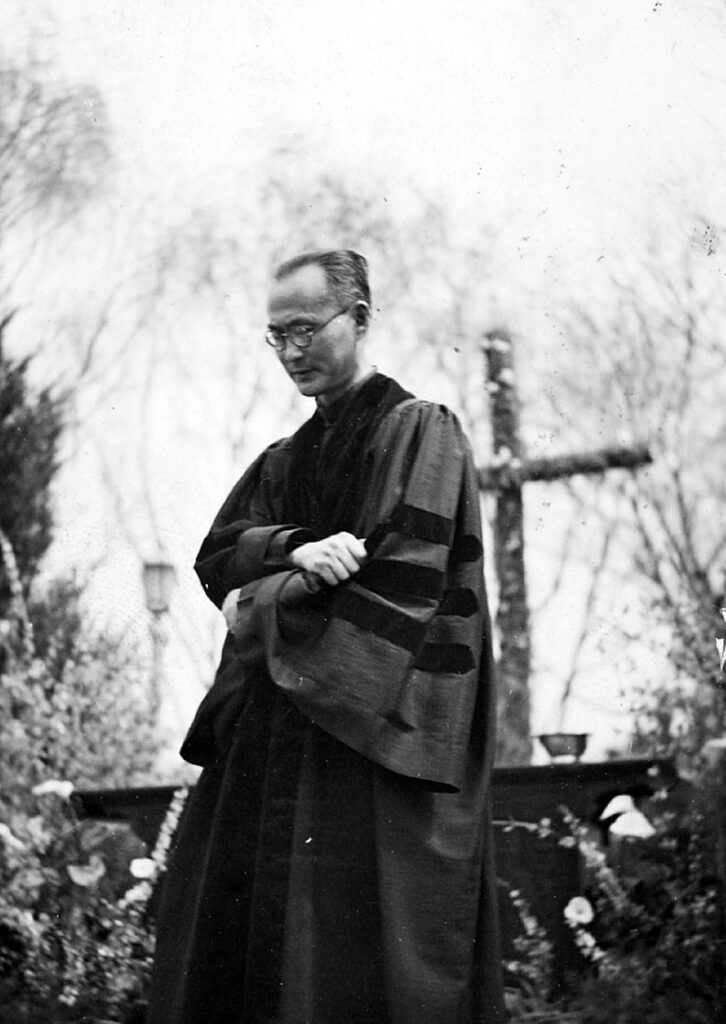
“People must be involved in the work of building up the Church,” wrote T.C. Chao (1888–1979), a famous Chinese Christian theologian and one of the first presidents of the World Council of Churches. “[Christians] do not have the authority to divide arbitrarily, because it is the will of Christ to tear down walls of separation, to split open curtains of division, and create in himself one new person,” he said, alluding to Ephesians 2:14–22. What Chao penned in 1946 has ongoing relevance for Christians around the world today, as we come together during the Week of Prayer for Christian Unity and pray that we may be one “so that the world may believe” (John 17:21). T.C. Chao gave expression to a conviction held by many Christians in the Chinese Republican Era (1912–1949), the period of time when Christianity burst on the scene unlike ever before in China. The conviction was that unity and cooperation were essential if Christianity was to survive, if Christianity was to put down roots in China.
A major obstacle to this pursuit of unity, however, came from the fact that North American and European Christians were trenchantly divided, importing this division into China. Throughout the nineteenth century, foreign mission societies refused to work alongside one another. Catholic and Protestant missionaries remained fixated on their own approaches to Christian faith, on their own doctrinal precepts and ecclesiastical teachings. Protestant denominations produced competing Bible translations and promoted their own translation efforts over and against any other. With few exceptions, Western Christians let divisions that brewed in Europe spill into China, and nurtured these divisions without supplying adequate means for letting a Chinese expression of Christianity take root. This was a deep-seated problem. The desire to preserve Christian practices from one culture (i.e. Europe) stifled the voices of Christians from another culture (China). It stifled the possibility to be enriched by what Chinese Christians themselves had to offer.
In the 20th century things began to change. Many Chinese Protestants criticized the denominational conflict of the Western Church and sought to overcome disunity through the formation of the National Christian Council in 1922. The following year, the Roman Catholic Church convened the first council of the Catholic Church in China, and later consecrated six Chinese bishops in 1926 to allow for greater control over territorial jurisdiction. These practical ways of ensuring that Chinese Christians chart the course for Chinese Christianity were followed by attempts to root Christian identity in a shared Chinese cultural heritage. Just as European Christians turned to Greek philosophers like Aristotle to help advance theological reflection in Middle Ages, Chinese Christians turned to figures like Confucius and Lao Tzu to help shape a unified vision for doing theology in China. The truth of God manifested in classical Chinese learning, argued L.C. Wu 吳雷川 (1870–1944), could be fulfilled in Jesus Christ, who was God’s Way (or Dao 道) made flesh. Just as the moon reflects the light of the sun, so could sages like Confucius reflect the light of Jesus Christ, said Y.J. Zhang 張亦鏡 (1871–1931). Christians could, and indeed, must be sincere about promoting Chinese culture, argued the polymath Roman Catholic theologian P. Joseph Zi 徐宗泽 (1886–1947), who followed the example of the pioneering Jesuit missionary Matteo Ricci (1552–1610). For the first time in history, Chinese Christians shed light on ways of being Christian that were in touch with their own culture. Christian thought and practice were being rooted not in European Christian thought-forms, but in Chinese ones. And unity among Christians of different theological persuasions was beginning to take hold.
But, sadly, throughout the 20th century, crisis and conflict continued to mount in China and sap the strength of a unified Christian effort. The Communist Revolution (1949) collapsed any and all such efforts. The newly established People’s Republic of China restructured all religious practice through official, state-sanctioned Churches, causing the activities of both Catholic and Protestant Christians to become a heavily monitored affair. In our day, with the unprecedented rise of underground house churches and unregistered Christian gatherings, Chinese Christianity has shown that it is not going away any time soon. But Christians now remain painfully divided. As with the Christian division that erupted in St. Cyprian’s day from the Decian persecutions (250 AD), Chinese Christians are divided between those who have joined official, state-sanctioned Churches and those who have refused and faced persecution as a result.
As we think about and pray for Christian unity, we remember that it is not always an easy thing to put into practice, and can indeed cost a great deal. It cannot be imposed, but most flow naturally from the lived-practices of Christians themselves who come from the diverse cultures of the world. Conscious of the things that divided Christians in his day, T.C. Chao saw discord and division in a certain light, in light of the suffering Saviour himself. The divided and broken body of Christ, the Church, sees itself as thus filling up or completing “what is lacking in Christ’s afflictions,” Chao said, citing Colossians 1:24. Christian division is that state of suffering which the Church enters into and remains in until it attains the resurrection. The Church’s bitter hardship amidst discord and brokenness is the way of the cross, a way it can embrace but which, in the end, it hopes to surmount in union with the one, resurrected Christ. This was T.C. Chao’s vision, one which has ongoing relevance for us today as we think about and pray for Christian unity.
Read other InsightOut posts.
Maria Ivaniv is a third-year PhD student at the Faculty of Theology at the University of St. Michael’s College. Her current research, done in conjunction with the Metropolitan Andrey Sheptytsky Institute of Eastern Christian Studies, focuses on the participation of the Ukrainian Greco-Catholic Church at the Second Vatican Council and its reception of the Council in North America. She holds ReMA, MA, and STL degrees in theology and religious studies from the Catholic University of Leuven, Belgium, and MA and STB degrees in theology from the Ukrainian Catholic University. Maria was a lecturer at Three Holy Hierarchs Kyiv Theological Seminary (Kyiv, Ukraine), a teaching assistant in the Theology Department at the Ukrainian Catholic University (Lviv, Ukraine), and served as Secretary of the Patriarchal Commission for the Laity of the Ukrainian Greco-Catholic Church (Lviv, Ukraine).
The Pain of Separation, the Joy of Unity
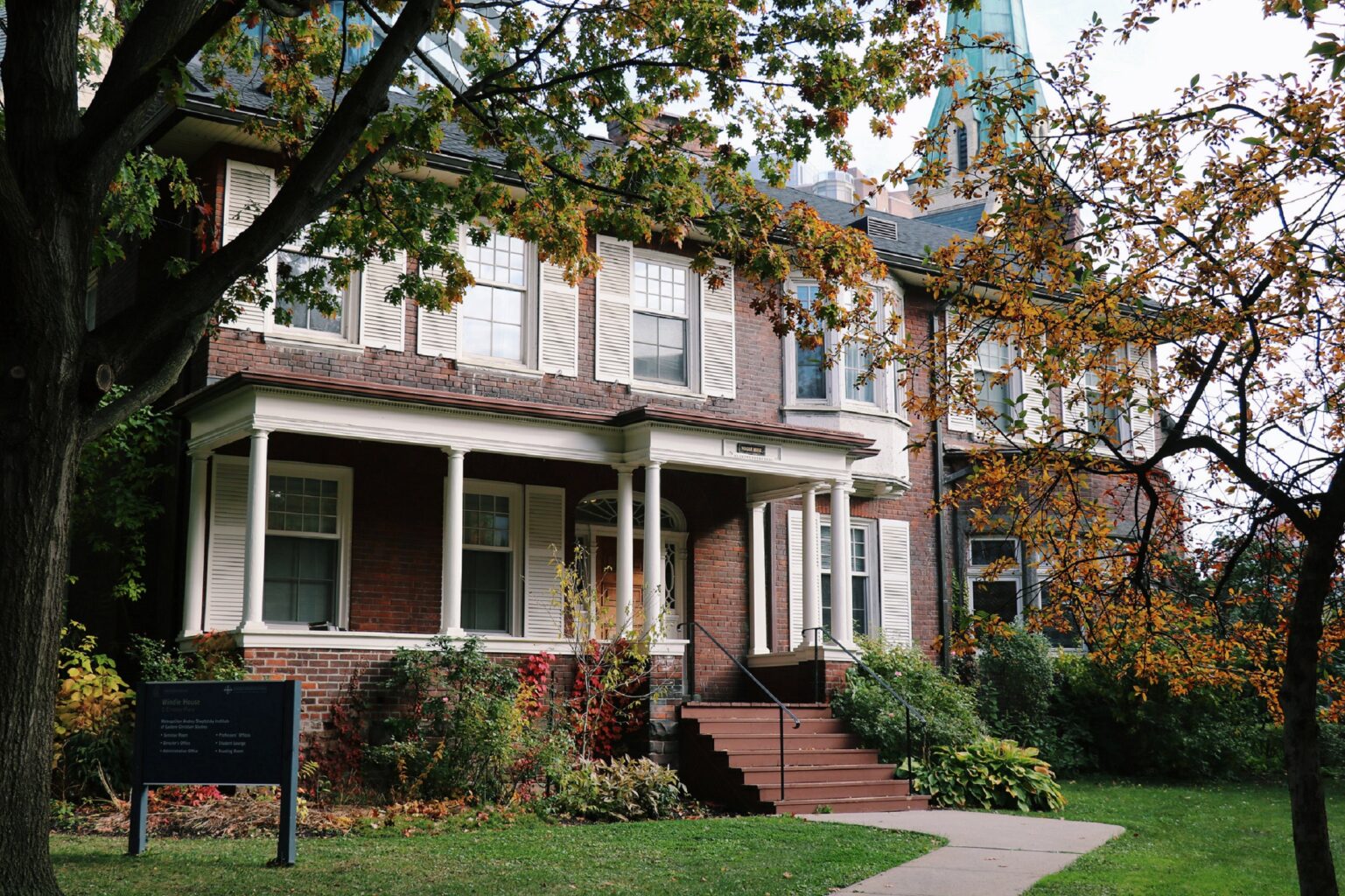
In this time of pandemic and lock-down…we are separated by public and health recommendations, law, and fear for ourselves and our loved ones. In this situation, I desire to be reunited with friends, family, and significant other. I expect that you feel the same way. This pain, which I feel in my heart, reminds me of a time when we could be together and be joyful and content in being together.
This experience can give us a chance to reflect on unity and what it means to be united or to desire unity with others. It can help us think about the question of Church unity, especially during the Week of Prayer for Christian Unity, which for more than a century has occurred every year from January 18–25. In this little blog post I will reflect on the pain of separation, the joy of unity, and my identity as a Ukrainian Greco-Catholic in the midst of these.
I can recall a few moments in my own life when I have felt the pain caused by the separation among Christians. I keep those experiences in my heart as a reason to work for unity. The first time my heart felt the pain of separation was in Amsterdam, where other students and I were attending an ecumenical conference. That was, in fact, one of my first experiences of listening to and speaking with other Christian denominations. It was exciting to see that there are a lot of themes that unite us. As a part of that meeting, we went to a Sunday service in one old and lovely English Reformed Church. There was a wonderful service and sermon. It was the Sunday of the Cross in my Church calendar, and I was happy that the preaching was about the symbol of the Cross and its importance in the Christian life as the sign of our salvation. After that, however, I was disappointed at the absence of the Eucharist in the service, and it brought me some pain. I understood that I could not have received it anyway, but the pain of not seeing the Eucharist—what I understand to be the realization of unity—as part of the Sunday service profoundly pained my heart.
Another experience that brought the pain of separation into focus came during an ecumenical conference a few years ago. The conference was an excellent opportunity for dialogue and sharing about what unites us. Common prayer was part of that conference, and one of the prayer services was a Byzantine Divine Liturgy presided at by an Orthodox priest. It was nice to pray together in one of the ways that I pray in my own parish. But the pain again struck my heart during Communion… Because of the separation, I could not share Eucharist with those who pray in the same way I do. The pain caused by these two experiences of Christian disunity remains. And it creates in me a longing for unity—a unity that heals the wounds among Christians as well as the wound left in my own heart.
Happily, my heart is also marked by other, more joyful experiences. It seems to me that pain alone cannot bring us together—we also need to feel the joy of unity. Studying at the Toronto School of Theology is one of these experiences. Being part of the University of Saint Michael’s College and studying together with other students of different Christian denominations brings me a lot of joy. Also, the presence of the Metropolitan Andrey Sheptytsky Institute of Eastern Christian Studies at Saint Michael’s brings a different voice and many opportunities for the students to experience and learn about other traditions. This experience of common work, studies, prayer, and friendship reveals a lot of differences; at the same time, simply being together unites us.
As I mentioned before, I am a Ukrainian Greco-Catholic. This means that I belong to an Eastern Church of the Byzantine Rite that is in union with Rome. There are 23 Eastern Catholic Churches in the world. Being an Eastern Catholic is beautiful but challenging in some ways. I experience all the beauty of Byzantine prayer, eastern spirituality, and magnificent iconography. I also enjoy all the beauty of the Latin Church, its theology, prayer, and teachings. Living in these two spheres simultaneously gives me the feeling that I see a glimpse of unity among the churches, and I feel the pain of separation and the joy of unity at the same time. But I know there is a long way to go, and all of our efforts are not enough if we do not call on the Holy Spirit to unite all Christians, as He did at Pentecost. Therefore, this Week of Prayer for Christian Unity gives us an excellent opportunity to be together (even if it is virtually), pray, be joyful and ask the Holy Spirit to unite us.
It seems appropriate to finish this little blog post with the words of the Kontakion of Pentecost:
“When the Most High came down and confused the tongues, He parted the nations. When He divided the tongues of fire, He called all to unity; and with one voice we glorify the all-Holy Spirit.”
Read other InsightOut posts.
The SMC Troubadours perform physically distanced Christmas carols in this special InsightOut post.
Not even a pandemic can stop Christmas from coming to St. Mike’s.
While the campus is quiet and missing many of the traditional seasonal activities this year—the alumni Christmas tea and the Schola Cantorum Advent concert are two notable, sorely missed examples—our gorgeous Christmas lights will still illuminate the grounds to bring cheer both to those students in residence as well as to neighbours and passersby.
To ensure that help gets to those in need, the annual toy drive, which sees St. Michael’s team up with the University of Toronto campus police and the Society of St. Vincent de Paul, is accepting donations online to buy gift cards for families so that parents can pick out the perfect items for their loved ones. Donations of gift cards are also being accepted at the security desk in Charbonnel Hall at 81 St. Mary St. Donations are being accepted up until Friday, December 4.
And in this season of giving, the University has been particularly touched by the generosity of the creative minds who came up with a way to compensate for the fact the annual golf tournament fundraiser was COVID-cancelled. Two golf tournament sponsors—Mackenzie Financial and CIBC, who are represented by event co-chairs Barry McInerney and David Scandiffio—made donations of $10,000 each this year instead of sponsorships. USMC matched these donations with proceeds from previous years’ tournaments to create a $40,000 expendable fund, allocated care of the Registrar’s office, to help students with exceptional needs related to COVID.
This approach parallels the Faculty of Theology fund created earlier this year, which was built from donations and matched by St. Michael’s. Together, these gifts represent the continued loyalty of golf tournament sponsors and the commitment of alumni, faculty, staff and the university to helping students during this challenging time.
At a time when food banks and social service agencies are seeing soaring demand, the generosity is being spread widely. Another golf tournament sponsor, Mawer, donated $5,000 in lieu of sponsorsip. This, too, was matched with donations from previous years and augmented by other alumni gifts, creating a gift of $12,500 to support the Out of the Cold program at St. Basil’s Church.
While an Advent Vespers service followed by dinner is one of the highlights of the Faculty of Theology’s social calendar, Vespers will be observed online this December, with a social gathering to follow. And since there’ll be no dinner cheque for the SLC to pick up this year, they’re offering a great incentive to partygoers, promising to make a $15 donation to the Into the Cold program for each person who attends the online party.
The undergrads also have online fun planned, with a Winter Festival from Dec. 4 to 6 featuring decorating Christmas ornaments with the commuter dons, a Kelly’s Corner, and a family dinner all lined up.
And while most of us will find this a quieter, slower-paced Advent season, without the usual trips to the mall or holiday parties, there is no doubt we could all use some peace. With that in mind, St. Basil’s is hoping to open the church for prayer from 7:30 to 8:30 a.m. and 12 to 1 p.m. Monday to Friday, 5 to 6 p.m. Saturdays, and 12 to 1 p.m. and 4:30 to 5:30 p.m. on Sundays. Capacity when the church is open is restricted to 10 people. During these prayer times, a priest is usually available to hear confessions, except for the 7:30 to 8:30 a.m. time periods.
COVID-19 may have changed this holiday season, but the heart of St. Mike’s just continues to grow.
Convocation is a time not only for celebrating memories and friendships, but also the academic and extracurricular achievements of the graduating class. Celebrate the accomplishments of this fall’s College Silver Medal and Fr. Madden Leadership Award winners with us as members of the Class of 2020 enters the St. Michael’s alumni family.
St. Michael’s College Silver Medal
College Silver Medals are awarded to all graduating students who have a cumulative grade point average of at least 3.7. The recipients of College Silver Medals for Fall 2020 are:
Layla Kristina Pereira DaSilva
Fatima Asiya Habib
Nora Sahel-Gozin
Chutian Wang
Zigeng Zhao
The Fr. Robert Madden, CSB Leadership Awards
Father Robert Madden was a much admired professor, chaplain and rector at St Mike’s who served as the director of alumni affairs in his retirement. The Father Robert Madden Leadership Awards are presented to students who have made significant contributions to the University of St. Michael’s College community by demonstrating leadership, cooperation, and solidarity in student-run organizations or community endeavours.
The recipients of Fr. Robert Madden, CSB Leadership Awards for Fall 2020 are:
Alison Feise
Joseph Gratkowski
Bridget Hager
Kaitlynn Marrese
Isabela Villanoy
Celebrate Fall 2020 graduates with us during a virtual convocation ceremony for the Faculty of Arts & Science Saturday, Nov. 21 at 12 p.m.
FOR IMMEDIATE RELEASE
University of St. Michael’s College and Umalia Collaborate on Brokering Multi-Stakeholder Partnerships
TORONTO, Canada November 10 / – This week the Diploma in Social Responsibility & Sustainability and Umalia are launching a “living learning laboratory” on multi-stakeholder partnerships. “This is a win-win collaboration,” says Kathryn Cooper, Program Manager. “Umalia is a leader in developing multi-stakeholder partnerships for social and environmental impact. Our students will be learning firsthand best practices while lending their expertise to the future sustainability of the project.”
Students from the 2020/21 Cohort of the Graduate Diploma in Social Responsibility & Sustainability will be studying the Climat’Eau project. This project, led by Umalia for the last three years, is a multi-stakeholder partnership in Benin, Africa involving local Beninese partners, the Sô-Ava municipal government and the Sô-Ava Collective of Civil Society Organizations, the Canadian company Technologies Ecofixe, and Université Laval. The purpose of the project has been to build resilience of populations against the effects of climate change in Benin.
“The students at the University of St. Michael’s College will be examining five aspects of the project and making recommendations to contribute to the reflection of the long-term sustainability of this partnership,” says Lucie Bourgeois, President and Founder of Umalia. “Our project team is looking forward to receiving an external perspective on this important project.”
The Benin project began in 2017 and is funded in part by the Government of Quebec under the International Climate Cooperation Program. In 2013 Umalia committed itself to the community of Sô-Ava in southern Benin, together with the local municipal government and the Collective of Civil Society Organizations (COSC) for a period of ten years. Umalia’s objective was to use its experience and expertise to support the community in its development efforts, to build resilience to climate change, to build value-creating partnerships with the private sector and to establish responsible and sustainable collaborative governance.
“The Team at Umalia live their values,” says Kathryn Cooper. “Each Member has committed to volunteer their time to advance this project. Their passion for ‘making a difference’ through multi-stakeholder partnerships is inspiring. I hope our students come away from this experience with the skills and enthusiasm to put these types of partnerships to work in their sectors, for social and environmental good.”
About Umalia
Umalia Inc. is a consulting firm founded on the strong belief that profit and societal engagement can and must go hand in hand. Therefore, Umalia helps organizations to design, implement and activate strategies and ecosystems to create sustainable value for both organizations and society.
About the Graduate Diploma in Social Responsibility & Sustainability
Thirty-five participants are accepted annually to St. Michael’s program, which attracts students from across Canada and around the world. This “work as you learn” program enables participants to take their career in Social Responsibility and Sustainability to the next level. Participants tackle and resolve a Sustainability/ESG challenge in their company in a major Action Project under the mentorship of faculty and co-learners; learn from global thought leaders; experience practical “real world” change management through the ExperienceChange™ Simulation and join a prestigious community of St. Michael’s Alumni in continuing education, sharing and networking. Graduates receive the post nominal letters G.Dipl.SR&S.
The Diploma is now taking applications for 2021/2022. Only 35 applicants are accepted. To apply, go to the Diploma in Social Responsibility and Sustainability Website. First Intake Deadline is April 30, 2021.
About the University of St. Michael’s College in the University of Toronto
The University of St. Michael’s College (USMC) is a Catholic institution of higher learning federated with the University of Toronto. USMC strives to offer students a transformative educational experience in a diverse and engaged community, encouraging and supporting students and graduates to share their gifts in the cause of the greater good.
A Business Advisory Committee ensures the Diploma program is relevant and experiential. Sustainability/ESG Leaders representing a broad range of business sectors provide advice and input.
For More Information Contact
Kathryn A. Cooper, Program Manager, Diploma in Social Responsibility & Sustainability
Phone: (519) 855-9491
Website: https://www.csr-stmikes.ca/
Delphine Orfila, Consultant, Societal Engagement, Umalia
Phone: (438) 725-0518
Email: Dorfila@umalia.ca
Website: www.umalia.ca
St. Michael’s Profs Use Creativity to Remotely Engage Students
As a scholar of video games in popular culture, St. Michael’s Assistant Professor Dr. Felan Parker is deeply familiar with entertainment platforms used to livestream video games for an audience, a genre of media that has only grown more popular among Parker’s students since the pandemic forced their lives online.
Parker puts his expertise to use by using the streaming platform Twitch to teach, offering critical and academic commentary on his own playthroughs during his courses and virtual events. Doing so enables him to provide direct insight into issues of form, themes, tropes, and even the economics of production in the context of the games themselves.
“I think being a media scholar is a double-edged sword in this situation,” says Parker. “On the one hand, I have practical knowledge of digital media and conceptual understanding of how to use them effectively, but on the other hand I am acutely aware of the challenges and potential problems with digital platforms,” he says. Making sure students understand how platforms leverage user data for targeted advertising, for example, has been important to Parker during the transition to remote teaching.
Each week for classes such as his First-Year Foundations course How to Study Video Games, Parker uses Twitch to play a different game live on stream with running commentary about how it relates to the topic, and students will chime in using the text chat function.
“Rather than being passive observers, I’m taking advantage of the interactivity of the platform to encourage students to be ‘backseat players,’” Parker says. The active involvement of his students during in-class streams ranges from their own observations about the game and connections to other class materials to crowdsourced decisions that Parker uses to drive ahead the game’s action.
The Twitch engagements provide a foundation for further discussion, and Parker uses the stream in part to model “a critical and analytical mode” for students to practise when they interact with games. Twitch also factors into the course content because it’s become an essential promotional tool for game developers as well as a major presence in gaming’s cultural ecosystem. In his research, Parker explores the way the streaming platform has become essential for independent game developers to market their wares, and in class he uses it to showcase games his students may not have seen or been able to access before.

One example is Blasphemous, a game Parker played on Twitch to kick off Streaming SMC, a new series in which he invites fellow St. Michael’s professors to join him to discuss games relevant to their expertise. As Parker’s St. Michael’s colleague Dr. Stephen Tardif offered commentary linking the game’s pseudo-Catholic aesthetics and narrative to real-world sources, Comper Professor of Medieval Studies Dr. Alison More entered the chat to provide historical insight into subjects ranging from 13th-century understandings of purgatory to medieval penitential movements.
The way games and other popular media help to shape and inform modern culture is one of the interests that drives Parker’s research. This year, he joined scholars from several other universities to collaborate on a SSHRC grant–funded project, Swarming SDCC, which looks at the complicated relationship between media industry producers and fans. The two groups have very different relationships to both entertainment franchises and the ComicCon events that showcase them, as Parker and his collaborators argued in an article for The Conversation. Eventually, Parker says his hope is to bring his students into the project as researchers “to participate in the actual on-site ethnography.
“I always strive to give students the tools to bring a critical perspective to bear on the digital media and technology that structures their everyday lives,” says Parker. “This feels particularly pressing in this moment, since for better or for worse we are more immersed in digital media than ever.”
_____________________________
Consult Fall 2020 for current updates on St. Michael’s plans for the fall semester.
Fall Campus Week gives prospective University of Toronto students the opportunity to remotely explore programs and colleges at the University. This Saturday, St. Michael’s College will open its virtual doors to introduce some of those students to its vibrant community, its outstanding academic programs, and its robust supports for students.
“When you come to St. Michael’s you will feel this sense of community that is very real,” says Giancarlo Mazzanti, St. Michael’s Registrar and Director of Student Services. “Our approach is to make it as human an experience as possible – meeting with current students, advisors and student services personnel,” he says.
This year, current students will facilitate live chats with virtual guests to discuss life at the College during two two-hour windows, and a diverse student panel will also offer a more focused presentation on their experience of community at St. Mike’s.
Advisors from the Office of the Registrar and profs and staff from the Office of the Principal will also introduce prospective students to another St. Mike’s distinctive during Fall Campus Week and on Fall Campus Day itself: the outstanding interdisciplinary programs that draw from the College’s historic strengths.
“I like to think of it as a small liberal arts college sitting at the corner of Bay and Wellesley,” Mazzanti says, noting the small class sizes and personalized support students receive in sponsored programs like Christianity & Culture and Medieval Studies. The appointments of new professors like Dr. Adam Hincks, SJ as the Sutton Family Chair in Science, Christianity and Cultures and Dr. Alison More as Comper Professor of Medieval Studies and the introduction of special initiatives like Dr. Paolo Granata’s Media Ethics Lab have contributed to a sense of renewal and new excitement for the College’s programs.
These professors also support the College’s commitment to building a diverse and inclusive community, connecting with students through virtual events and a unique first-year check-in program. These are two examples of the many supports the College’s registrarial advisors will introduce to students—a range of services touching all parts of campus, from mental health counseling to academic assistance to financial aid.
While the pandemic has made the prospect of attending university more challenging for some students this year, Mazzanti also emphasizes the ways the University and College are partnering to give unprecedented help to incoming students affected by COVID-19. St. Michael’s normally receives $372,000 from the University of Toronto to support grants and other student aid. This year that figure has doubled to $744,000, with the extra funding intended to cover COVID-19-related needs. This funding is in addition to St. Michael’s own bursaries, grants, and other student aid, all of which will be covered during the event.
The additional funding enables the Office of the Registrar to help a bigger pool of students to cover additional expenses, and gives the office the flexibility to provide assistance to international students undergoing pandemic-related financial stresses.
While students may not be able to physically visit the campus, virtual tours will make it possible for them to take in the sight of St. Michael’s “Oasis in the City.” If they pay attention to social media, they may even get a chance to catch sight of one of the campus’s most recent visitors—a silver fox—or take a moment to relax in front of one of the many fireplaces.
Fall Campus Week at the University of Toronto runs from October 17 to 25. Fall Campus Day for St. Michael’s College will take place Saturday, October 24. Register to attend.
Michael Coleman is a non-degree studies student at the University of St. Michael’s College. He received an Honours Bachelor of Science degree, double majoring in Physiology and Biochemistry, this past spring. He has also served as a Residence Don for the past three years. In light of the pandemic, he aims to use this 5th year to broaden his academic horizons as well as seek more potential graduate school and employment opportunities.
Never Let the Fire Die
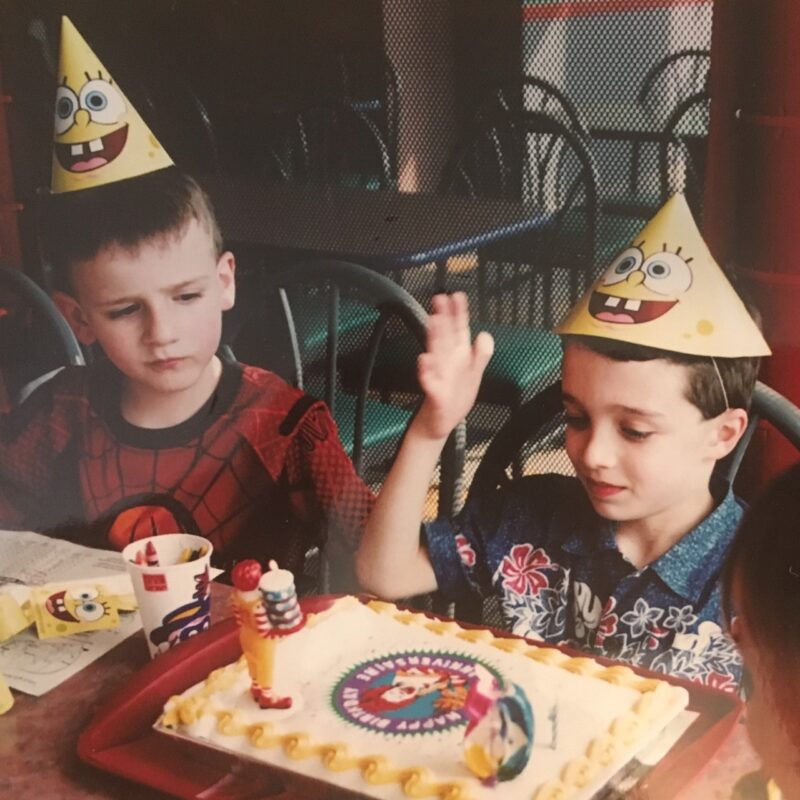
Last month, I celebrated my 22nd birthday with my best friend, Mitch, since the day also marks 18 years of our friendship. I’ll admit that the card he wrote made me quite emotional and reminded me why I call Mitch my brother. He knows that this is a significant year for me regarding academics and Donship, so to instill confidence as only he can, he writes, “You are an inspiration to everyone around you. Never let that fire die.” Sadly, and as much as I’d love it to be, this InsightOut isn’t about Mitch. Instead, I want to take this opportunity to discuss what “never letting the fire die” means as a Don, and how the St. Mike’s Don team is working to continue supporting and inspiring students during these uncertain times.
Serving as a Don for the past three years has been a true privilege. It is a role that allows you to get to know and support the development of residents—typically totalling around 100 people within an average career. Due to the nature of the job, however, you ultimately have double or triple that in numbers of residents on campus who know who you are and recognize you as a student leader. They see you everywhere, and they are always watching.
What I’m getting at is that, as a Don, you end up impacting and setting an example for more students than you might be aware of, hence why we often have to moderate our presence both in-person and online, always acting with good judgment and consistent discipline, and providing accurate referrals where necessary. Sure, every year of Donship comes with its spikes of difficulties, be it busy schedules or unexpected incidents, but it’s part of the job.
This year, however, we are dealing with the most chronic obstacle we’ve ever all faced as a Don team: the pandemic. This prompts the question: How have the Dons adapted to this pandemic-induced shift, and how do we aim to continue to support and inspire students through these new trials and tribulations?
I’ll begin by addressing the first part of the question: How have the Dons adapted to this pandemic-induced shift? Well, let’s talk about what has changed on campus and within the role. All rooms are now single-occupant, overall floor capacity has been reduced, and there are maximums on how many students can be in one space, be it washrooms, common rooms or Brennan Hall’s COOP. Some new rules we must enforce include wearing masks in common spaces and restricting guests from different communities. Furthermore, students are sitting at a distance from one another when dining in the Canada Room, though we’ve recently converted operations to take-out only to comply with provincial guidelines. Lastly, all house meetings and events are to be held online. Thanks to our modified training this year, new and returning Dons alike were able not only to learn about the usual rules of residence and the new COVID-related rules, but also how to use a variety of video conferencing platforms for use within their communities.
Needless to say, these conditions can feel rather isolating and intimidating to both residents and Dons alike, so let’s address the next part of the question: How do we aim to continue to support and inspire students?
This is where “keeping the fire alive” comes into play. This year has been a true testament to our Dons, ensuring they’re in this role for the right reasons. Unlike previous years, we don’t get to have in-person activities or meetings with our residents and must somehow still provide the same degree of support. We can’t allow quarantine or the changes in our role to affect how we act, either, because as previously mentioned it’s still all eyes on us, and as student leaders we can’t succumb to isolation.
We have to maintain our responsibility to our residents by compromising, having those meetings online but devoting ourselves to maintaining optimism and enjoying every interaction we do have with students outside when we see them on campus.
It’s also important for us to remember and share with students that though many buildings and in-person services are closed, we are all still able to access health and wellness services, academic counselling, and registrarial services online where needed. When libraries and gyms are open, I’m sure to tell my students that those resources are available for them, and often end up running into them there. Referrals are also arguably easier to make for students using online platforms, as I can now easily copy and paste any info a student might need during our video call. This reduces the amount of paper notetaking and business cards, and provides a written record of the referral in this digital age.
As a Don, it’s important to recognize that although the job may not look as rewarding or as personal up-front, it is still a job that relies on community-building, enforcing rules, and overseeing the academic and social development of our residents. The support from the Dean’s Office has also kept us informed and motivated. They always keep us updated on guidelines and are always there to talk to us and help us avoid burnout. As student leaders who are passionate about our position to inspire and set an example for those around us, I think Mitch said it best–we can not, and will not, let our fires die.
To close, I ask you to acknowledge your fires as well. Think of things that you have maintained during these uncertain times out of passion and responsibility. Meditate and reflect on what they are and give yourself due credit and congratulations for keeping your fire alive.
Read other InsightOut posts.
Roshni Mathews is a social responsibility enthusiast and student in the 2020–21 cohort of the Graduate Diploma in Social Responsibility and Sustainability.
Kathryn Cooper is Program Manager for the Graduate Diploma in Social Responsibility and Sustainability at the University of St. Michael’s College, a Professor of CSR at Conestoga College and the President of the Sustainability Learning Centre.
Using Experiential Learning to Understand the Bigger Sustainability Picture
To some of us, the current pandemic is a warm-up for the climate crisis. For others, there is a direct connection between changing climate and infectious diseases.
Amid the roller coaster of pandemic cases, students in St. Mike’s Graduate Diploma in Social Responsibility and Sustainability were busy recently seeing the connection and designing a world that could adhere to the Paris Climate Agreement’s 1.5 degree C warming. Divided into Zoom teams, participants played the roles of World Governments, Clean Tech companies, Climate Activists and Fossil Fuel businesses in an international Climate Summit simulation. They learned first-hand the level of collaboration needed to make the planet the climate-stable and socially just place it needs to be. Topics on the debate floor included, “Can focusing on small changes leverage big results?” and “Can building new connections between stakeholders generate environmentally sustainable, socially just possibilities for all?”
These were heady questions for a Monday morning, but with the help of Climate Interactive’s En-ROADS Climate Simulator and the program’s own Climate Ambassador, Laura Lindberg, the group came away with important insights.
“There is no ONE solution on climate action,” says student Tayna Thorpe, Senior Advisor, External Affairs and Communities, Rio Tinto, a participant in the program. “No single action is sufficient. Many levers are required to meet the 1.5 degree target. It truly is all-hands-on-deck time.”
And that is why student Laura Lindberg chose to study the role of climate conversations and became an En-ROADS Climate Ambassador for her capstone project, the summative work for the CSR program. Lindberg, recently employed by PepsiCo in New York and Toronto, joined the program to better understand the impact of the climate crisis.
“I am increasingly concerned about the state of the climate and dire implications for our continued survival. To be honest, I find it difficult not to think about. I felt I needed to do something significant to help,” she notes. “I love presenting and facilitating, so when I found the En-ROADS simulation and training, I knew it would be a tool I could use to make a difference.” As the certified En-ROADS facilitator, Laura guided the climate role play by taking on the role of executive secretary of the United Nations Framework Convention on Climate Change. “It was the first time the En-ROADS Climate Summit had been delivered on Zoom…Companies around the world are beginning to use this tool for employee training and scenario planning. I am proud to be leading USMC’s introduction to this groundbreaking tool,” she says.
“We want participants in this program to challenge their worldview,” notes Kathryn Cooper. “We are living the unintended consequences of our unexamined assumptions about the environment, society and business. Participating in the simulation and role play engaged the cohort in an interactive, thought-provoking way. I think we learned that everyone has a role to play in addressing global climate change. None of us can solve this alone, and small measures won’t cut it. We are all part of a larger system and every policy lever needs to be pulled. Everyone reading this article has a role to play.”
After using the En-ROADS simulation, CSR participants understood at a deeper level which policies and strategies are more likely to have a big impact.
“Cross-industry and cross-sector partnerships are required to make significant environmental progress,” says Roshni Mathews, who took the free training sessions to become the En-ROADS facilitator for this exercise. “In this simulation, we all learned that collaboration, shared goals, and a willingness to be flexible for the greater good is key to making impact.”
About the Graduate Diploma in Social Responsibility & Sustainability:
For close to 20 years, the University of St. Michael’s College has been the go-to school in Canada to study Corporate Social Responsibility, an operational philosophy also known by a variety of other labels, including ESG (Environmental, Social, and Governance), Corporate Citizenship, Social Purpose and Social Innovation. The program is renowned for blending Liberal Arts critical thought, social justice, and practical problem solving with expert instructors and mentored capstone projects. In 2019, Dr. David Sylvester awarded the first President’s Capstone Project Awards.
Read other InsightOut posts.
Mike Czobit is the director of the Office of the Principal, and the coordinator of SMC One. Before joining St. Michael’s in 2017, he was an editor and writer at World Vision Canada.
There Will Be Cake
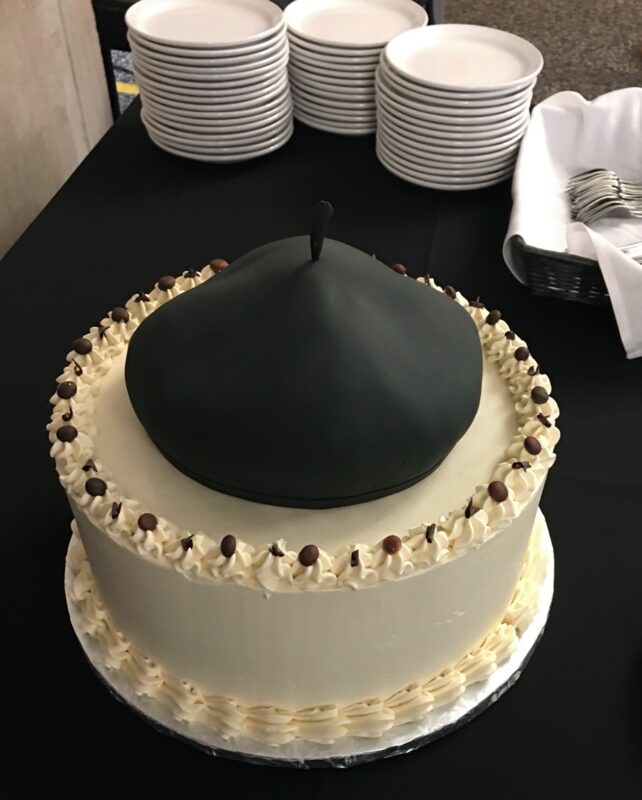
Every year, before the Gilson Seminar in Faith and Ideas meets for its first lecture in September, we have an opening reception and something we call the “Beret’ing In.” To the tune of Prince’s “Raspberry Beret,” each incoming Gilson Seminar student approaches the lectern in Charbonnel Lounge and receives a black beret, officially joining the seminar. After every student has been beret’ed in, cake is served—a special kind of cake: raspberry beret cake.
This tradition is a night of fun and introductions before the hard work of the Gilson Seminar begins. The course, which is split into two half-term classes over the course of the year, is one of three first-year seminars offered by St. Michael’s College as part of our SMC One program. The other two seminars are the McLuhan Seminar in Creativity and Technology and the Boyle Seminar in Scripts and Stories.
These seminars are among the most popular first-year courses at the University of Toronto, owing to a number of factors. For example, each is taught by a member of our talented St. Michael’s faculty in a small class setting that fosters fascinating discussions and close friendships with fellow classmates, and each features an international learning experience. In the Boyle Seminar, students are invited to travel to Dublin after the April exam period. A trip to Silicon Valley takes place during reading week for the McLuhan Seminar. And the Gilson Seminar’s second half-course has its destination in its title: The Gilson Seminar in Faith and Rome.
For most people, international travel these days has been ruled out for health and safety reasons, and for the impracticality of visiting a country when it likely requires a quarantine upon arrival. But, back in February, before the present conditions of international travel took hold, there still was the possibility to go to Rome or Dublin. In fact, that was the plan for both the Gilson and Boyle classes (the McLuhan Seminar had traveled to Silicon Valley last November, before anyone here had really heard of the virus).
In the Principal’s Office, we are responsible for organizing all three SMC One trips. Throughout January and February, we proceeded as usual, preparing students by holding Safety Abroad workshops, requesting traveler information, and making airfare arrangements. We worked with our partners in Dublin and Rome to finalize details for each trip, and in the case of Rome, arranged for tickets for the Pope’s Wednesday Audience. Everything was proceeding as it had every year, except, as everyone knows now, this wouldn’t be a normal year.
By late February, my office was paying particular attention to reports of COVID-19 cases emerging worldwide. When the first few cases surfaced in northern Italy, we were concerned but hopeful that the country would get control of the virus. Reflecting on that now makes me realize how little we all knew and how naïve my optimism was. Day by day, in early March, the number of infected patients rose. Not just in Europe, but also at home. These developments worried our SMC One students, who began asking my office questions about the safety of our planned trips. At the time, we honestly didn’t know what the virus would mean, but we assured our students that safety would be paramount and that the trips could be postponed. Then, on March 12 that happened. The University decided that due to safety concerns, all student travel would be postponed until further notice. This was the right decision.
After we unwound the arrangements for the planned trips, my office had a different task to attend to, which was to start recruiting for next year’s SMC One seminars. When we promote these classes, we do the opposite of shying away from discussing their travel components. But during this recruitment period, getting on a plane to go somewhere far away seemed like the least desirable thing to do. At the same time, the 2020–21 SMC One seminars were months away and the situation in March would change—and, to be optimistic, be much, much better.
We pushed forward with our recruitment effort, inviting incoming U of T students to apply for a spot in our seminars. We expected that we would struggle to fill the classes. We expected that SMC One would have lost its popularity. What happened was something different.
When the application window closed on June 15, we had received the highest number of applications for SMC One in the three years their present format has existed. In fact, we doubled the total number of applications over our previous best. Our incoming students were not deterred by news reports of the virus or of how international travel will never be the same. They reacted to the closing of borders with a greater desire to see them open again. What they want, and what classes such as SMC One will provide, is a return to better times when a desire to explore and experience life and culture in different parts of the world can enrich a university education.
As the new academic year begins, we have begun planning for our SMC One classes. Different this year is that all three will take place in the Winter term, with the hope that all will be able to be in-person or have a larger in-person component than is safe in the Fall term. It is too early to know what international travel will look like in 2021, but we’re hopeful that conditions will improve.
Every year, the Gilson Seminar begins with berets and cakes. We hope to see this tradition resume in this coming year’s Gilson class. And when the cake is finally served, it will have the double meaning: welcoming a new class to St. Michael’s College and also celebrating how far we’ve come through difficult times. When we began our recruitment effort for SMC One in the spring, we were pessimistic about our prospects of filling these classes. Our students showed we should have felt otherwise.
Read other InsightOut posts.
Theologian Karl Barth famously advised younger colleagues to base their work on both the Bible and the newspaper. Now, two new courses offered by the Faculty of Theology at the University of St. Michael’s College are doing just that, reflecting theologically on the evils of racism and clerical sexual abuse, topics that regularly make front-page news.
Theology of Radical Evil and Suffering will look at the experience and testimony of Jewish, African American and Indigenous individuals and communities who experienced extreme evil and suffering at the hands of those reclaiming what they understood to be their Christian faith, values and way of life.
(Sexual) Abuse and the Catholic Church, in turn, aims to explore how the present sexual abuse crisis informs—and proposes the need to reform—the understanding of the church as body of Christ.
“These are very challenging—and very necessary—courses,” says Interim Dean John L. McLaughlin. “We are educating people who will be helping to find the answers to society’s ills. They need to understand root causes and be able to recognize systemic challenges before they can begin to effect change.”
Radical Evil and Suffering “will offer a different approach to evil, as often we look at both God and evil at once in abstract philosophical terms,” says Dr. Jean-Pierre Fortin, who will be teaching the course. “This course will have a more practical approach, based on self-narratives, determining agency and how we experience the impact of evil on our personal identities and lives. How as Christians do we listen to victims when Christianity is on the side of the perpetrator?”
Along with readings from theologian Dorothee Soelle and philosopher Simone Weil on the nature of suffering, the course also features the works of such writers as Holocaust survivor Elie Wiesel, Dr. M. Shawn Copeland, who is a specialist in African American Catholic theology, Aboriginal writer Thomas King, and documents from the Truth and Reconciliation Commission (TRC).
Dr. Fortin, who is the author of Grace in Auschwitz: A Holocaust Christology, says his years living in Chicago while teaching at Loyola University exposed him to the reality of the African-American experience, and allowed him to hear prophetic voices. As a Canadian, he felt the ongoing fallout from residential schools and the injustices revealed via the TRC highlighted the need to discuss injustices suffered by Canada’s Indigenous peoples and reflect constructively on a responsible Christian response.
(Sexual) Abuse in the Church, which is being co-taught by theology professors Drs. Darren Dias, OP, and Michael Attridge, is one of the first of its kind to be taught in Canada.
“The church has gotten better, in the sense that the present number of cases has decreased, but the crimes that have been committed are a permanent wound,” Dr. Dias says. “After (1989’s) Mt. Cashel scandal, people thought it couldn’t happen again. Then came the magnitude of Pennsylvania (where a grand jury report indicated the church had covered up abuses committed by more than 300 priests over a 70-year span) and we began to realize that this was happening around the world, in any number of cultures and linguistic groups, whether the United States or India.”
The course will be delivered in three sections: the first will be inductive, using data such as statistics and ethnography; the second will look at structural, systemic issues such as celibacy, clericalism and power; the final section of the course will be deductive, looking at what church is and what the people of God are called to be. The last section, notes Dr. Attridge, will look at Scripture, and theologically grounded teachings from Pope Francis and others. Each class will begin with the testimony of survivors.
“If we think of church as sacrament, with the moral responsibility to be the body of Christ, the presence of God in the world, ask yourself what it means when the Church, called to be an instrument of God’s love, behaves in this way,”says Dr. Attridge. “We are talking about Church in a responsible, methodological way.”
Dr. Dias agrees.
“This is a pervasive issue and Catholic universities have to address it, both because we have witnessed degrees of abdication within the church and because we are informing people who will be in ministry,” he says.
Theology of Radical Evil and Suffering (SMT5610HS) is offered Tuesdays from 14:00-16:00 in the fall semester.
(Sexual) Abuse and the Catholic Church (SMJ3/6505HF) is offered staggered Saturdays from 9:00-13:00 in the fall semester.
Clubs are an essential part of the larger St. Michael’s community, and bring students together from across the university. USMC alumnus Modele Kuforiji found community while a student at the University of Toronto through his involvement in clubs such as the Black Students Association:
Current students have an opportunity to learn about clubs on campus through the annual USMC Clubs Fair. This year’s event will be divided into Day One and Day Two. Both events will take place online; contact SMCSU for Zoom information in advance.
Cianna Choo and Jessica Sorbara are this year’s Orientation coordinators. Cianna is a 3rd-year student majoring in Neuroscience and Molecular Genetics and Microbiology, while Jessica is a 4th-year English and History major. They have been involved with Orientation throughout their time at St. Mike’s and, as they say, “becoming a part of Orientation has undoubtedly been one the best decisions we’ve made throughout our time at UofT so far.”
Welcoming the Class of 2024 Virtually
Welcoming incoming students to the St. Mike’s campus and university life at UofT is always exciting and rewarding, but this year we are even more excited to be greeting students in a new, innovative way, adjusting to life amidst the COVID-19 pandemic.
Organizing a virtual Orientation for upwards of 1000 incoming students was definitely not something we expected when we started to plan our events in April, and we have had to adapt and reconstruct mostly all of our original plans. We have faced challenges of accessibility, social distancing guidelines, and scheduling with people located around the world. With the changing and complicated circumstances around us, we were constantly in a cycle of adjusting and re-imagining our plans for Orientation 2020. Because we are unable to have a traditional in-person Orientation we have had to think of fun events that would substitute for our usual elaborate on-campus activities. While changing plans and adapting to virtual methods of Orientation is extremely challenging, it has also allowed us to explore so many different delivery methods, activities and events that we would have never thought about before.
Something new and exciting this year has been the shift from Orientation being one week of amazing events and activities in September, just before school starts, to organizing an entire summer leading up to that week. Planning Orientation has been both a challenging and exciting process, trying to figure out ways to build the St. Mike’s community with incoming students who have never been on campus before. With the transition to an online approach, we have had to find new ways to make sure students can feel—through their computer screens—the welcoming, positive energy that radiates throughout St. Mike’s.
Throughout this summer the two of us, along with our amazing Orientation team, have had to find a way to create a virtual community; thankfully, we’ve managed to do that through our SMC Online Orientation page on Quercus and our various social media pages. Our SMC Online Orientation page is filled with modules introducing different programs, professors, clubs, events, and all aspects of life at SMC.
We have also been able to interact with students directly via our Summer Workshop Series—a new concept we are both so happy to have made possible this summer. Wanting to make sure the incoming class was prepared for their first year of university, we took a moment to reflect on our own first-year experiences and all the questions we had asked regarding university life. Our Orientation team then created and facilitated the Summer Workshop Series sessions, where we would share our own experiences and advice to help incoming students with their transition into university. We got the chance to host some amazing sessions, including ones offering ideas on how to get involved at St. Mike’s, study and time management tips, ways to explore Toronto, and so many more!
Even though we have had to eliminate some of our traditional Orientation events, we were able to create such amazing aspects of Orientation we would have never thought about previously. We also began thinking about all the different ways we wanted students to get excited about Orientation before the week itself. We wanted to make sure this incoming class wasn’t missing out on the sense of spirit that we have at St. Mike’s, so we had to get creative. We have introduced many contests this summer on our social media pages to get students engaged—learning the Hoikity Choik, getting excited about bed races, and showing off SMC spirit! We have also been extremely lucky to work with an amazing group of leaders and marshals who, throughout the entire summer, have shown everyone how much SMC means to them. By facilitating events and creating videos about campus, TikToks, Instagram takeovers, and so much more, everyone on our Orientation team has shown the incoming students how amazing and welcoming the community is at St. Mike’s.
Organizing a week of fun, informative events online was a completely new experience for the two of us, but it was something that got us to think about Orientation in a completely new way. With all the changes that have come our way, we are so excited to meet our incoming class and to see that SMC spirit—even if it is through our computer screens!
Read other InsightOut posts.
In the aftermath of the 2013 acquittal of George Zimmerman, the man responsible for the death of Black teenager Trayvon Martin, a hashtag began to circulate on Twitter: #BlackLivesMatter. In the years that followed, the hashtag has transformed from a rallying cry in response to police violence against Black people to a powerful movement for racial justice and equality around the world.
Starting in the Winter term, a journalist, scholar, and activist who has been deeply involved in the conversation about the movement in Canada will teach a high-level seminar on #BlackLivesMatter in the Book and Media Studies program at St. Michael’s.
“To answer the question of the relationship between the movement and the media, it is necessary to answer a second question: do Black lives matter in the media?” #BlackLives and the Media course instructor Emilie Nicolas says. “That second question is the question that goes way before the creation of the [BLM] movement, which is very much the latest iteration of a human rights movement that goes back generations.”
Providing this historical context for #BlackLivesMatter is an important goal for the course, which will also provide a critical perspective on the dynamics of power and the complicated interrelationships between the movement and the media environment in which it emerged. Because the media environment varies from country to country, Nicolas will also offer a comparative international perspective to help students grasp the nationally specific characteristics of the movement and its reception around the world. Though the hashtag first appeared in response to violence in the United States, it’s important to remember that #BlackLivesMatter “is not just an American movement,” she says.
As a columnist for Québécois newspaper Le Devoir and a regular contributor to national outlets such as CBC’s Power & Politics and CTV’s PowerPlay, Nicolas has spent years observing and participating in conversations about how the media covers stories about Black people—and how it can fix its coverage. She also “contributed to social movements and organized on behalf of victims of police brutality in Montreal,” and several years ago helped head up a group that lobbied against Canadian media using blackface. This larger background in both journalism and organizing will fuel a course that provides an inside look at the dynamics of both media institutions and the movement for racial justice that sees media as a “battleground.”
With guest speakers including both reporters and organizers, the course will also be responsive to breaking news, including the aftermath of the upcoming American election. “When we understand the relationship between anti-Black racism and the media better, we can understand the news better,” Nicolas says.
#BlackLives and the Media continues a series of topical Book and Media Studies seminars that began in 2018 with Trump and the Media, a class taught by journalist and former New York Times editor Sam Tanenhaus. Last year, the series continued with #MeToo and the Media, which was jointly taught by Jessica Johnson of the Walrus and the late Anne Kingston, a senior writer and columnist for Maclean’s.
“In its efforts to educate students in media literacy, the Book & Media Studies Program must engage the salient issues of the day, particularly those of social justice, media manipulation, and systemic racism in North American society,” Interim Principal and Vice-President Mark McGowan says. “It is imperative that our students explore the engagement of #BlackLivesMatter and the media and I am delighted that St. Michael’s College can provide a forum for this important conversation.”
SMC300H1S #BlackLives and the Media will be taught on Fridays from 12 to 2 p.m. during the Winter 2021 term.
When the Office of the Dean of Students started developing an online orientation program early this summer in response to the pandemic, they had no idea how popular the program would become. Over 800 incoming St. Mike’s students have enrolled in the program so far, over a hundred more than the average number of participants in Orientation Week on campus in recent years—and not only are they enrolling in greater numbers, but those who enroll are spending large amounts of time on the site as well, Campus Life Coordinator Emma Graham says.
The system recreates an essential part of campus life for incoming students in a time when it’s not possible to gather in person, making it possible for participants to start experiencing the school’s hallmark community in a safe way before the fall term begins.
When developing the online orientation system, Graham and her team of current students aimed to capture three essential content areas: informational content, providing incoming students with everything they need to know before starting their university careers; the physical space, so students will be able to properly orient themselves on campus when they visit; and community. While all three parts were essential to this year’s orientation strategy, the last content in particular helps to account for the program‘s success with the incoming class.
Hosted on Quercus, the University of Toronto’s online teaching and learning environment, St. Michael’s online orientation comprises 12 modules spread over 48 pages. The content includes 37 videos featuring St. Michael’s students and professors. St. Mike’s student and Online Orientation Executive Natalie Barbuzzi took the lead in developing the informational content for the modules, which launched in early June.
“The modules were created to be as accessible as possible,” Barbuzzi says, mentioning topics ranging from financial aid to mental health and student life. The goal was to create a “one-stop shop” for information to help new students make a successful transition into university, which includes information on ways students can get involved in clubs and other activities. The material will remain available on Quercus after the academic year starts, making it a resource new students can return to as their university careers develop.
Additionally, in conjunction with weekly Q&A sessions and international student webinars for new students offered by the Office of the Registrar, Orientation Coordinators and St. Michael’s students Jessica Sorbara and Cianna Choo developed an itinerary of twice-weekly synchronous Summer Workshop sessions meant to offer opportunities for incoming students to connect with each other and foster community.
“We got the chance to host some amazing sessions with our incoming students about getting involved at SMC, international student experiences, study tips and time management, some insider tips on the best wasy to explore Toronto during this unusal time and more,” Choo says. The workshops included how-tos on things like using public transit and talking to professors—essential, practical skills for any new student, but not ones they’re likely to ask around about. “As a team, we all took a moment reflect on our own experiences in first year and tried to think of some things that we would have loved to know in advance of our first year at UofT,” Sorbara says.
The final phase of Online Orientation will begin the first full week of September, when Orientation Week is traditionally scheduled. Divided into groups as they would be for an in-person orientation, new students will have the opportunity to get to know their new classmates while participating in a bevy of online events including movie nights, games, informational sessions, socials with students and faculty, virtual tours, and an online version of Kelly’s Korner.
The connections students are making in advance of the fall term will continue after Orientation concludes: The Mentorship program will kick off with a special social event September 3, and a Clubs Fair will follow later in the month.
Students who still wish to register for St. Mike’s Orientation 2020 can do so at www.stmikesorientation.com. Consult Fall 2020 for current updates on St. Michael’s plans for the fall semester.
What does community look like in the face of a pandemic? For the Faculty of Theology at the University of St. Michael’s College, community has meant professors digging deep into their own pockets and inviting others to join them to start an emergency fund for graduate students struggling with finances due to COVID-19.
To date, the fund has received more than $30,000 in donations from a small group of professors, staff and alumni and the university has offered to match up to $50,000.
When the pandemic began to take hold, the University of Toronto quickly established an emergency fund for students, but because the Faculty of Theology’s degrees are issued by St. Michael’s rather than UofT, graduate students studying at the faculty are not eligible for the UofT relief funding.
Having been graduate students themselves, however, Faculty professors Drs. Darren Dias and Michael Attridge recognized that their students might be facing any number of challenges, ranging from job loss—particularly tough for single students with no supplementary income—to additional expenses because travel restrictions kept them grounded in Toronto. International students, they note, are not eligible to receive CERB funding from the federal government.
“As soon as [Dr. Dias] reported that students were asking if any funding was available I knew creating assistance was the right thing to do,” Dr. Attridge says.
The two professor chatted and then opened up the conversation to their colleagues. In the broader brainstorming session it was suggested that professors establish a fund to help students unable to help cover costs such as groceries, rent or other standard expenses.
St. Michael’s President David Sylvester received the idea enthusiastically and took it one step further, proposing to match donations up to $50,000 from a University fund.
“The Faculty of Theology is in a position to generously fund many students in terms of tuition, but we do not cover day-to-day living expenses,” Dr. Dias explains. “Graduate students often live close to the poverty line. Coronavirus would only make things worse.”
Doctoral student Mariia Ivaniv agrees.
“It is a challenge for an international student to be alone in a foreign country, but to be alone in a foreign country during the world pandemic is….a huge struggle,” says Ivaniv, who comes from Ukraine. “As a student in such a situation, I was happy to hear about [the] initiative… It shows [the professors’] desire not only to develop the big theological ideas but to practice Christian generosity.
“This kind gesture will help students to overcome a lot of challenges and feel protected and supported.”
Another student, who preferred not to be identified, noted that Toronto is a very expensive city, offering as an example his rent of $1,000 a month for a basement apartment.
“Finances are probably the most difficult thing about being a PhD,” says the student, who was forced to stay in Toronto for the summer, even though his work hours were reduced, due to conditions in his home country.
“Response has been great,” says Ken Schnell, whose regular role is Advancement Manager of the annual fundraising campaign, but who is also overseeing this special project. After the initial donations from professors, the advancement office launched the next phase of the campaign and is reaching out to the wider community of alumni and partner organizations to invite them to contribute. “We are delighted by the generous response, to date.”
“Our students tend to be shy about asking for any kind of help,” says Emil Iruthayathas, the faculty’s Student Services Officer, who is notifying students by email about the fund and how to apply.
Funding will be on a semester-by-semester basis and capped at $2,000 a semester per student. With the $32,000 already received and the matching amount from the university, the fund sits just shy of $65,000.
“Since we do not know how long the pandemic will last we want to ensure we can keep some money flowing to students for as long as possible,” says Dr. Dias.
“This kind gesture will help students to overcome a lot of challenges and feel protected and supported,” says Ivaniv.
For more information or to contribute to the Faculty of Theology Student Emergency Fund please contact Ken Schnell at ken.schnell@utoronto.ca or call 416-926-7281.
Question: I want to study on campus this fall. Can I enter Canada and come to U of T?
We understand that you may be concerned about regulations and expectations around entry into Canada in the Fall. Currently, Federal Government policy is that following students are eligible to enter Canada with a non-discretionary reason and should request a letter from their registrar:
- Returning or newly-admitted international students with a study permit approved on or before March 18, 2020
- Returning or newly-admitted students traveling directly from the United States to Canada with an approved study permit regardless of study permit approval date or citizenship
Please be assured that you can begin your program through online courses if you are living outside of Canada.
We will update you as quickly as possible if border restrictions change and will be pleased to provide you with a letter stating that your travel is non-discretionary should that be the case. You can request a letter of support for non-discretionary travel, from you registrar if
- you lived in Canada this past year (e.g. went to high school in Canada)
- you have planned to complete a 14-day quarantine period as soon as you arrive at your final destination (note all travellers from abroad need to quarantine — the university can support you in your quarantine plan (hyperlink)
- you begin studying after you complete your quarantine
- you need to be in Canada for your program (for laboratories, workshops, etc.)
- pursuing your studies online is not an option at your school or not possible from your home country (due to internet restrictions or bandwidth limitations)
Who is currently eligible to enter Canada with a non-discretionary reason:
|
Yes |
No |
|
|---|---|---|
| Returning or newly-admitted international students with a study permit approved on or before March 18, 2020. (If arriving from the United States see below) |
P |
|
| Returning or newly-admitted students traveling directly from the United States to Canada with an approved study permit regardless of study permit approval date or citizenship |
P |
|
| Newly-admitted international students (not traveling from the United States) without an approved study permit, or with a study permit approved after March 18, 2020 |
|
O |
| Returning international students (not traveling from the United States) without an approved study permit, or with a study permit renewal approved after March 18, 2020 |
|
O |
- For updates, visit this FAQ for international students for information.
- Additional information for newly admitted international students is also available.
As the fall semester approaches, the University of St. Michael’s College is implementing cutting-edge measures—including some from front-line health care settings—to keep the campus safe for community members and visitors.
“Safety is of foremost importance when considering reopening—not just for staff and students, but for everyone that has access to USMC,” says Michael Chow, Director of Facilities and Services at St. Mike’s. Following public health guidelines and the University of Toronto, Chow and his team have implemented measures ranging from extensive cleaning strategies to high-tech virus-killing devices. The measures fall into three main categories: facilities, administrative measures, and personal protective equipment (PPE).
Facilities
Visitors to campus will notice a variety of newly installed safety measures this fall, including Plexiglass shields at key points including the Porter’s Desk, Registrar’s Office, and other areas where queues could create challenges for physical distancing. Classrooms and common areas will have less furniture and reduced capacities in order to make it easier for an appropriate distance to be maintained, and signage and stickers will help direct pedestrian traffic to keep people moving efficiently and safely through indoor spaces.
HVAC equipment will receive increased–efficiency filters wherever possible, as well as a more rigorous filter replacement schedule to ensure clean air throughout campus buildings. Twenty-five free-standing hand-sanitizer stations have been installed next to building entrances, high-traffic areas and entrances to larger classrooms, and wipe or spray disinfectants will be available for students to quickly clean off a desk or chair before they use it, as well. All washrooms are now stocked with paper towels, and Legionella testing has identified no issues with water on campus.
Administrative
“I think the most important change is about our cleaning strategies, for both common spaces and student spaces,” Chow says. In line with UofT’s tri-campus cleaning protocols, St. Mike’s will conduct enhanced cleaning throughout all building spaces and student areas while also adding “a dedicated team of cleaners to do disinfecting and increase cleaning in high-touch areas—a minimum of twice a day for high-touch surfaces.” Routine cleaning during normal workday hours as well as on nights and weekends will be enhanced through the use of new cleaning agents, which have been upgraded to a dual-purpose cleaner that both cleans and disinfects.
Hard at work keeping campus safe since the pandemic began, the Facilities and Housekeeping teams is going into the fall semester with new, high-tech tools. Chow says that his team adopted some of these after first seeing them used in hospital and long-term-care settings—the front lines in the fight against the virus.
These tools include a stand–alone UV light system, which staff are using to disinfect all residence rooms before new students move into them in September. The portable UV system is also intended for use in classrooms. A hospital-grade portable disinfectant misting system will also be employed on an as-needed basis, helping to disinfect places that are hard to reach using normal cleaning methods.
PPE
All Facilities & Services staff members have worn either reusable or disposable masks during their work since the pandemic began, with many of those coming from a generous donation of 2000 masks by a St. Michael’s student in May. Now, as some staff and faculty return to campus this fall, two reusable masks will be provided to every student and employee. St. Michael’s will follow the University of Toronto and the City of Toronto in requiring non-medical masks or face coverings to be worn inside buildings that are normally publicly accessible.
Anyone without one will be able to receive a single-use mask at the Porter’s Desk, ensuring that all outside visitors and contractors will also be able to have access to masks while on the USMC campus. Signage posted throughout campus will provide visitors and community members with reminders of proper mask usage as well as principles of handwashing, correct hand sanitizer usage, and other important safety principles.
Behind all the safety measures being implemented on campus, Chow says, are the members of the Facilities and Housekeeping teams, whose tireless efforts have kept students, employees, and visitors safe throughout the pandemic. As he wrote for InsightOut, “Behind the scenes—and often unnoticed—the F&H staff have faced the challenges of the pandemic as essential staff and turned them into opportunities as guardians for the university.”
“I think we’re doing something right,” Chow says. While the safety measures will help keep the St. Michael’s campus safe this fall, he notes, it’s almost just as important to communicate the changes to the campus community “to put everyone’s minds at ease.
“We’re not just sending everyone back to the same university they left,” he says.
Consult Fall 2020 for current updates on St. Michael’s plans for the fall semester.
“The west end of Carr Hall is a beautifully manicured area that sees very little foot traffic,” Rendle says, so it was easy to reimagine the space with tables and fencing. The students-only space allows for robust social distancing at the outdoor tables, making it an ideal space for students to spend time together in a safe manner. It’s also become an ideal spot for al fresco meals, studying quietly, or simply relaxing in the sun.
Since its introduction, the space has seen regular use on sunny days, giving students in residence and members of the larger Toronto community equal opportunity to enjoy St. Mike’s “oasis in the city.”
Isabella Mckay is a senior student majoring in Book and Media Studies at the University of Toronto. Following her passions in marketing, communications, technology, and media, she has become the Vice President of TechXplore, the Director of Marketing of Data Science Toronto, and the Assistant Project Coordinator at the University of Toronto Faculty of Arts and Science Dean’s Office. Mckay looks forward to applying her passions and work to innovate the future.
Love and Happiness as True Measures of Life
During the coronavirus pandemic, I have discovered that the principles of humanity, which are love, togetherness and health, exist as the ultimate purpose and meaning of life.
On January 27, 2020, the National Microbiology Lab in Winnipeg confirmed the first case of coronavirus in Toronto. Remembering the words of my mother to not fear and panic but be prepared and cautious in case of emergencies, I bought one of a few alcohol rub left at a pharmacy in Toronto. At my condo, I found one pack of 20 N95 masks for around 85 dollars with express shipping on Amazon. Although I could search for cheaper masks, future prices would likely increase, and then I might search longer to find no masks and sacrifice my health. I would work to recoup the price within hours; however, I would spend more time and energy to regain what was most important, my health. I purchased the N95 masks within three minutes.
When coronavirus cases rapidly increased after February 24, I had the proper procedures and supplies to calmly protect myself from the coronavirus while others began to panic. I still socialized with friends, studied at the libraries, and attended club events at the University of Toronto.
Then, the University of Toronto announced that, as of March 16, it would close, and move to online courses and examinations to limit coronavirus cases. I wore my N95 mask as I walked around the campus and a downtown Toronto that resembled an abandoned town devoid of energy and emotion.
Before the coronavirus pandemic, I huddled in a tight and quick one-way line of students to attend my classes on time. Now, I freely and slowly roamed past three students on my way to the library. I used to walk around for five minutes to find an empty library seat and to hear pencils and pens scratching on paper during midterm and final exam season; now, however, I found an empty seat and heard the hum of the air conditioner as soon as I walked into the library. I used to sit next to students who flipped through pages of homework, wrote mathematical equations and assignments, and coded programs. As I sat in one of the hundreds of empty seats, I remained two metres or more from other students because of my own preferences or because of tape placed between every two desks and in front of desks.
With the cancellation of on-campus classes and exams, I returned to my family home in Vancouver on March 21. Although the Canadian government did not require citizens to self-isolate on a domestic flight, I feared that someone might have coronavirus on the plane. I wanted to ensure that I had no symptoms and that I would not transmit the virus to family. If I transmitted the virus to my family, I would fail to mend my shredded heart.
Although I talked to my family and friends through my phone during isolation, I became an outsider who might have a disease that everyone feared. I yearned to be near my loved ones, especially my family who sacrificed their time and health to care for me. I did not want, and was not motivated by, my empty university scores and jobs, which for years I had desired most; instead, what I wanted and was motivated by was familial love and unity.
Once I left self-isolation, my family revealed that they struggled to obtain essential groceries and supplies. Before the coronavirus, my family and I might spend half an hour choosing organic and natural vegetables among full shelves. Now I wore ski goggles, plastic gloves and a N95 mask as I social distanced to purchase any supplies at a local grocery market.
Similar to food and supplies, before the coronavirus stole the simplest moments, I took daily and normal activities for granted in order to pursue my career and high marks. I carelessly walked, compared to now seeing someone and moving to the other side of the road. I carelessly talked to others, compared to now yelling over two metres to discuss the coronavirus lockdown. I carelessly socialized with friends compared to messaging them. I carelessly went anywhere to perform multiple activities compared to restricting myself to my home and grocery trips. Appreciating people and the simplest things are blessings of happiness. I am not measured by what I have, but who I am and how grateful I am to have what I have.
Once the lockdown ends, I will refuse to let fear control my life and I will experience the meaning of life: to be around loved ones and increase happiness activities. When will I get another chance, and who foresees the future?
The coronavirus pandemic has taught me how health is the most important quality and how everything else is minor, how people, and the smallest and simplest things, deserve appreciation, and how love and happiness are true life measurements. These essential human qualities are the purpose and goals of an amazing life and these human foundations will support the fight to defeat the coronavirus.
Read other InsightOut posts.
Catherine Mulroney is a communications officer at the University of St. Michael’s College. She is also a double alumna of St. Mike’s, holding a B.A. in English and Mediaeval Studies and a Master of Divinity degree. That equals many hours in Kelly Library and many, many overdue fines.
Raising Our Voices
It began—as many of the best things do—with someone volunteering an absent colleague for a little extra work.
Our new St. Mike’s blog, InsightOut, is the result of an after-hours conversation with Communications Director Laurie Morris and Theology prof Dr. Darren Dias on March 16, the last day we were all present on campus. Dr. Dias mentioned that his colleague, Dr. Michael Attridge, was self-quarantining at home after a research trip to Italy.
“It’s a good story,” Fr. Darren said. “You should ask Mike to write something for the website.”
Then the wheels began to turn. While not one of us could predict just how the comings weeks and months would play out, we knew we were facing an extraordinary moment in the university’s history. There would be value, we thought, in hearing each other’s experiences in, and thoughts about, living through such a momentous period.
Four months later, we now have a pattern established of InsightOut blog posts running on the St. Mike’s home page every Monday and Thursday. Each story, each opinion, is unique. And as the person privileged with soliciting and receiving submissions, I am humbled by the chance to be part of the process.
Graduate student Fr. Gustave Noel Ineza, O.P., for example, spoke about his childhood during the Rwandan genocide and urged us not forget the suffering of the broader world as we focus on local troubles.
Alumnus Dr. Christopher De Bono,Vice President of Mission, People and Ethics at Vancouver’s Providence Health Care, wrote about how moving he found his neighbours’ nightly ritual of banging pots and pans and making noise to celebrate the dedication of health care workers.
Interim Principal Dr. Mark McGowan, meanwhile, a professor of History and Celtic Studies, submitted a video explaining the typhus epidemic of 1847 in light of the current situation.
Professors have written about what their subject areas tell them about the pandemic, while students have talked what St. Mike’s means to them. And alumni members like Patricia Dal Ben, along with her colleague John Kostoff, a member of St. Michael’s Collegium, offered their professional wisdom on how families can keep a faith life alive when unable to get to Mass.
Some people have shyly offered to submit while others, when approached with a specific topic, agree with grudging good humour.
Coming posts will touch on the reality of working from home as a parent, how we are preparing for the coming academic year, and even how to get married during a pandemic. Pieces have ranged from moving to amusing.
Anyone who has worked through these past months will have experienced their colleagues in new ways. Zoom meetings reveal family photos or a glimpse of a partner or pet. A phone call might be interrupted by a delivery person at the door of what has become a home office.
For those of us working at St. Mike’s, the blog has taught us about family, we’ve heard admissions from those who miss their colleagues, we now know about our officemates’ hobbies, and we have gained insight into who we are as a community and what makes us unique. When we are at our best, it seems, we are closer to being family than colleagues.
But lest this sound like busy work or a grand vanity project, it’s anything but. While we’ve gained insight into our colleagues, the blog’s purpose is very much outreach. Having worked on planning various campus events, I know how people look to St. Mike’s to keep them engaged with the world and continuing on a path of lifelong learning. And if we can’t do that in person, some reflections and mini-online lectures are a sound alternative.
Parents of future students may come away from this blog reassured that not only are the people who’ll be working with their children skilled, capable professionals, they are also decent and caring people.
Future students can read the blog and find out some of the cool work happening on campus, and look forward to engaging in the kinds of discussions that make university a once-in-a-lifetime experience.
And alumni can engage with InsightOut and know that their alma mater remains vibrant and in good hands.
One of the great ironies of this time of masks and social distancing is that through it we have been brought closer together. We now know more about each other and, more often than not, knowledge brings with it respect. We have learned to work together in new ways and have seen the value in teamwork.
As we approach the fall, this blog will begin to pivot toward other aspects of life at St. Mike’s, looking ahead to a time when we can put the pandemic behind us.
If you are connected with St. Mike’s and would like to participate in InsightOut, please send me an email to chat about a submission.
Having heard the stories of the St. Mike’s community, I am confident we will head into the fall ready to take on pretty much anything. As the hashtag says, we really are all in this together.
Read other InsightOut posts.
Giancarlo Mazzanti is the Registrar and Director of Student Services at the University of St. Michael’s College. Giancarlo is a graduate of the University of Toronto (St. Mike’s) with an Honours B.A. in Political Science, and a B. Ed. from the Faculty of Education in 1985. He began his career in education at St. Michael’s College School and has worked in student services for over 30 years.
Our Connection Is Just Fine
It’s not like rumours weren’t swirling about a possible move to a primarily online mode of delivering the services of the Registrar’s Office and related Student Services. So it was with the better judgment of our team that we began preparations for what was beginning to look like the inevitable. It seemed like no time at all passed from those water cooler conversations with colleagues within the university community to when the email arrived from the Office of the President telling us that our offices were closing to in-person services. Academic advising meetings, learning strategist sessions, wellness appointments, and every other function and/or service would need to go online.
We received the call on the afternoon of March 17. Within minutes, Morteza was making sure e-tokens were good to go and that college staff in the various university offices were able to log in from home. Most were taken care of, but there were still a few to activate: no problem. Miranda, with Guillermo’s and Philip’s help, was making certain all students on the day’s docket were either seen or given a new appointment, all while planning for graduation scholarships and any number of the other responsibilities within our office. Nawang was ensuring that bursaries were going to get into students’ hands… yesterday! Next was getting ready for the hundreds of financial aid requests that would be submitted by our students, as well as the upcoming round of May admissions. Stephen was finalizing plans on how we were going to meet with future applicants, remotely, all while he and his wife were getting ready to deliver a future SMC student. Judy and Alex? Well, the newest members of our office were getting ready for the onslaught of student advising appointments which would fall on their shoulders as the various portfolios were being tended to. Hundreds of emails daily! Then, as the day turned into evening we packed our favourite mugs and our laptops and, with e-tokens in hand, we went home to our new offices!
All were confident as we prepared for remote delivery, even though the occasional nervous giggle could be heard. Gone were the commutes, the traffic, and the aggressive drivers. So was that horribly conspicuous dash to the only open seat on the train; everyone knows when you have designs on a seat in a subway train at 8:15 in the morning! Now it was simply a 12-second climb to the second-floor office, right next to the bathroom, and with a lovely view of the garden.
And so it was that practically overnight all university operations moved online, except for the staff in finance, the residence operation, and building services. They were our “hyflex” model pioneers. They were toughing it out on campus to make sure that USMC kept functioning and that students unable to get home had a room on campus, and that it was a safe space. The I.T. department stood on its collective head to make sure we had the hardware, software and in-servicing on the technology we had all dabbled in but which was not yet part of the daily menu. All of a sudden, Teams and Zoom were the plat du jour! And of course, the Communications team made sure there was an uninterrupted flow of information, essential to all parts of the community.
By the end of Day One of working from the home office, in whichever corner of the house we were assigned—or had earned over many years of squatting—many of the bugs had been worked out. It was quickly becoming business as usual for most, with the rest not far behind. Professionals who were accustomed to meeting in person were now looking at a screen with nothing more than a student’s initials in a small circle. Whether discussing course selection, scholarships, or convocation, all meetings were now being conducted via telephone or in a Teams meeting. Different delivery models, same great advice and suggestions.
And how appreciative our students were during those early days of the new, even if only temporary, normal! Every email or call we received began with “sorry to bother you during this very busy time,” and was often followed up with a lovely thank-you note.
Today, after hundreds of Teams or Zoom advising meetings, thousands of emails, dozens of website updates, countless online lectures and tutorials, governance meetings, a virtual Welcome Day for newly admitted students, two new Quercus courses to help transition our class of 2024, and hundreds of thousands of dollars in emergency financial aid to our students, it dawned on me. I confirmed for myself what I knew all along. The people! That is the ingredient that is making all the difference.
The people I met on campus were important to me during my undergrad years, decades ago, and I understand far more clearly how important that is today: the staff, faculty, and students of the university. In these “interesting” times, we know we can rely on each other. Whether teaching or making sure we are well positioned to tackle the financial pressures of the coming year or helping a student find a course that will fill a final breadth requirement, we know each member of our community continues to do their utmost to make things work for our students—and for each other. I am confident that is why we were all drawn to this place, our community. That is why we will be ready for the coming year. Yes, a simple electronic screen will not get in the way. Our connection in just fine.
Read other InsightOut posts.
Kelly Library patrons can once again hold physical books from the collection in their hands through a new curbside pickup service.
To support the community’s access to materials while also following public health guidelines, library staff can now accept requests from any patron with a valid UTORid through the UTL catalogue for select physical items in the collection that are not held in the Hathitrust Digital Library. These items are then made available for pickup in a safe and appropriately distanced manner.
“Curbside pickup of materials is an exciting move toward reinstatement of our services and in our ongoing effort to support students and faculty,” Chief Librarian Sheril Hook says. “As we launch and evolve the service, the health and safety of our community is a top priority, with safety precautions implemented at each step of the borrowing process, following guidelines outlined by the University of Toronto Libraries and Toronto’s public health authorities.”
After they receive a pickup notice from library staff, patrons can visit to pick up materials between 9 a.m. and 4 p.m. Monday to Friday in front of the library. Visitors using the service will queue in a waiting area and then proceed to approach the window near the book return slot under the awning of the library, and boxes marked with tape on the ground will indicate where patrons should wait in order to maintain a safe physical distance. The library will not be open to visitors indoors, and all pickups will be handled outside. Patrons who cannot come in person can place a note in the catalogue request for their friends or family members to pick up materials for them.
The service makes available materials that have otherwise been inaccessible to patrons in any format during the pandemic. In addition to the physical items now available for curbside pickup, patrons can request a PDF scan of a single book chapter or journal article from the library’s circulating collection not available through Hathitrust. Physical items being lent out will be due back by August 31, 2020, although this date may be updated as plans continue to change during closures.
The Kelly Library has made available full instructions for using the service, including health and safety guidelines and FAQs.
Hi. I’m Peter Mason, a first-year engineering student from the U.K. living in the Historic Houses. In the St. Mike’s community, I’ve loved everything from talking to film assistants on their on-campus sets to just being close to my friends. From my love of travelling, I’m working on sustainability projects around Canada and the larger world, and supporting small Canadian businesses affected by COVID-19 by writing a children’s book, working with thisbag.ca. Always smiling.
Forward.
Our quarantine. We’re stuck at home, unable to travel freely and be together, but things are opening up soon. I’m from England, but I was in the GTA for quarantine until very recently, there for an extra three months, with a good friend from St. Mike’s. Aside from adjusting, I spent time thinking about my extended stay, what’s happened this past year and where my motivation has gone.
In my quarantine in Canada, I treated each day as its own, focusing on the super short term. I didn’t know when flights would open up, and so it was best not to think about being ‘isolated’, ‘stranded’ or any of the above. And I didn’t feel that way, but perhaps that’s because I’m pretty used to adapting. With this attitude, I was able to take each day, and I felt happier. Not every day would be productive but I’d learn something and take that positive step into the next one. I also meditated more. I’m grateful for the memories I’ve made and the people who were by my side this year. Meditating helps set up my day for whatever could happen. It also helps gradually inch away at hard thoughts and choices rather than reacting to them once they hit you all at once.
I received genuine kindness from my friend’s family during my extended stay in Canada, and this is a reflection of how I’ve felt throughout my time in Toronto so far. Unexpected, but I felt very welcomed and I can only be thankful. It was hard to say goodbye, but I know I’ll see them again. At the airport, I took extensive care to be aware and clean. Yet, there was no one there! I started to think there were more staff than passengers. It was a very eerie, silent experience and, I pictured what the deserted airport looked like the last time I was here five months earlier. I remember a lengthy Starbucks queue. It felt as if I was part of a TV show and I was left alone in an airport.
In the fall semester, I fell a little bit into the annoying trap of saying I had a lot of work. I’m in that small bracket of engineering students at St. Mike’s. Once I heard the same line from my roommate, I re-evaluated what I was saying. I began to balance classes, soccer and social activities in St. Mike’s better, and in a different way to the winter semester. However, I kept the same mindset. My attitude going into university was to hope to enjoy what I was studying, make some friends and keep on helping people. If I was smiling, I’d be alright. I would be pretty flexible to dip my toes into new things and meet new people and looking back I think I can say I met some pretty motivated people. They’ve introduced me to Canada and its culture, and I’ve shared what I’ve known.
I like to think I’ve done my best to contribute back to it, and hope my actions and words have helped people this year. Yet, I didn’t make it simple. For those who don’t know me, I end up balancing a lot and taking too much on my plate. The reality dawned on me, and my friend’s opinion was right. I couldn’t study and get the grades to retain my scholarship, play for three soccer teams, follow my passions, and be a part of St. Mike’s without burning out. I have those around me to thank. And for those of you I knew better, I miss your smiles.
As I look back, I do so looking forward. I remember how travelling used to be my goal, and I reminisce about St. Mike’s dynamic and vibrant individuals. Yet, I realize I shouldn’t wait, but keep making steps forwards. Whether that’s sharing initiatives, listening and learning and supporting my friends, I’m not 100% sure what’s ahead, but I’ll be ready. If this can get us closer to a future where we are proud to see each other again, I’ll keep trying.
For that future we are trying to chase, how do we try to define that? When Matthew McConaughey won an Academy Award for Best Actor in 2014, he spoke of his hero being himself in 10 years. He’d always look up to the future him, but never be his hero as he’d always be 10 years away. This is great on a personal level for moving forward. I couldn’t have imagined my life being like this 10 years ago, but I’d be proud of the big moments and the small laughs. I hope we can together reflect on the progress we’ve made in a year, or in a decade. We’re moving to Mars, we can produce more sustainable clothes, and we’ve reduced famines globally. We’re not there yet by a long way, but let’s appreciate our progress and look up to the community we will define together.
In the last few weeks, I read a lot, listened more and kept on learning. This helped me start my blogs on Medium and Vocal, and allowed me to grow. We’ve all grown, too. From the start of quarantine, I remember the social media shenanigans, sadness at missing basketball games, or waving a final goodbye. But look and think about what has happened since. My friends have made visors for fire stations, supported Black Lives Matters protests, and taken on leadership positions across so many different areas. We’re tackling mental health issues among ourselves and preparing ourselves for when we return. I’ve chosen to better myself and share that with others. It is the confidence I’ve gained from being at St. Mike’s this past year that I can use to make a longer lasting change, one that I couldn’t have made before meeting everyone.
Read other InsightOut posts.
These last few months have not been easy, but St. Michael’s student athlete Curtis Harvey has found a way to make a difference.
Countless students headed home when the university announced the cancellation of all in-person classes due to the COVID-19 outbreak on March 13; however, the fourth-year Varsity Blues men’s hockey player stayed put in his Toronto apartment.
“I’ve been on my own for most of quarantine as my roommates moved back after the school year,” said the industrial relations major from Keswick, Ont. “My mom took over my room in Keswick to stay somewhat isolated from my dad and sister.”
Harvey’s mother, Jayne, works at River Glen Nursing Home in Sutton, Ont., and like so many healthcare heroes, did her best to isolate herself from her family.
“It has been weird whenever I go home,” added Harvey. “For the most part I stay outside but not being able to hug my family hasn’t been easy.”
Just when they were getting used to their new ‘normal’, the River Glen Nursing Home suffered a COVID-19 outbreak. Jayne and 30 of her coworkers moved into a nearby motel to fully isolate from their families.
Wanting to help and witnessing all of the generosity in the community, Harvey sprang into action. He enlisted the help of the Varsity Blues men’s hockey team to raise money and provide his mom and her coworkers meals after their long shifts.
“I first pitched the idea when Coach [Ryan] Medel gave me a phone call after we heard about the delay to the start of the season,” said Harvey. “He thought it was a great idea and said if there was anything he could do to help, he would. I sent a message in the team group chat explaining the situation and set up a GoFundMe page where they could make donations. My teammates and the staff were incredibly generous.”
To date, Harvey and the men’s hockey team have provided two meals to Jayne and her coworkers in Sutton, with a third on the way, thanks in large part to U of T assistant coach and former NHL’er Mike Zigomanis.
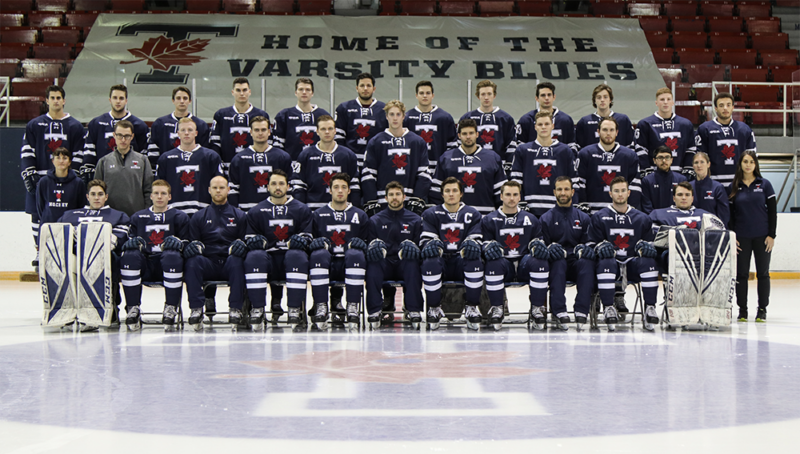
“I got the idea from the community. A lot of people and local shops have been donating supplies or meals to healthcare workers. I figured if I could make their day even 1% better, it would be worth it.”
Harvey also credits his friend and current Ottawa Senator, Chris Tierney, for the great idea.
“Chris donated a weeks’ worth of meals for nurses and I thought it was amazing.”
Jayne is just one of many healthcare heroes who continues to fight this pandemic and Harvey couldn’t be more proud of her.
“My mom is doing well and she just had her eighth negative test. It’s been hard on her not being able to come home every night and have the support from our family. My dad’s been great through this. He often will grab food from town and bring it to her for dinner. He’ll sit by his car and they’ll talk about the day and enjoy a meal together.”
The burning question in everyone’s mind is ‘what will you do when this is all over’? For Harvey, he’s excited to spend quality time with his family again.
“I know we are hoping to be able to go up to the cottage together at some point this summer. We just got it last fall so we’ve been chomping at the bit to get up there and utilize it.”
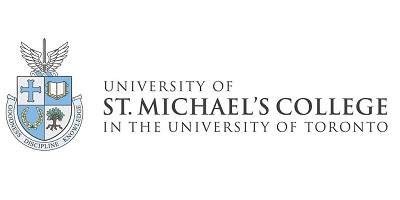
Convocation is a time not only for celebrating memories and friendships, but also the academic and extracurricular achievements of the graduating class. This year, almost 150 graduating St. Michael’s students received medals and named awards. Celebrate their accomplishments with us as the Class of 2020 enters the St. Michael’s alumni family.
Graduation Awards by Application
The Principal’s Medal Award
In conjunction with the family of the late Professor Lawrence E. Lynch, the Principal’s Medal was created in 1978 to recognize the almost lifelong association of Professor Lynch with St. Michael’s College, and also to mark his 25th wedding anniversary.
Professor Lynch served as the College Principal from July 1976-June 1981.
The medal is given annually to a graduate who has made a distinctive contribution to life at the college and who upheld the practice of Catholicism proper to a university community.
This year’s recipient of the Principal’s Medal is Rose Wang.
The Marina Santin Award
Sylvia and Raymon Santin, St. Mike’s alumni, established the Marina Santin award in honour of their late daughter. During her time as a St Mike’s Marina contributed significantly to the life of the College and to the University through her work as an Arts and Entertainment columnist for The Mike, staff photographer for The Newspaper, a Coordinator of the 1991 St. Michael’s Orientation, and by her presence at and support of College and University events and programmes.
The Marina Santin Award is presented annually to a female graduate who has distinguished herself by an active and constructive involvement in the life of the college. Recipients exemplify the Christian ideals of joyful engagement in life, openness to others, service to the community, and responsible leadership.
This year’s recipient of the Marina Santin Award is Sasha Hellwig.
The Sir Bertram Windle Graduate Scholarship
The Sir Bertram Windle C.A Graduate Scholarship is awarded to a student with an excellent academic record who will be entering a liberal arts graduate program at the University of Toronto in the September following graduation.
This year’s recipient of the Sir Bertram Windle Graduate Scholarship is Isabel Armiento.
The W.B. Dunphy Medal
The W.B. Dunphy Medal was created in 1991 to honour Professor William Dunphy, who served as College Principal from 1981-1991.
Principal Dunphy was particularly concerned that university life should not be separate from the life of the wider community.
The medal is awarded annually to a graduate who has been most successful in combining excellent academic achievement with sustained commitment to volunteer service in the wider community.
This year’s recipient of the W.B. Dunphy Medal is Zara Ahmad.
The Fr. Henry Carr, CSB Award
The Father Henry Carr, CSB Award, named in honour of a Basilian father who helped shape this institution and who served as president and superior at St. Michael’s from 1915 to 1925 is presented to a graduate who has made an outstanding contribution to the University of Toronto in athletics, academics, leadership, or student life.
The recipient of this year’s Father Henry Carr, CSB Award is Hodan Mohamud.
The Fr. Robert Madden, CSB Leadership Awards
Father Robert Madden was a much admired professor, chaplain and rector at St Mike’s who served as the director of alumni affairs in his retirement. The Father Robert Madden Leadership Awards are presented to students who have made significant contributions to the University of St. Michael’s College community by demonstrating leadership, cooperation, and solidarity in student-run organizations or community endeavours.
The recipients of this year’s Fr. Robert Madden, CSB Leadership Awards are:
Anna Zappone
James Pettem
Julia Orsini
Luke Bannon
Almeera Khalid
Vicente Constantino Kripka
Sabrina Daniele
The University of St. Michael’s College Young Alumni Award
The recipient of this year’s University of St. Michael’s College Young Alumni Award is Samuel Gearing.
Graduation Awards by Merit and Program
The Alberto and Caroline Morgan Di Giovanni – Centro Scuola Scholarships
Alberto Di Giovanni, 7T1 and his wife Caroline Morgan Di Giovanni, 7T0 have a long and close association with the University of St. Michael’s College. They met here as students and have stayed involved as alumni. Three of their children (Annamaria, Carlo and Franca) as well as nieces and nephews have followed in their footsteps and graduated from St Mike’s. Alberto and Caroline have endowed scholarships and an annual Dante lecture to demonstrate their appreciation for their experiences here and to encourage St Mike’s graduates to develop life-long connections with their alma mater.
Four Alberto and Caroline Morgan Di Giovanni Scholarships are awarded each year to St. Michael’s College students. Earlier this spring Di Giovanni scholarships were awarded to students participating in the Gilson Seminar in Faith and Ideas.
Today we are recognizing Alberto and Caroline Morgan Di Giovanni Scholarships for graduating students who have achieved the top marks in Italian Studies and have demonstrated leadership and community spirit on the St. Michael’s College campus; and in the community at large.
The recipients of this year’s Alberto and Caroline Morgan Di Giovanni – Centro Scuola Scholarships are Julia Volpe and David Adamiszyn.
The Tommaso Serrao Award
This award was established by the Family and Friends of Mr. Tommaso Serrao, who had a great love and passion for Italian literature.
The award is presented to an outstanding graduate who has excelled in the study of Italian.
The recipient of this year’s Tommaso Serrao Award is Janet Marta.
The Mercier-Knowlton Prize for Philosophy in Christianity & Culture
While studying at St Michael’s College, William Leo Knowlton, class of 1927, developed a deep love of philosophy that never left him.
In 1999, he made a generous donation to St Michael’s to establish an endowed lectureship in Philosophy and Theology.
This gift also enabled the College to re-institute the Mercier Prize, which had been established in 1924 in honour of Cardinal Mercier and his work relative to the philosophy of St Thomas Aquinas.
This award is given to the student with the highest CGPA in Philosophy and Christianity & Culture.
The recipient of this year’s Mercier-Knowlton Prize for Philosophy in Christianity & Culture is Sasha Hellwig.
The James O’Brien 5T0 Book Award
The James O’Brien Book Award was inspired by the memory of James O’Brien, St. Mike’s Class of 1950.
After graduating he remained an active alumnus of the College, serving on the USMC Senate for a number of years and on the Library Committee.
His family established this award to honour his love of literature and to celebrate their continuing association with St. Mike’s.
The recipient of this year’s James O’Brien 5T0 Book Award is Danielle Nassr.
College Gold Medals
The College Gold Medals are awarded to graduating students with the highest cumulative grade point average in Arts, Science, and Commerce.
The recipients of this year’s College Gold Medals are:
| Arts | Science | Commerce |
| Nathaniel Crocker | Laurestine Bradford | Anthony Adair |
College Silver Medals
College Silver Medals are awarded to all other graduating students who have a cumulative grade point average of at least 3.7.
The recipients of this year’s College Silver Medals are:
| Vinit Nirav Jogani
Julian A Takagi-Stewart Yufang Liu Zara Ahmad Gianni Vincent Pescetto Jijun Xiao Xiaowen Zhang Erica Alexis Venturo Haorui Zhang Heng Kan Kate Rose Jaworski Friesen Lazar Joksimovic Xinqi Shen Yuling Chen Zhuoran LI Shiqi Feng Yibin Zhao Sunsiya Wang Yu Guo Zeyang Zhang Christian John Tramontin Julia Francesca Volpe Shuting Jiang David Jan Adamiszyn Musa Talluzi Nicolas James Cicci Xueqian Ma Constantine Dean Gregory Kanargelidis Michael Sisti Jamie Evers Stalcup Shyam Mehta Xing Gao |
Christy Melody Simangon
Jiayi Shi Michelle Antoinette De Pol Timothy Chee Cheng Lui Zhengkai Fu Chenglan Huang Christian Michael Rostankovski David Frank Rhodes Ke Er Zhang Amelia Lois Leung Joseph Matthew Massabki Xin Yue Gao Katherine Schmidt Ming Yuan Zhao Nicole Joan Turner Yu Jia Yin Yue Li Alex Lee Du Wang Julia Passarelli Anna Aksenovich Daniel Kim Kuorosh Rezaei Ian Michael Cappellani Quanzhou Li Rebecca Kwiatkowski Yuxi Lin Ge Sun Janet Adele Marta Ankur Shiwakoti Chelsea Ann Marie Amos Gregor Neil McEdwards |
Junsheng Luo
Xinran Huang Marina Samantha Salis Robert Newman Yi Wai Kwok Angela Wang Oswa Shafei Tianna Alexandra Damario Sara Eslam Pour Lara-Melodie B V Patry Sayeda Fatima Zahidi Yara Haitham El Bardisi Hallam James Willis Isabel Marie Rose Armiento Jason Kei-On Ho Jong-Hwan Joseph Lee Min Jin Rishikant Sharma Jeremy Boon Chinsen Rhonda Michelle Rathburn Simon Alexander Craig-Wright Jiayi Lu John Alexander Muir Oriana Irene Maurach Theo Ziying Zhuo Andres Felipe Medina Pineda Tiancheng Shi Xiaoqi Gao Tianhao Wu Zihan Yi |
Andrew Selvam is currently the Acting Chaplaincy Teacher at St. Joseph CSS in Mississauga. He is also a science and religious studies teacher with the Dufferin-Peel Catholic District School Board. He is currently pursuing his Master of Religious Education degree at St. Michael’s Faculty of Theology. He enjoys music, hanging out with friends and family, and travelling.
A Language of Love, Unity, and Joy
The day was March 12; I remember it clearly. I had just finished with our chaplaincy team meeting in the library when a student asked me if it was true…that they would be closing schools for three weeks because of COVID-19. I immediately went to my computer to confirm what I hoped wasn’t true and, lo and behold, it was. We would be away from school for at least three weeks. Immediately the news cycle was flushed with what was becoming a worldwide pandemic and, as each given week passed, it seemed more and more likely that the school year would happen away from the school.
After March Break, it was a very slow waiting game. Retreats, social outreach programs, and student engagement activities would have to be put on hold. The way relational ministry would have to be delivered would look very much different. I had been reading all the emails from our school board offering all of the different platforms for learning, but I stood there for a moment and wondered “How do I connect with students?” From the beginning, it became a get-go of mine to make sure that, in as many ways as possible, I was going to make it feel as much as it could for students like we had never left. My first digital daily reflection went out on the feast day of the patron of our school, St. Joseph, more important than ever as the patron saint of families and the universal church. The Holy Spirit that I always felt travelling through a school would be called upon to help me figure out this new upper room. And that was just my motivation. I needed the Holy Spirit also to do the work of expanding this upper room, now neighbourhoods apart from each other and along a digital superhighway.
As each new day rolled out, each reflection and activity would focus more on refocusing our “new reality” into something positive, something to come alive through the Spirit. Meeting with students using videoconferencing applications made it as close to kids coming by the office as I could. Three-and-a-half months later, it has transformed into an opportunity for us to hear each other, talk about the struggles of the day, of the week and of the month, and offer support when needed. With the chaplaincy team back in full swing, I was ecstatic that, more than ever, kids were looking for ways to be engaged outside of the classroom. Each discussion we had and prayer we said felt like therapy for the mind and the soul, for the kids and for me.
But distance-learning causing frustrations wasn’t the only thing on the minds of staff and students. The number of deaths of relatives of staff and students was on the rise, and I asked the Spirit to just give me the right words to say when I picked up the phone to offer my condolences and support in any way that I could. It also became apparent that many of our families had parents unable to work, raising the possibility of not being able to put food on the table. The St. Vincent de Paul society helped us out, as did our generous staff, to provide food and gift cards for our neediest families.
I have to say I had my reservations. I did not know what distance chaplaincy would look, but it has been more than enlightening. It has shifted me out of my comfort zone in a way only the Holy Spirit can, and moved me to find energy reserves I did not think I had. We had just celebrated Easter at the beginning of this pandemic, and we know that we are an Easter people called, as Christ did, to work to make anew. More than anything, though, we have been called to be a Pentecost people—gathered together, filled with our blessed gifts, so that people outside our Upper Room can hear us speak in a language that they could understand—a language of love, unity, and joy.
Read other InsightOut posts.
Ask.smc@utoronto.ca offers a single point of access for student to find the help they need
From academic advising to assistance with financial aid, accessibility needs and career planning, the Office of the Registrar and Student Services provides essential help to students in all stages of their St. Mike’s journey. Although the physical office has been closed since mid-March in response to the COVID-19 pandemic, the Student Services team continues to provide timely, crucial support to St. Mike’s students online, and the team is optimizing its services for remote delivery this fall as well.
The effort on the part of the office to optimize online service delivery for St. Michael’s students in a matter of days “is truly something I have never witnessed before,” says St. Michael’s Registrar Giancarlo Mazzanti.
“Advisors have stepped up to deal with the very significant increase in student inquiries, while working at putting into a virtual format everything that students have come to expect of the Registrar’s Office and Student Services,” Mazzanti says. “The university has made a commitment to the continuation and expansion of Student Services to be certain that all students will have the advising and services that have become synonymous with the student-centered St. Michael’s approach.”
During this unique time, a single point of access has made it easier for students to find the help they need: ask.smc@utoronto.ca. Students can email this account to get in touch with an advisor directly, and to get connected with a variety of ongoing services.
Academic Advising is a primary focus of the office. During one-on-one sessions, advisors provide assistance with registration, course selection, program selection and scheduling. In addition, advisors can provide students with guidance regarding workloads relative to other aspect of their student life, and help provide clarity on options for financial aid, some of which are available directly through the University of Toronto.
Nicole LeBlanc MSW, RSW has been the Wellness Counsellor at St. Michael’s since the fall of 2016. All students and residents of St. Michael’s are welcome to set up an online half-hour counseling appointment with her by email: nicolem.leblanc@utoronto.ca. Other wellness resources can also be found through St. Michael’s Student Services under the Wellness Counsellor tab.
Dr. Andrea Graham and Julia Andrews are the Academic Success Learning Strategists at St. Michael’s, and they support students in all areas of learning and academic performance. Graham and Andrews are available to help students discover their best ways of learning, adapt to university expectations, increase their efficiency, identify and pursue their goals, improve their work, and get the most out of their academic learning experience. Appointments with each can be set up through ask.smc@utoronto.ca, and additional resources for academic success are available through University of Toronto Student Life.
Accessibility Services at the University of Toronto can help students with temporary and permanent accessibility needs receive necessary academic accommodations. St. Michael’s accessibility advisor can be reached through ask.smc@utoronto.ca, and more information about registering for services is available through University of Toronto Student Life.
It’s no secret that writing at the university level can be a challenge, especially for new students. That’s why the Writing Centre at St. Michael’s continues to offer one-on-one appointments for students looking for guidance on all aspects of the writing process, from researching and outlining to drafting and editing.
Support for students also includes help with the period that follows graduation. This is where St. Michael’s Career Educator Husna Arif comes in: she helps students with exploring career options, applications for grad school, upgrading job search skills, conducting mock interview, learning about employment opportunities, and making plans for after graduation. As with the Office of the Registrar’s other services, digital appointments with Husna can be set up through ask.smc@utoronto.ca.
As these services continue being offered digitally through the summer, Mazzanti says remote service is being optimized for the Fall term as well. “We have doubled the number of front-line advisors available to answer student inquiries as well as adding resource to the financial aid portfolio, in personnel and funds,” he says. Regular services offered during the Fall and Winter terms such as the Math and Computer Science Success Centres will be available remotely, too.
Many students will also be making their transition to university during this uncertain time, and the Office of the Registrar and Student Services team is already working hard to make the move as seamless as possible. “We have over 20 events planned over the summer to facilitate the student transition to university,” Mazzanti says, including “welcome events, course planning and selection and other events that will allow students to actively participate, collaborate and meet with our advising team.”
June 8, 2020
Dear members of the St. Michael’s community,
I trust this message finds you in good health and holding up in these uncertain times. The 2019/2020 academic year has ended like no other, and I have watched our community respond with grace, courage and resilience to the challenges created by the COVID-19 pandemic. Once again, St. Michael’s is showing that even in very difficult times, our strength and generosity marks us as an anchor of hope in our community.
Social media use of #allinthistogether has gathered traction as the world responds to COVID-19, but I am particularly struck by how, at St. Mike’s, we really are in this together. Together, our students, faculty, alumni, and staff have worked to respond to these unique times, enabling classes to continue while ensuring the safety and security of campus, and the community. Students have been particularly resilient, and they have shown great understanding and patience in the face of a dramatically upended school year. As I look forward not only to the coming academic year but also to the future of St. Mike’s, I am confident that the lessons learned in these challenging days will help strengthen this incredible place, a place with compassion and community at its very heart.
When it became clear in mid-March that we needed a drastic response to the looming health crisis, creative problem-solving swung into action across the University. Within days, faculty and staff began offering classes and advising remotely, and students rose to the challenge. Residence students were able to pack up and head home early. The library remained open online, even offering a town hall on research. With a dedicated skeleton staff on campus to ensure that our students who could not leave were safe and supported, colleagues began working remotely, and virtual meetings became the norm. For the first time in history even Collegium and Senate meetings moved online.
This period will forever be remembered as a time when the world faced challenges above and beyond the norm, and we offer our support to those who are suffering. For St. Mike’s, the pandemic has forced us to sacrifice some much-loved traditions. We had to cancel spring reunion on campus and move to online anniversary activities, and the Class of 2020 missed out on an in-person, on-site convocation. As always, however, our community has responded with energy and hope. Whether it’s our Student Life team working on a virtual orientation for the incoming class, staff in the Registrar’s office taking additional time and care to respond to new and returning students’ concerns, or one of our students arranging to donate thousands of masks to protect those still on campus, this community is motivated by a concern for others, and it has been deeply moving and inspiring to witness.
We were in the midst of our St. Mike’s 180 planning when the pandemic hit. The pause in this project has allowed us time to reflect on our efforts to date and has affirmed what we already knew, that it is the strength of this community that is helping us weather this difficult storm and gives us hope for the future. We remain focused on our plans for renewal and I look forward to restarting conversations with you all about who we want to be as an institution and how we plan to achieve that. Obviously, we are stepping into a very different world, but St. Mike’s is prepared and must take up the mantle of leadership and think of new ways to build hope for our university and society, through our academic and student life programs and through our alumni and community partnerships.
Looking ahead to the 2020-2021 academic year, much remains unknown and difficult decisions must be made in the face of ongoing uncertainty. The health and safety of our community continues to come first, as well as the ability to reopen and resume operations when we are able to do so safely. The university is also facing challenges with regard to reduced revenues, and must also ensure that it remains fiscally sustainable. In early April, we implemented a hiring freeze, along with temporary redeployments. More recently, faced with prolonged shutdowns of parts of our campus and operations the University has worked with the United Steelworkers so that employees in our Facilities and Services Department and Physical Plant Departments can self-identify if they are willing to take a temporary leave. Staff who are affected by this decision have already heard from us directly.
Despite the challenges we are facing as the result of the pandemic, we remain committed to our community and charting a path forward. We are doing everything we can to sustain our workforce and adapt as we move through this crisis. We have established an advisory group, focused on plans for the fall, and we will continue to follow advice from public health and government guidelines. The University of Toronto has recently announced a plan to support employees in working from home where possible until at least September. St. Michael’s is part of this collaborative effort to achieve a gradual and safe reopening of the city’s workplaces.
Fortunately, in addition to calling on the expertise of our in-house resources, we can also tap into the knowledge and best practices of organizations such as Universities Canada to help us continue to do what we do best as a centre of learning and faith committed to building the common good.
Our Collegium remains a strong sounding board and a source of advice, responding wisely and compassionately to the unique concerns raised by the pandemic. Last week, the USMC Senate discussed the impact of COVID-19 on our academic community. We head into the coming year in especially capable hands, with former St. Michael’s Principal Dr. Mark McGowan returning as Interim Principal, as Prof. Randy Boyagoda becomes Vice-Dean, Undergraduate in the Faculty of Arts & Science at U of T. As well, Dr. John McLaughlin will again serve as Interim Dean of the Faculty of Theology as Dean James Ginther returns to the classroom following a leave. We are also very fortunate to have continued great student leadership, and I have already begun to work with Cianna Choo and the newly-elected executive of SMCSU.
While there is still so much we do not know about the course of this pandemic, rest assured that we will continue to communicate via email, social media and our website, stmikes.utoronto.ca, with important information about the 2020-2021 academic year and how and when the campus will reopen. Yes, we are in extraordinarily challenging times, but we are truly all in this together, and with your help St. Michael’s serves as an anchor of hope, an engaged and compassionate community dedicated to serving the greater good.
I am proud to be a member of this remarkable community.
Gratefully,
David Sylvester, PhD
President and Vice-Chancellor
University of St. Michael’s College
Although a virtual ceremony took the place of an in-person Convocation at the conclusion of their university experience, members of the Class of 2020 look back fondly on their time at St. Mike’s, starting from the moment they first set foot on campus. “Every time I think about my time at St. Mike’s,” Michael Coleman (Honours Bachelor of Science: Physiology and Biochemistry double-major) says, “it really starts from the welcome I got” during Orientation Week.
Anna Zappone (Honours Bachelor of Arts: Environmental Geography major, Forest Conservation and English minors), a veteran of St. Michael’s orientations over several years, agrees. “It’s such an amazing week, no matter what goes wrong or whatever happens,” she says. “Everyone screams until they lose their voices – everything is just so extreme and it’s just so fun.”
The thrill of the week’s activities introduces new students to a community of care and support. Coleman remembers Orientation for the way “it makes you feel a part of something bigger, but not intimidating,” a quality he did his best to communicate to new students when serving as an orientation leader and residence don in later years. “Everyone’s your family,” he says. “It’s gotten better every year.”
Brennan Hall provides a setting for Paul Nunez’s (Bachelor of Arts: English major, Classical Civilization and Anthropology minors) memories of St. Michael’s. “I really love how’s there’s a community within the Coop,” he says, “very outgoing, encouraging strangers to join in the fun.” Though he often spent late nights there hitting the books alongside his classmates, “we don’t usually talk about what we’re studying.” The camaraderie grew irrespective of programs or disciplines.
Joseph Rossi (Honours Bachelor of Arts: International Relations major, History and Political Science minors) remembers this feeling of camaraderie in Brennan, and across campus generally at “move-in days, Dean’s cup events, and great conversations in the residence or in the Coop.”
“The college system is great at UofT, and I think it’s an important experience,” Rossi says. While students benefit from the larger University of Toronto setting, St. Michael’s provides community and support on a smaller scale, something that students often mention as being uniquely valuable. “I think that St. Mike’s is where I found my support network,” says Michelle De Pol (Honours Bachelor of Science: Neuroscience specialist, Physiology minor). “I will remember the support that I felt from other students at St. Mike’s most.”
Julia Orsini (Honours Bachelor of Arts: Political Science major, English and Italian Culture and Communication minors) comes from a long line of St. Michael’s grads, setting her memories of community on campus alongside those of her family. “It’s true what they say, St. Mike’s is a very tight knit community,” she says, mentioning the Office of the Registrar and Student Services as giving her essential support throughout her undergraduate experience. “They were really there to listen and hear what was going on, not only in my academics but in life,” she says. “They want to see you succeed.”
Family is, of course, the word that keeps coming up in reference to the St. Michael’s community—and that family only continues to grow. “I met my best friends here,” Kate Friesen (Honours Bachelor of Science: Immunology major, Physiology and Biology minors) says. “Living in residence, we would go out—like half the floor would come to McDonald’s to get a coffee at 1 a.m. to keep studying.”
Echoing several of her classmates, Friesen says the most memorable thing for her about St. Michael’s is “how welcoming everyone was, and how supportive the whole community was, and how fantastic the people were.”
We asked members of the Class of 2020 if they had messages for their classmates. Here’s what they said.
“Community” is one of the words that comes up most often when graduating students talk about what made their St. Michael’s experience special. While their university experiences were not always easy, several members of the Class of 2020 found that the St. Michael’s community was there for them when they needed it most.
“I struggled in first year,” Kate Friesen (Honours Bachelor of Science: Immunology major, Physiology and Biology minors) says. “I was going to transfer home—I transferred all my credits.” What ultimately convinced her to stay? Conversations with older students in the Canada Room, who encouraged her that things would get better if she stuck it out. At St. Mike’s, she says, she found “people who are going to push you further.”
Friesen found community at St. Michael’s near the beginning of her student experience, meeting people who would become her best friends in residence and at Orientation. An orientation coordinator her first year who “was just so welcoming” stayed in touch with her and even recently provided her with a reference. Because of the support Friesen received at St. Mike’s, she stuck it out at the University of Toronto—and now is preparing to take on a PhD placement in Oncology at Oxford University. “I feel I’ve grown leaps and bounds from where I was when I came in,” she says, “and I wouldn’t have grown this much if I’d stayed at home.”
“St. Mike’s is such a wonderful community, it’s so diverse, it’s so warm and welcoming,” Friesen’s classmate Anna Zappone (Honours Bachelor of Arts: Environmental Geography major, Forest Conservation and English minors) says. She finds the college’s sense of community unique at the University of Toronto. “Everybody is always together, always doing things, always so eager to give back to our little community.” Involved in Orientation, student government, and even Collegium during her four years at St. Mike’s, she spent much of her student career giving back to the community in just this way, and was recognized for her contributions this year with a University of Toronto Student Leadership Award.
Joseph Rossi (Honours Bachelor of Arts: International Relations major, History and Political Science minors) didn’t realize how much the diversity of the St. Mike’s student body would shape his experience—but that diversity would become one of the things he valued the most about his time in the school’s community. “Learning about different religions, cultures – it shapes your own perspective,” he says. “When you listen to someone and have a conversation, you grow as a person, and as an intellectual.”
“The older colleges are so rich in tradition, and I think there’s something to be said about that – it gives a community and a heritage aspect to it,” he continues. Michael Coleman (Honours Bachelor of Science: Physiology and Biochemistry double-major) agrees: “St. Mike’s is probably the most proud college to display its history,” from historical photos on display dating back to its founding to the many fireplaces that can be found all over campus. “Pretty much everywhere you go, St. Mike’s is just brimming with history,” he says.
As a student in residence all four years, including two as a residence don, Coleman took a special pleasure in introducing parents of students to this history while helping their children move into their rooms during Move-In Day. Welcoming students to campus is, in part, helping them come to see this history as belonging to them, as well.
“I associate St. Mike’s primarily with community engagement,” says Paul Nunez (Bachelor of Arts: English major, Classical Civilization and Anthropology minors), founder of the SMC Wellness Club and a fellow winner of a University of Toronto Student Leadership Award. Nunez’s experiences of community at St. Mike’s are primarily set in the Coop, a hub for both students in residence and commuter students alike. For him, the most memorable parts of life at St. Mike’s “are the nights in Brennan Hall when I would stay till closing at 11 p.m. studying,” he says. One or two other students would almost always be doing the same, creating a special late-night camaraderie.
Ultimately, what Nunez and other students came to feel about St. Michael’s during their time as students is summarized well by their classmate Michelle De Pol (Honours Bachelor of Science: Neuroscience specialist, Physiology minor): “Coming onto St. Mike’s campus, I always felt like I was coming home.” Coordinator for SMC Mentorship and also a U of T Student Leadership Award winner, De Pol continues: “I find that that kind of student community is unique at U of T, and it was definitely a cornerstone to my success throughout university.”
The following remarks were included in a program delivered to members of the graduating class as part of their virtual Convocation.
On behalf of Principal Boyagoda, and all of our colleagues at the University of St. Michael’s College, I offer congratulations on completing your undergraduate studies at the University of Toronto.
The historically rich university ceremony of convocation is meant to provide the opportunity to celebrate your academic accomplishments and to acknowledge publicly those who have supported you. Well done, and congratulations also to your family, friends and the professors and many others who have helped you complete this important chapter in your educational and personal journey.
This year, however, you and your classmates, in fact all of us, have been also called to reflect upon the extraordinary events we find ourselves facing, individually and as a society. The circumstances surrounding your convocation are like no other. We recognize that it has been a challenging way to end this year. It is not only the shift to remote learning, and the distancing from good friends at this time of celebration: for many, the events of the last few months have added real economic and personal strain to the usual challenges one would expect to face as program completion deadlines approached. So, please know that we acknowledge that in addition to the academic focus and discipline you have demonstrated in this last semester of your studies that you have been asked to find within yourselves the patience, flexibility and strength to face these new challenges.
Thank you for the grace and resilience you have demonstrated in this challenging time. You, and the class of 2020, will be remembered in a unique way in the long and rich history of St. Michael’s.
Congratulations again. Be well, and God bless you and yours.

David Sylvester, PhD
President and Vice-Chancellor
The University of St. Michael’s College
Sheril Hook, chief librarian at the John M. Kelly Library, tells the story of a University of Toronto professor calling her recently for help. The professor simply couldn’t find the materials he was searching for—Syriac-Latin text editions for the Patrologia Orientalis series, as well as articles from Analecta Bollandiana. With just a little digging, she found them, digitized from the Pontifical Institute for Mediaeval Studies (PIMS) collection, which is housed at Kelly.
“U of T is one of the top research libraries in North America. I was confident I could find the materials,” Hook says.
A library can be hard enough for an expert to navigate, so asking students to find resources remotely during physical distancing can be a challenge for those already stressed over papers, exams, and an uncertain summer.
In response, Hook and Noel McFerran, Kelly’s Theology and Rare Books librarian, are hosting a virtual town hall on Wednesday, May 6 for students in the basic and advanced degree programs at the Faculty of Theology. The afternoon session is perfect timing for theology students enrolled in intersession courses. Eligible students have received an email with instruction on how to access the online gathering, and it will be recorded for anyone who cannot make the 3-4 p.m. time slot.
The librarians have three goals for the hour-long session, which will include a 15-minute presentation, as well as time for questions posted to the forum. First, they want to do a close look with students at the U of T catalogue, delving into some of the more advanced ways to search it to discover digitized materials.
“We’d like to show people how to find materials they didn’t anticipate being online,” Hook says.
Then, they will highlight materials that have been made temporarily available to students. While in this period of physical distancing due to COVID-19, for example, students can call on the HathiTrust Emergency Temporary Access Service.
The third thing McFerran wants to stress is that the Kelly librarians are constantly discovering new materials.
“Send us an email and ask us about availability,” he says. “Just last week I had to say ‘sorry, it’s not available’ to a request, but this week that material has been digitized, so I was able to help the student after all.”
“This is a great new opportunity for learning,” says Hook, who notes that Kelly Library plans to expand sessions in the fall semester to include undergraduate students as well. “It’s important to feel comfortable in asking for help. If you can’t find something, we will look for you, as we very likely have it.”
Move-out weekend traditionally sees the mass exodus of 550 residence students moving into apartments, heading to the airport, or being picked up by mom and dad. It’s a day of frenetic activity that includes tearful goodbyes, warm hugs of welcome and long line-ups of cars on St. Mary and St. Joseph streets.
This year however, the mass exodus took place in mid-March after the prime minister announced that everyone who could go home, should go home. By the time late April rolled around, the SMC Residence only had about 90 students left, mainly from countries where international travel was either restricted or financially prohibitive. So what’s happening with these student now?
“St. Mike’s is committed to housing students through the summer who don’t have anywhere else to go,” says Dean of Students Duane Rendle, “including students who weren’t previously living here, but who now find themselves without options.” Some of the students who took advantage of Dean Rendle’s offer included about a dozen women from Loretto College.
The Loretto College Residence is located just across the street from St. Mike’s and provides accommodation to 120 women during the academic year. Although Loretto is an independent college with their own staff and governance structure, their Catholic identity and proximity to St. Mike’s have earned them the moniker of “SMC’s sister College.” In mid-April, St. Mike’s agreed to provide housing for any Loretto students who were unable to return home, which has in turn allowed Loretto to close down for the summer. “It just didn’t make sense for Loretto to keep their entire building open to house such a small number of students. We were more than happy to have them to join us here at St. Mike’s,” explains Dean Rendle.
The small community of summer students who remain are being housed in either Sorbara Hall or the Historic Houses. All rooms in Sorbara have their own sink, which cuts down on the need to share common facilities, and the Historic Houses already have small populations, which helps to maintain social distancing. Chartwells, the College’s food service provider, is still providing food service to students, albeit in a takeaway form. Residents can purchase a “Dine on Campus” plan consisting of either 50 or 100 meals depending on their length of stay.
If you are a St. Mike’s student with a precarious housing situation, email smc.residence@utoronto.ca for more information on summer rates and availability.
Ann Mathew graduated from St. Michael’s College, University of Toronto, in 2019 with a double major in English and Christianity & Culture. While an undergraduate, she served as an editor on Saeculum, the student peer-reviewed journal associated with the Christianity & Culture program. She has just completed her first year of the three-year Master of Divinity program at the Faculty of Theology. A member of the Faculty’s Student Life Committee, she also sits on one of the subcommittees preparing for the coming visit by the Association of Theological Schools, the Faculty’s accrediting body.
Adjusting to the New Normal
Writing this draft in the glory of the Risen Lord, I am also thrilled to have completed my first year of the Master of Divinity program at the Faculty of Theology at St. Michael’s College. Although this global situation of the COVID-19 pandemic has deeply affected all of our lives, taking a special toll on the state of classrooms, the fact that I had enrolled in a couple of introductory online courses at the Faculty meant I was quite prepared for the virtual classroom setting. That being said, this shift in one’s surroundings was indeed surprising.
Being a commuter student, this change was admittedly rather welcome. To avoid rush hours and wind chills between home and campus for the second half of the Winter semester was an unexpected blessing in the present circumstances. The faculty and administration were rather prompt in addressing us about the changes that were about to take place. In light of the various final papers and deadlines, I recall the commute to campus to hoard up on library books before the closure. While many online resources have been made accessible to us by the university, there were still a few books that I needed to check out. My transit experience on March 16th was interesting, insofar as that, during what would have been an otherwise crowded morning commute, the TTC subways ran almost barren to the bones. Strategically planning my time between the Emmanuel College and John. M. Kelly libraries, I managed to bring home some 12 books. The ride home was eerie in that many at Union Station were homebound—luggage and neck pillow-clad, with no return date in sight.
The remaining four weeks of classes flew by and we all seemed to adjust to our Zoom meetings, despite technical difficulties with Internet crashes at home, screen shares and background noises. Given the limited access to research materials, my professors graciously agreed to deadline extensions, along with concessions to primary sources. Throughout my undergraduate years, the Kelly Library gave witness to my eremitic lifestyle as each semester concluded. This time, however, my family got to experience my two weeks as a recluse. Truth be told, I rose with Christ on Easter Sunday as I submitted my final research paper.
The whole world has more or less been brought to a halt. Each one of us plays a crucial part in maintaining normalcy, and the community at St. Mike’s has helped me adjust to this new normal, especially during the most stressful time of the semester. Currently, I am awaiting the commencement of online courses in the summer. Until then, I am passing time by engaging in some leisure reading, creative writing, family prayer, card games and such. As Archbishop Cardinal Collins often mentions in his daily homilies, let us continue to demonstrate our “love for our neighbour” in these days of keeping to our homes. May we find inspiration in the most trivial of things, all the while getting a step closer in knowing ourselves and emerge out of this phase as finer human beings.
Read other InsightOut posts.
Although the COVID-19 pandemic drew life on campus to an early close, St. Michael’s students continued to enrich the community with their talents and service as their coursework and extra-curricular activities transitioned to online platforms.
This year’s Student Life Leadership Awards recognize the outstanding extra-curricular contributions to the University and the St. Michael’s community as a whole during a particularly challenging time.
New awards recognizing Service in Student Mental and Physical Wellbeing, Leadership in Community and Cultural Development, and Outstanding Contributions to Social Justice Initiatives were introduced in 2020 to highlight areas of distinct interest to St. Michael’s students, staff and faculty.
Several awards recognize creative initiatives that are a vibrant part of campus life, including student publications and the arts. “The theatre is a space for people of all different experiences and backgrounds to come together and work to create something beautiful,” says third-year student Emily Villani. As Artistic Director for SMC Troubadours, Villani oversaw and performed in theatrical productions, including a recent production of Guys and Dolls.
Other awards recognize the work of students to foster inclusion, social justice, and a deep sense of welcome. A major goal for Sonakshi Sharma, a third-year student and Executive member of the Indian Students’ Society at U of T, is to help international students find more familiar and comfortable spaces in campus community—especially in the area of cultural representation. “I believe building such a community is important for students in order to have a comprehensive university experience,” says Sharma.
Athletics, a longstanding area of achievement and an important part of the education of the whole person at St. Michael’s, is another area in which students are being recognized for leadership and service to their peers. “Intramurals are an incredible foundation for a social and athletic life on campus!” says Mika Embury, fourth-year student and recipient of the Mary H. Lee Award for Leadership in Women’s Sports.
Student Life Associate Emma Graham describes the recipients as “leaders who actively encourage their peers to get involved, follow their dreams, and build up others.” Their influence has helped other students at the college become active participants in community life outside the classroom. Each award is peer-nominated, which means that each recipient is being recognized not only by the College, but by fellow students who benefited from their service.
The full list of the 2020 Student Life Leadership Awards can be found below, with more details available on Facebook.
- Award for Leadership in the Arts: Emily Villani
- Award for Leadership in Community and Cultural Development: Sonakshi Sharma
- Award for Outstanding Contribution to Social Justice Initiatives: Adam Da Costa Gomes
- Award for Excellence in Peer Mentorship: Sam Gruppuso
- Award for Outstanding Exhibition of College Spirit and Pride: Simran Dhir
- Award for Service in Student Mental and Physical Wellbeing: Christeen Salik
- Award for Leadership in Student Publications: Ian Hauber
- Award for Male Athlete of the Year: Victor Wakelin
- Sr. Kathleen Heffron Award for Female Athlete of the Year: Elaine Pityn
- Mary H. Lee Award for Leadership in Women’s Sports: Mika Embury
- Kevin Fawcett Award for Freshman Athlete of the Year: Eloïse Alarie
With a new name, award, and enhanced value, St. Michael’s longstanding program in Corporate Social Responsibility entered a new phase last fall. The changes came not long before COVID-19 would create a context in which working for the common good — a signature emphasis of the program — would take on a new meaning.
“The Corporate Social Responsibility program is a vital offering at the University of St. Michael’s College, helping business and institutions focus on ways to become better — and more effective — global citizens, whether environmentally, socially, or economically,” says St. Michael’s President David Sylvester.
While today’s global citizens uphold the common good by practising social distancing to slow the spread of COVID-19, the changes wrought by the virus will create new context and opportunities for creating social impact in a post-pandemic world. Graduates of the St. Michael’s diploma program will be among the first to imagine new possibilities for our life together when social distancing is no longer required.
The CSR program is featured in the latest issue of St. Michael’s Alumni magazine, and reproduced below.
A Season of Transformation for St. Mike’s CSR Program
Updated name, new award, enhanced value all signs of program’s coming of age
No matter what stage of life you’re at, icebreakers can help the first day of school seem a little less daunting. But when the school is St. Mike’s, and the subject is corporate social responsibility, you can forget about standard tension diffusers like ‘tell two truths and one lie about yourself’ or pinning your birthplace on a giant map.
As participants in the 2019/2020 Graduate Diploma in Social Responsibility and Sustainability cohort met for the first time this past October, students were asked to chat with a seatmate and then present that person to the group by naming their core values. As the introductions circled Charbonnel Lounge, words like honesty, gratitude, compassion, respect, integrity and humour surfaced, indicators that this is not just any classroom.
For close to 20 years, University of St. Michael’s College has been the go-to school in Canada to study Corporate Social Responsibility, an operational philosophy also known by a variety of other labels, including ESG (Environmental, Social, and Governance), Corporate Citizenship, or Social Purpose and Social Innovation.
The common thread is an institution’s commitment to action that enhances the common good by adopting strategies such as environmentally friendly processes, fair labour practices, or corporate volunteer efforts. Proponents of CSR argue that a strong strategy can have multiple benefits, from answering shareholder concerns and aligning with a board’s ethics through to self-preservation and furthering employees’ sense of participation in something valuable, all factors that can contribute to a stronger bottom line.
“Corporate Social Responsibility is not just a set of [business] tools but a new outlook,” Program Manager Kathryn Cooper explains. “CSR helps you look at people in a more human way and, as such, it is transformational.
“When we talk about Corporate Social Responsibility or Citizenship, we talk about social and environmental impact. Today investors, consumers and global citizens want to know that organizations are not causing social or environmental damage. In fact, there is an expectation that companies are making a positive contribution to society and the planet.”
As an example, she cites athletics apparel giant Nike as a cautionary tale. When negative media reports on its international labour practices surfaced in 1996, stock value fell by 50% from $38 to $19 per share, while sales dropped almost 10%.
It is precisely the goal of positive change that makes St. Mike’s a logical host for the program, says University President David Sylvester, because the program’s goals and outcomes represent the long-standing values of St. Michael’s. There is a clear correlation, for example, between the topics studied in the program and the tenets of Catholic Social Teaching, whether the issue is environmental stewardship, concern for the marginalized or a driving interest in the common good, he explains.
As it approaches its third decade of operation, the St. Mike’s program is undergoing its own transformation, a sign of a coming of age not only of the program but also for the concept itself.
This past Fall, the program name of Corporate Social Responsibility was changed to the Graduate Diploma in Social Responsibility and Sustainability. Corporate no longer appears in the program name because the core concepts’ appeal reaches far beyond the business world. While the idea began with financial institutions, it is now being embraced by a variety of sectors, including health care, education, NGOs, and not-for-profit organizations, notes Cooper. Recent graduates from the St. Michael’s program have come from a diverse group of employers, including Toronto Hydro, Manulife Financial, the University of Calgary, and UNICEF.
“The idea of social responsibility used to be viewed as a public relations issue or the way to earn a ‘social licence to operate’, but it’s got far wider applications,” she says.
Sustainability has been added to the program’s name “in response to a global trend toward embedding environmental, social and governance issues in business,” Cooper adds. “To survive and thrive, organizations must focus beyond their bottom line, and create positive social impact.
“We make a lot of personal connections between values and ethics and urge people to take their whole selves to work.”
The name change also signals the program’s upgrade from a certificate to a diploma. Graduates of the 2018/2019 cohort were the first to receive diplomas at their November convocation, and are eligible to use the post-nominal letters G.Dipl.SR&S. The upgrade is a result of the increasingly academic nature of the program, says Dr. Sylvester, who notes that when the motion to change the program to a diploma was put before St. Michael’s Senate, it was unanimously approved.
The changes to the CSR program come as St. Mike’s engages in its own strategic visioning exercise, notes Dr. Sylvester. St. Mike’s 180, Rooted in the Future seeks input from community members, asking how St. Mike’s can create a dynamic and abundant future as the school looks to its 180th anniversary in 2032.
St. Mike’s, like many other Canadian post-secondary institutions, is beginning to think more about the social impact of universities, and is looking to imbed related language and goals, examining everything from purchasing and infrastructure to examining a school’s relevance and how it engages with the community, he adds.
“We want to turn research and teaching on the community as a vibrant force, because universities must be engaged in the community to have relevance,” Dr. Sylvester says.
The Social Responsibility and Sustainability program at St. Mike’s runs over 13 months, and consists of three sets of in-class sessions throughout that period, for a total of 11 days on campus. In between the three on-campus sessions, participants engage in reading assignments, participate in webinars, post reflections, meet with mentors who provide advice and guidance on a capstone project, and stay in touch as a cohort through a special web portal. As each cohort is capped at 30 students, both participants and instructors get to know each other well, with plenty of time for discussion.
On-campus sessions include workshops on everything from making the business case for social and environmental responsibility to how to apply CSR and sustainability strategies in the workplace through the development and implementation of diversity and inclusion, community investment, ethics and reporting and communication policies and procedures.
The program draws three types of participants, Cooper notes. Some are tapped on the shoulder by employers wanting participants to develop their company’s CSR or Sustainability Strategy. Others are looking for a purpose-focused mid-career transition, while a third group consists of younger people who have graduated with theoretical knowledge about sustainability and CSR but are looking to learn from mentors and program participants with practical experience.
Participants have two major assignments, as well as a capstone project where they work with a seasoned CSR and sustainability mentor to undertake a practical social responsibility and sustainability project. Students identify their project’s outcomes and methodology, as well as how to socialize the plan with key stakeholders, she explains.
Past projects have included Community Investment Strategies, Volunteer Programs, Environmental Sustainability Initiatives, Indigenous Impact and Sustainability Reports and CSR/Sustainability Strategies.
The ability to connect with experts, as well as to meet others in similar fields grappling with similar questions, is one of the big draws for the program, graduates note.
“It’s a top-notch program, the only one of its kind in Canada connecting like-minded people with similar passions in Corporate Social Responsibility,” says Alexandra Biron, who is Assistant Manager, Corporate Responsibility at professional services firm Deloitte in Toronto. She looked at online offerings from other schools but was drawn to St. Mike’s both because of the in-person sessions, as well as what she heard from former students.
“You can find a lot of information online but the network of professors and speakers is what’s most valuable. You are a cohort with a diverse group in terms of age, sector, experience, background, and even with those who might not come from a CSR background but are looking to change fields,” Biron explains. “These people share their struggles and high points, especially as so much can happen in 13 months. These are people with similar values and passions in a variety of jobs.”
Biron was one of the two winners of the inaugural President’s Capstone Award this past Fall for her project, entitled Deloitte Canada 2019 Indigenous Impact Report, which examined the impact [Deloitte has] made with Indigenous communities through pro bono work, volunteering, donations, sponsorships or serving as directors on boards.
“This report was the first of its kind for the firm. We publish an annual CR report but this was the first time we looked at the impact we were having with Indigenous communities. It’s led to an even bigger project, which is the firm’s Reconciliation Action Plan, which is set to launch in 2020 and will set the stage for how Deloitte will move forward on implementing TRC recommendations into its corporate life.”
Like Biron, Sarah Thirnbeck credits the program with offering her the skills to lead change in her workplace. Thirnbeck, who is Associate Director of Strategic Impact for the Canadian Real Estate Association in Ottawa, says of the program, “It changed my life.”
When moved from handling social media into her current duties this past Fall, Thirnbeck sought a program to help her create a vision for her new role.
While seeking resources online, she found mention of the St. Mike’s program “and it fulfilled all my expectations. I arrived on Day 1 knowing I wanted to develop a CSR strategy for my organization but I became like a sponge, soaking up information.”
Thirnbeck was the other winner of 2019 President’s Capstone award. Her project was titled “A CSR Strategy for the Canadian Real Estate Association.” It has already had an impact, as the Board of Directors of CREA agreed to include ethics, sustainability and social impact as a new priority in its strategic plan, based on her recommendation.
Now, she will begin implementing ideas from her project, including a green strategy, in her own office, with an eye to rolling them out to various local boards and offices across the country.
Program graduate Robert Waite now serves as a CSR mentor, working with and inspiring other students. Waite found himself in the program in 2008 while working at Canada Post, after he was asked to lead the effort of Crown Corporations in the area of environmental stewardship. Deciding he wanted an academic understanding of the program, he chose St. Mike’s because “I liked the structure. …It was more humanistic and less technical, with more emphasis on the soft skills. The program gave me the tools I needed,” says Waite, who went on to produce the first CSR report of any Crown Corporation, and hosted a meeting of various Crown Corporations to share best practices.
Waite, who now teaches at Seneca College and does consulting, says he decided on the St. Mike’s program for several reasons, including the fact that the small program, on a small campus within the enormous University of Toronto campus, had an intimacy to it.
The very nature of a liberal arts college is another, he adds.
“Climate change, for example, can be positioned as a moral issue, a philosophical one,” he says.
A few years after graduating, he was invited by a United Nations official to lecture on CSR to a group of postal agencies from 10 Caribbean countries.
“The materials I used were materials I gathered from St. Mike’s. It was a great feeling, as many participants’ countries were small and didn’t have the resources to take on issues like environmental stewardship. My ability to say yes can be tracked to my participation in the program. I have nothing but praise for the people who run the program.”
One of the influences he cites is Dr. Mimi Marrocco, who started the program in 2002, when she ran St. Mike’s continuing education program. In chatting with various stakeholders, it became clear to Dr. Marrocco that “the liberal arts had something to contribute to business, including creating the time to think,” she recalls. “Liberal arts allows for reflection.
“Sometimes, work environments can become siloed, but this program creates a forum to talk to like-minded people, and it presents the opportunity to make connections inside and outside.”
One of Dr. Marrocco’s first ideas for the program was to introduce a novel study to allow people to use their right brain, the hemisphere associated with creativity and innovation.
The first year, participants read E.M. Forster’s Howards End, which bears the epigraph Only Connect, a message she says underlines the program.
“We need slow knowledge, slow movements. We are busy people in business and
sometimes we fall into busyness, which doesn’t allow us to use the whole person.”
New grad Alexandra Biron agrees.
The program “provided me with a platform to combine my professional life and one of my passions…. My career may not have progressed the way it did so quickly without this experience.”
By Catherine Mulroney
From St. Michael’s Magazine: Winter 2020
For the students in Dr. Paolo Granata’s Media Ethics class at the University of St. Michael’s College, the theoretical suddenly — and urgently — became reality with the introduction of the COVID-19 social distancing guidelines.
“We were just discussing digital inclusion when self-isolation guidelines arose and students suddenly had a real-life experience of seeing how important digital inclusion really is,” explains Dr. Granata.
Digital inclusion, and its companion term, digital inequality, refer to the importance of fair access to both the tools and the data needed to participate in the digital world. In 2011, the United Nations’ Human Rights Council declared the Internet to be integral to human rights, and recommended that Internet access should be a priority for all.
The effects of the current pandemic bear this out, Dr. Granata says, with people needing access to the Internet not only to telecommute and take e-classes but also to do things like pay bills, order groceries and stay in touch with others to reduce isolation.
“Nobody should be left behind,” the professor says.
But everything from income levels to location can have an impact on how people are able to connect. Low-income families, for example, may not have a computer at home for children to do e-learning from home while people living outside of urban centres may have limited access to high-speed Internet, if they have access at all. In turn, working and learning from home can result in soaring data charges.
The closure of institutions due to coronavirus limits access to tools like loaner laptops from schools or banks of computers at libraries, Dr. Granata notes, while shuttered coffee shops and institutional sites means fewer Wi-fi hotspots, where users can find access without having to pay.
Even for those with technology at home, the various platforms now being called on for online learning and e-meetings requires updated software, and that can sideline even those with relatively new computers.
This new reality prompted Dr. Granata to work with his Media Ethics students, research assistants Simon Digby and Alexandra Katz, and the Media Ethics Lab at the University of Toronto to create a call to action on the topic of digital inequality. Titled #DigitalCloseness, the statement spells out how the private sector, various civic organizations, and private citizens all have a role to play both today as well as in the long term to ensure Internet access is available to all.

#DigitalCloseness suggests telecom companies, for example, forgive late payments and keep customers connected at this time, while it suggests community organizations and not-for-profit groups can offer access to free courses and virtual tours of exhibits.
In turn, private citizens with unlimited data are urged to share with a neighbour, to lend an extra device to someone who has no access, or to begin to build a virtual community to check in on others.
Going forward, Dr. Granata says, the conversation must continue with a variety of stakeholders to ensure there are ethical standards in the digital world to protect and further the common good.
There are conversations to be had, for example, in the subject of media literacy so that people do not fall prey to false or misleading information on social media, he says.
“We also need to urge legacy media to choose their words carefully for example, so that they avoid sensationalism by falling back on terms like ‘the battle’ or ‘the war’ on coronavirus,” he says.
Conversations about connectivity must also be mindful of who the most vulnerable are in our communities and work to include them.
For the students of the Winter 2020 session of Media Ethics, COVID-19 taught an invaluable lesson, Dr. Granata says.
“People often think that online and real life are two different things. They’re not, and this crisis has demonstrated it,” says, adding that it’s time for the broader population to become familiar with a term coined by Oxford Professor Luciano Floridi: “onlife.”
Seven members of the Class of 2020 have received Student Leadership Awards from the University of Toronto for their outstanding extra-curricular contributions to the College and the university as a whole. Over their university careers, these students have organized St. Michael’s Orientation, served as dons and mentors, edited journals, founded clubs, coached intramural teams, held Student Government positions, and much more.
St. Michael’s congratulates:
Michelle De Pol – coordinated the St. Michael’s Mentorship Program, served in several leadership roles for St. Michael’s Orientation, and was Co-Founder and President of Cards for Humanity, a club serving homeless youth.
Samuel Vincent Gearing – very active in Student Life as a Residence Don and Campus Ministry Student Leader, and served as Vice President, Religious and Community Affairs for the St. Michael’s College Student Union.
Bridget Carroll Hager – Editor of Garm Lu, a Celtic Studies journal, and was also a Commuter Don.
Robin Martin – Vice President and then President of the Women and Gender Studies Student Union, Crisis Analyst and then Specialized Agency Director for UofT’s Model United Nations conferences, and served in multiple leadership roles for St. Michael’s Orientation.
Charlie Mitchell – Residence Don for three years, a St. Mike’s Intramural Basketball Coach, and the President of the American Culture Club.
Paul Nunez – founded and served as President of St. Mike’s Wellness Club, and was also a St. Michael’s Orientation Marshal.
Anna Zappone – coordinated St. Michael’s Orientation in 2019 after supporting the event in other leadership roles in prior years; she also served as Vice President, Communications for the St. Michael’s College Student Union.
Established in 1994 by the University of Toronto Alumni Association (UTAA) and the Division of University Advancement, the University of Toronto Student Leadership Awards (formerly the Gordon Cressy Student Leadership Awards) recognize students who have made outstanding extra-curricular contributions to their college, faculty or school, or to the university as a whole.
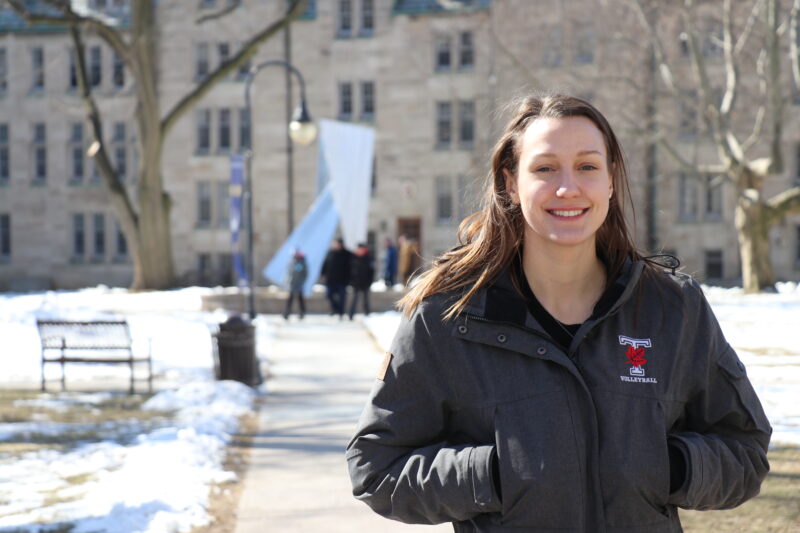
Even by UofT’s challenging standards, Anna Licht is busy. The Varsity Blues women’s volleyball team captain turns up for practice five days a week throughout the long season, which stretches from October to mid-March. A three-time OUA East all-star, she is a top performer in weekend games against elite opponents. Add to this a full class schedule including complicated laboratory work in cell biology, and it becomes difficult to imagine how the 5th-year Health and Disease specialist, Environment and Health major, and Physiology minor manages it all – but she does.
Her secret? The same thing that makes her so well suited to the middle blocker position on the Blues team: finesse.
Volleyball, Licht says, “is so different from other sports. It’s not a full physical exertion; it’s more that super fine control while you’re fully exerting yourself.” Controlled power is the name of the game, and as a middle and a student studying medical science both, Licht has found it essential to her success both on and off the court.
Licht made the decision to come to UofT after being recruited by a Blues coach who refereed one of her high school games. Staying in Toronto kept her close to her parents and brothers, an important factor for a family that had moved internationally multiple times during her childhood before settling permanently in Toronto in 2006.

Once the choice to come to UofT was made, the decision to choose St. Michael’s naturally followed. Licht’s older brother Johann had played for the Blues men’s volleyball team while himself a student at St. Michael’s. An accomplished organist, he even plays the organ for the TV Mass program that was filmed on campus at St. Basil’s Collegiate Church while he was a student.
Licht decided to live in residence at St. Michael’s after hearing that many varsity athletes found a special community outside of practice and competition there. “The friendships I built that first year [in residence] are some of the strongest I have through university to this day,” she says, mentioning her first-year don in Sorbara Hall as someone who left an important impression on her. The balance of community at St. Mike’s and on the Varsity Blues team “was huge, and made my first year extremely enjoyable.”
It was also an exciting first year for her on the UofT squad: during the 2015-2016 season the Blues team won the first national title of its history. This year, the #1-ranked team in the OUA is hoping for a repeat, and after capitalizing on their top-seeded playoffs berth last weekend, the odds are good for a strong showing. Their postseason continues this Friday in an OUA Final Four match against the Western Mustangs.

Through five years of hard work, Varsity Blues women’s volleyball Head Coach Kristine Drakich says, Licht “has grown into a wonderful leader on our team” who has a remarkable “ability to be fully invested in each moment and to really be focused on the task at hand.” This is the “super-fine control” Licht says the middle blocker position requires. Every moment against the net requires an almost virtuosic level of finesse and focus.
The postseason presents special challenges to athletes on Varsity Blues squads. If Licht’s team goes to the national tournament, for instance, it will require missing at least three days of class. “Getting on top of assignments ahead of time, planning ahead, and talking to faculties and profs” are all necessary for reducing postseason-related academic stress, she says. Thankfully, the Varsity Blues coaching staff and St. Michael’s Registrar’s Office alike provide ample support for students in Licht’s position.
Miranda Cheng, Assistant Registrar at St. Michael’s, finds Licht’s focus in spite of the pressure impressive. “Anna is a true student athlete!” she says. “She is taking a very demanding academic program along with her responsibilities as a varsity athlete. This speaks to her dedication.”
While her athletic career won’t end with the close of the Varsity Blues season – she will play for the Canadian national beach volleyball team after she graduates – Licht ultimately hopes to work in the healthcare field. Her current research project in the lab is on “fungal infections of epithelial cells.”
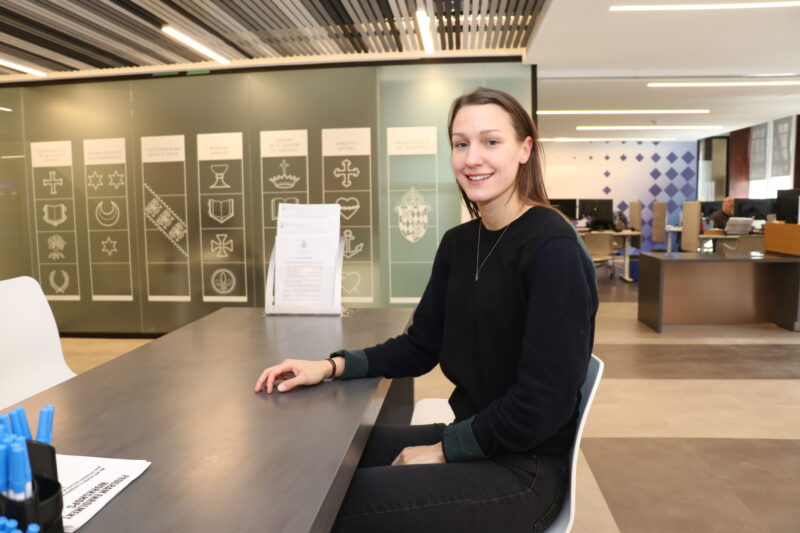
“What really solidifies learning is the hands-on and theoretical aspects” together, she says, describing the appeal of her lab work and also echoing a key theme of education at St. Mike’s. Like every part of her life, Licht holds the theoretical and practical elements in perfect balance, just as she balances her athletic achievements with her academic work. Over the past five years of her student life, the one change she’s noticed in herself is a growing confidence in what she can do.
As her coaches, professors, and peers would attest, that confidence is certainly justified.
The Varsity Blues women’s volleyball team will take the court in OUA Final Four competition against the Western Mustangs at the Goldring Centre Kimel Family Field House at 4 p.m. on Friday, March 6. Fans can cheer on the Blues and catch updates in real time at the Varsity Blues Twitter account, and watch the match live at OUA TV.
President David Sylvester is pleased to announce the establishment of the Comper Professorship in Medieval Studies at the University of St. Michael’s College in the University of Toronto. This newly endowed position has been made possible by a foundational investment by St. Michael’s alumnus, Dr. Tony Comper, C.M., L.LD. (Hon). Dr. Sylvester is also delighted to announce that Dr. Alison More is appointed the inaugural holder of the Comper Professorship. Dr. More is a highly regarded Latinist whose research investigates the intersections of social and religious culture in late-medieval Northern Europe.
The donation reflects Dr. Comper’s firm belief that studying the humanities offers invaluable benefits both personally and professionally – and that St. Michael’s is on the right path with its renewal as a vibrant centre of undergraduate education at U of T. “Studying liberal arts, in particular literature, provides significant insight into human nature; (it offers) essential knowledge in interpersonal skills, the most important skill for success in business and indeed in life,” says Dr. Comper, who is the retired President and CEO of BMO Financial Group.
Dr. Comper recently returned to campus to take courses in Medieval Studies, a Faculty of Arts and Science undergraduate program sponsored by the University of St. Michael’s College that is available to all students in Arts and Science at the University of Toronto. This has given the philanthropist a front-row seat for the revitalization of Arts and Science undergraduate programs sponsored by St. Michael’s. Pleased with what he has seen, he has offered the university a unique hybrid investment in teaching by funding this position. The gift is comprised of a multi-million dollar bequest, and the promise of annual funding, effective immediately, in the intervening years to cover salary and benefits. This faculty position is one of six that St. Michael’s implemented in 2017 as part of its focus on teaching excellence in the four undergraduate programs it sponsors: Book and Media Studies, Christianity and Culture, Celtic Studies, and Medieval Studies.
Dr. Alison More came to the College from the Centre for Medieval and Early Modern Studies at the University of Kent where she designed and taught core courses on Latin and palaeography. She and the other assistant professors who joined the St. Michael’s community and broader University of Toronto three years ago have become a vital part of social and academic renewal. They have enhanced students’ learning experience through their own engaged and creative teaching and research interests and have contributed a great deal to the culture and community of the College beyond the classroom by supporting student-run initiatives and presenting public lectures for alumni. The Comper gift is creating great excitement on campus, as it represents the first step in the campaign to ensure the professorships remain permanent.
“This generous gift is an extraordinary demonstration of the confidence in the renaissance under way at St. Michael’s,” says Dr. David Sylvester, President and Vice-Chancellor. “It’s also a model of funding for other professorships, and an ideal example of how St. Mike’s continues to renew itself through endowed legacy positions. We’re thrilled that an outstanding philanthropist like Dr. Comper has demonstrated his dedication to his alma mater in this way.”
“St. Michael’s and the wider U of T share a long tradition of international excellence in the field of Medieval Studies,” says Professor Meric Gertler, President of the University of Toronto. “Dr. Tony Comper’s wonderful gift will help to strengthen that tradition for future generations, and to accelerate the renewal of undergraduate education at the College. His generosity also builds on his long record of leadership in the University community, including his previous service as Chair of U of T’s Governing Council, as well as his and his late wife Elizabeth’s support for the Anne Tanenbaum Centre for Jewish Studies. We applaud this latest contribution to our collective success.”
About Medieval Studies at The University of St. Michael’s College
With its strong combination of intensive Latin study alongside explorations of theology, literature, history, culture, and manuscripts, Medieval Studies invites students not just to study the Middle Ages, but instead to join a great tradition of inquiry and discovery enlivened by the world-renowned professors who have taught Medieval Studies at St. Michael’s over the years, including Étienne Gilson, Jacques Maritain, Msgr. Edward Synan, Sr. Frances Nims, IBVM, Sr. Mary Arthur Knowlton, CSJ, and Colin Chase.
The University of St. Michael’s College has a long tradition of teaching and research in medieval disciplines and its library has rich resources in the field. The PIMS library, which is housed in the John M. Kelly Library, includes rare, non-circulating books and draws scholars from around the world. The University of St. Michael’s College recently signed a five-year Memorandum of Understanding with PIMS and the University of Toronto recommitting to collaborative work in research, teaching and publication.
For more information, please contact:
usmc.communications@utoronto.ca
(416) 926-2267
We were very fortunate, this past Fall, that Anne Kingston, who died earlier this week, joined us as a Visiting Professor in Book and Media Studies. Anne was a bold and leading voice in Canadian journalism for many years, and particularly with respect to the rise of the #MeToo movement. In December, I expressed to Anne and her fellow Visiting Professor Jessica Johnson my great gratitude for what they made possible for our Book and Media Studies program, the broader College and the University in teaching a course on #MeToo and the Media. As a testament to her generosity of spirit and seriousness of focus, Anne immediately said she was the grateful one, for the chance to teach our students and be part of our academic community.
Randy Boyagoda
Principal and Vice-President
Remembrances:
“Anne Kingston, passionate writer who skewered modern culture and highlighted violence against women has died,” by Adrian Humphreys (National Post)
“Anne Kingston: A Quiet Fighter,” by Kenneth Whyte (Maclean’s)
“Anne Kingston remembered: ‘Passive was not a word she understood’” by Aaron Hutchins/Various (Maclean’s)
Second-year St. Michael’s student Oghogho Abigail Iyekekpolor understands the importance of feeling represented.
She recalls sitting in a high school class in Toronto when the work of Caribbean poet and playwright Sir Derek Walcott was being discussed.
“I looked around my class and I was the only black person, yet here were all these other students engaged in his work. It almost brought tears to my eyes,” she recalls.
She had a similar experience this semester when, on the first day of one of her classes, a black woman professor walked in to teach.
“It took me telling my friends what it meant to me for them to understand. People don’t recognize how important it is to have people they can relate to, who are models for them,” she explains. “It’s important for people to take the time to think about how other people – and they themselves – are represented.”
Now, Iyekekpolor is putting that understanding into action at St. Mike’s by launching a new social media campaign called #SoulsofSMC. The campaign, to be overseen by the Office of Student Life, will focus on students on campus whose stories will inspire and motivate their peers to get involved in a range of activities.
“It’s great to know there are other students at St. Mike’s who share your values and experience,” she says.
Weekly posts will focus on someone – usually a student leader – who will select from a list of questions to share her/his experience at St. Mike’s, offering answers to questions such as how to develop a sense of St. Mike’s as home, or how to navigate cultural challenges. The option to choose which questions to answer promises that the profiles will be as unique and diverse as the students themselves.

Many weeks the posts will be linked to a theme. As the project launches this week, for example, the post will be tied to the Week of Prayer for Christian Unity, which has just concluded. The following theme will be February’s Black History Month, and Iyekekpolor and Student Life Associate Emma Graham have a lengthy list of suggested themes on how to celebrate the community.
It’s no surprise this dynamic idea was created by a dynamic student. Double majoring in neuroscience and psychology, with a minor in French, she was a participant in her first year in St. Mike’s SMC One program the Gilson Seminar in Faith and Ideas. Iyekekpolor also works part-time as a Student Life programming assistant, splitting her time between handling social media posts and helping to plan events with various clubs on campus. It was her idea, for example, notes Graham, to plan Season it Just Right!, two February workshops on African and Caribbean cooking to mark Black History Month.
When she’s not engaged in school or work, Iyekekpolor also belongs to an a cappella singing group through the Faculty of Music and is preparing for a big competition. Her long-term goal is a career in medicine.
You’ll find #SoulsofSMC in the following locations:
Twitter: @USMCStudents
Instagram:@ustmikesstudents
Facebook: St. Michael’s College Students
Principal Randy Boyagoda is happy to offer credit for St. Mike’s new first-term check-in program where it’s due: with the students themselves.
The program, which offers students the opportunity to be matched up with professors to chat about adjusting to university life, is the result of an idea brought to the Principal’s Office by SMCSU, St. Mike’s student union.
With concerns over student mental health continuing to make headlines across the country, touching everyone from parents and professors to roommates and friends, Professor Boyagoda says he was pleased when a group of students approached him last spring to ask what St. Mike’s was doing to promote mental health.
“A delegation from the Student Life committee met with me and wanted to know what was being done locally,” he recalls. “They asked what St. Mike’s could do to respond. The challenge came from students.”
In ensuing discussions about what causes students worry or distress, one of the issues that came to light was students’ anxiety over meeting with professors, an experience that is pretty much unavoidable over the course of four years of a post-secondary education.
“Students were telling us they felt intimidated. Our goal was the humanize the relationship,“ he says.

Working to overcome that challenge seemed like a good – and feasible – first step, and so the first-year check-in idea took root with the goal of normalizing professor-student meetings.
A quick survey of professors – both at St. Mike’s as well as fellows associated with St. Mike’s – indicated a great willingness to help, and the program was launched to success this past fall. The University of Toronto has taken notice of the program and is considering broader applications, Professor Boyagoda notes.
“This program is not about course advising. It is totally voluntary, and student-centred,” he says.
First-year student Lisa-marie Lofty took advantage of the new program, and says she found the opportunity to chat with Dr. Felan Parker helpful as she adjusted to life at St. Mike’s.
“We met early in the semester as I was still thinking about courses and we had a friendly conversation about things to consider as the year went on,” she recalled.
As someone who had attended boarding school four hours outside of Nairobi and was drawn to U of T in part because of the appeal of a big city, it was nice, once here, to have another friendly face to relate to, especially as Dr. Parker told her a bit about his own experiences as a student.
Mathematics professor and St. Mike’s fellow Dr. Mary Pugh also participated in the program after a student contacted her. She says the main message she conveyed was that the student could contact her at any time.
The program “gives students access to a disinterested/non-judgmental person who’s well-familiar with the Faculty of Arts & Science and its classes and programs; someone who can treat them like a human and offer support/advice if needed,” Dr. Pugh says.
As helpful as the program is proving to be for students, it is also proving to be educational for professors as well.

“Because I usually teach upper-year courses, I haven’t had much interaction with first-year students,” says Dr. Parker, who teaches in St. Mike’s Book and Media Studies program. “Contrary to popular myth, I’ve found that they are the opposite of entitled, frequently apologizing for asking for help and uncertain of what kind of support is available. My hope is that the first-year check-ins, along with other initiatives like the first-year foundations seminars, will help show students that we are here to help.”
Social worker Nicole LeBlanc, St. Mike’s in-house wellness counsellor, says first-year students can experience anxiety for a number of reasons. Everything from worry over marks and making friends through to loneliness and being far from home can make students feel anxious or depressed – or both.
“Students face a lot of pressure these days, whether it’s competition to get into graduate programs or wanting to please parents, or worry over expenses. Add in relational issues – the rules of engagement over dating and friendships, for example – and it can be very challenging,” she says. “Many students are going from being a big fish in a little pond to a little fish in a very big pond, no longer having the top marks or profile they might have had in high school. It’s a shock to the system.”
“Be open and honest,” she says when asked what others can do to help. “Tell the person that you notice a change, and let them know that you care. You can suggest counselling or a doctor. Destigmatizing mental illness is very important.”
LeBlanc offers one-on-one counselling for St. Michael’s students, and notes that all it takes is an email or call to set up an initial appointment with her. She finds that a significant part of her role is letting students know what services are available, whether it’s academic help via the writing centre or learning strategist, social support from places like the Centre for International Experience, a referral to the Health and Wellness Centre at the University of Toronto for medical issues, or friendly encouragement to take advantage of on-campus activities offered through St. Mike’s Student Life.
If you or someone you know is in distress, you can call:
- Canada Suicide Prevention Service phone available 24/7 at 1-833-456-4566
- Good 2 Talk Student Helpline at 1-866-925-5454
- Ontario Mental Health Helpline at 1-866-531-2600
- Gerstein Centre Crisis Line at 416-929-5200
- U of T Health & Wellness Centre at 416-978-8030.
As members of our community may be aware, a second presumptive case of the Coronavirus has been confirmed in Ontario. While the risk of contracting the virus remains low, we would like to remind everyone to take commonsense measures to reduce the chance of infection. According to the Public Health Agency of Canada, these include washing your hands often with soap and water for at least 20 seconds, avoiding touching your eyes, nose, or mouth with unwashed hands, and avoiding close contact with people who are sick. Alcohol-based hand sanitizer is available around campus as well.
Any students who are travelling internationally should refer to UofT’s safety abroad office website. If students are unable to return to the University as a result of the travel restrictions, they should contact their registrar (undergraduate students) or graduate program (graduate students) to arrange for accommodations.
Additional resources have been made available by the University of Toronto for better understanding the virus:
- A message from UofT regarding the virus (this page will be updated as new information is available): https://www.utoronto.ca/message-from-the-university-regarding-the-coronavirus
- UofT: FAQs about the Coronavirus: https://www.utoronto.ca/message-from-the-university-regarding-the-coronavirus/faqs
- Public Health Ontario (this page is being updated every day at 10:30 a.m.): www.ontario.ca/page/wuhan-novel-coronavirus-2019-ncov
- Toronto Public Health: www.toronto.ca/community-people/health-wellness-care/diseases-medication…
- Peel Public Health: www.peelregion.ca/articles/2020/coronavirus.asp
- Public Health Agency of Canada: www.canada.ca/en/public-health/services/diseases/coronavirus.html
- U.S. Center for Disease Control and Prevention: https://www.cdc.gov/coronavirus/2019-ncov/index.html
- World Health Organization: www.who.int/health-topics/coronavirus

As the Varsity Blues men’s hockey team went on a 14-game winning streak this winter, first-year St. Mike’s student athlete Kyle Potts was beginning to come into his own. The rookie forward and Ontario Hockey League alumnus has become a power play asset for the Blues, scoring the fourth goal during their hard-fought 6-5 win against the Ryerson Rams that kicked off Toronto’s remarkable winning streak, a feat they last accomplished in the 1973-1974 season.
“It was a wild game with five lead changes,” the Oakville native says. The overtime win provided a morale boost that propelled the team into a string of victories. Potts added to the team’s point tally in six of those games, contributing the game-winning goal in a 6-2 win over the Brock Badgers. He notes, “I don’t think anyone really expected us to win 14 in a row.”
The Varsity Blues are now at the top of the Ontario University Athletics Western Conference standings; Potts considers the Queen’s Cup and a trip to nationals to be in reach, which could open a new chapter in the history of the Blues hockey program. The team won its last national title in 1984.
The prospect of becoming part of an athletic legacy is one of the things that originally attracted the Humanities major to St. Michael’s when he was considering the University of Toronto. “The history of hockey at St. Mike’s is what originally drew me,” Potts says. “I just knew it was the right place for me.”
The Double Blue hockey tradition at St. Michael’s goes back to the early days of the institution, when Basilian priests could be found on the ice coaching and competing with students. With a lineage that includes Hockey Hall of Fame inductees and Olympic team coaches, hockey at St. Michael’s has always been a strong source of community for student athletes, and continues to provide a firm grounding for those who are new to university.

“It’s like a brotherhood,” Potts says of the Varsity Blues team, which includes fellow St. Michael’s students Curtis Harvey and Frederic Foulem. “We all stick up for each other.”
Potts made his transition to university several years later than most U of T students, as he played for three years in the OHL after graduating from high school. He also participated in the New York Rangers training camp in September 2018.
Managing a full load of classes in addition to a rigorous six-day-a-week practice schedule has presented challenges beyond the ones Potts knew from his life in the Junior Hockey system. He knew support would be important in order for him to make a successful transition.
“I met with some of the people in the Registrar’s Office before enrolling at St. Mike’s,” he says, noting that they helped make his transition to university easy for him. “They seemed like a great support system for me, and it was the right fit.”
“Kyle, like many of our student athletes, faces the pressure of high-level performance in the athletic and academic arenas,” St. Michael’s Registrar and Director of Student Services Giancarlo Mazzanti says. In view of these pressures, the Registrar’s Office makes sure to connect student athletes like Potts with both an academic advisor and the Student Services team at St. Michael’s, which includes learning strategists, accessibility advisors and Campus Ministry.
Potts also credits Head Coach Ryan Medel, Assistant Coach Andrew Dovey and other members of the Men’s Hockey coaching staff for helping to integrate new players into both the team and university life more generally. “They do a really good job around the clock looking out for us and supporting us,” Potts says. “It’s good because it feels like you’re never alone.”
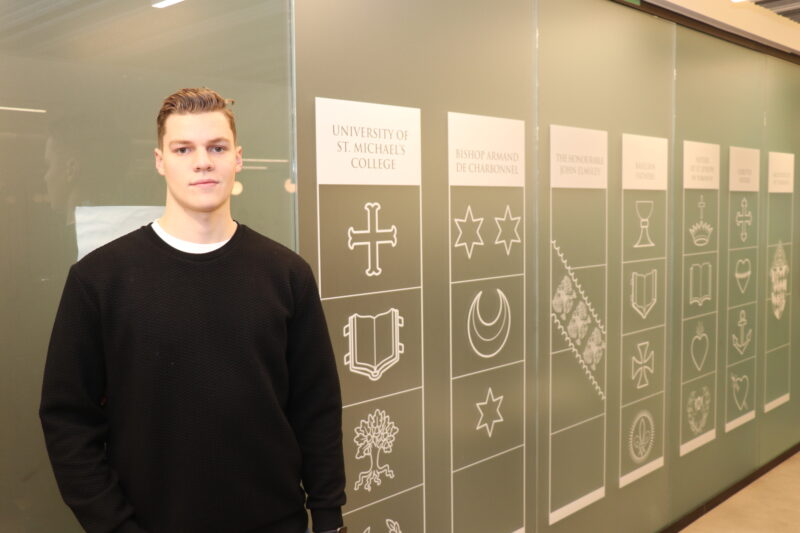
Despite the intense rigours of both OUA competition and university-level studies, Head Coach Medel considers Potts to have made a successful transition into his Varsity Blues career. “Kyle skates well for his size and has strong offensive instincts,” he says. “He’s solidified a spot on our power play and has been a big part of our success overall.”
So what’s next for the nationally ranked team? The big goal is securing the number-one seed in the OUA playoffs—the first step towards the Queen’s Cup and a berth at the nationals. As the number one team in the OUA West and fourth-place team in the country, this goal is well within reach. Potts considers the Queen’s Cup achievable as well.
“We play the right way as a team,” Potts says. “I think we have the team to go there.”
Following wins over the weekend against the Windsor Lancers and Wilfrid Laurier Golden Hawks, the 19-3 team will next face off against the Western Mustangs in Varsity Arena on Wednesday, Jan. 22 at 7 p.m. Fans can cheer on the Blues and catch updates in real time at the Varsity Blues Twitter account, and watch the game live at OUA TV.
As the sponsor of four interdisciplinary programs at the University of Toronto, St. Michael’s emphasizes the conversational and communal nature of scholarship. On January 25, students from the St. Michael’s community will convene a wide-ranging conversation about the nature and purpose of learning and education at the USMC Student Colloquium 2020: “Knowledge, Action, Wisdom: What is Learning?”
The showcase of student research is designed to be a learning opportunity for participants, who benefit from detailed faculty responses to their work as well as dialogue with peers and professors across disciplines. Past student-participants have gone on to present their work at academic conferences and other institutions.
Their presentations will also generate a larger conversation on campus about the ideals, purposes, values, and goals that animate the university community.
“Discovery at the University exceeds the boundaries of teaching and research,” says Principal Randy Boyagoda. “At St. Michael’s College, we are committed to providing students the opportunity to seek the truth for its own good and for the greater good, and this Colloquium represents a natural forum for our academic community to do as much.”
For this year’s Colloquium, students from both the undergraduate division and graduate Faculty of Theology will present on topics ranging from theories of scientific change to the novels of John Williams and Vladimir Nabokov and the future of Catholic education. Respondents include Faculty of Theology professor Jean-Pierre Fortin, Christianity and Culture professor Reid Locklin, and St. Michael’s Fellow Clifford Orwin.
The discussions that follow each presentation place their arguments in a much larger context. “We don’t want the presentations to exist in a bubble, but to be part of the conversation,” says co-organizer and Faculty of Theology postdoctoral fellow Dr. Tristan Sharp, who has helped organize three student colloquia at St. Mike’s.
Participants also have the opportunity to benefit from the perspectives of students outside their disciplines. Dr. Sharp mentions a particularly potent combination of papers two years ago, which paired a presentation on “digital resurrection” through social media applications with a paper about concerns around science and technology during the Enlightenment. Dr. Sharp finds cross-disciplinary encounters can spur students on to deeper questions in their own work.
“One of the new trends in thinking about research is to think about it as a certain kind of conversation. What a colloquium like this permits is an opportunity for students to begin to think of themselves as real partners in the conversation rather than merely observers of it,” says Dr. Locklin, who will be participating in the colloquium as a respondent for a third time. “By reflecting on the nature and purpose of education, students also can help us deliberate about the future of the University of St. Michael’s College.”
The USMC Student Colloquium 2020 will begin with coffee and snacks at 9:15 a.m. on Saturday, January 25 in the Basilian Fathers Common Room. All are welcome, and no registration is necessary. Contact tristan.sharp@utoronto.ca with any questions.
The sense of anticipation that comes with the season of Advent fits perfectly into the rhythm of campus life at St. Michael’s. The beginning of the new Church year, with its focus on preparing for the coming of the Christ child, arrives as students look ahead in their lives. There are papers to finish and exams to write as the Fall semester winds down. There are travel plans to make and, especially for first-year students, a growing eagerness to head home to loved ones for the Christmas break. Meanwhile, professors are grading work and submitting marks while staff are tying up loose ends before heading home for the holidays. The mood at St. Mike’s is very much one of expectation.
Underlining that feeling of anticipation are the various ways St. Mike’s marks the Advent season and looks forward to Christmas. The lampposts of Elmsley Place are festooned with garlands of white lights, a festive response to the dark days of December. The altar at St. Basil’s bears an Advent wreath, its one rose and three purple candles marking the passage of the four weeks preceding Christmas. And, in the lobby of Brennan Hall, a crèche set sits waiting, a vivid reminder of the days to come.
While the symbols of the season bear witness to the coming of Christmas, it’s the activities on campus that are the most powerful reminders of the spirit of the season. Everywhere you look there are opportunities to donate to a worthy cause. Campus Ministry has boxes to collect toys and gift cards for the Society of St. Vincent de Paul, and guests attending the Dec. 5 Alumni Tea and Carolling party are invited to join in this campaign by bringing an unwrapped toy or gift to the event.
In the Faculty of Theology, boxes in the student lounge are filling up with donations of food and personal items for Society of Sharing, a member agency of Catholic Charities. Run by Master of Divinity grad Mariza Garcia, the agency makes up care packages at Christmas for isolated people in the downtown core.
During Advent, Faculty member Dr. Darren Dias steps outside his life as an academic to lead retreats for the broader community, while the entire Theology community looks forward to the annual Vespers and Advent Dinner, taking place on Friday, December 6. The evening is a chance for students and professors to take a step back from work to slow down, collect their thoughts in prayer, and then socialize together.
There’s an open invitation for all to attend the Schola Cantorum’s Advent concert in St. Basil’s Church. This year’s concert, which takes place Dec. 9 at 7:30, will include Palestrina’s Missa Gabriel Archangelus and organ music by Frescobaldi, directed by Dr. Michael O’Connor, with Dr. John Paul Farahat on the organ. The event is free, with an optional collection for charity.
And of course there’s just plain Christmas fun to be had before students scatter for the holidays. The tree in the Coop is now decorated, and on Dec. 3 and Dec. 4 the Canada Room will be the site of student Christmas dinners for both commuter and residence undergrads, with a round of carolling rolled in on Wednesday, Dec. 4 from 4 to 6 p.m.
Faculty and staff get in on the festivities on Thursday, December 12. Following Mass at St. Basil’s, all are invited to attend the annual Christmas lunch and round of carols in Fr. Madden Hall, complete with a tree to decorate with more gift cards for St. Vincent de Paul.
St. Mike’s is also launching a new initiative this year, a Holiday Community Social Lunch to be held on Wednesday, Dec. 18 in the Faculty Dining Room. The tasty three-course meal is designed to bring together in celebration members of the St. Mike’s community with friends and neighbours from a wealth of traditions. Tickets for this event can be purchased in the Faculty Dining Room (located on the second floor of the Scollard Park entrance to Brennan Hall).
With the city as its classroom, a new Media Ethics Lab at the University of St. Michael’s College will help students respond to the ethical issues being raised by rapidly emerging technologies and new communications practices.
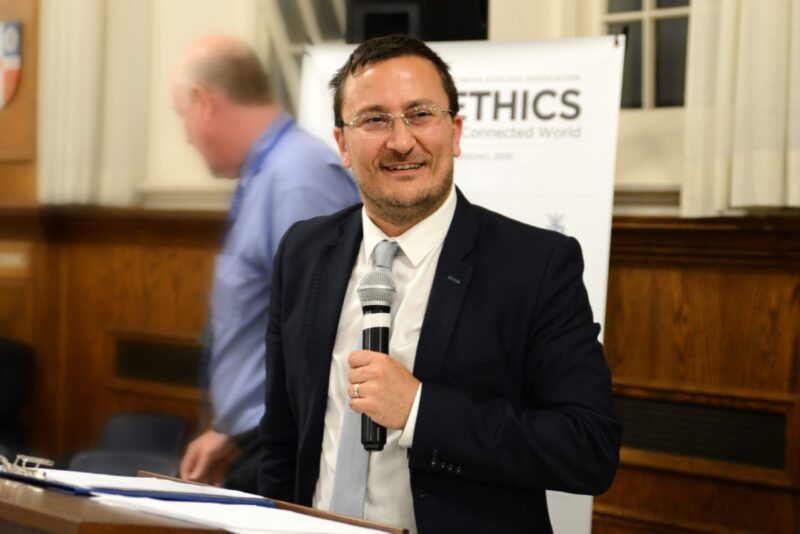
The project is spearheaded by Dr. Paolo Granata, an assistant professor in St. Michael’s Book and Media Studies program. The lab springs naturally from an international conference Dr. Granata chaired earlier this year on the University of Toronto campus in his capacity as the vice-president of the Media Ecology Association (MEA). The conference, Media Ethics: Human Ecology in a Connected World, had a goal of exploring new ethical perspectives and frameworks to help build a digital ecosystem that will serve society in healthy and productive ways.
Popularized by Neil Postman, the phrase media ecology is based on the work of Marshall McLuhan. For those unfamiliar with the term, the MEA’s website defines it as “the idea that technology and techniques, modes of information and codes of communication play a leading role in human affairs.”
The Media Ethics Lab, explains Dr. Granata, is built upon open research, allowing a diverse, collaborative body of stakeholders, from students to media activists and organizations, to freely share information on academic programs and research initiatives to foster ethical thinking in research, learning, and civic engagement.

He views the virtual Media Ethics Lab as both an intellectual and social space where interested parties can gather to study and discuss the ways in which digital culture impacts today’s society. He sees it as a sort of clearinghouse to help society stay ahead of the curve of emerging technologies and the ethical issues that can come with them.
For now, the lab will focus on three core areas: Digital Equity, or creating equitable, inclusive communities for all; the Digital City, focussed on designing people-centered information systems; and Digital Literacy, looking at helping communities develop skills to carry them forward into the 21st century.
“Private companies rule our digital world,” says Dr. Granata. “If public policy is too slow, then the market will come first,” regardless of the impact new technologies have on ethical issues relating to matters such as privacy or artificial intelligence.
“The Media Ethics Lab is being started not only as a research project but also as an opportunity for experiential learning,” he adds, noting that some of the lab’s funding comes from the Advancing Teaching & Learning in Arts and Science (ATLAS) program at the University of Toronto.
And this is where the “city as classroom” idea, another McLuhan concept, will come into play. Experiential learning, explains Dr. Granata, means stepping outside of the confines of the university and into the community.
“Everything we do must be able to support, foster and advance and open an inclusive society, as we must not only work towards a healthier digital world, but a more equitable planet” and that requires students getting involved in civic engagement to listening to what a broad range of people think.
He cites as an example a recent workshop students participated in at Mozilla Foundation in Toronto, a global non-profit dedicated to keeping the Internet a global public resource that is open and accessible to all. Students were invited to provide suggestions and proposals, an empowering experience that allowed them to test-drive their ideas, giving the theoretical a practical turn.
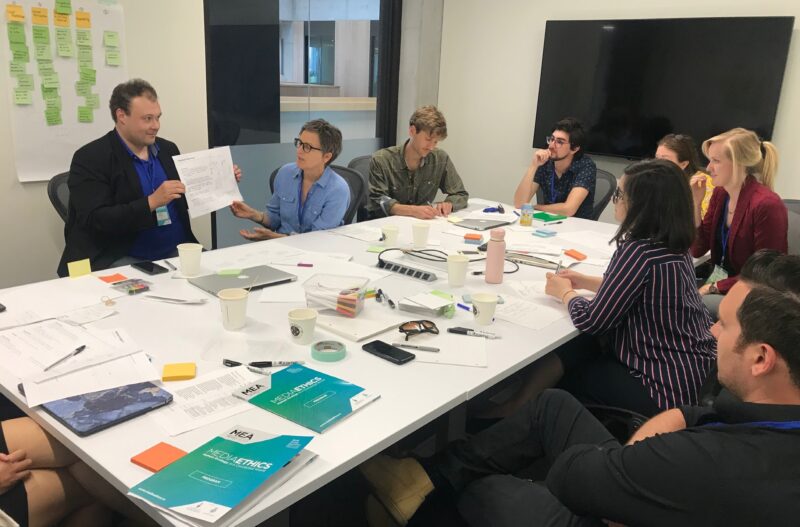
Another form of engagement via the Media Ethics Lab will be periodic charrette sessions, a type of intensive brainstorming meetings where various stakeholders gather for respectful discussion identifying both the benefits and challenges of the current digital media landscape, all with an eye to making improvements.
“We want to foster and support positive change. All of the Media Ethics Lab’s efforts are also are done in support of the UN’s sustainable development goals.” Dr. Granata says.
Several students have already been involved, either in the conference end of this project, or now by on establishing the lab, including Kelsey Mcgillis, Alexandra Katz, and David Lee, all Book & Media Studies students at St. Mike’s as well as Robert Bertuzzi, PhD candidate at Western University, and Simon Digby, recently graduated at British Columbia’s Quest University.
Going forward, the lab will provide both training and mentorship to the students, encouraging them to participate in academic discussion and debate, necessary skills to carry forward if they are to help shape future policy or plan to teach.
Training and mentoring will be provided by Dr. Granata as amplification of his Media Ethics course. Some Book & Media students will serve as research assistants, conducting background reading in the field and participating in periodic discussions to come up with research questions and creating dossiers on their findings.
Working with Dr. Granata, they will post to the www.mediaethics.ca site, selecting both scholarly and non-scholarly publications, as well as a range of commentary to further the discussion. Students will engage in discovering funding opportunities and learn to draft grant proposals.
“The information environment is very much like the natural environment, and we need to take care of the information environment in much the same way we tend to ecological consciousness ,” says Dr. Granata. “The Internet is polluted but it should be a place where people can go and grow. Discussions on media ethics can help restore health.”
That care will require new thinking on how to stop corporate behaviour that is detrimental to society, he adds. Fines in response to privacy breaches, for example, simply don’t work because they aren’t large enough and, more importantly, don’t change behaviour, he says.
“To move forward, we need a humanistic approach to redefine the interface of humans and technology. It’s time to apply ethical thinking in the process of designing new technology.”
The Media Ethics Lab is a step in the right direction.
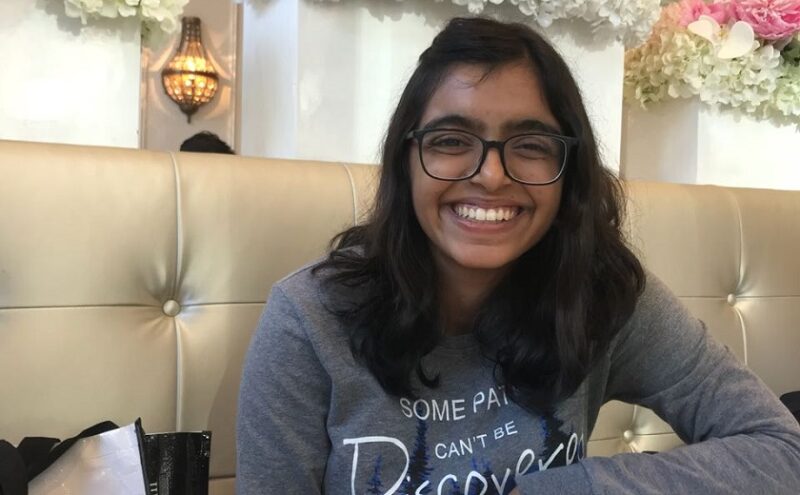
Each year, students come from all over the world to study at the University of St. Michael’s College in the University of Toronto. We caught up with one of those students to hear more about what life is like for our international student community, and how St. Mike’s becomes a home away from home.
Simran Dhir is a second-year student specializing in Pharmacology and Toxicology while minoring in Education and Society. She came to St. Mike’s from Kolkata, India, and is involved with the SMC Troubadours theatre club on campus. She was also a member of SMC One: The McLuhan Seminar in Creativity and Technology, which features an in-course international learning experience to Silicon Valley.
1. What makes St. Michael’s a good fit for you as an international student?
St. Mike’s is one of the most welcoming places I have been to. Considering how diverse we are, it is impossible not to find people you relate to and who are going through the same things as you. Also, with the help of the super knowledgeable Dons and the Registrar who work so hard trying to ensure that the transition from high school to college goes smoothly, it is hard to not feel as if St. Mike’s is a home away from home.
2. What are some of the resources available at St. Michael’s that new international students should know about?
We have a really well-organized Mentorship program that pairs incoming students with seniors who share similar interests, and I think it’s a really nice way to get to know the workings of the University. Being situated right across from the Kelly Library comes with its perks, and each student has a personal librarian that can help them with their research assignments and writing. There are also study spaces that can be booked for group study sessions. We have a great support system created by our Dons, and we have an excellent team of Commuter Dons who are there for the students who do not live on campus. Our Student Union this year is super involved in campus life and is going out of their way to make students feel like they are being heard.
We also have a wide array of clubs that you can get involved in, like the St. Michael’s College Troubadours, which is the drama club at our college, or Clean SMC, which works on creating a more sustainable campus. The Registrar is there to help answer any questions you may have, and is one of the most important resources that you should take full advantage of. Last but not least, interact with the people around you! Your peers are the most underrated resource here and if you let yourself be open to the community around you, you will have some of the best years of your life here.
3. What is your favourite part of life as an international student at St. Michael’s?
The community is hands-down my favourite part of life here as an international student. St. Mike’s has so many events like the Dean’s Cup and Kelly’s Corner that provide students with the opportunity to get involved and which garner a sense of belonging. I strongly feel that the diversity present in this college makes us more inclusive, and that no matter where you are from, you will find the support and love you need here.
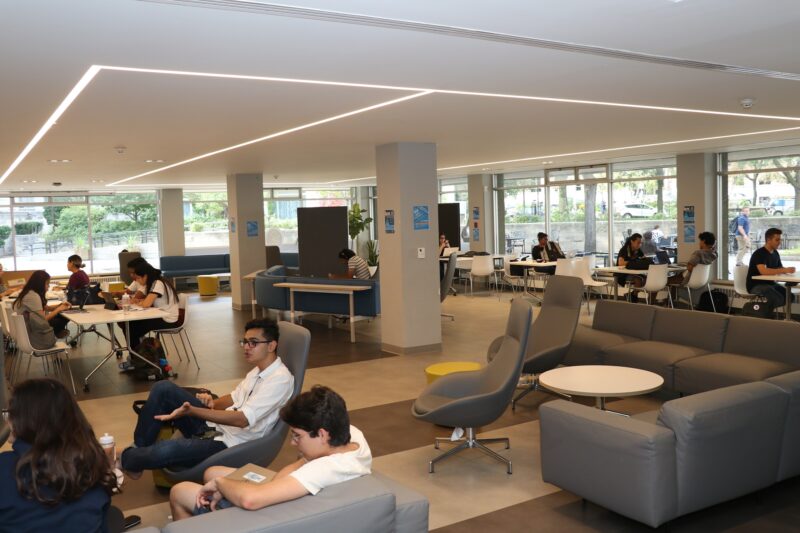
When asked to describe St. Mike’s, students often mention “community” as a foundational part of their experience of the school. The newly renovated and fully accessible Brennan Hall offers – quite literally – a concrete example of the ways in which community is an essential and longstanding feature of the student experience at St. Michael’s. Amid the portraits of alumni and past professors, current students find themselves in a community as familiar as an extended family—and just as committed to their success in every area of life.
“The revitalization of Brennan Hall represents this university’s commitment to student experience,” says President David Sylvester. “By placing key services and resources alongside club and gathering spaces in the heart of our campus, the new Brennan Hall brings together every part of St. Michael’s student life—spiritual, academic, personal, and social—in the same way a St. Mike’s education forms the student as a whole person.”
One of the most important updates to the space is the relocation of the Office of the Registrar from Alumni Hall to the centre of Brennan. This places essential registrarial services at the heart of campus for both undergraduate students at St. Mike’s and graduate students at the USMC Faculty of Theology.
Students can make use of those services while also popping in to the SMCSU office, the Canada Room dining hall, or the Dodig Family COOP. With Campus Ministry and Student Life offices down the hall as well – and exciting events often taking over the COOP during evenings and weekends – the overall effect is that of a bustling home for students from every division of the school, and a place that caters to every part of student life.
Giancarlo Mazzanti ’84, Registrar and Director of Student Services, says “The revitalization of the main level of Brennan Hall has been the catalyst in improving the student experience on our campus.” He mentions one of the key benefits has been that staff “are in constant contact with students, and sharing in the community experience,” and that the new spaces bustle with students “studying and meeting with academic advisors, learning strategists, career advisors or our Campus Ministry team.”
Since the beginning of the new academic year, the revitalized Brennan has been buzzing with activity, from orientation programming to events and first club meetings. A recent Kelly’s Korner – an open mic night and longstanding tradition brought back in the new space – was full to overflowing the doors of the Dodig Family COOP.
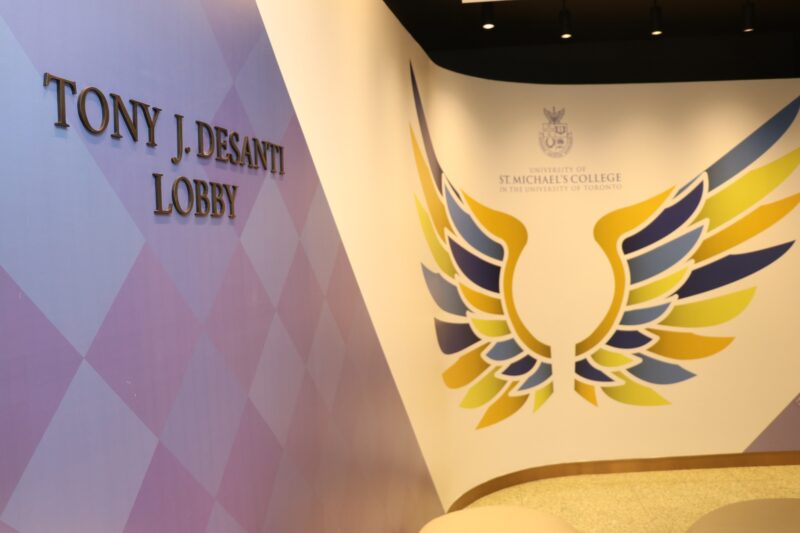
“It looks beautiful and it is coming back to life!” says Maryrose Doucette, a third-year SMC student double-majoring in Christianity and Culture and Mediaeval Studies with a minor in Political Science. “The COOP being redone, the pool table, and of course the coffee shop are all a draw for me, and it’s great to walk through on my way to class and run into friends at every corner.”
The changes to Brennan are apparent from the moment a visitor walks in the south entrance. A bright and welcoming entrance space, the Tony J. Desanti Lobby features a curved wall imprinted with the names of members of the St. Michael’s community who made the renovation possible. The old-school USMC crest on the floor recalls decades of St. Michael’s history, while a pair of giant angel wings on the wall provide Instagrammable photo opportunities to students and visitors to campus.
In the updated central space, students now have a large variety of seating options while waiting for appointments or gathering with friends. One option is to grab a drink or a snack at Mike’s Café, a coffee shop quickly becoming known for its “Basil the Bulldog” signage where students can pick up St. Mike’s merchandise and a small selection of toiletries and living essentials in addition to Starbuck’s Coffee. Arrays of outlets next to every seating area make it possible for students to study or hang out for as long as they like without relocating for a battery top-up.
An essential part of the project was the update to the Dodig Family COOP, a beloved open space where students at St. Mike’s have gathered for decades. It has always played a particularly important role in the lives of commuter students, who treat the COOP as a home base for the days they spend on campus. The new COOP features soft seating, updated lighting, plentiful outlets, and a complement of glass-walled office spaces for student organizations and clubs, as well as a graduate student lounge with further comfortable seating. Microwaves and high-top tables make the COOP a place to eat as well as study, hang out, and gather for events.
Isabel Armiento, fourth-year SMC student and this year’s Editor-in-Chief of The Mike, finds that the revamped club spaces next to the COOP have been a boon to the campus paper’s operations, saying “we can now comfortably host in-house copy-editing and production sessions with more members present than ever before.” Armiento also notes the centralized office spaces make it easier to “hold outreach events in common student spaces and to communicate with Student Life and USMC faculty.”
The Class of 2023 has already begun to make themselves at home in the COOP and the adjacent offices, which are adaptable for a variety of uses. Passers-by often catch sight of board game nights and friendly games of pool on the new billiard table. From residential students to commuters, graduate students to those pursuing certificates in Continuing Education, visitors to the revitalized spaces find a new home for the community that has always made St. Michael’s unique.
Since its official opening in August of 1939, Brennan Hall has been at the heart of the St. Mike’s experience. 80 years later, thanks to the generosity of Brennan Hall “Champions,” gifts from alumni and friends, major class gifts, and a contribution from students through the Student Capital Improvement Fund, the Class of 2023 will be the first to enjoy a completely revitalized Brennan Hall throughout their entire experience at St. Mike’s.
From shared hobbies and interests to causes and activism, the more than 20 clubs at St. Michael’s bring together students from across campus, neighbourhoods, and divisions to enrich the larger community. The annual SMCSU clubs fair and BBQ helps new students get a sense for just how many ways they can get involved in life at St. Michael’s, both supporting and being supported by their university home. Clubs are also a place many students form the friendships that they carry with them after graduation, and develop skills and experience that are directly applicable to their future careers.
“Clubs at St. Michael’s are an essential part of student life, and one of many ways students find opportunities to grow in their talents and passions outside the classroom at St. Mike’s,” says Student Life Associate Emma Graham. “They’re also a bedrock of community life here for both residential and commuter students.”
One of the newest St. Mike’s clubs is Clean SMC, an organization that strives to “educate and empower students to take action against environmental issues through the support of green initiatives and sustainability,” says club president and SMC student Juliano Baggieri. “[We] collaborate with St. Michael’s College and students to make environmentally friendly projects come to life.”
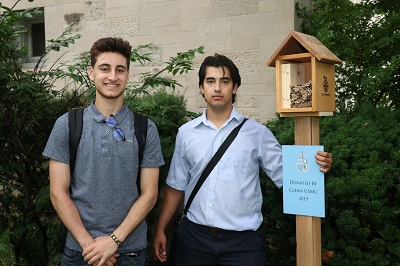
One of the recent collaborations between Clean SMC and St. Michael’s resulted in the installation of a “bee box” on campus next to Carr Hall. Donated by Clean SMC and coordinated and installed by the St. Michael’s Facilities team, the unit will provide a home to friendly, non-stinging pollinators that will help to brighten the many species of flowering plants that thrive on 11-acre St. Michael’s campus.
Baggieri believes that the growing interest in sustainability and the environment will attract even more new members and help the club achieve its three primary goals of “building awareness, increasing community involvement in sustainable activities and developing environmentally friendly projects.”
Other organizations directly support the work of the University’s four sponsored academic programs: Christianity and Culture, Mediaeval Studies, Celtic Studies, and Book and Media Studies.
Christianity and Culture Social Club co-presidents Maryrose Doucette and Lara Connell work to create deeper connections between students and professors in the program by hosting regular social events where students and professors mingle over refreshments and coffee.
“These clubs exist so that students can make the most of their university experience and genuinely enjoy a community of like-minded people outside of the classroom,” Doucette says.
Other student clubs support the larger St. Michael’s community by offering real-life experience that encourages students to share their gifts beyond the classroom.
“Reporting fresh, relevant stories that are both for students and by students” is the mandate of student paper The Mike, where generations of St. Michael’s students have developed their journalistic chops since the founding of the paper in 1947. Fourth-year SMC student Isabel Armiento oversees The Mike as this year’s Editor-in-Chief. This fall, she hopes to “bring together a larger network of St. Mike’s students and emphasize all facets of the newspaper,” noting that there are major opportunities for artistic and creative students to contribute their talents at every stage of the editorial process.
Many clubs also foster the development of creative gifts. Co-Executive Producers of SMC Troubadours Kaitlyn Wang and Simran Dhir are soliciting suggestions for musicals and student-written plays to showcase student talent at St. Mike’s.
“Students don’t need to have any previous experiences of the dramatic arts,” Wang and Dhir say. All levels are welcome in auditions for shows the club is putting on as part of the 2019–2020 season. This year’s diverse lineup includes “a student-written play, an alumni-written play, a musical, [and] a stand-up comedy show.”
Clubs at St. Michael’s are funded by the St. Michael’s College Student Union, which puts on the annual clubs fair and BBQ. Cianna Choo, SMCSU’s VP of Academics and the organizer of this year’s fair, says “clubs provide a creative outlet for students to explore interests outside of their programs.” She notes that in addition to helping the St. Michael’s community to flourish, club involvement helps students develop essential skills for the workplace in a context of collaboration.
The St. Michael’s community is richer for the variety of student organizations that create community, put on events, and further the extracurricular education of students at the college. More information on ways to get involved on campus is available on the St. Mike’s website.
Orientation Week 2019 at St. Michael’s will take place September 1 to 4. Register here! In the weeks leading up to Orientation, we’re posting quick interviews with each member of this year’s orientation coordinator team. The introduction to the series is available here.
Student Life Associate Emma Graham is a St. Michael’s grad and this year’s staff representative on the team. We asked Emma three questions over email about orientation and life at St. Mike’s.
- What part of Orientation 2019 are you most excited for?
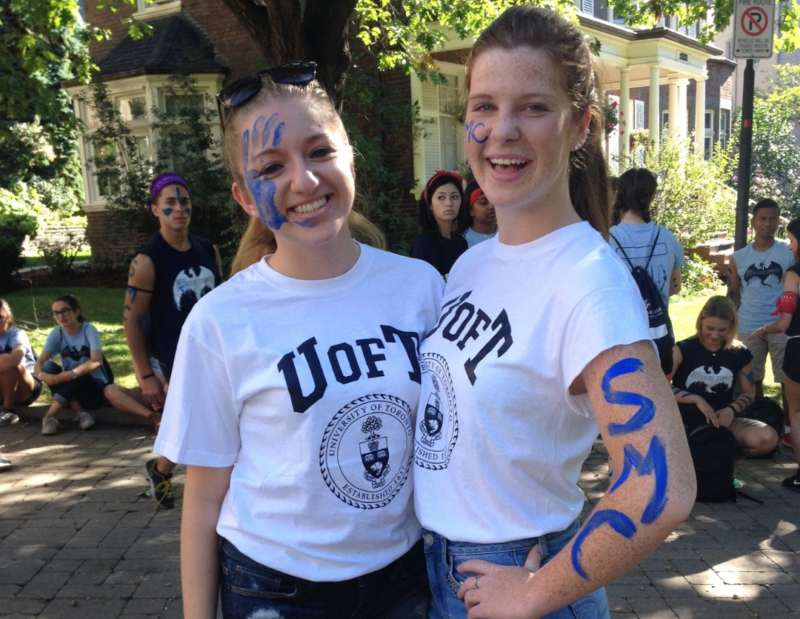
I am most excited for our Carnival and Academic Orientation! Students get to explore campus, play awesome carnival games and then meet some professors in their programs and some upper year students for Q&A sessions, all accompanied by a fantastic presentation by our very own Principal!
.
.
Our Executive team chose this theme because it reflects the truth that entering University can be a terrifying and somewhat chaotic experience. However, the wild is also beautiful and full of diversity, so once you overcome your fears there is a wealth of opportunities for learning and growth. Our Orientation leaders and marshals will work hard all week to accompany students into the Wild so that by the time classes start they are well equipped to face it on their own!
.
.
Some of the best parts about belonging to St. Mike’s are the friendships and amazing community life, but in addition to this our college offers fantastic resources such as a personal librarian assigned to each student, a robust peer mentorship program to help students acclimatize to university, a chaplaincy program that offers formation for students beyond their academics, and so many more! My greatest hope for our first years this year is that they seek out these resources before the weight of term work sets in, and that they will be able to rely on their community to support them on this wild adventure we call post-secondary education!
.
Emma can’t wait to welcome you to campus in just a few short days. Get excited! The fun begins September 1. Remember to register for Orientation 2019 here if you haven’t already.
Read other interviews in this series here:
| Anna Zappone | Adam Gomes | Taylor Medeiros | Jessica Sorbara |
Orientation Week 2019 at St. Michael’s will take place September 1 to 4. Register here! In the weeks leading up to Orientation, we’re posting quick interviews with each member of this year’s orientation coordinator team. The introduction to the series is available here.
Orientation Executive Officer of Leader Training and Management Jessica Sorbara is a third-year student at St. Mike’s double-majoring in English and History. We asked Jessica three questions over email about orientation and life at St. Mike’s.
What part of Orientation 2019 are you most excited for?
This year what i’m most excited for during Orientation Week is the tri-campus parade! This event takes place every year during Orientation, and is such an exciting event where we really get to show our SMC spirit. All the cheers and all the energy really get everyone so excited for the school year, which is such a great way to end the week.
What is one of your best memories at SMC?
My best memory at SMC is definitely participating in Orientation. Being an orientee, a leader, and now an Orientation Exec member has really shown me all the amazing things that the college has to offer its students. Being a part of such a welcoming community and seeing exactly how our planning and hard work affect the first-year students is so rewarding, and makes me so happy to be part of the St. Mike’s family.
How can the Class of 2023 get involved on campus in the fall?
There are so many ways that the Class of 2023 can get involved on campus in the fall! Firstly, participating in Orientation is a great way to get to know all the programs, clubs and people around campus. It can show students all the amazing groups at SMC, and will absolutely encourage everyone to be an active student in the community. Year round there are so many clubs that UofT and SMC have to offer students, so I would say to definitely attend the Clubs Fair during Orientation Week to see what clubs interest you!
Jessica can’t wait to welcome you to campus this fall. If you haven’t already done so, register for Orientation 2019 at St. Michael’s here.
In 2017, major media exposés of predatory sexual behaviour by powerful figures unleashed #MeToo, a hashtag now tweeted and shared more than 20 million times. Using the hashtag, people all over the world began to share stories of their own experiences of abuse at the hands of people whose wealth and power had protected them from justice, and this public reckoning led to a major – and ongoing – cultural shift.
Now, two years after the publication of the reporting that launched #MeToo, two journalists who continue to advance and shape the public conversation around the issue in Canada are bringing their expertise into the St. Michael’s classroom.
Beginning September 5, Jessica Johnson, Executive Editor and Creative Director of The Walrus, and Anne Kingston, Senior Writer and Columnist for Maclean’s, will be co-teaching “#MeToo and the Media,” a course designed to help students develop an analytic understanding of the social movement as it continues to evolve.
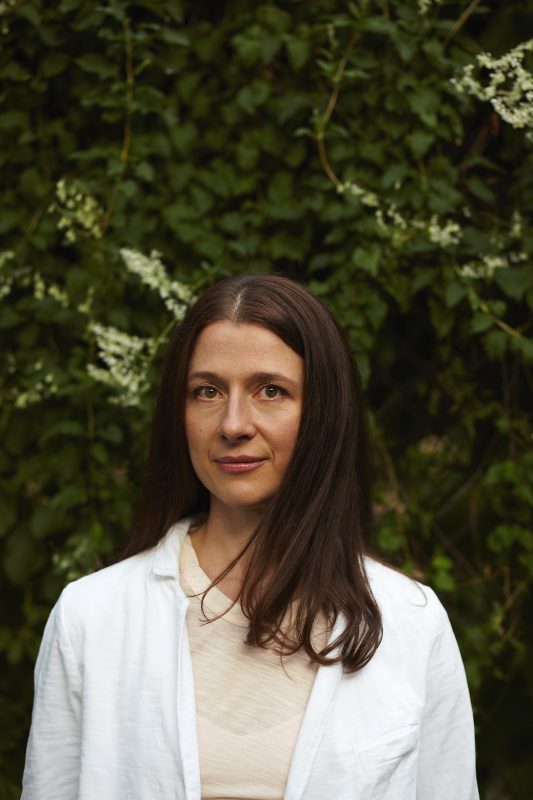
As the course title implies, Kingston and Johnson plan to contextualize #MeToo in a larger media ecosystem. “This will be a class that looks at the way #MeToo informed the media, and also, about the way the media coverage of the movement has fuelled broader conversation in society,” says Johnson.
“This is a new class — new at St. Michael’s College, but also, we aren’t aware of any other one exactly like it anywhere,” she continued. “Some of the themes of the public conversation surrounding #MeToo – privilege, the nature of consent, the workplace, dating, contemporary constructions of gender – are matters of ongoing concern to U of T students, which creates an opportunity for a special kind of dialogue in the classroom.”
Over the course of the semester, lectures, readings, social-media investigation, videos, and guest speakers will examine #MeToo’s far-reaching consequences (and controversies), including the cultural biases, systemic inequities, and endemic violence that #MeToo coverage exposed.
Kingston, who covered the trials of Jian Ghomeshi and Bill Cosby and has done extensive reporting on #MeToo, acknowledges that the ongoing, dynamic nature of #MeToo creates unique challenges for the course, but sees the Book and Media Studies program – one of the most popular areas of study in the humanities at the University of Toronto – as an ideal framework.
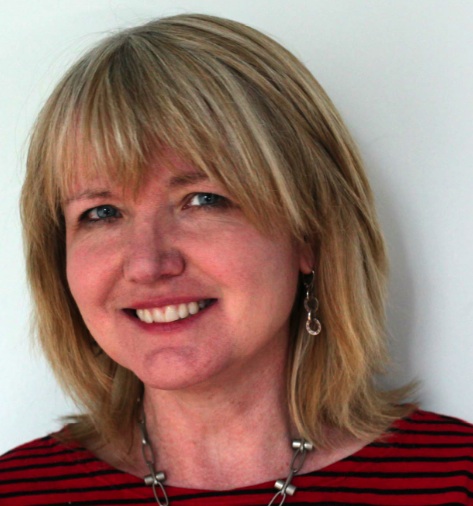
“St. Michael’s well-received ‘Trump and the Media’ course led the way in showing how an academic institution can instruct while interacting with real-time news,” says Kingston. And as former New York Times editor Sam Tanenhaus did with his class on Trump last fall, Kingston and Johnson will regularly incorporate breaking news into their curriculum. Kingston points to the upcoming trial of Hedley’s Jacob Hoggard as one possible example.
“Book and Media Studies is a program that allows students to engage with some of the most pressing and complex situations created by our intensely mediated moment, and place them in contexts beyond 140 characters,” St. Michael’s Principal and Vice-President Randy Boyagoda said in an email. He added that “A course like #MeToo and the Media, taught by two distinguished visiting professors, each a leading figure in contemporary Canadian media, makes it possible for students to explore one of the most vexed, active, and important situations in contemporary media, politics, and culture.”
More information about “#MeToo and the Media” is available online.
Orientation Week 2019 at St. Michael’s will take place September 1 to 4. Register here! In the weeks leading up to Orientation, we’re posting quick interviews with each member of this year’s orientation coordinator team. The introduction to the series is available here.
Orientation Executive Officer of Communications and Marketing Taylor Medeiros is a third-year student at St. Mike’s double-majoring in Statistics and Book and Media Studies with a minor in Mathematics. We asked Taylor three questions over email about orientation and life at St. Mike’s.
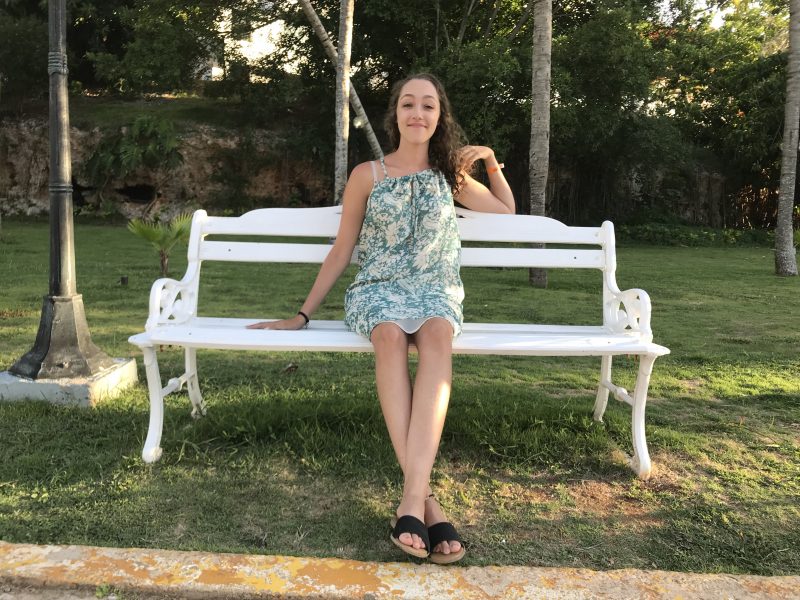
- What part of Orientation 2019 are you most excited for?
I am most excited to be back on campus and see the hustle and bustle of Orientation Week! I am also super excited to participate in the Tri-Campus Parade again, and help first year students move into their residences. - What is one of your best memories at SMC?
It’s difficult to pick a single favourite memory at SMC, but since I should only pick one I’ll choose my own Orientation Week in 2017. I made the best friends I could possibly ask for. Orientation was incredibly fun and I really loved how comfortable it made me feel at St. Mike’s, on the UofT campus, and in Toronto! The Tri-Campus Parade showed me how much school spirit there really is, and made me very happy with my decision to choose St. Mike’s and UofT. Starting at UofT felt a little daunting, but ended up being an amazing experience. - How can the Class of 2023 get involved on campus in the fall?
The Class of 2023 can get involved on campus in the fall in a variety of ways. The best way to see all the clubs and what you can participate in is by going to the UTSU Clubs Carnival and the St. Mike’s Club Fair during Orientation Week. There is also a Clubs Fair down St. George St. during the first week of school that you can attend and sign up for what you think is interesting. If you’re a commuter, I highly suggest attending the St. Mike’s Commuter Don Orientation AND attending the events they hold. It’s a great way to meet new people! Another suggestion is to look at the website CLNx. The university posts job positions and volunteer opportunities to the job board, making it easy to get involved.
Taylor can’t wait to welcome you to campus this fall. If you haven’t already done so, register for Orientation 2019 at St. Michael’s here.
Orientation Week 2019 at St. Michael’s will take place September 1 to 4. Register here! In the weeks leading up to Orientation, we’re posting quick interviews with each member of this year’s orientation coordinator team. The introduction to the series is available here.
Orientation Coordinator Anna Zappone is a fourth-year student at St. Mike’s majoring in Environmental Geography with minors in English and Forest Conservation. We asked Anna three questions over email about orientation and life at St. Mike’s.

- What part of Orientation 2019 are you most excited for?
I am most excited to meet all the new SMC students and welcome them to our community as well as seeing the months of planning come to life during Orientation week! - What is one of your best memories at SMC?
My favourite memories at SMC are of the times spent with friends at Brennan and in the Coop. Whether it was playing cards, pancake days or just talking to friends, you can always count on finding a friendly face there! - How can the Class of 2023 get involved on campus in the fall?
The one piece of advice I can give to the Class of 2023 is to find something you’re passionate about and get involved in any way you can! The USMC clubs fair in September is a great way to learn more about what St. Mike’s has to offer. Join one of the many SMC clubs and sports teams, run for student council, write for the college newspaper or become an Orientation leader! Getting involved and giving back to the community is so rewarding, and is a great way to meet new people.
Anna can’t wait to welcome you to campus this fall. If you haven’t already done so, register for Orientation 2019 at St. Michael’s here.
11 Graduating St. Mike’s Students Receive Cressy Awards for outstanding extra-curricular contributions
We are incredibly proud of the Class of 2019, and in advance of Convocation events on June 13 and 14, the University of St. Michael’s College wishes to acknowledge the outstanding achievements of some of our graduating students who were honoured on April 22 with Cressy Awards.
Cressy Award recipients from the St. Michael’s Class of 2019 have edited journals, presided over conferences and student organizations, supported our sponsored programs, worked in Residence Life and Student Life, coordinated our Mentorship program, and much more.
Join us in congratulating the following students:
- Joshua Bowman (USMC 2019) was the President of the Indigenous Studies Students’ Union and co-chair of the Honouring our Students PowWow, as well as an executive on the Arts and Science Students’ Union.
- Damian Di Biase (USMC 2019) founded “Clean SMC”, a student environmentalist group which has sought to promote sustainable living through public outreach and funding green initiatives on campus. He also served as an Orientation Leader, Student’s Union Representative and Commuter Ambassador for St. Mike’s.
- Jaimi Foster (USMC 2019) was co-coordinator of the St Michael’s College Mentorship program and President of two USMC Clubs- the American Culture Club and the Pickleball Club.
- Haseeb Hassaan (USMC 2019) was the President of the Arts & Science Students Union and the Founder and Chair of the Student Success Day Conference.
- Lazar Joksimovic (USMC 2019) co-founded and directed the Global Society for Genetics & Genome Biology, an international organization whose mission is to advance research on rare yet fatal genetic diseases. He also co-founded the Journal of Innovations in Genetics and served as the Academic Chair for the UofT Ophthalmology Club.
- Marianne Kalaczynski (USMC 2019) was the Co-President of the Slavic Languages Students’ Union and the Medieval Studies Undergraduate Society, as well as Mentor and Logistics Director for the History Students’ Association.
- Erin McTague (USMC 2019) was Chief Returning Officer of the St. Michael’s College Student Union, President and Intramural Coordinator of the St. Michael’s College Residence Council, and Munk One Program Ambassador.
- Giuliana Sframeli (USMC 2019) was the President of Delta Delta Delta, University of Toronto Chapter and the Director of Events for Rotman Commerce Women in Business.
- Karina Michele Stellato (USMC 2019) was heavily involved in Student Life through her roles as Commuter Don, Senior Mentor with USMC Mentorship and Marshal at Orientation week at St. Michael’s College. She also served as an events coordinator for the Italian Undergraduate Student Cultural Association.
- Maria Olivia Teotonio Wren (USMC 2019) was the Events-Coordinator for the Celtic Studies Student Union and the Medieval Studies Undergraduate Society aligning study and extra-curricular thus making what is learnt in class come alive. She also served as a student representative for the Pontifical Institute of Medieval Studies Friends of the Library Committee.
- Han Lu (Jessica) Yu (USMC 2019) was the Editor for The Attaché Journal and served as the Committee Director at the 2017 Secondary School Interactive Crisis Simulation Conference. She also served as Secretary General of the North American Model United Nations Conference, acting as a Senior Advisor her senior year.
We also recognize Elicia Pavan (USMC 2015), who was also honoured this year with a Cressy Award.
Established in 1994 by the University of Toronto Alumni Association (UTAA) and the Division of University Advancement, the Gordon Cressy Student Leadership Awards recognize students who have made outstanding extra-curricular contributions to their college, faculty or school, or to the university as a whole.
On June 14, the University of St. Michael’s College will welcome back to campus two accomplished alumni, who will be addressing the Class of 2019 at each of this year’s two-degree conferral ceremonies.
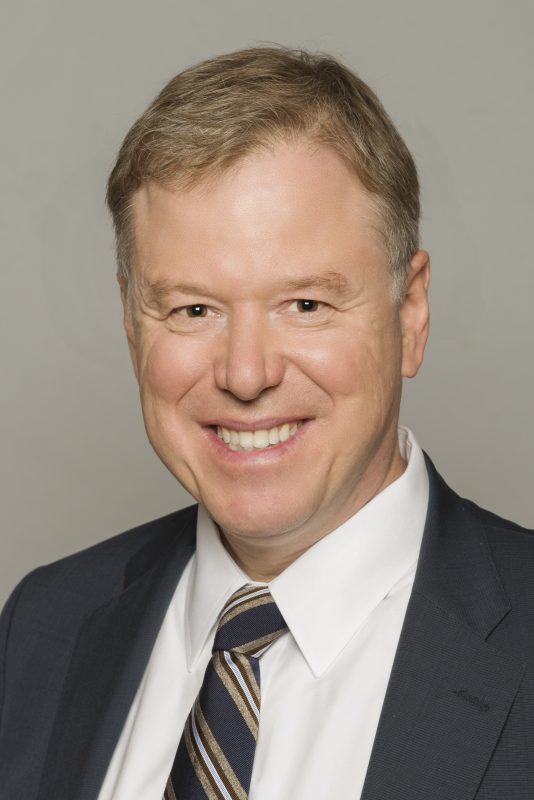
At 10 a.m. June 14, Arts graduates will gather in Convocation Hall for the presentation of their degrees, and Dr. Andy Smith, CEO of Sunnybrook Hospital, will deliver remarks.
Dr. Smith graduated from St. Michael’s in 1990 and entered medical school. Today, Dr. Smith serves as president and CEO of Sunnybrook Health Sciences Centre, a prestigious appointment that followed years of leadership in other roles at Sunybrook, the Division of General Surgery at the University of Toronto, the Odette Cancer Program and Cancer Care Ontario. A surgeon by training, Dr. Smith anticipates a day when advances in ultrasound and other medical technology result in surgical procedures no longer requiring incisions on the patient’s body – a science-fiction scenario he is helping to bring into reality with his team at Sunnybrook.

Science and Commerce graduates will gather at Convocation hall at 2:30 p.m. for their degree conferral ceremony, and those students will hear from Aashni Shah, CEO of non-profit Elixir Labs and software engineer for Square.
A member of the St. Michael’s Class of 2016, Ms. Shah was named one of Canada’s 50 most inspiring women in STEM by Inspiring Fifty, an honour she received for her innovative work at the intersection of technology and philanthropy. She was the first female president of the Computer Science Student Union at the U of T in over a decade, and founded UofTHacks, Canada’s first student-run hackathon. Born and raised in Kenya before moving to Canada in 2011 to start university, Ms. Shah is an advocate for diversity in tech, and believes that “by promoting diversity in STEM, we’re increasing our odds of finding stable and sustainable solutions that will help Canadians and people all around the world.”
Dr. Smith and Ms. Shah have worked to create new pathways into the future, representing the value of an education that pairs elite skills and job-readiness with a sense for the most important questions facing society today. We look forward to their remarks to the Class of 2019.
Introduced in the 2018-2019 academic year, the Boyle Seminar in Scripts and Stories is a unique offering for first-year students interested in the transmission of knowledge and preservation of intellectual culture during the medieval era. As one of three SMC One seminars at St. Michael’s, the Boyle Seminar brings together the strengths of two St. Michael’s-sponsored programs – Medieval Studies and Celtic Studies – to give participants an interdisciplinary foundation for future academic work, preparation for careers in a wide range of fields and an opportunity to go on an international learning experience in Ireland.
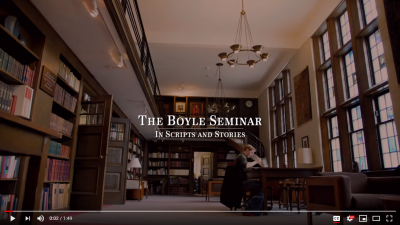
Assistant professors Máirtín Coilféir and Alison More seek to give new students experience in manuscript studies, history and the Latin and Irish languages, but the program also serves as an effective bridge to university-level academic work more generally. Open to around 20 students each year, the small class size of the Boyle Seminar helps each cohort to bond into a tight-knit group, and gives each student one-on-one time with both professors.
A Hands-On Approach
Professor Coilféir, who teaches in the Celtic Studies program, describes one of the primary themes of the course as “the practical application of theoretical knowledge.” Instead of giving students a dry survey of medieval and Irish culture, he and professor More give students direct experiences of the practices that monks used centuries ago to create and preserve manuscripts, which are the hand-written copies of documents prepared in the medieval scriptorium.
By encountering parchment first as a dried and treated animal hide, students begin to see the living material basis for history. “We spend quite a lot of time talking about ‘how do we go from cow to page?’” Coilféir says. Practical experience with parchment, ink and feather quills, which the students cut into usable pen nibs, helps to reinforce the notion of medieval and Celtic culture as representing a living history – one that students are equipped to take up with gusto.
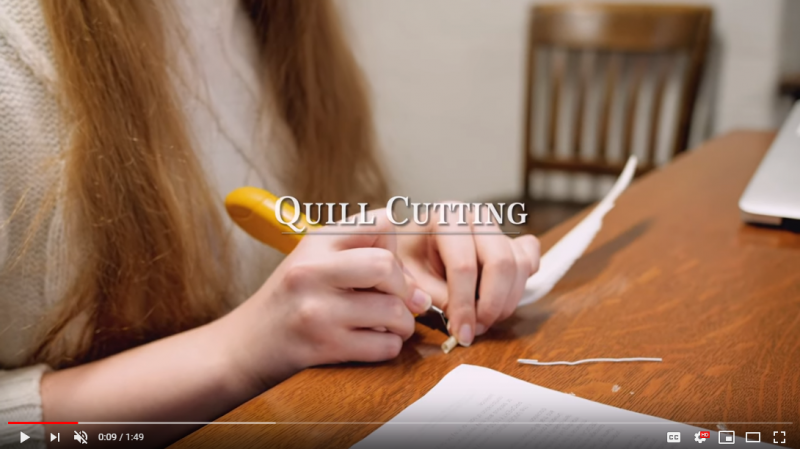
Most Medieval Studies programs for undergraduates follow a very different and far more traditional pattern than that of the Boyle Seminar at St. Michael’s. Professor More, a medievalist, describes the typical progression for an academic in her field as requiring at least three years of dry study before a typical student gets a chance to see or touch a manuscript.
By contrast, the Boyle Seminar puts centuries-old manuscripts in the hands of students during their first months at university. This fearless and practical approach to the artifacts of the period gives students a solid basis for “manuscript studies and the often-baffling sources of medieval history,” More says, as well as training that can serve as effective preparation in a variety of other fields such as law, theology and cultural conservation.
The May trip to Ireland reinforces the practical emphasis of the course, with visits to ancient cultural sites including an active archaeological dig at the Blackfriary Archaeology Field School. Though not for academic credit, the trip gives students an opportunity to handle artifacts fresh out of the ground and learn contemporary archaeological methods.
A St. Michael’s Tradition
With both the Pontifical Institute of Medieaval Studies (PIMS) and the John M. Kelly Library located right on campus at St. Michael’s, it only makes sense for the Boyle Seminar to rely on the research institute and library’s holdings to give students access to special texts for the course.
One of the seminar’s key texts is Integral Paleography, a collection of articles about different scholarly approaches to medieval writing. This book has a special connection to the seminar: it is the work of Fr. Leonard Boyle, OP, the scholar and former PIMS professor for whom the seminar is named.
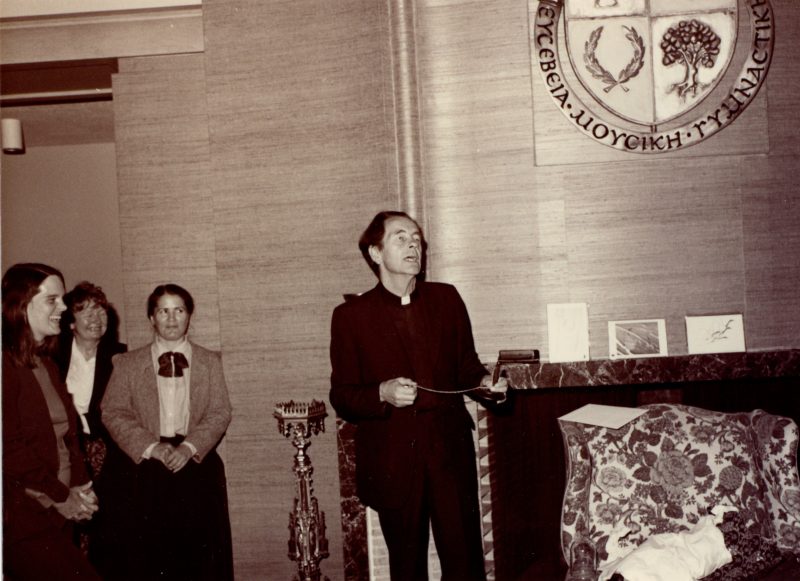
Fr. Boyle was an important figure at PIMS and helped to build the University of Toronto’s Medieval Studies program, now hosted at St. Michael’s. In 1984, Fr. Boyle left Toronto for Rome after Pope John Paul II appointed him Prefect of the Vatican Library. There, the scholar-priest worked for years to expand access to the library’s holdings to scholars around the world. In so doing, he changed the reputation of an institution “not well known for its hospitality to visitors” into a place where “the doors were flung open from morn till night,” as Nicolas Barker wrote in his obituary for Fr. Boyle for The Independent.
The spirit that animated Fr. Boyle’s approach to the Vatican Library – prioritizing access for everyone who needs it – continues to animate the Boyle Seminar. In line with a storied history of scholar-teachers at St. Michael’s, professors More and Coilféir open up a world of ideas and experiences while helping students to make lateral connections across disciplines. Rejecting the Ivory Tower model of the academic enterprise in favor of a robust commitment to the liberal arts, the seminar’s approach fuels creativity and courage in first-year students’ approaches to their academic careers and later readiness for the workplace. As one student observed, “when you think about the past, you think more about the future.”
From Friday, Nov. 16 at 4 p.m. to Monday, Nov. 19 at 8 a.m. (EST), ACORN, ROSI Alumni Transcripts, Degree Explorer, MyRes and VBRS will be unavailable.
U of T is upgrading ACORN and associated applications to improve performance for faster enrolment. As one of the largest university-wide initiatives, the project has involved converting 2 million lines of code to Java and replacing a mainframe server with Linux blade servers. The new platform will ensure that U of T stays at the forefront of technological innovation.
Thank you for your patience as we make these improvements.
For updates on progress, check @uoftacorn on Twitter and Facebook.




